The Best Tours in Uyuni
The Bolivian Salt Flats have become Bolivia’s most popular attraction and a must-see for anyone traveling through South America. Their otherworldly nature and surreal beauty attracts tens of thousands of visitors every year. Read below to find everything you need to choose the perfect Salar de Uyuni tour!

Quick tips:
- If you have a bit more time, choose a 3 or 4 Day Tour to get to enjoy everything Salar de Uyuni has to offer!
- Unfortunately, there have been cases of tour operators scamming tourists who try to book a tour when they arrive to the salt flats. If possible, book in advance through a trusted operator.
- Findlocaltrips.com is a highly recommended website that finds and compares local tour operators. Check them out to find the best Salar de Uyuni tours.
Salar de Uyuni tour options
With the natural beauty of Salar de Uyuni and all its breathtaking surroundings, it’s no wonder the Bolivia Salt Flat is one of the world’s most popular tours. Luckily, theres an option for all travelers, whether short on time or traveling at a slower pace. Let’s take a look in more detail.
One-day tours are a great way for those who don’t have much time to see the salt flats. Due to the time restriction, you won’t get a chance to visit the incredible surrounding attractions. However, you will be far from disappointed when you leave as these tours still give you plenty of time to soak in the magic of Salar de Uyuni and capture jaw-dropping photos that you didn’t even know were possible.
One-day tours can only be taken from Uyuni. Buses arrive here very early in the morning to allow enough time for those on board to do take the tour the day they arrive. These tours start at around 10am and finish at around 5pm, allowing enough time for those on the tour to catch an overnight bus to their next destination.

The historical and intriguing train graveyard is the first stop on the one-day tours. This is followed by Colchani, the salt production site, where you will be taught the process of producing salt and visit one of the iconic salt hotels. A trip to Isla Incahuasi follows, where you’ll be able to discover giant cacti up to 10m high, incredible rock formations made of petrified coral and a enjoy a stunning 360-degree view of the tremendous salt flats.
Lunch is also served here as groups get their props at the ready for crazy, perspective photos set on the blinding white surface of the salt flats. The tour ends in magnificent fashion as you observe the sun magically set over the flats.
1 Day Tour include:
- The train graveyard
- A Salt hotel
- Isla Incahuasi
Recommended 1 Day Tour
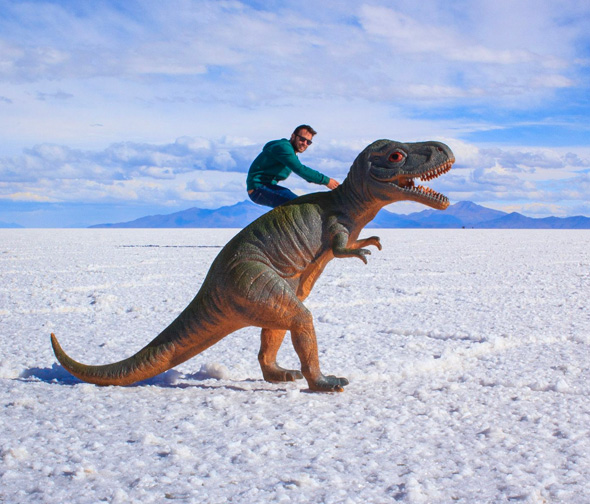
Uyuni Salt Flat Full Day Tour
Red Planet Expedition
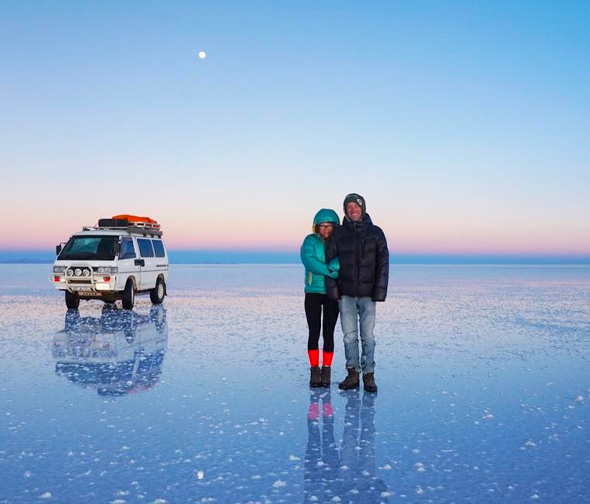
Perla de Bolivia
3/4 Day Tour
The most popular and recommended way to discover Salar de Uyuni is by taking a 3 or 4 day tour in a 4×4 jeep. Three day tours depart from either Uyuni or San Pedro de Atacama and finish in Uyuni. The three day tour starting in San Pedro de Atacama and ending in Uyuni is ideal for those looking to continue traveling north after their visit to Salar de Uyuni. Alternatively, you can do the 4 day tour which starts and finishes in San Pedro de Atacama. This tour visits the same places as the 3 day tours but requires an extra night in order to make the relatively long journey back to Chile.

Day one is the same as the one day tour – departing from Uyuni at the same time and visiting the same places. Following a long day of exploring, you will spend the first night in one of the iconic salt hotels or salt hostels. These remarkable designs are made up almost entirely of salt blocks, from the bed and toilet to the walls and ceilings. Get yourself an early night sleep here as days two and three begin at the crack of dawn, with breakfast at 7am and 5am respectively. Across the next two days you will see everything that Salar de Uyuni has to offer. Of course, you will also be given plenty of time to capture an abundance of photos of one of the picturesque places on Earth The second night is spent in very basic accommodation beside the Polques hot springs, where you will find yourself blown away by the magical stars of the Salar.
The itinerary for those who start their tour in San Pedro de Atacama is reversed as they visit the desert, lagoons, hot springs etc. at the beginning of the tour and the salt flat at the end. The third night of the 4 day tour is spent in a basic hostel in Villa Mar village. You will wake up at 4.30 am to continue your journey, finally arriving back to San Pedro de Atacama at around 2pm.
3/4 Day Tour include:
- The lagoons Polques hot springs
- Arbol de Piedra
- Valle de Rocas
- Sol de Mañana geyser
- Dali Desert
- San Cristobal de Lipez
- A salt hotel
- Chiguana desert
Recommended 3/4 Day Tour
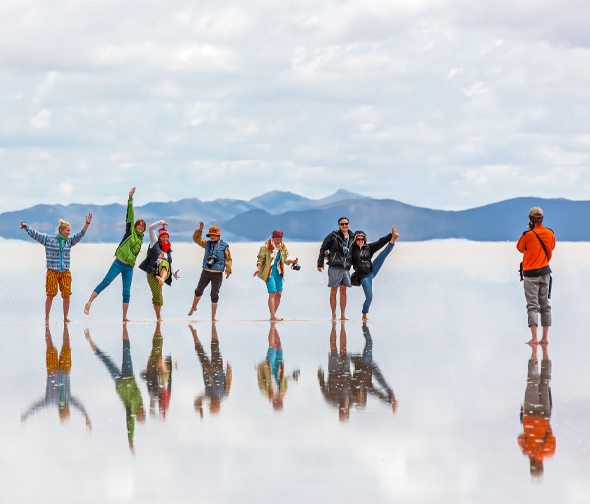
Uyuni Salt Flat Tour 3 Days / 2 Nights
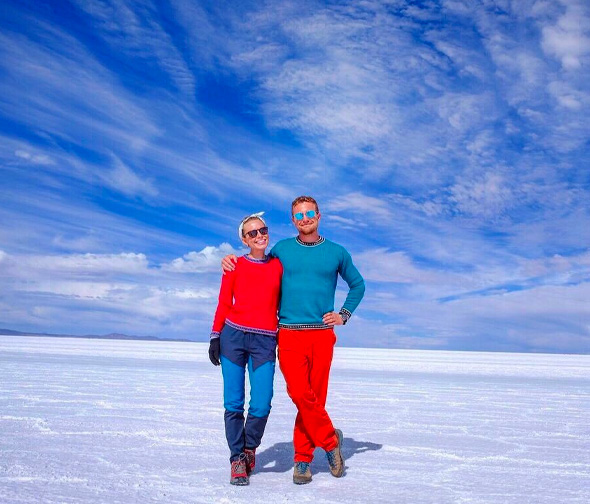
Visit the largest salt mine
in the world in 2021
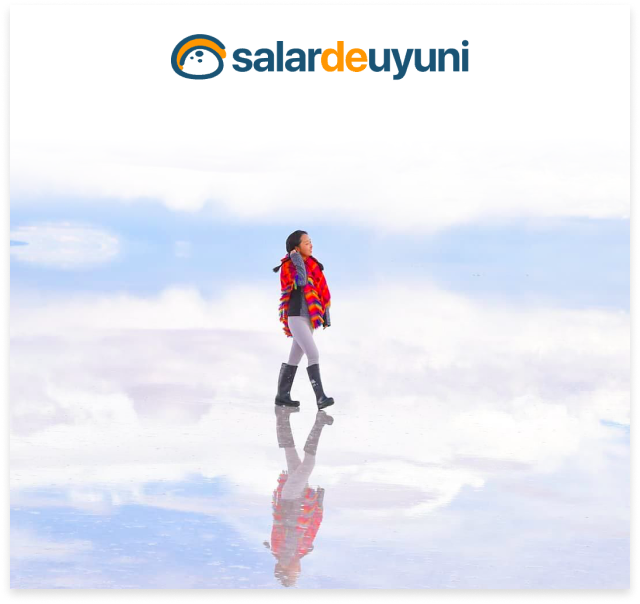
National Geographic content straight to your inbox—sign up for our popular newsletters here

A thin layer of water transforms Bolivia's Salar de Uyuni into a striking reflective canvas.
These Salt Flats Are One of the Most Remarkable Vistas on Earth
Bolivia's Salar de Uyuni can make for an incredible experience or a logistical nightmare. Plan your trip with these tips.
Bolivia ’s Salar de Uyuni is considered one of the most extreme and remarkable vistas in all of South America, if not Earth. Stretching more than 4,050 square miles of the Altiplano, it is the world’s largest salt flat, left behind by prehistoric lakes evaporated long ago. Here, a thick crust of salt extends to the horizon, covered by quilted, polygonal patterns of salt rising from the ground.
At certain times of the year, nearby lakes overflow and a thin layer of water transforms the flats into a stunning reflection of the sky. This beautiful and otherworldly terrain serves as a lucrative extraction site for salt and lithium—the element responsible for powering laptops, smart phones, and electric cars. In addition to local workers who harvest these minerals, the landscape is home to the world's first salt hotel and populated by road-tripping tourists. The harsh beauty and desolateness of Salar de Uyuni can make for an incredible experience or a logistical nightmare. Here’s a guide to help:
HOW TO GET THERE
Located at the crux of Bolivia, Chile , and Argentina , the logistics and length of your trip to Salar de Uyuni will depend where you’re coming from. Tours originate from three main places:
Uyuni, Bolivia : The most popular jumping-off point for salt flats tours, Uyuni is a small, dusty town packed with tourism agencies in Plaza Arce, its main square. Travelers can book tours in advance online, through tour offices in La Paz, or they can simply arrive in Uyuni and peruse the options in town. Since Uyuni is so close to the salt flats, tourists can easily book day trips. Flights from La Paz to Uyuni can be booked through Amaszonas and BoA (one hour, about $130 round-trip). Overnight buses from La Paz are available with Trans Omar and Todo Turismo (10-12 hours, $30 to $40 each way).
San Pedro de Atacama, Chile : Agencies drive travelers to the border before handing the tour over to a Bolivian operator. Due to the distance, this is a three-day tour.
Tupiza, Bolivia: This is the best starting point for travelers coming from Argentina. Tour operators recommend four-day tours from Tupiza, visiting Salar de Uyuni on the final day.
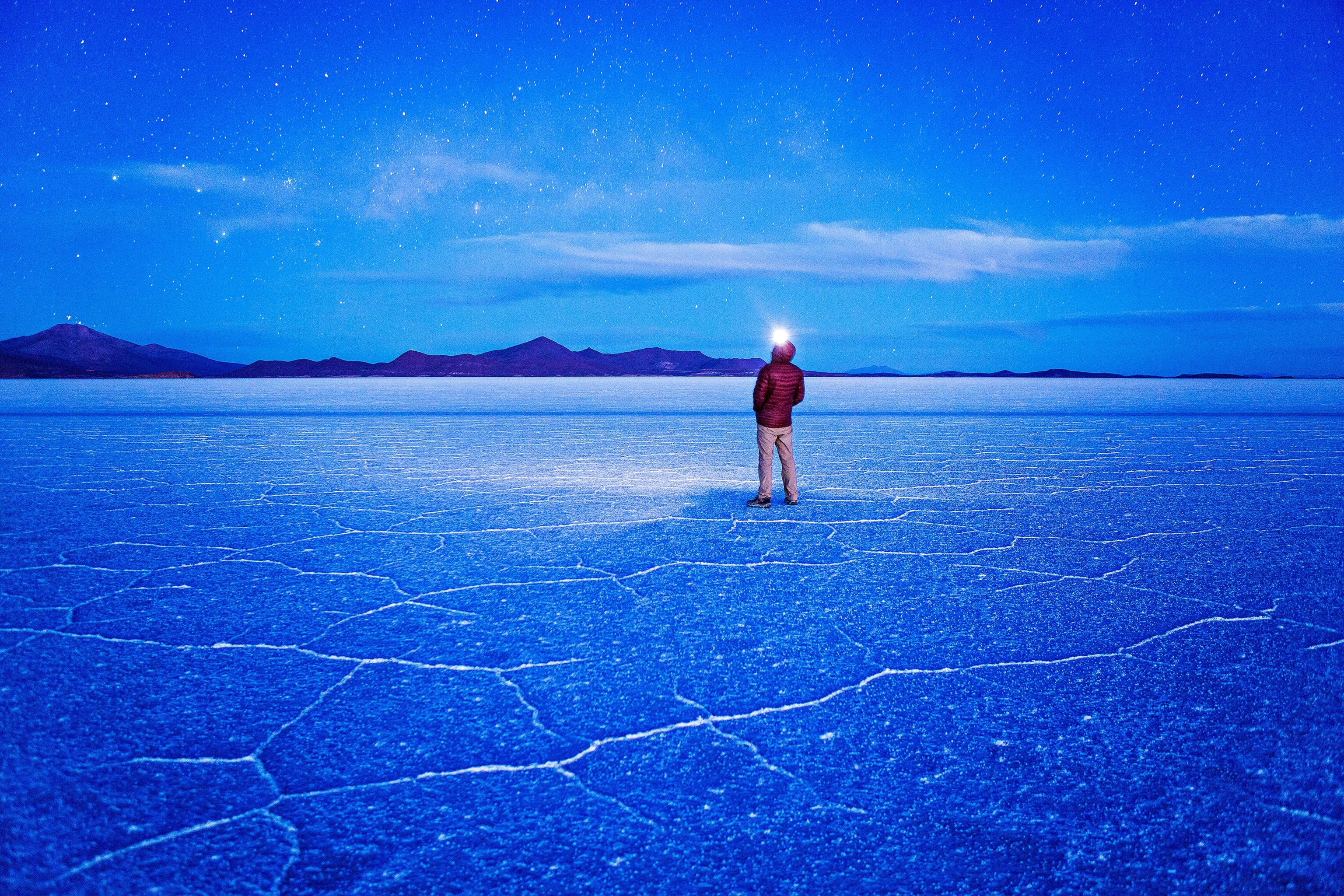
The star-studded night sky casts the salt flats shades of blue. During the dry season the ground hardens and polygonal patterns of salt rise from the ground.
Salar de Uyuni has two distinct seasons. The rainy season (December to April) is when visitors come to witness the Salar’s breathtaking mirror effect. Be wary of excessive rain in December and January, as it can cause tour cancelations. During the dry season (May to November) temperatures are colder, the ground has hardened, and travelers can drive across the stark white landscape to places that aren’t accessible in the rainy season. Tour operators consider June through August their high period, and rates may rise accordingly.
CHOOSING A TOUR
While the salt flats are one of Bolivia’s most popular attractions, it’s only a small part of the gorgeous Altiplano region. Many visitors indulge in a three-day tour (or longer) that includes the deserts, volcanos, geysers, hot springs, and high-altitude lakes to the south. Tours out of San Pedro de Atacama and Tupiza are already scheduled to drive through these sites.
Travelers can choose between a shared tour (cheaper and standardized) or private tour (higher-priced and custom-tailored). Shared tours generally provide Spanish-speaking guides who double as the driver and chef. These follow a rigid itinerary that will not likely accommodate individual requests and can hinder certain times of day, like sunrise or sunset. Private tours, by contrast, can be customized to a client’s liking, giving travelers more control over itinerary and the ability to go off the beaten path to volcanos or caves. Private tours also provide an English-speaking guide, chef, and a more comfortable vehicle.
Check online reviews and travel guides to carefully choose a reputable guide. Avoid companies that offer rock bottom prices—they may not provide an accredited guide or working car, which can endanger tourists. Also ask your agency whether they carry an emergency radio and first-aid kit.
HOW TO TAKE GREAT PHOTOS
One of the highlights of Salar de Uyuni is an endless horizon that allows photographers to play with perspective and depth of field. Stage battle scenes with toy dinosaurs, cook your friends in pots and pans, or crawl out of seemingly giant jars of peanut butter. The key to great photos is to get the camera low to the ground and close to your prop. This gives the perspective that the prop is larger than the human subjects, who stand farther away. Don’t let your subjects venture too far, though—the larger the distance between the prop and the subjects, the harder it will be to keep everything in focus. If your camera permits, make the aperture as narrow as possible.
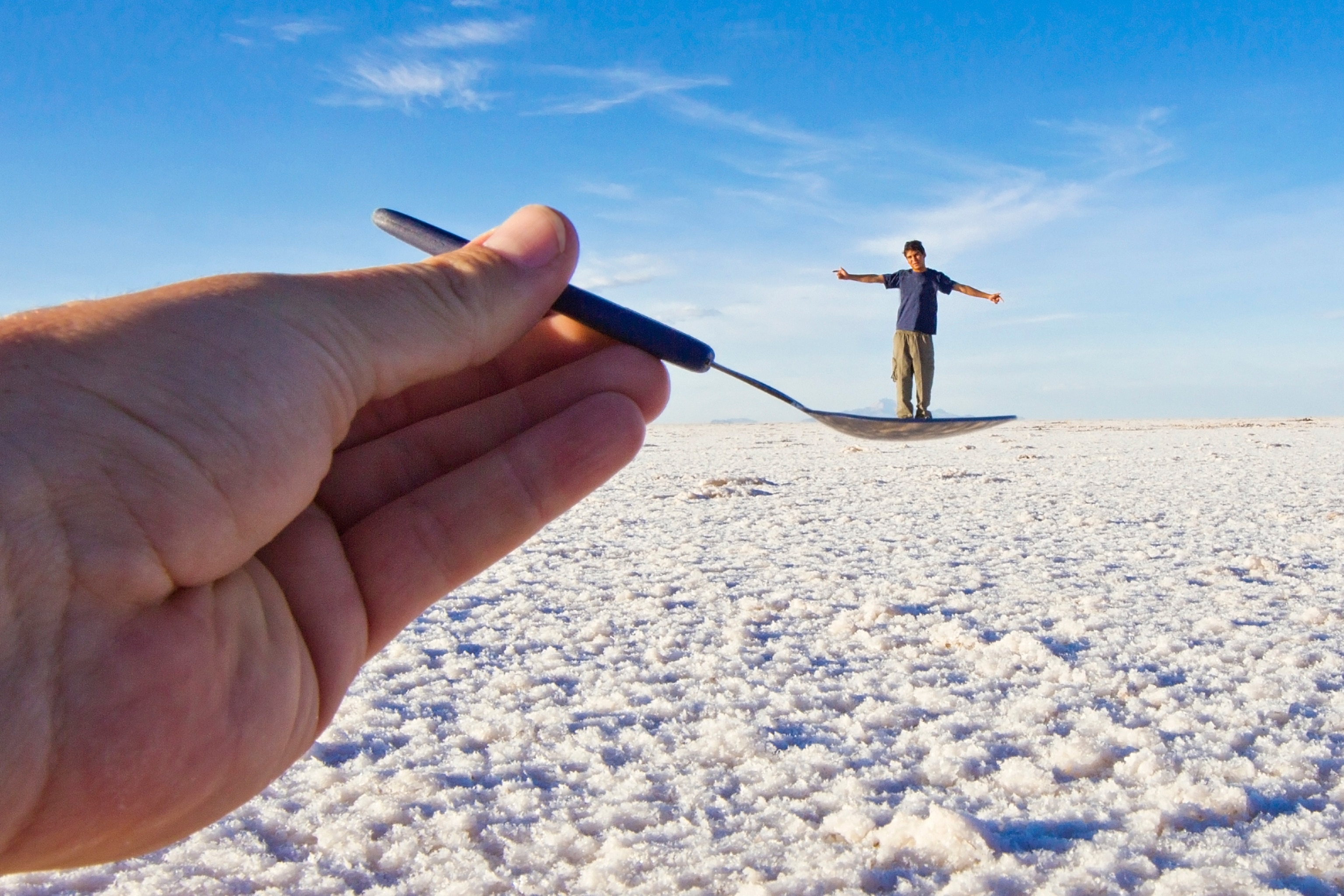
Salar de Uyuni's seemingly endless horizon allows photographers to play with perspective and depth of field.
- Nat Geo Expeditions
ODDS AND ENDS
At nearly 12,000 feet above sea level, visitors may experience altitude sickness if they haven’t properly acclimatized. Symptoms include nausea, headaches, and insomnia among others. Discuss various options for preventing and treating altitude sickness with your doctor before your trip.
Bolivia requires a tourist visa ($160 for U.S. citizens) as well as a Yellow Fever Vaccination Certificate to enter the country.
Liz Unger is a National Geographic Young Explorer, photojournalist, and filmmaker from New York. Follow her on Twitter @ewu5191 and Instagram @ewu5191 , and explore her work at www.lizunger.com .
Related Topics
You may also like.

The ultimate Andes road trip, from Chile to Bolivia

A practical guide to exploring Peru
Become a subscriber and support our award-winning editorial features, videos, photography, and more—for as little as $2/mo.

What you need to know about travel to Cyprus, 50 years after the island was split

Maasai Mara & beyond: 5 must-see safari parks in Kenya

Fun tastings, fancy tours: how Scottish whisky experiences are evolving

Want to see great white sharks? Consider Cape Cod.

10 best things to do in Switzerland
- Environment
- Paid Content
History & Culture
- History & Culture
- Terms of Use
- Privacy Policy
- Your US State Privacy Rights
- Children's Online Privacy Policy
- Interest-Based Ads
- About Nielsen Measurement
- Do Not Sell or Share My Personal Information
- Nat Geo Home
- Attend a Live Event
- Book a Trip
- Inspire Your Kids
- Shop Nat Geo
- Visit the D.C. Museum
- Learn About Our Impact
- Support Our Mission
- Advertise With Us
- Customer Service
- Renew Subscription
- Manage Your Subscription
- Work at Nat Geo
- Sign Up for Our Newsletters
- Contribute to Protect the Planet
Copyright © 1996-2015 National Geographic Society Copyright © 2015-2024 National Geographic Partners, LLC. All rights reserved
- Why hop with us
- Visa Requirements
- Hop Login Here

- How We Started
- Who Travels With Us?
- Why Hop With Us?
- Unique Hop Stops
- Bolivia Hop vs Public Buses
- Frequently Asked Questions
- How It Works
- Tickets & Trips
- Salt Flat Tours
- Lake Titicaca Tours
- Hotels & Hostels
- Death Road Bike Tours
- Salar de Uyuni
- Day Trips From La Paz
- Day Trips From Cusco
- Days Trips From Lima
- Extra Tours
- Rainbow Mountain
- Ballestas Islands
- Buggy And Sandboarding
- Nazca Lines Flight
- Full Day Tour
- 2 Hour Tour
- Full Day Tour/a>
Bolivian Salt Flats 2024
The most complete guide ever written with tips and advice to ensure you have the best possible experience at the bolivian salt flats..
Our guide to Bolivian Salt Flats in 2024 is extensive and based on almost 10 years of experience as well as hundreds of surveys from ex-travelers. Click any section below to read more information or scroll down to read the full complete guide of the Bolivian Salt Flats.
Bolivian Salt Flats of Uyuni – Quick Facts
Uyuni is around 8 hours South of La Paz
Access via overnight bus or small plane – options below
Salt Flat tours – 1 day and 3 day options – tips below
Known as the “world’s largest mirror”
Complete Guide to Uyuni Salt Flats Bolivia
(click any link to go direct to that section or scroll down to read the whole guide)
How To Get To Uyuni Salt Flats
Salt Flats Tour and Tips
The Perfect Salt Flats Plan – Itinerary Information
How To Take Amazing Photos At The Salt Flats Bolivia
Salar de Uyuni - FAQs - Your Questions Answered!
Bolivia Salt Flats Guide - Summary
Salar de Uyuni is accessible from Bolivia (for those going south) from La Paz, and from Chile (for those going north) via San Pedro de Atacama Desert.
From La Paz, it is usually 8 hours on a bed (cama) bus overnight, allowing you to arrive early morning, which is the best time to arrive to Uyuni.
From San Pedro de Atacama in Chile, buses take around 11 hours, factoring in the border crossing from Chile to Bolivia and involve a combination of buses. Tours are usually more recommended for when going from San Pedro to Uyuni or vice/versa.

Buses from La Paz to Uyuni
Bolivia Hop has been officially voted Bolivia’s best bus company in from 2016 to 2020 but as of December 2023, they still do not operate from La Paz to Uyuni. Bolivia Hop is the best way to get to and from La Paz, and then Todo Turismo is probably the best way to get from La Paz to Uyuni or from Uyuni back to La Paz. When booking with Todo Turismo, always try to get the Cama (bed) option. Do NOT go with other companies such as Transporte Omar or anybody else…safety records are suspect so we strongly recommend to travel with Todo Turismo to/from Uyuni, and Bolivia Hop to/from La Paz. Once in Uyuni, you can start your Salt Flats tour (1 day or a 3 day tour that ends in San Pedro de Atacama in Chile).
Quick Tip: The best way to book your Bolivian Salt Flats tour is by visiting Find Local Trips , a tour comparison website that allows you to choose tours from the top-rated operators throughout South America..
Buses from San Pedro de Atacama to Uyuni
There are NO direct buses from San Pedro de Atacama to Uyuni and it is strongly recommended to take a 3 day tour from San Pedro to Uyuni (or from Uyuni to San Pedro if you are traveling South) instead of trying to do this route via bus. This is because you will need to change buses, cross borders, and quite often this is a logistical nightmare.
If you insist on trying to travel from San Pedro to Uyuni by bus, or from Uyuni to San Pedro by bus. Cruz del Norte are usually the best bus company to go with.
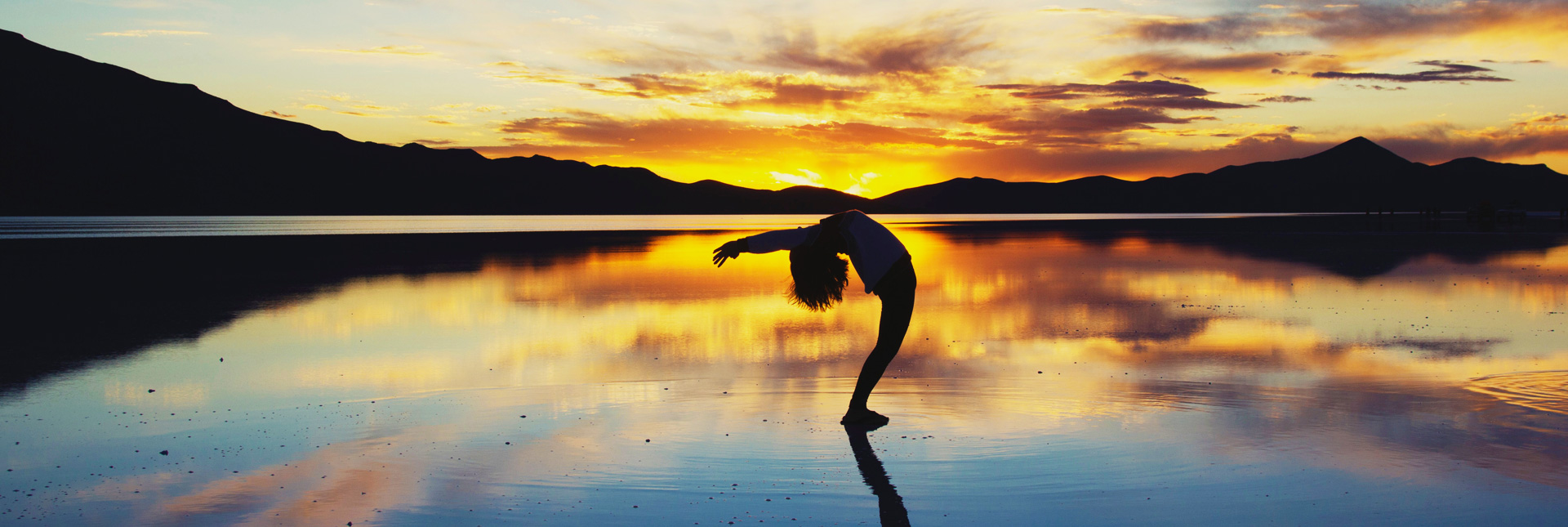
The Bolivian Salt Flats in Uyuni are a MUST see for any trip to South America. It is STRONGLY recommended to book your tour in advance where possible and to NOT book your tour in Uyuni (book in La Paz or online) as many companies scam tourists, so be very careful with your choice of tour operator.
There are 2 types of tours of Salar de Uyuni Salt Flats:
Full Day Tour of the Salt Flats, start and finish in Uyuni on same day
A one-day tour of Salar de Uyuni in 4×4 jeeps are common and the shortest tours possible. The one day tour is also the cheapest way to visit the Salt Flats. Tours start in Uyuni around 10am (allowing you to have breakfast after your overnight bus from La Paz to Uyuni) and finish around 5pm (allowing you to take an overnight bus back to La Paz on the SAME day or to another destination.
A visit to the train cemetery is followed by a stop in Colchani before arriving to the Salt Flats and getting the first glimpse of this vast environment. Salt hotels, salt mounds, isolated ‘islands’ covered in cacti, lunch, and plenty of time for taking photos before returning to Uyuni at 5 pm. This is approximately how most of these tours run but for a more detailed itinerary check FindLocalTrips here .
Prices are from $70 USD to $90 USD
Start and finish in Uyuni, or finish in San Pedro de Atacama. If coming from San Pedro de Atacama, this 3 day tour will finish in Uyuni
3 Day Tours of Salar de Uyuni in 4×4 jeeps are the most popular tour type. The first day is the same as the one day tour – usually spending the first night in one of the basic Salt Hotels on the Salar itself. These hotels are almost completely constructed out of bricks made from dried salt!
The second and third days are spent seeing the colored lakes, hot springs, flamingo flocks, hot geysers, crazy rock formations – such as Arbol de Piedra (Rock Tree) , and painted volcanoes. You will be sleeping in tents and truly immersing yourself in this rugged part of the world. The stars alone in this unpolluted place can take your breath away.
3 day tours ending in San Pedro de Atacama – It’s also possible to hop over the border at the end of the tour, connecting to San Pedro de Atacama, Chile.
No attractions are missed by leaving the tour at the Chilean border before it heads back to Uyuni.
3 days tours STARTING From San Pedro de Atacama – There is also the opportunity to do this Salt Flat tour starting in San Pedro de Atacama, Chile and ending in Uyuni on the last day or returning to San Pedro the following day. Tours from San Pedro can be somewhat more expensive than those from Uyuni. This is the best way to get to Bolivia from Chile and the itineraries are the same as above just in reverse order with the final day being the Salt Flats themselves.
The best and most popular way to visit the Salar de Uyuni is by taking a 4×4 tour across the salt flats.
Most Salt Flats tours are safe and reliable; however, the conditions are basic in this area and you should be aware of this. The Salar de Uyuni is one of the harshest environments for vehicles on the planet and occasional vehicle issues can happen, this to a certain extent is unavoidable. The drivers are used to breakdowns and are pretty adept at fixing their vehicles. They are always willing to help each other out and you are usually not stuck for long – so a bit of patience is often all you need. Food will be basic.
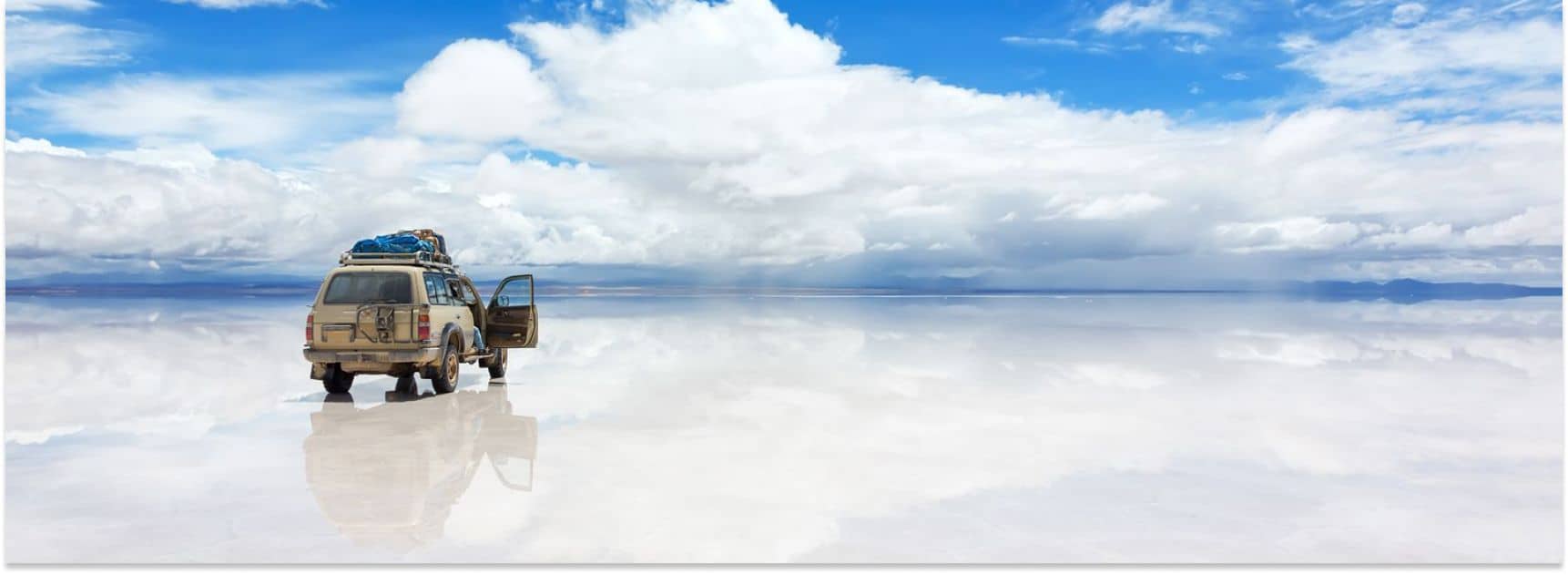
As with all tours, pick your tour operator carefully. There have been occasional issues with tour drivers drinking alcohol while driving 4×4 jeeps laden with travelers and causing some nasty crashes. It is why we strongly recommend to go with one of the best tour operators available. FindLocalTrips is probably the best place to compare operators and from our experience, they only work with the safest and most reliable operators. More information can be found here
Some basic information:
- If you are traveling South, you will usually take the La Paz to Uyuni trip
- If traveling North, you will either come from San Pedro de Atacama in Chile or from Salta in Argentina
- 3 day tours of the Salt Flats are the most popular and most complete options. 1 day tours are ideal for those short on time
- On 3 day tours, you do NOT have to return to Uyuni if you do not wish…you can finish the 3day your in San Pedro (if going to Chile after Bolivia)
- It IS possible to do the following if short on time:
- Night bus from La Paz to Uyuni (9hrs)
- Arrive Uyuni AM and take full day (1day) tour
- On same day, take a night bus back to La Paz (9hrs)
- For buses to/from La Paz, we strongly recommend using the Bolivia Hop bus
- For buses to/from Uyuni, we strongly recommend using Todo Turismo
If you want detailed information on a full day (1 day) tour or the 3day tour, click on any of the tabs below to get a full and detailed itinerary and tips on what to bring etc.
The unique setting of endless salt flat at Salar de Uyuni make all kinds of crazy perspective photography possible. Here we have our top tips for great Salt Flats photos to add to your collection.
- Bring as much small and interesting items as possible: toy animals and action figures, toy vehicles and regular props such as sunglasses, hiking boots, and water bottles can all be turned into something funny and useful
- To set up for the shot the photographer needs to lie on their stomach and rest the camera on the ground to make positioning much easier; holding the camera in your hand makes it next to impossible
- Advice from an old photographer: “Shoot, shoot, shoot!!” Take lots and lots of shots since it’s not so easy to see your camera screen in the glare and you might never be back here again
- Making everyone jump in the air is a last resort shot that can always come out well!!!
Will I get problems with altitude sickness at the Salar de Uyuni?
IMPORTANT: IF TRAVELING FROM LA PAZ (also at high altitude) you should be fine in Uyuni, once you have spent 1 or 2 days in La Paz, or even Cusco (Machu Picchu) in Peru.
Altitude sickness can catch many travellers a little bit off guard. Not everyone gets sick at high altitudes and it is difficult to predict who is likely to be badly affected by it. For most people it is nothing more than a headache and some dizzy sensations that diminish over a short period of time, 1 to 2 days for most people.
If you want to limit your chances of getting sick though, there are a few things you can do.
Drink lots of water and slow down!! This sounds simple but both of these things are very important. Your body is struggling because you don’t have enough oxygen so avoiding any extraneous activity is a good idea. Chew Some Coca Leaves. The native people of South America have been chewing coca for centuries thanks to its ability to alleviate mild altitude sickness symptoms. Coca leaves can be bought in any supermarket and even souvenir shops or street stalls.
Take (Soroche) Altitude Sickness pills, these are sold over the counter all over Peru and Bolivia and are just a few dollars. If you are flying straight into altitude over 2500meter, without spending any time at a intermediate elevation and you’re worried about getting sick, you can ask your doctor for more specific and stronger altitude sickness medication in advance.
From where do the tours of the Salt Flats start? Can I start from La Paz?
All of the tours of Salar de Uyuni start in Uyuni. The tours will not include your transfer from La Paz, you will need to organise and pay for this separately. The buses to Uyuni are overnight and depart La Paz every night and arrive into Uyuni the next day at approx. 7am. All the tours start at 10am-11am. It is strongly recommended to book your Uyuni tour online or in La Paz, NOT in Uyuni itself.
Do I need to stay one night in Uyuni before and after my tour?
You will arrive into Uyuni early in the morning and it is possible to start a tour the day you arrive. Most of the tours will start 10am-11am in the morning. You will return to Uyuni by 5:30 – 6:00 pm and will have time to eat and head back on the overnight bus to La Paz or take a bus onto Potosi / Sucre. It is advised that you book these buses in advance of taking your trip of the Salt Flats so no it is not necessary to stay in Uyuni.
Are there ATMs?
Bring money with you. Sometimes the ATMs do not work in Uyuni so it is best to take out any money you need in advance.
Will I have internet connection on a tour?
No, there is no internet connection on the tours. It is a very remote location.
We all agree that the Salt Flats in Uyuni, Bolivia are a MUST for any trip to South America. Uyuni is accessible mainly via La Paz, although other entrances are via San Pedro de Atacama and Patosi or Salta in Argentina. It is strongly recommend to book Salt Flat Tours in advance and only book with reputable companies (those with good reviews online or who allow you to book and pay online). Use Bolivia Hop to get to/from La Paz, use Todo Turismo to get to/from Uyuni, and use Find Local Trips to compare tour operators and book directly with them.
BOOK A BOLIVIA SALT FLATS TOUR
YOU MAY LIKE

Thank you for your message!
Speak to someone from our team by phone, time info is not avaliable.
- Av. Ferroviaria Nro. 332 (entre Av. Arce y Sucre)
- [email protected]
- +591.72418032
- Special tour: 1 day tour plus star tour
- Special tour: 2 days and 1 night plus stars tour
- Classic tour: 3 days and 2 nights
- Private Tour: 4 days and 3 nights
- PARAGLIDING TOUR
- STARS AND MILKY WAY TOUR
- BLOG & NEWS

Pure Adrenaline
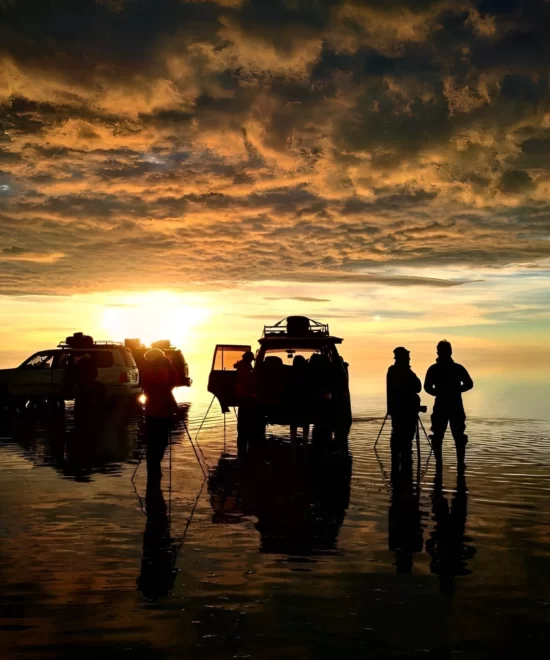
Unforgettable Moments
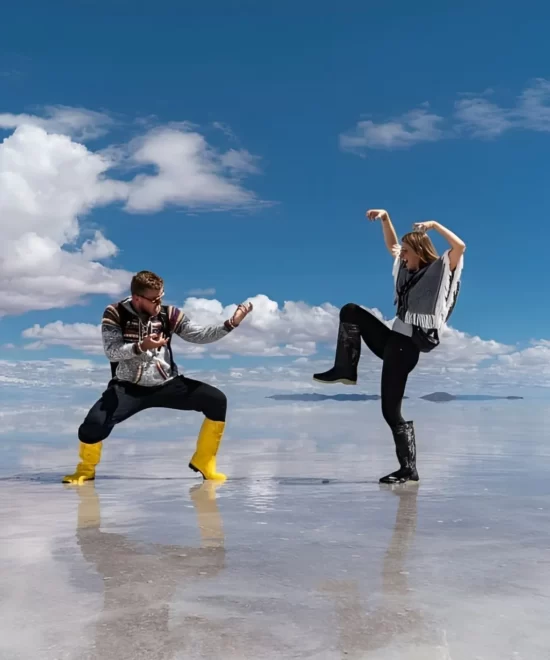
Infinity White

Deep Silence

Captivating Textures

Golden Sunrise
Pionners and founders of tourism in uyuni, extreme paragliding, surreal photography, expedition in 4x4, bath in hot springs, train cemeteries, uyuni tours: verified, experienced, safety-focused., uyuni tours bolivia.
Discover Uyuni's breathtaking beauty and magic.


Salar de Uyuni: The Ultimate Guide to Bolivia’s Majestic Salt Flats
Nestled high in the Bolivian Andes, Salar de Uyuni stands as a testament to nature’s awe-inspiring wonders. Spanning over 10,000 square kilometers, it’s the world’s largest salt flat, appearing as a vast white expanse that stretches to the horizon and merges with the sky.
Often referred to as the ‘world’s largest mirror’ (during the rainy season), this surreal landscape becomes a shimmering reflective surface during the rainy season, creating a dream-like setting that captivates travelers from across the globe.
But Salar de Uyuni is not just a visual marvel; it’s a destination imbued with history, geology, and cultural significance, making it a must-visit on any Bolivian itinerary.
Salar de Uyuni – A Trip Away From Earth
The Uyuni Salt Flats is the kind of place that makes your jaw drop when you see it and leaves you awe-stricken for the rest of your life. When I am asked to name a place that really, really struck me, the Uyuni Salt Flats (and the landscapes of the Eduardo Avaroa Reserve further south) immediately come to my mind.
It seems that it’s not just me. I remember meeting during my travels three couples who were on a round-the-world trip. These guys had seen the world. I met each of these couples on different occasions, and of course, they had never met each other. I asked them that same question – can you name one place in this world that really, really struck you: all of them promptly answered with a big smile, Salar de Uyuni. Coincidence?
This place has won the heart of every traveler who walked on it. How could it be otherwise? The truth is, we would not be too surprised to find this kind of landscape on some other planet, but on Earth? The Bolivian Salt Flats have the power to wake up the explorer inside every traveler.
And I know what I’m talking about. In fact, I have visited the Uyuni Salt Flats twice, during the same trip! I first took a classic group tour just like everybody else, to later realize that I hadn’t had enough of it, and went back on the Salar on a private tour. Yep, I can be that obsessive sometimes.

GPS (Isla Incahuasi): 20°14’35.30″S, 67°37’31.48″W
How to go: Group tour or Private tour from Uyuni or Tupiza
Price: 700-750 Bolivianos ($100-110) for a 3-day group tour with Spanish-speaking driver + 30 BOB ($5) entrance to Isla Incahuasi + 150 BOB ($25) entrance for the Eduardo Avaroa Reserve
Duration of the tours: Can be full day, 3 days (most popular) or more.
When to go: Possible all year long. December to March for the mirror effect.
Good to know: ATMs in Uyuni are not always reliable, better have some cash with you.
Where is Salar de Uyuni Located?
Salar de Uyuni, often referred to as the world’s largest salt flat, is situated in the southwestern region of Bolivia, nestled high in the Andes at an elevation of approximately 3,656 meters (or around 11,995 feet) above sea level. Specifically, it can be found within the Daniel Campos Province in the Potosí Department.
This vast expanse stretches over 10,582 square kilometers (or about 4,086 square miles), making it not only the world’s largest salt flat but also one of the most unique natural landscapes on Earth.
Its location, high in the Andean plateau, or Altiplano, contributes to its unique climate and geological formations. The town of Uyuni serves as the primary gateway to the salt flats and is the starting point for most tours and expeditions into this otherworldly landscape. Uyuni is accessible via bus, train, or plane from major Bolivian cities like La Paz and Sucre.

How Was Salar de Uyuni Formed?
The tale of Salar de Uyuni’s formation is as mesmerizing as the destination itself. Millions of years ago, this region was submerged under a vast prehistoric lake named Lake Minchin. As time went on, the lake transformed into two other significant bodies of water: Lake Tauca and Lake Ballivián.
However, due to climatic changes over millennia, these lakes eventually dried up about 15,000 years ago, leaving behind two primary modern lakes – Poopó and Uru Uru – and two major salt flats, with Salar de Uyuni being the most expansive of them.
The salt crust, which is several meters thick in some areas, overlays a reserve of brine that is exceptionally rich in lithium. In fact, it is estimated that Salar de Uyuni contains about 70% of the world’s known lithium reserves, a critical element used in electronic batteries.
The Legend of The Uyuni Salt Flats
Beyond its geological and economic significance, Salar de Uyuni has been an essential part of local indigenous lore. Legends speak of mountains – Tunupa, Kusku, and Kusina – once being giants who walked the Earth. As the tale goes, Tunupa’s tears and breast milk, after being separated from her child, are said to have created the salt flats.
Today, while visitors marvel at its vast beauty, the salt flat continues to be a source of livelihood for many locals who harvest salt and extract minerals from this unique terrain.

8 Surprising Facts About The Uyuni Salt Flats
- It is the largest salt flat in the world . 10,582 square kilometers (4,086 sq mi) of pure white salt. That means that it is very roughly 100 km (62 mi) from east to west, and also 100 km from north to south. It is so big that sometimes, the remote mountains seem to float over the horizon, like a mirage.
- It lies at 3660 m (12,000 ft) of altitude . The Uyuni Salt Flats are part of a large region called the Altiplano, shared between Peru and Bolivia . The Altiplano is the second-highest plateau in the world after the one in Tibet, and it also includes Lake Titicaca.
- The Salar de Uyuni was formed by the disappearance of an immense lake called Lago Minchin , about 15,000 years ago. The remains of this lake that exist today are the Uyuni and Coipasa salt flats, and the Poopo and Uru-Uru lakes.
- It has islands . An amazing feature of the Uyuni salt flats is its “islands” showing coral and algae fossils dating back from the ancient lake. One of these islands, the 24-hectare Isla Incahuasi (“House of the Inca”), has been developed for tourism, with the construction of a hiking trail and a restaurant to welcome tourists. The Salar’s biggest “island” is Isla del Pescado (Fish Island), 22 km (14 mi) away from Isla Incahuasi.
- The islands are covered with giant cacti. The most iconic plants of the region, these cacti are particularly concentrated on Incahuasi Island and Isla del Pescado. Some of them are believed to be over a thousand years old. Do you realize how unique, bizarre, and incredible this place is? “Islands” made of fossil coral formations, covered with giant cacti, in the middle of an immense crust of salt!

- It is covered with mysterious hexagonal shapes. These amazing shapes have been a mystery for quite some time, but it is now thought to be the result of a convection phenomenon below the salt flat’s surface. Below the surface, there is an accumulation of rainwater. The action of the sun causes the evaporation of this water. During its migration toward the surface, the water is accumulating more and more salt. Because its salt concentration increased, this water became heavier, which leads it to sink back down. During this process, some of the water evaporates, revealing the shape of the convection cells: the hexagons. The salt crystallizes as the water evaporates, forming the ridges of the hexagons.
- A world of salt… and lithium. It is estimated that the Salar de Uyuni contains about 10 billion tons of salt, and in some areas its thickness can reach 10 metres (33 ft). The locals of the Colchani village harvest around 25,000 tons of salt a year. Uyuni is also a gigantic reservoir of lithium, an estimated 15% of the world’s reserves. It is now extracted as well, from a site in the south of the Salar.
- The Salar de Uyuni is useful for calibrating satellites. Scientists consider the Bolivian salt flat to be one of the best places on Earth to calibrate satellite altimeters (used to measure land elevation) because the skies are often clear, and unlike the ocean, it has no waves.

When to Visit Salar de Uyuni
Salar de Uyuni offers distinct experiences depending on when you choose to visit. The vast salt flat undergoes remarkable transformations with the seasons, making each visit unique.
Wet Season (December to April)
Unique Experiences : The rainy season transforms the salt flats into a vast mirror, reflecting the sky so perfectly that the horizon seems to disappear. This ethereal landscape provides an unparalleled opportunity for breathtaking photographs, where the sky and ground merge seamlessly.
Pros : The reflective properties of the wet salt flats are a photographer’s dream. The landscape is serene, and the atmosphere is surreal, especially during sunrise and sunset.
Cons : Some parts of the salt flats can be inaccessible due to excessive water, especially after heavy rains. Additionally, the chances of rain and cloud cover can sometimes obscure views of the sky and surrounding landscapes.
Dry Season (May to November)
Unique Experiences : The salt crystallizes and forms hexagonal patterns on the ground, creating a mosaic-like texture. It’s the best time to explore the entire expanse, including isolated spots and islands like Incahuasi.
Pros : Better accessibility across the salt flats, clearer skies, and cooler temperatures. The crystallized salt patterns offer unique photographic opportunities.
Cons : The absence of the reflective mirror effect. The landscape, while still stunning, is more consistent and doesn’t offer the dramatic visual contrasts of the wet season.

How to Get There
Getting to the gateway of Salar de Uyuni, the town of Uyuni, is relatively straightforward, and there are various means of transport available based on your preferences and budget.
Uyuni has an airport, Joya Andina Airport, which connects it with Bolivia’s major cities. Airlines like Boliviana de Aviación (BoA) and Amaszonas operate regular flights from La Paz, Bolivia’s administrative capital, to Uyuni.
The flight is short, roughly an hour, and offers aerial glimpses of the salt flats. Prices can of course vary but are generally between $60 and $200.
For budget travelers, several bus companies operate overnight routes from La Paz to Uyuni. The journey takes about 10 to 12 hours. While buses are cost-effective, be prepared for a bumpy ride on rough roads. It’s advisable to opt for semi-cama or cama services for more comfort.
- From La Paz: Night buses leave La Paz at around 8:30 or 9 pm, and arrive in Uyuni 9 hours later, at 5.30 or 6 am. The price is roughly between $15 and $25.
- From Cochabamba: There is a direct night bus leaving at 6 pm and arriving at 6 am. Other options all have a connection in Oruro. Price $10-$15.
- From Sucre: There are some direct buses as well as options with a connection in Potosi. The ride lasts about 8 hours and costs around $10-$15.
You can easily find and book buses from the TicketsBolivia website.
Want to read a crazy story? You can read about my arrival in Uyuni in the middle of the night when I was saved by a drunk guy.
Another scenic option is the train. Trains operated by Empresa Ferroviaria Andina run between Oruro and Uyuni. International travelers can first take a bus or train from La Paz to Oruro and then board the train to Uyuni. The train journey offers picturesque views of the Bolivian highlands and is more comfortable than the bus.
Tips for Travelers
- It’s a good idea to book your transport in advance, especially during peak tourist seasons.
- If flying, be sure to account for potential altitude sickness, as Uyuni is over 3,600 meters above sea level.
- For those taking ground transport, pack snacks and water, as the journey can be long, and services en route might be limited.

Tours and Exploration
Salar de Uyuni is a destination that invites exploration, and there are numerous ways to experience its vast beauty, from guided tours to private expeditions. Here’s a breakdown of the options available:
Types of Tours Available
The classic way of visiting the Uyuni Salt Flats is to sign up for a group tour, usually done with a 4WD Jeep.
Day Tours : The first option is a day tour from Uyuni, which will take you to a famous train cemetery, before going on the Salar and exploring its main attractions, such as the village of Colchani, the Salt Hotel, and of course the Incahuasi Island and its giant cacti. Some tours let you watch the sunset from the salt flat, before taking you back to Uyuni.
Multiday Tours : A popular option is to go for a 3-day tour combining the Salar de Uyuni and the mind-blowing Eduardo Avaroa National Reserve , in the Sur Lípez Province. I took such a tour when I saw Uyuni for the first time. But I can already tell you it was one of the most breathtaking regions I have ever seen in my entire life.
The 3-day tour takes you to the Uyuni Salt Flats of course, then heads south, crossing smaller salt flats, and passing by stunning colorful lagoons. There are the famous pink waters of the Laguna Colorada, but also a whole series of smaller lakes inhabited by flamingo colonies, high-altitude deserts, and geysers, all the way to the Laguna Verde, at the foot of the majestic Licancabur Volcano.
The price for such a 3-day tour is usually around $100-$115 in a local agency with a Spanish-speaking driver. But if you want an English-speaking driver, the price can easily go over $200.

Sunrise/Sunset Experiences : There’s nothing quite like watching the sun rise or set over the vast expanse of Salar de Uyuni. Many tours are timed to capture these mesmerizing moments.
Consider group size when choosing a tour. Smaller groups offer a more personalized experience. Ensure that the company respects local and environmental guidelines.
An alternative is to visit it from Tupiza , some 200 km (125 mi) south-east of Uyuni. Visiting it from Tupiza can make sense if you are arriving from Argentina via the border town of Villazon. Often, you will be offered the same 3-day tours, with a reverse itinerary, ending with the Salar de Uyuni. Thus, these tours can start in Tupiza and end in Uyuni.
If you are in Chile, you can also find tours from San Pedro de Atacama , going over the Eduardo Avaroa National Reserve and the Salar de Uyuni with a similar itinerary.
Private Car and Driver Option
For those seeking a bespoke experience, hiring a private car and driver can be the perfect choice. This allows for a flexible itinerary and access to lesser-visited spots.
I personally took this route during my second visit. It provided the freedom to explore hidden corners of the Salar, away from the usual tourist trails. This can be especially rewarding during sunrise or sunset, when you can find a quiet spot all to yourself.
What I did: In Tupiza, I got to know a local travel agent, and I went with him on a private 4-wheel drive tour on the Salar. It cost me $300 for 3 days. Alone in the Salar, where tourists usually don’t go, stopping wherever and whenever I want.
That’s how I got to hike on Isla del Pescado (Fish Island) and sleep in a salt hotel at the foot of Tunupa Volcano that I partially climbed the next day. When I go back to Bolivia someday, I will definitely do it again. I talk about this in greater detail further down this article.
Whether you are in Uyuni, Tupiza, or even San Pedro de Atacama in Chile, you can talk to a few travel agencies and they will most probably be able to offer you a private tour. Just talk to a few and compare prices.

Things to Do and Experience at Salar de Uyuni
Salar de Uyuni is replete with otherworldly sights and experiences. Whether you’re there for the landscapes, photography, or the sheer novelty of being in such a place, there’s something for everyone.
Mirror Effect During the Wet Season
Details: From December to April, the rainy season transforms the salt flats into an enormous natural mirror. Even a shallow layer of water reflects the sky perfectly, creating a dreamlike horizon.
Photography Tips: This optical wonder allows for stunning photography. Capturing sunrise or sunset during this time can result in awe-inspiring imagery where the horizon seems endless.
Experience: Walking on the flats during this time can feel like walking in the sky, a surreal experience that many describe as feeling like being on another planet.
Precautions: While the visuals are mesmerizing, travelers are advised to be cautious. Wet salt can be slippery, so ensure you’re wearing appropriate footwear. Make sure you are protected from the corrosion of the salt.
Perspective Photography Opportunities
Details: The vast and uniform backdrop of the Salar makes it an excellent canvas for playing with visual perspectives in photographs, where objects in the foreground seem disproportionately large compared to those in the background.
Props and Ideas: From creating scenes where it looks like you’re holding or kicking the sun, to using everyday items for exaggerated size comparisons, the possibilities are limitless. Some travelers bring small toys or props to make the photos more playful and memorable.
Tips: Ensure you have a camera with an adjustable lens or a smartphone with a wide-angle setting. Remember, the shadow can play a pivotal role in these shots, so mind the sun’s position. The best shots often require a low camera angle, so be prepared to get down on the ground!
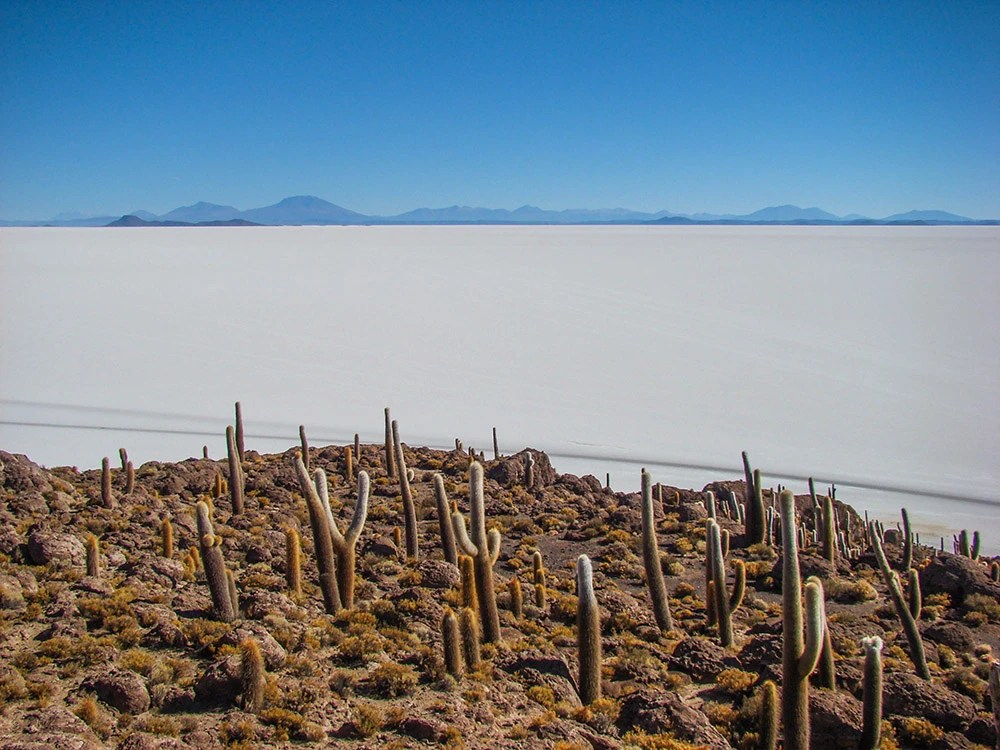
Incahuasi Island Visit
Details: Also known as the “Island of the Cactus,” Incahuasi Island is an ancient coral reef transformed into a hill, surrounded by a sea of salt. Rising from the salt flats, Incahuasi Island is a bizarre sight, dotted with giant cacti and offering panoramic views of the Salar. It’s a must-visit, both for the landscape and the unique ecosystem.
Flora and Fauna: This island is home to some of the world’s largest cacti, with some estimates suggesting they’re over 1,000 years old! Along with the cacti, you might also encounter native species like the viscacha (a type of rabbit-like rodent).
Viewpoint: There is a trail you can follow to explore a part of the island and its cacti. The hike to the island’s top is worth the effort as it provides panoramic vistas of the salt desert, especially enchanting during sunrise or sunset.
Entrance Fees: Note that there is usually a small fee to enter the island, which contributes to its maintenance.
Another Idea: If you are visiting Salar de Uyuni with a private driver and/or you happen to have some time to kill at Isla Incahuasi, I recommend going for a little hike all around the island. It takes around one hour, and you will have the immensity of the Salar all to yourself.

Venturing to Isla del Pescado
Details: Less frequented and less commercial than Incahuasi, Isla del Pescado offers similar breathtaking views but without the crowds. This island offers serene beauty and a sense of solitude, making it an ideal spot for those seeking tranquility.
Unique Landscape: Its distinctive fish-like shape can be appreciated when viewed from a distance or from an elevated position, which has earned it its name (‘Fish Island’ in Spanish).
Flora: Like Incahuasi, this island is populated with tall cacti and features unique rock formations, offering a mix of desert and oasis-like views.
Tips: Since it’s not on every tour itinerary, express your interest to your tour operator in advance or, as you’ve previously mentioned, hire a private driver to reach this hidden gem. That’s what I did, and it was amazing to scramble up the hill to the top of this pristine, wild island. Just be careful with the thorny bushes!
VIRTUAL TOUR – Salar de Uyuni
Hike on and around the famous Incahuasi Island, and discover the off-the-beaten-path Fish Island (3 panoramas).
The virtual tour opens in a lightbox. Use your mouse to move around the 360° panoramas.
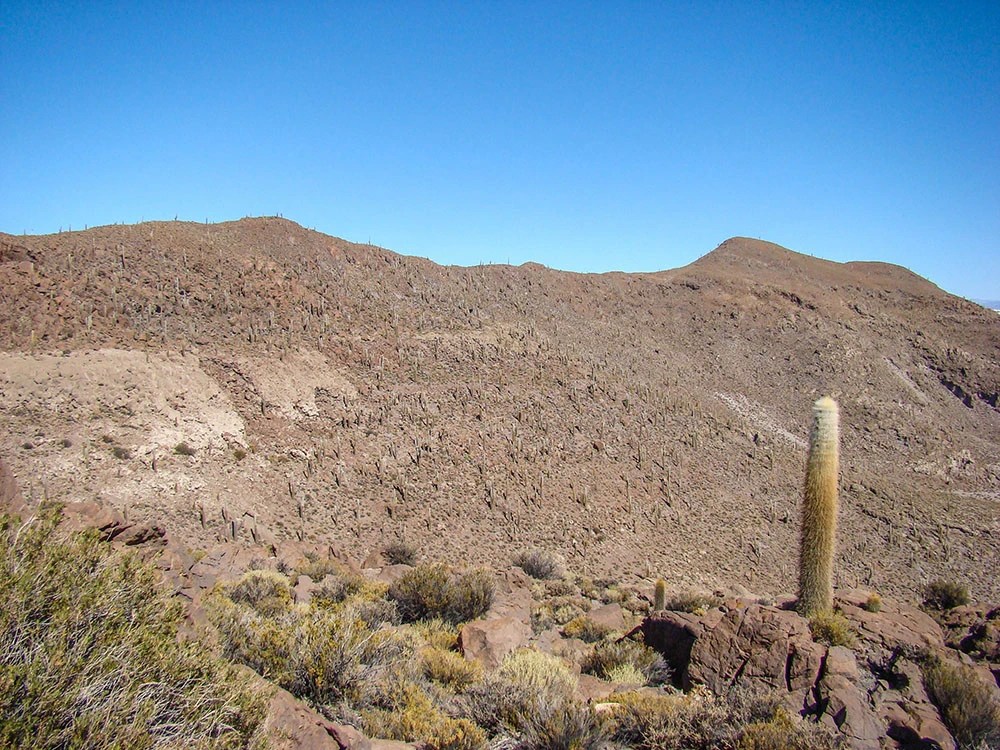
Visit the Palacio de Sal and the Flag Plaza
Details: The Palacio de Sal is the world’s first salt hotel, boasting walls, floors, ceilings, and even furniture made entirely from salt blocks harvested from Salar de Uyuni. It’s an architectural marvel and offers a unique accommodation experience, immersing visitors in the essence of the salt flats, and you can even check out salt sculptures.
Iconic Flag Plaza: Adjacent to the Salt Hotel is a spot where travelers from around the globe have planted their national flags, resulting in a colorful and vibrant display of international unity. It’s a testament to the universal appeal of the Salar de Uyuni and the shared journey of discovery.
Photography: The combination of the stark white salt hotel, the multi-colored flag plaza, and the vast salt flats horizon make for an excellent photography setting, capturing the essence of this unique travel destination.
Watch the Flamingos
Details: The salt flats near Coqueza are renowned for attracting several species of flamingos , including the Andean, James’s, and Chilean flamingos. These elegant birds flock to the region’s shallow waters, which are abundant in the microorganisms they feed on.
Best Viewing Spots: Apart from Coqueza and the Salar, lagoons such as Laguna Colorada and Laguna Hedionda (in the Eduardo Avaroa Reserve) are excellent habitats for these birds. The contrasting colors of these lagoons against the bright plumage of the flamingos make for spectacular photography.
Behavioral Observations: The flamingos’ unique feeding behavior, where they stir up the mud with their feet and filter-feed, can be observed here. Their graceful courtship dances during the mating season are also a highlight.
Tips: If bird-watching is a priority, consider hiring a local guide who knows the best spots and times to view these magnificent creatures. Also, visiting during the migratory season, from November to March, increases the chances of spotting large flocks.
Also read: Our Guide to Observing the Flamingos of Bolivia’s Salt Flats and Lagoons

Night Photography
Details: Salar de Uyuni, being far from major city lights, boasts incredibly clear skies. This, combined with the vast unobstructed horizon of the salt flats and the graphic shapes of the cacti, creates an unparalleled opportunity for astrophotography.
Milky Way Magic: The dense star clouds of the Milky Way, stretching across the sky, provide a stunning subject. With the salt flats beneath, photographers can play with reflections, creating mesmerizing compositions.
Meteor Showers and Celestial Events: Throughout the year, there are numerous meteor showers and other celestial events. Planning a visit around such occurrences can result in once-in-a-lifetime shots.
Tips: For optimal results, use a wide-angle lens with a large aperture (e.g., f/2.8 or wider) and a sturdy tripod. It’s essential to have a camera that performs well in low-light conditions. Shooting in RAW format allows for more flexibility during post-processing. Finally, familiarize yourself with the lunar calendar; a new moon phase ensures the darkest skies.

Wildlife of Salar de Uyuni
The salt flats might initially seem like an inhospitable environment, but a closer look reveals a surprising variety of life adapted to this unique ecosystem.
- James’s Flamingos: One of the rarer species of flamingos, these elegant birds can often be seen in the shallow waters of the Salar, especially during their breeding season.
- Vicuñas: These wild relatives of llamas and alpacas are known for their fine wool. They roam the areas surrounding the salt flats, grazing on the sparse vegetation.
- Andean fox: Also known as the culpeo, this fox can sometimes be spotted around the periphery of the salt flats, especially during the cooler parts of the day.
- Vizcachas: These rabbit-like rodents, belonging to the chinchilla family, are native to the Andes and can be seen around rocky outcrops near the salt flats.
Also read: 12 Incredible Wild Animals in Bolivia

- Giant Cacti: These cacti ( Echinopsis atacamensis subsp. pasacana ), native to Bolivia and Argentina, can grow up to 10-12 m / 32-39 ft tall. They bear rose-white flowers in spring and summer, and the fruits are edible. The pasacana subspecies is distinguished from the Chilean subspecies ( E. atacamensis subsp. atacamensis ) by the fact that is it usually branched. The Chilean subspecies is often unbranched and grows less tall. They are very slow-growing, only 1 cm / 0.4 inch per year on average.
- Quinoa: Not just a trendy health food, quinoa plants grow in the higher altitudes around Salar de Uyuni. The region is known for its many colored varieties of this crop.
- Llareta: These are dense, moss-like plants found in the high-altitude regions of the Andes. They grow extremely slowly and can be several thousands of years old. Their compact shape helps conserve moisture.
Salar de Uyuni Overnight Private Tour: Itinerary Suggestion
Here I will briefly describe what I have done for my own private tour to the Uyuni Salt Flats so you can gain some insight and ideas if you wish to do the same.
Day 1 – Uyuni Salt Flats: Uyuni → Colchani → Incahuasi Island → Fish Island → Coqueza
You will leave from the town of Uyuni and head to the salt flats. You can stop at the same places where tour groups go, but since you have your own driver, you can take the time to see these places more in-depth. For example, in Colchani, I could wander in the area where the locals harvest the salt.

Then, go to the Incahuasi Island. It is the most touristy spot on the Salar, but unmissable. You can follow the tourist trail that ventures inside the cactus forest to get a good idea of what the place looks like and amazing panoramic views of the salt flats;
While I was there, I decided to hike all around the island, it took me an hour. And for the first time, I was all alone in the immensity of the Salar de Uyuni, an amazing feeling! I would definitely recommend anyone to do the same!

After that, you can start going off the beaten track. My driver took me to the Isla del Pescado (the Fish Island), the largest island on the salt flat. This time, there was no hiking trail, no restaurant, and no one. Pure wilderness. I hiked up the island among thorny shrubs and another cactus forest to a high point, from where I could enjoy a fabulous panorama of the Salar and the nearby Tunupa Volcano.
It is at the foot of this volcano, in the village of Coqueza, that I spent the night, in a hotel built with bricks of salt. On the way, we stopped by other smaller “islands”. From Coqueza, a flock of flamingos was nearby as the sun was setting on the salt flats, a beautiful birdwatching and photography moment.

Day 2 – Coqueza & Tunupa Volcano → Crossing the Salar → Uyuni
On the morning of this second day, my driver and I climbed the slopes of the Tunupa Volcano stopping just before its colorful crater. After that, the climb becomes more technical and required gear that we didn’t have. But it doesn’t matter, the goal was to appreciate the sheer size of the Salar de Uyuni, from this high point. I could see all the islands I had visited, including the small Incahuasi Island, far away in the distance.

The way back to Uyuni was pretty cool as well, I asked my driver to stop when we were near the center of the salt flats, to experience its immensity. Your world is just divided into 2 parts. 360 degrees of pure white salt in the bottom half, and pure blue sky in the top half.
My driver left me in Uyuni to continue my journey in Bolivia. After having experienced this, I really wish to go back to Bolivia and do a much longer private tour around the salt flats and the Altiplano. The cost is not the same of course, but the feeling of exclusivity is priceless.

Practical Tips for Travelers
A trip to Salar de Uyuni is a journey like no other. To ensure you make the most of your visit, and to keep inconveniences to a minimum, here are some practical tips:
Altitude Acclimatization : Uyuni is located at an elevation of around 3,650 meters (almost 12,000 feet). Some travelers might experience altitude sickness. I recommend spending a day or two in a city like La Paz or Potosí before heading to the salt flats, to acclimatize. Drinking lots of water, avoiding alcohol, and consuming coca tea can also help alleviate symptoms.
Sun Protection : Given the vast, reflective nature of the salt flats, sun protection is essential. High SPF sunscreen, sunglasses with UV protection, and a wide-brimmed hat are must-haves.
Stay Hydrated : The arid climate can be dehydrating. Always carry a refillable water bottle, and drink frequently.
Footwear : Opt for comfortable, closed shoes. If visiting during the wet season, waterproof boots can be beneficial due to the water on the salt flats.
Cash and Supplies : Uyuni is a small town, and while it has basic amenities, it’s best to withdraw cash in a larger city beforehand. Additionally, stock up on any special supplies or snacks, as variety can be limited.

Where to Stay & Eat
Uyuni offers a range of accommodations, catering to various budgets and preferences.
Salt Hotels : Unique to this region are hotels made entirely of salt blocks. These provide a unique lodging experience, combining rustic charm with modern comforts. Some popular options include Palacio de Sal and Hotel de Sal Luna Salada.
Traditional Accommodations : Apart from salt hotels, there are several other lodgings available, from budget hostels to more upscale options. Hotel Jardines de Uyuni, for instance, offers comfortable rooms and a pleasant garden setting.
Eateries : Uyuni’s culinary scene, while not extensive, offers some delightful spots to savor local and international dishes. Places like Minuteman Revolutionary Pizza serve up hearty meals, perfect after a day of exploring.
For local flavors, the town’s central market is a hub of activity, with vendors serving Bolivian staples like salteñas (savory pastries) and llajwa (a spicy tomato salsa).
Whether you’re dining in a restaurant or enjoying street food, always remember to drink bottled water and ensure that any fruits or vegetables are properly washed or cooked.

Photographic Wonders and Tips
The vast expanse of Salar de Uyuni is a canvas for photographers, offering unparalleled opportunities to capture the beauty of nature and play with perspectives. Here are some phenomena and tips to make the most of your photo sessions:
- Mirror Effect : The wet season transforms the salt flats into the world’s largest mirror. Capture stunning reflections of the sky, especially during sunrise and sunset. A polarizing filter can help manage reflections and enhance colors.
- Perspective Shots : The uniformity of the landscape allows for creative forced perspective photos. Bring props or toys, and experiment with positioning to create fun, illusionary shots.
- Night Photography : With minimal light pollution, the salt flats are an astronomer’s dream. Capture the Milky Way, star trails, or even meteor showers. Use a tripod and a wide-angle lens with a wide aperture for best results.
- Landmarks : While the endless horizon is captivating, don’t miss out on photographing landmarks like the Dakar Rally monument, the Playa Blanca salt hotel, and the flags representing various nations near the entrance of the salt flats.
- Battery Backup : Cold conditions can drain batteries quickly. Bring extra batteries and keep them warm.
- Lens Protection : Salt can be corrosive. Ensure you have lens protection and clean your equipment after the visit.
- Golden Hours : As with most outdoor photography, early mornings and late afternoons offer the best light.

What To Pack For The Uyuni Salt Flats
Packing Checklist for Salar de Uyuni
Preparing for the salt flats requires a mix of essentials to deal with the unique climate and terrain. Here’s a suggested packing list:
- Layered Clothing : Temperatures can vary dramatically. Pack light layers for daytime and warm, insulated clothing for the chilly nights.
- Waterproof Boots : Especially if visiting during the wet season.
- Warm Hat and Gloves : Essential for nighttime and early morning excursions.
- Sunglasses and Sunblock : The reflective nature of the flats intensifies sunlight.
- Reusable Water Bottle : Stay hydrated in the dry climate.
- Camera Gear : Extra batteries, lens protection, tripod for night shots.
- Sleeping Bags: If you don’t trust the hygiene of blankets and sleeping bags provided by travel agencies and hotels, you can bring your own sleeping bag. (But I didn’t and it was fine). Again, make sure it can withstand low temperatures, if you go in June-August.
- Headlamps: It is always useful to have a good headlamp for evening and nighttime
- Snacks : While tours usually include meals, it’s good to have some personal snacks.
- Personal Medications : Including altitude sickness pills if you’re prone to it.
- Cash : Not all places accept credit cards, and ATMs might be scarce.
- Swimwear : Some tours include visits to hot springs.
- Biodegradable Wet Wipes : Useful for quick freshening up.
- Portable Charger : Ensure your devices are always powered up.
Frequently Asked Questions About Salar de Uyuni
Salar de Uyuni spans approximately 10,582 square kilometers (4,086 sq mi), making it the world’s largest salt flat.
No, while Salar de Uyuni is the largest and most famous, Bolivia is home to several other salt flats, including Salar de Coipasa.
During the rainy season, a thin layer of water covers the salt flats. This transforms the vast expanse into a giant mirror, reflecting the sky.
Yes, it is generally safe, but it’s vital to choose a reputable tour operator and be prepared for altitude changes. Always follow guidelines and respect the local environment and culture.
While it’s possible, it’s not recommended unless you’re with a guide or have experience navigating such terrains. The vast, featureless landscape can be disorienting, and vehicles can damage the salt crust.
The crust’s thickness varies, but it averages about 2 meters (6.6 ft) deep.
Yes, there are a few salt hotels made entirely of salt blocks, providing a unique lodging experience.
Apart from tourism, locals harvest salt and extract lithium from the Salar. Bolivia holds a significant portion of the world’s lithium reserves, essential for batteries.
Given the vast temperature variations, layering is key. Bring sun protection for the day and warm clothes for the chilly nights.
Julien is an exploration-minded, curiosity-driven traveler and blogger. On a mission to witness the planet's natural beauty and diversity, he shares his experiences on this website through articles, videos, and photography, including interactive virtual tours.
Fascinated by animals and plants since young, he is also fond of outdoor and so-called extreme sports, often discovered while traveling and practiced back at home where he focuses on improving his knowledge and skills - so he can explore further on the next trip!
More About Me
You May Also Like

Meet The National Animal of Bolivia, The Llama

24 Things to Do in Bolivia for Life-Long Memories

The Freezing Night I Was Saved by a Drunk Guy

The 8 Most Stunning National Parks in Bolivia

Bolivia’s Mountains: Overview & How to Experience Them

Copacabana, Bolivia – Complete Guide to The Sunny Lakeside Destination
Fantastic, fascinating! I’m drooled all over just reading your travel in Salar del Uyuni. I’ve travelled to many countries in a few continents. Yet to do S America. Seems it’s a must do. Thanks for your wonderful and detail article. Will treasure this till I make a trip there.
Happy you found this inspiring! South America is my favorite part of the world, every corner of it is so unique and spectacular. I wish you to travel there ASAP and see it for yourself 🙂
Leave a Comment Cancel reply
Notify me of follow-up comments by email.
Notify me of new posts by email.
Privacy Overview

Getty Images/Lonely Planet Images
Salar de Uyuni
An evocative and eerie sight, the world’s largest salt flat measures 4674 sq mi (12,106 sq km) and sits at 11,984ft (3653m). When the surface is dry, the salar is a pure white expanse of the greatest nothing imaginable – just blue sky, white ground and you. When there’s a little water, the surface perfectly reflects the clouds and the blue altiplano sky, and the horizon disappears. If you’re driving across the surface at such times, the effect is surreal; it’s hard to believe that you’re not flying through the clouds.
Attractions
Must-see attractions.

Isla Incahuasi
One of the highlights of a Salar de Uyuni tour is a hike around the spectacular Isla Incahuasi, otherwise known as Inkawasi. It's located in the heart of…

Located right on the edge of Salar de Uyuni, Colchani is the easiest place to access the great salt flat and the place to go if you just want a glimpse of…

Playa Blanca Salt Hotel
Although it is now closed to overnight visitors, you can still check out the salt sculptures inside and the Dakar Rally and Flag Monuments outside (add…

Isla Cáscara de Huevo
The small 'Eggshell Island' was named for the broken shells of birds’ eggs that litter it. It's located near the southern end of Salar de Uyuni and is…

Museo Coquesa
This museum has a collection of ceramics and mummies.
Plan with a local
Experience the real Bolivia
Let a local expert craft your dream trip.


Salar de Uyuni – How to Visit The Bolivia Salt Flats
Written By: The Planet D
Updated On: June 21, 2023
The Salar de Uyuni is the biggest salt flat in the world and the most famous tourist draw in Bolivia, South America . In fact, for many travelers, the Bolivian Salt Flats is the sole reason they visit Bolivia. We do recommend that you visit more of Bolivia than just the salt flats, but if you want some epic pictures and an unforgettable experience you will want to put the Salar de Uyuni Salt Flats on your bucket list.
Ever since the Bolivia Salt Flats played host to the world-famous Dakar Rally in 2014, it has gained even more attention amongst travelers. “You will love it!” These were the words we had heard from other travelers every time we mentioned our plan to travel to the Bolivia Salt Flats. As you might imagine our expectations were sky-high and we couldn’t wait to see the white endless scenery.
Table of Contents
What is the Salar de Uyuni, Bolivia?
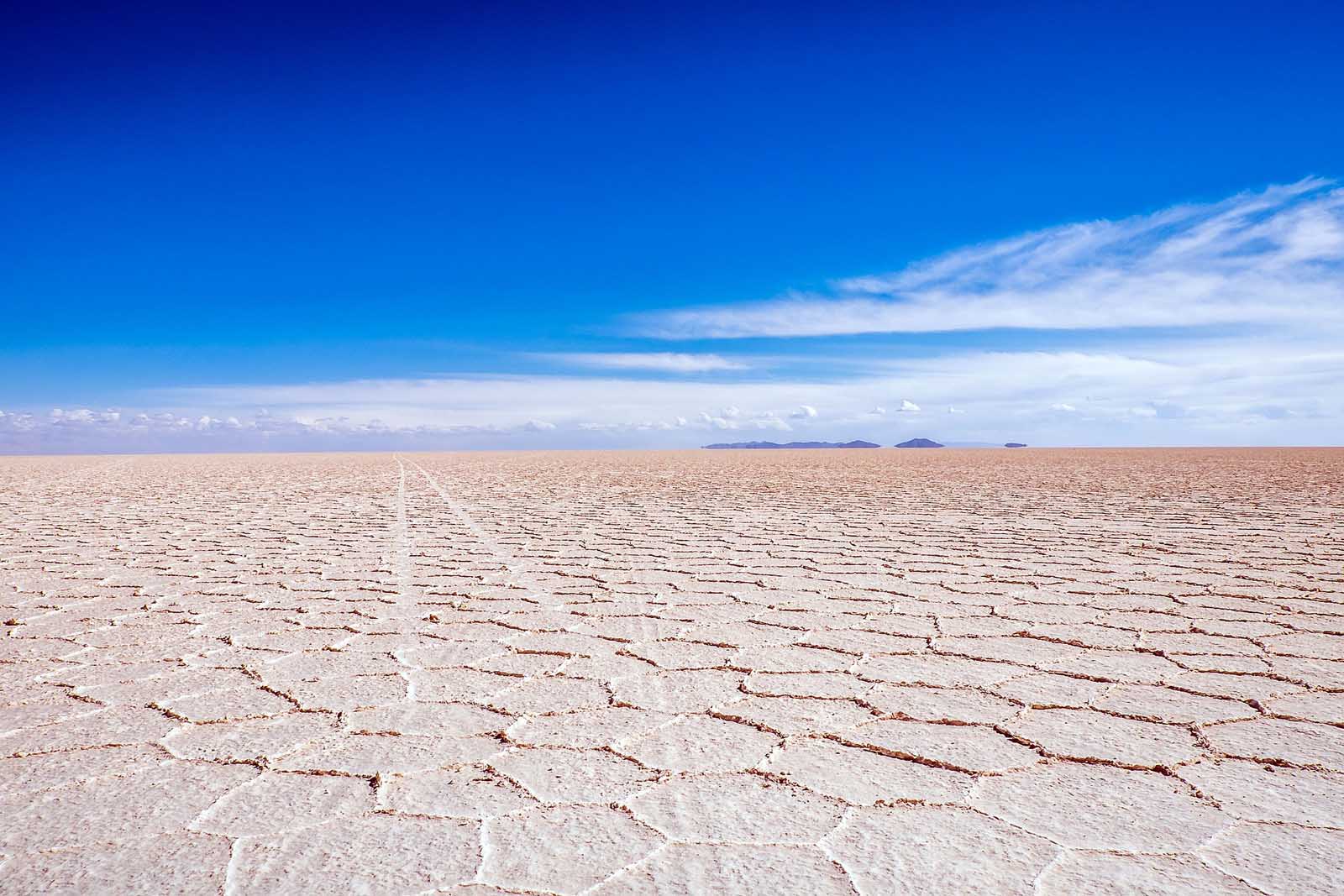
The Salar de Uyuni is one of the most spectacular adventure-travel destinations on Earth. Think 10 billion tons of salt sprawling across an endless desert. The Salar de Uyuni is a 10,582 square kilometer expanse of cracked white salt, left behind when an ancient salt lake named Coipasa dried up thousands of years ago.
Located in the Bolivian Altiplano, it is the world’s largest salt flat and is located at a high altitude of 3,656 meters (10,000 feet) above sea level.
Salar de Uyuni is made primarily of salt. It is a vast expanse of dried-up prehistoric lakes, and the salt flat itself is the result of the evaporation of water from these ancient lakes. Underneath the salt crust lies a thick layer of brine, which is a concentrated solution of salt and water.
The salt crust on the surface is composed mainly of sodium chloride (table salt) along with other minerals such as magnesium, potassium, and lithium. These minerals give the salt flat its unique colors and patterns. In fact, Salar de Uyuni is not just a salt flat but also contains significant lithium reserves, making it a valuable resource.
During the dry season, the salt crust hardens and forms a vast white landscape, creating a surreal and otherworldly appearance. However, in the rainy season, the flat transforms into a massive reflective surface, resembling a giant mirror due to a thin layer of water that covers the salt crust. This phenomenon creates stunning optical illusions and unique photo opportunities for visitors.
Uyuni Salt Flats Day Tours
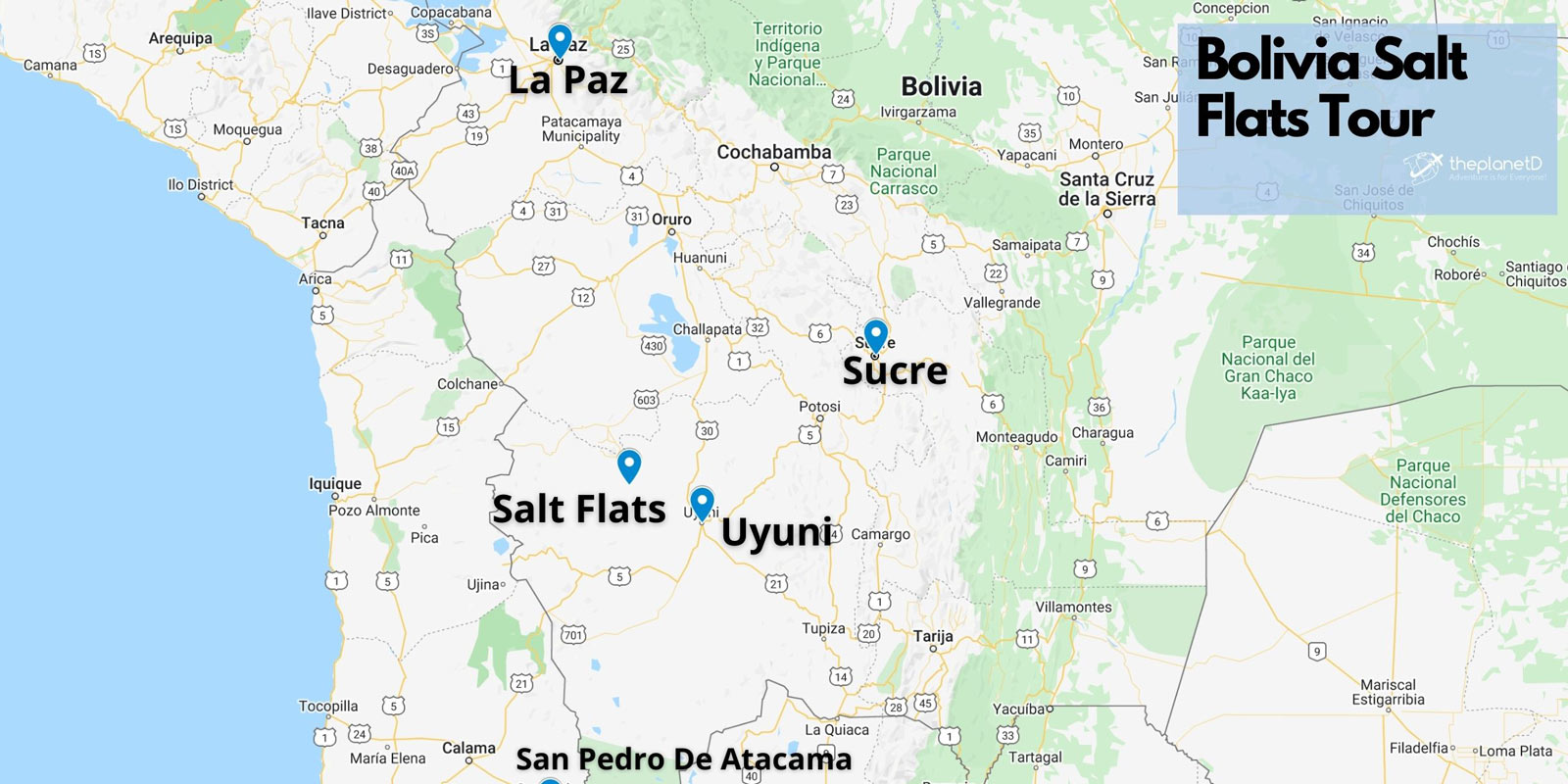
The beauty is that the tours are flexible. There are options for 1 day, 3 days, or 4 days, depending on what your schedule is and how much time you want to spend in the area itself. We recommend the 3 or 4-day option as it covers the most.
Most Salar de Uyuni, including ours, meant spending four days locked in a jeep with three other travelers and a cook while our amiable Bolivian driver took us through an increasingly unbelievable array of natural wonders. This is the best way to see the Uyuni salt flats in my opinion.
We have included a map below to give you an idea of where in Bolivia the slat flats are in relation to the rest of the country.
Where do Bolivia Salt Flats Tours Start From?
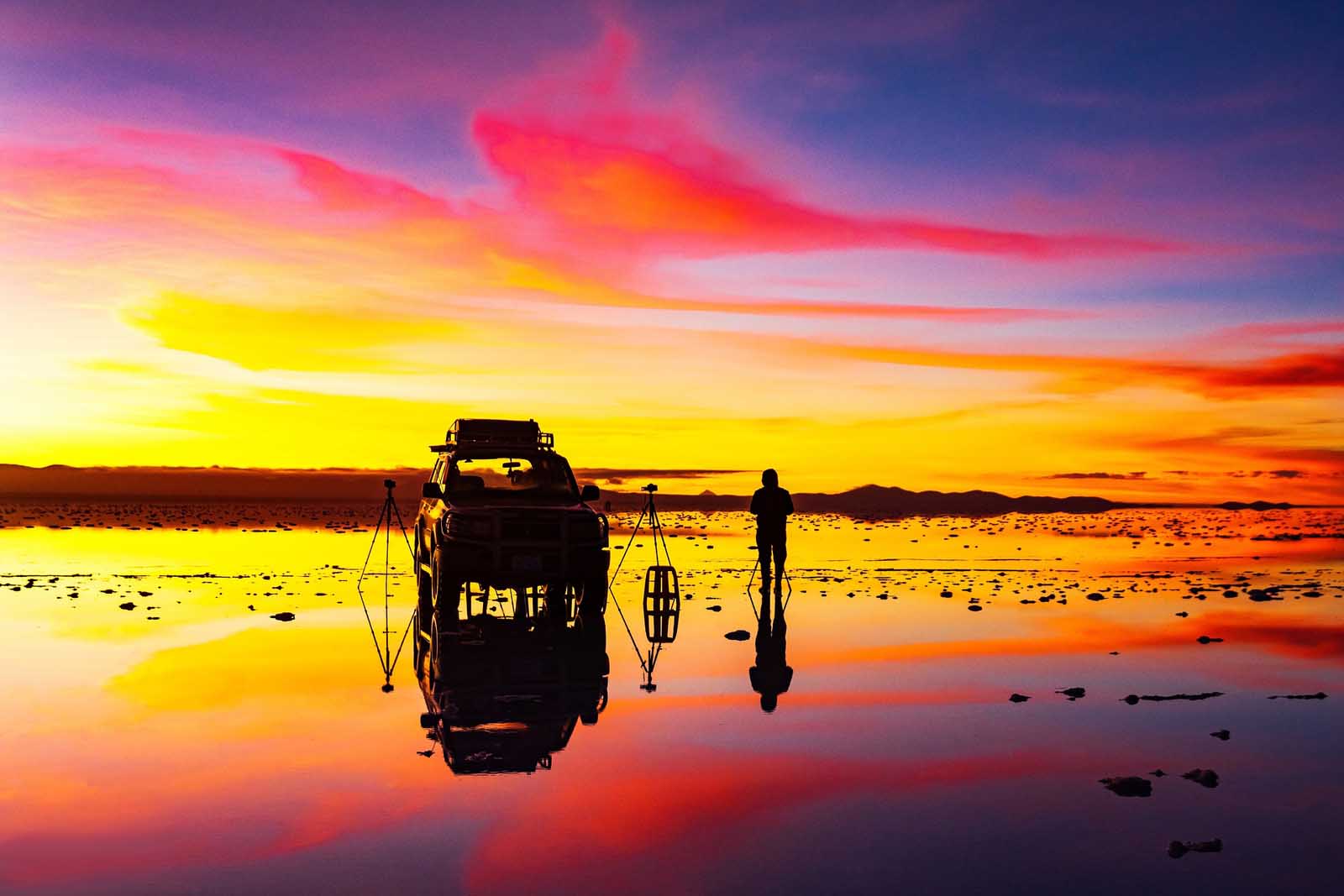
The beauty of the Salt Flats being so popular is that tours to the area start from a number of different places. For the most part, the length of your salt flats tour will determine where you start.
Start and End in Uyuni
Most tours of Salar de Uyuni leave from the town of Uyuni itself, a dry desert settlement located near the salt flats. It’s by far the cheapest place to pick up a tour, with trips on offer for as low as B$600 (about $80 USD). This is most likely the place you will start out if you are doing a 1 Day tour of the salt flats . We do recommend being cautious and doing your research as we found that quite a few of the tour agencies in Uyuni tout unreliable cars and dangerous drivers.
If you are planning a 3 or 4-day tour then there are a lot more options to choose from when it comes to a starting point and an ending point.
Start in Tupiza End in Uyulni
A more pleasant (if slightly pricier) experience can be had by taking the back road to the Salar, leaving from the south-Bolivian city of Tupiza. Home to a handful of tour agencies and a pleasant main plaza, Tupiza is a relaxing place to spend a couple of days while researching agency options. Tours from here usually last 4 days and at the end, you can return to Tupiza from Salar de Uyuni if you like.
Start in Uyuni End in San Pedro de Atacama in Chile
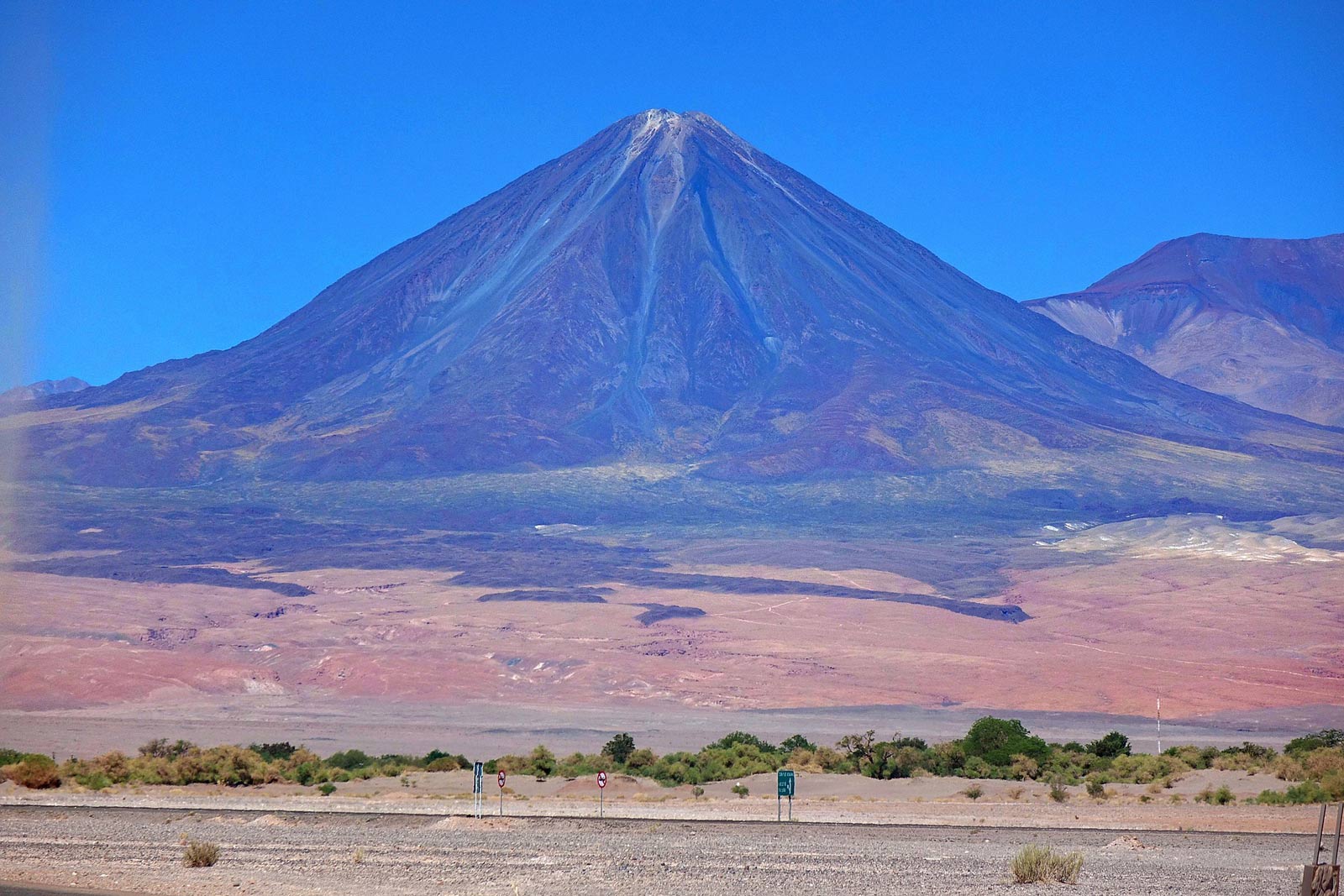
This is the most popular option, especially if you are looking at a multi-day tour. Alternatively, if you have money to burn, you could begin your tour from San Pedro de Atacama , a beautiful (if absurdly touristy) village in nearby Chile.
Located on Chile’s border with Bolivia, San Pedro de Atacama is surrounded by spectacular scenery of its own to explore–but it’s not for the faint of wallet. This is one of the reasons we recommend booking the tour that starts in Uyuni and ends in Chile at San Pedro de Atacama.
Altitude Sickness
If you do decide to start in San Pedro remember that you will be at a high altitude, so there is a risk of altitude sickness if you don’t take care to acclimate. Drink plenty of water and don’t over-exert.
At this high of elevation, there is a real threat of getting sick. Keep an eye out for altitude sickness symptoms which include headache, nausea, and vomiting when severe. We recommend visiting a travel clinic before visiting Salar de Uyuni. Your doctor may prescribe Diamox. Locals also recommend coca tea made from coca leaves.
La Paz or Sucre
If you are looking just for a quick day tour of the salt flats then you can easily jump on one in either La Paz or Sucre, if you are in those cities and you have a limited amount of time.
How Many Days in the Bolivia Salt Flats Do You Need?
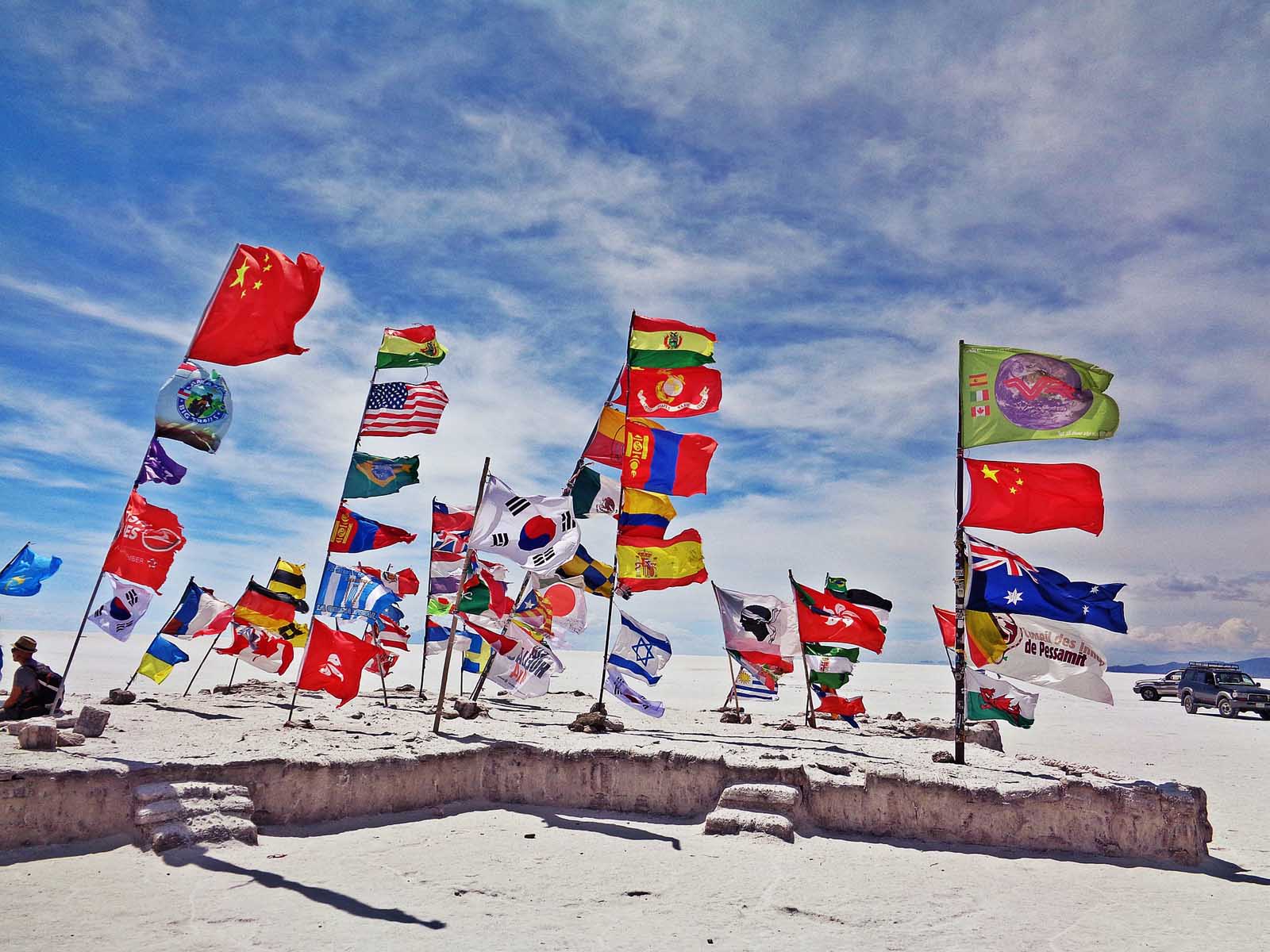
We recommend the 3 or 4-day tour of the Uyuni Salt Flats. Although you can do a 1-day tour of the salt flats themselves you really do miss out on the other attractions that are covered in the 3 and 4-day tour. The longer tours are more popular for this reason.
Of course, it will all depend on your budget and travel itinerary which length of trip you choose. Just be aware that on the 1-day tour you miss out on the hot springs, the volcano, and the flamingoes and you don’t get the chance to see this amazing sight at sunset. Being a photographer this is a must!
The 3-day tour of the Uyuni Salt Flats is the perfect amount of time to balance being at altitude and seeing it all.
How to Choose Your Bolivia Salt Flats Tour
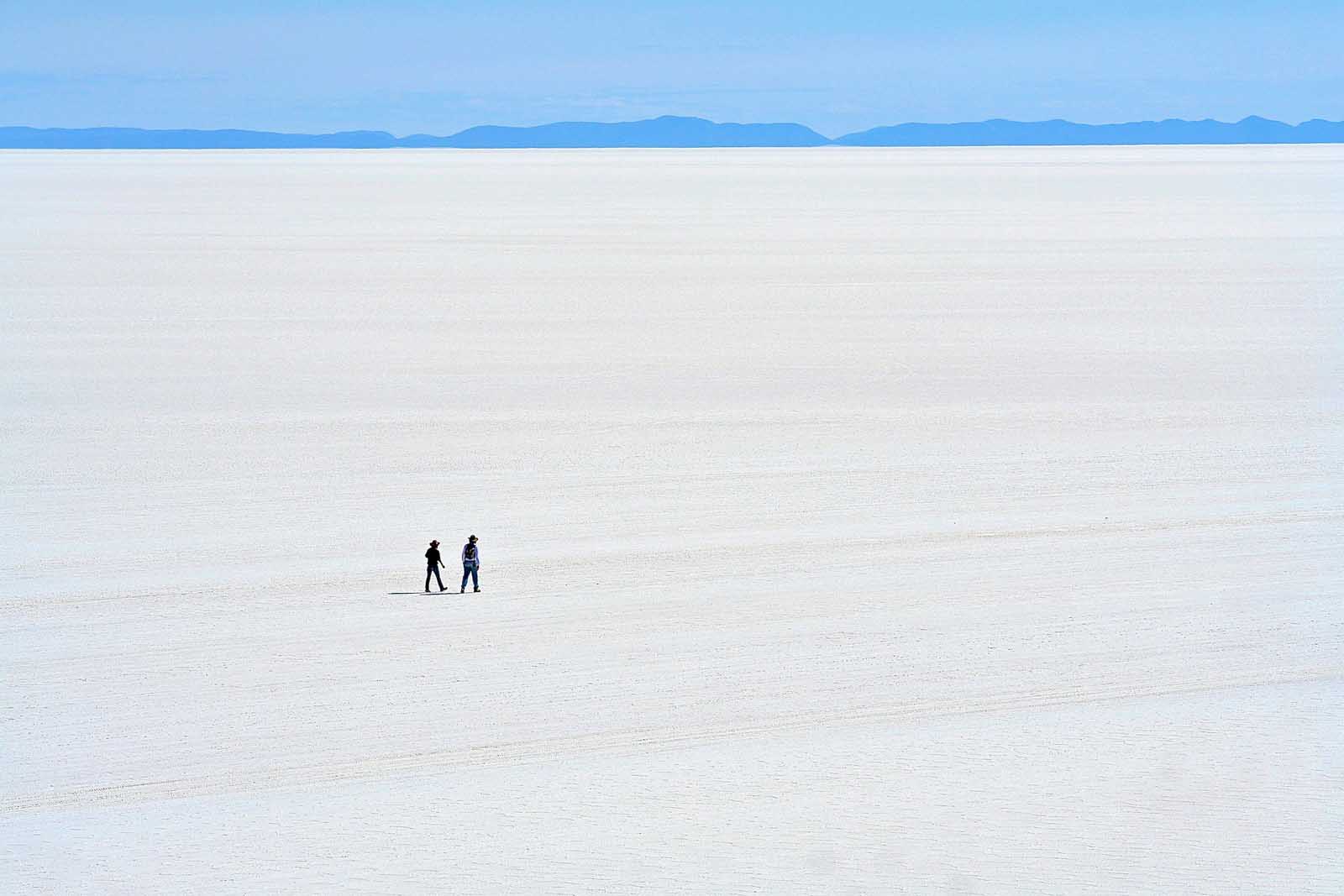
There are many tour agencies and many drivers offering tourists an Uyuni experience-but not all of them are reliable. Drunken drivers and sham agencies abound, so be sure to research your options carefully and meet your driver before putting down money. If things seem shady, don’t be afraid to back out.
Some tour operators are all too good at pressuring tourists to ignore their better instincts. The agency I chose was named Natural Adventure , an operator based out of the small Bolivian city of Tupiza.
I had a very good experience with them; though my driver didn’t speak much English, he made up for it with friendliness, verve, and expressive hand gestures.
The truth is that all the tours will cover the same things. It is pretty standard. They will try and upsell you and convince you that they have faster cars or better accommodation just to get more money out of you. If you ask the right questions you will definitely up your chances of getting a great tour.
Recommended Tours to Book Ahead of Time
Questions to Ask Before Booking a Tour to the Uyuni Salt Flats
- How Many People will be in my car? Obviously the smaller amount of people the better. But most tours try and get 6 people plus a driver in a vehicle.
- What type of accommodations are offered? Will you be staying in a salt hotel, sharing a room, or all in one big room?
- Does my driver speak English? Most drivers are also your guide and cook and don’t speak much english. It helps if you know some spanish or you are good at acting things out.
- Is the entrance to the National park included? The usual answer to this is no, but some do offer it. If it is not then be prepared to fork over an extra of 150 Bob ($22 USD). If you plan on visiting “Fish Island” within Uyuni salt lake that will cost you extra as well.
- Where does the tour end? Will you be coming back to Uyuni or doest t finish in another destination like San Pedro de Atacama in Chile. The coice is usually yours.
How Much Does it Cost to Visit the Bolivia Salt Flats?
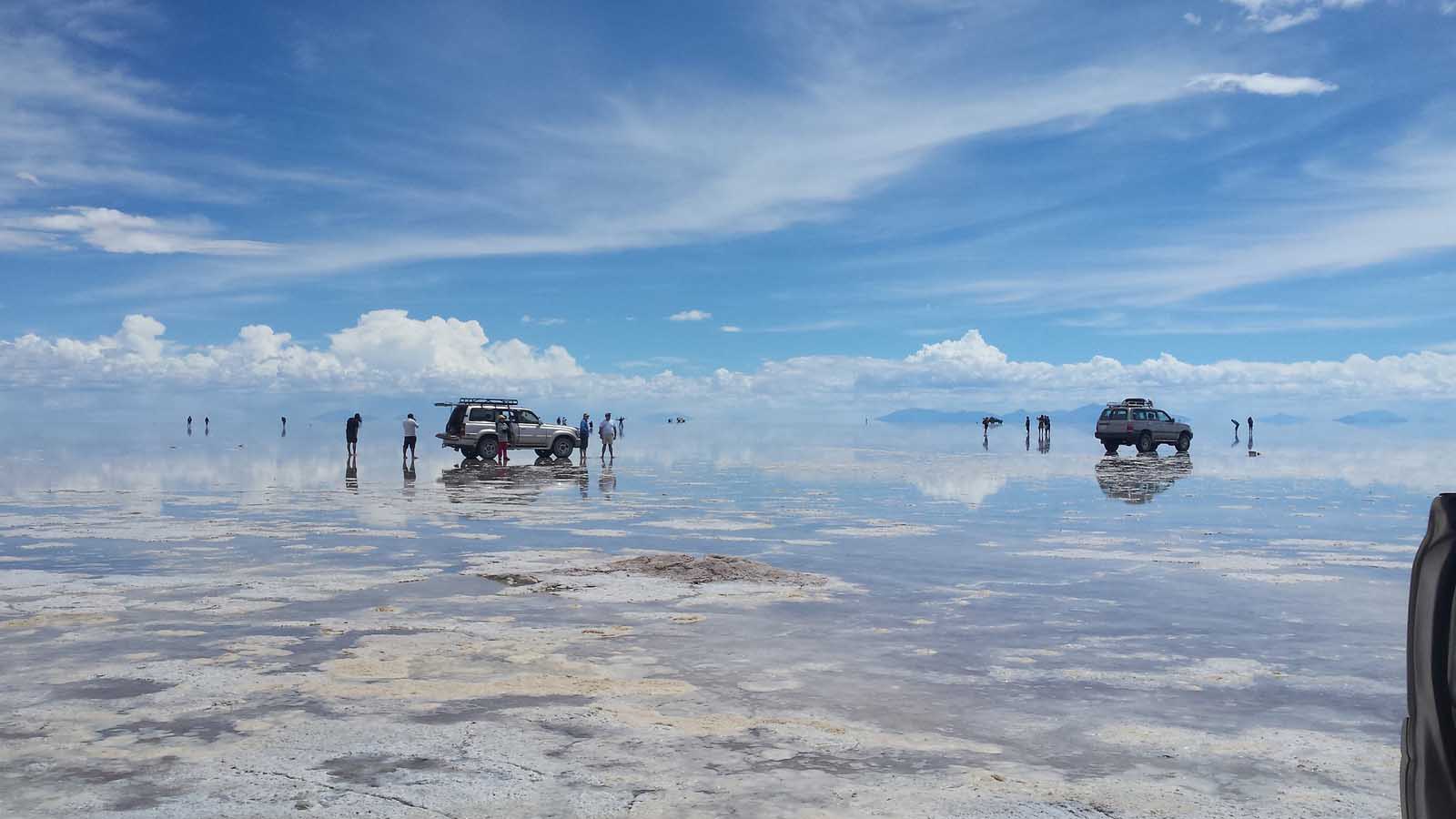
As we said above, all of the tours are the same and follow the same route. Do not be fooled by people trying to upsell you to a better tour. The car and the accommodation may change but the tours themselves are identical. That being said the price varies widely, so you are going to have to negotiate the best price.
You should not pay more than 850-1350 Bob for a 3-day tour ($125 – $195 USD) . This price is all-inclusive of food, transportation, accommodation, and a Spanish-speaking guide. If you want an English-speaking guide prepare to pay double. What it does not include is the $20 fee to get into the National Park, so make sure you have cash for that. If you are planning on going to San Pedro de Atacama then you will also need 50 Bob for the border crossing. It is always good to have some cash on you.
It is important to note that the prices above are if you book your tour on arrival or in Bolivia itself. If you book your tour online before you travel the cost can be almost double.
What are the Accommodation Options on the Salar de Uyuni Salt Flats Tours?
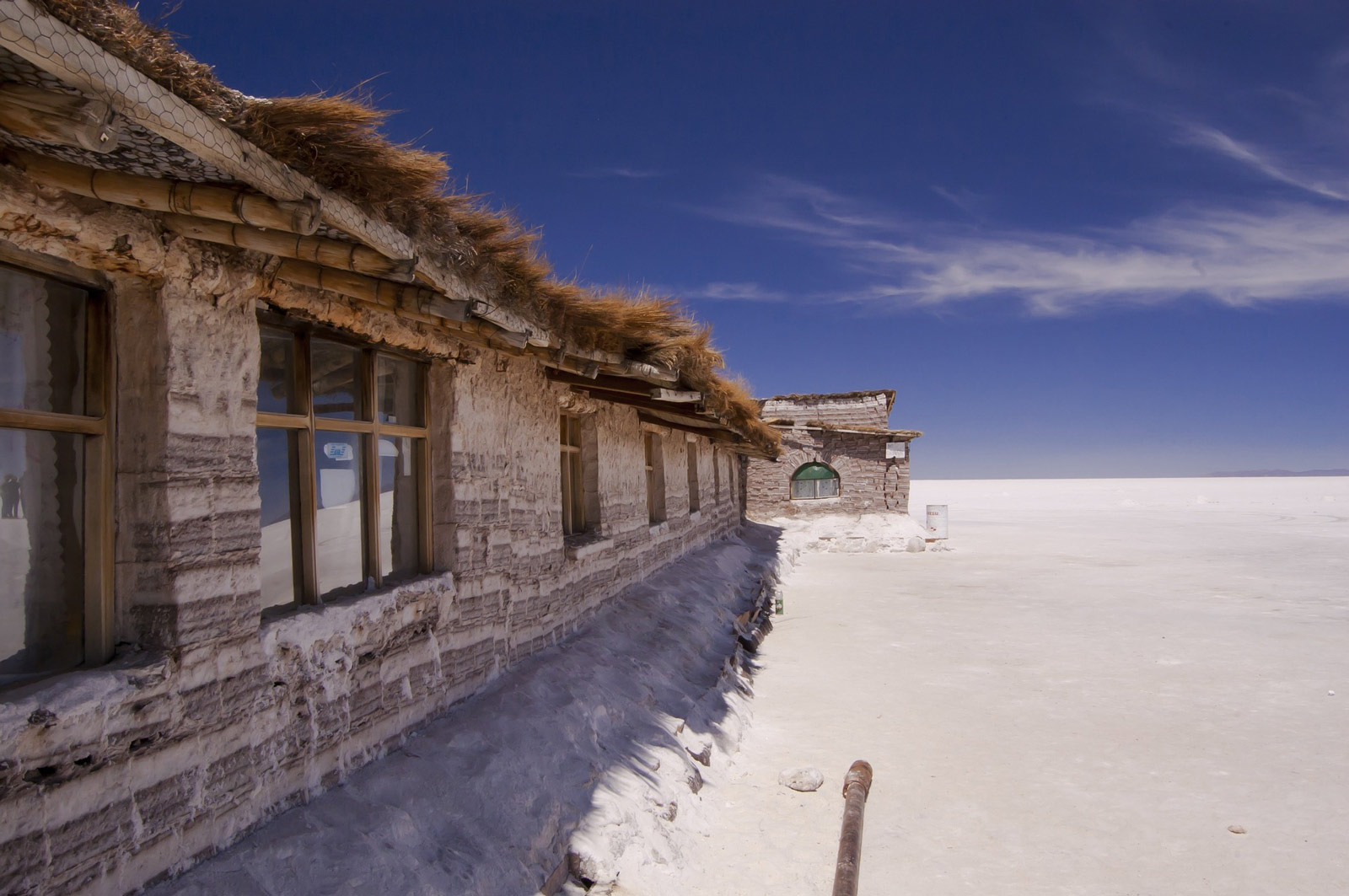
While tours themselves are markets as basic, I would say that we were pleasantly surprised. We have stayed in some basic places over the years but were fairly impressed when you consider the cost of the tour.
You will spend the first night of the tour in a salt hotel, which we loved. Now when I say a salt hotel, I mean everything is made of salt. The hotel exterior is made of salt blocks, the chairs, ground, and bed are also made of salt. We were happy to have private rooms on the first night to really enjoy it. There was also a shower which cost 10BS and had enough water for 2 people. Take advantage of it as there are no other showers on the tour.
The other nights we slept in dorm-type rooms, but you can pay an extra 150Bs for a private room, which we did. The buildings are clean and well taken care of so you never felt like you were on an ultra-budget tour.
There is no WIFI out here so you will be disconnected which we found a welcome reprieve from constantly checking phones each day.
The way the meals are set up is that breakfast and dinner are served at the accommodation and the lunch is always on the road. The food itself was not fine dining but it was tasty and there was always enough.
Where to Stay Near Salar de Uyuni
While there aren’t many accommodation options directly on the salt flats themselves, the nearby town of Uyuni offers various choices for visitors. Here are some suggestions on where to stay:
Uyuni town: This is the most convenient place to stay as it offers a range of hotels, hostels, and guesthouses catering to different budgets. You’ll find options ranging from basic accommodations to more luxurious hotels. Staying in Uyuni allows you to easily access Salar de Uyuni and other nearby attractions.
Colchani: Situated on the edge of Salar de Uyuni, Colchani is a small village known for its salt processing industry. It offers a few accommodations that provide a unique experience closer to the salt flats. Keep in mind that the options may be limited compared to Uyuni town.
Salt hotels: Some unique accommodations are built entirely from salt blocks, providing a distinctive experience for visitors. These hotels are typically located on the outskirts of Uyuni and offer a blend of comfort and the chance to immerse yourself in the salt flat surroundings.
Palacio de Sal is a luxury hotel and spa that was the first salt hotel. Located near the entrance of Salar de Uyuni near Colchani, this is a popular place to stay.
Salt flats camping : For an adventurous experience, you may consider camping on the salt flats. There are tour operators that offer overnight camping trips, providing tents, sleeping bags, and meals. This option allows you to witness the stunning sunsets and starry nights of the salt flats.
How to Dress for a Salar de Uyuni Tour
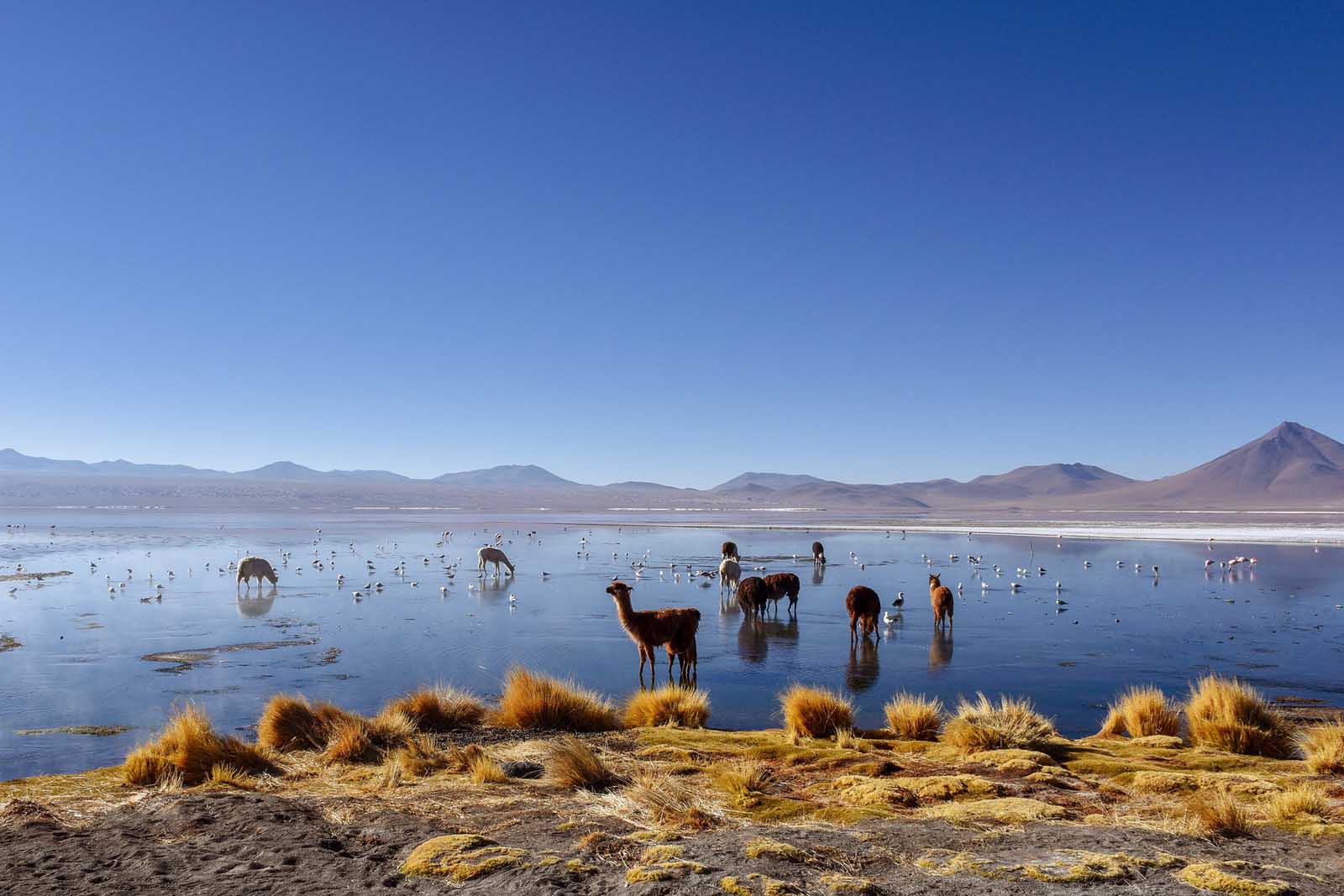
Travel through Bolivia’s southwest corner means splitting your time between extreme warmth, under the startlingly hot midday sun, and extreme cold, when the chilly high altitude nights creep in.
It’s a good idea to dress in layers–that way, you can layer up as the sun drops, then shed clothing again when it rises. During parts of the Uyuni tour, temperatures can drop as low as -15 degrees celsius, so it’s vital to make sure that you have some warm clothes packed. Read our layering tips for packing.
How to Get to Salar de Uyuni
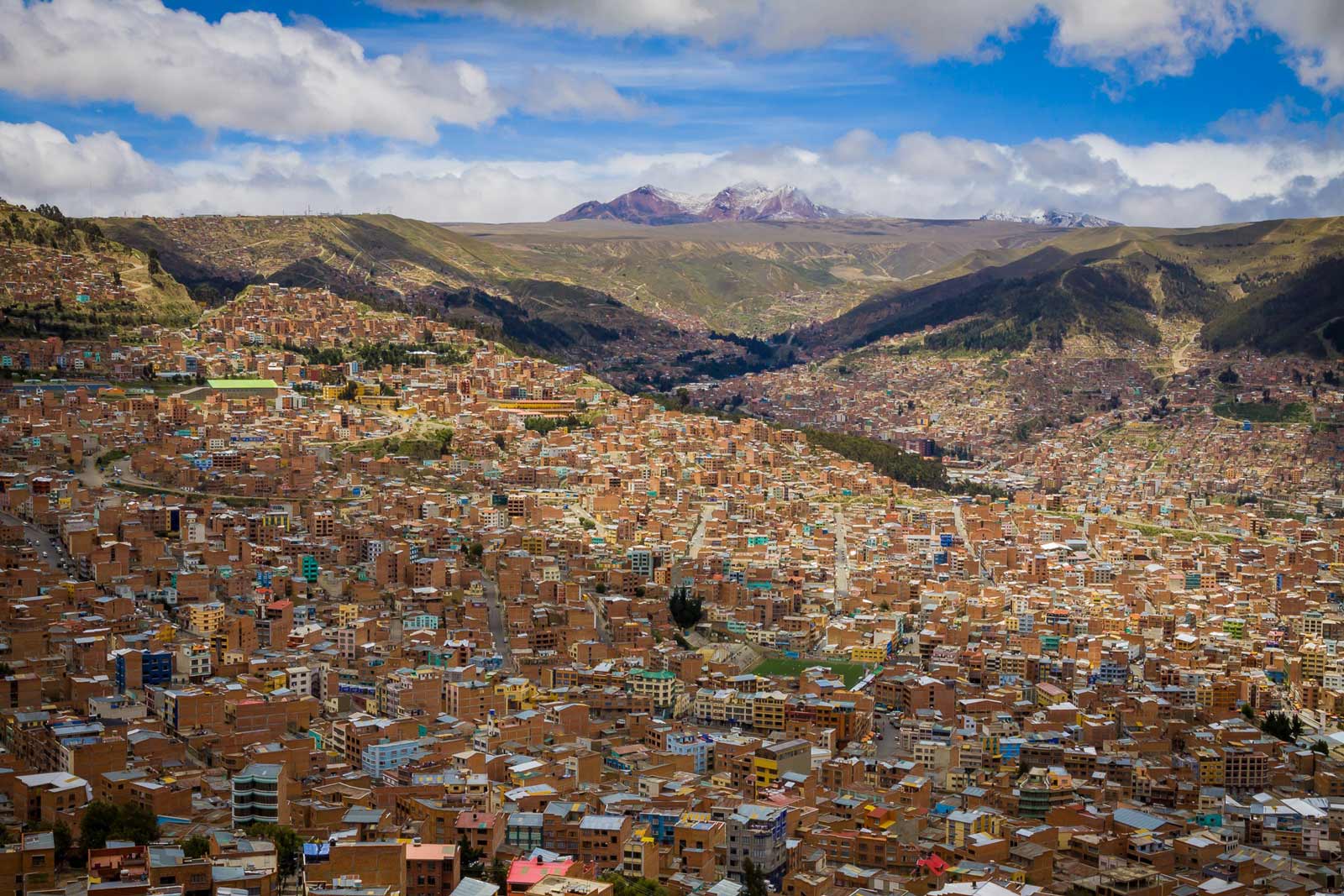
From La Paz to Uyuni
The buses from the de facto capital of La Paz to Uyuni are increasingly geared to tourist comfort, as the Salar de Uyuni becomes a more and more ubiquitous stop among backpackers in South America. The bus from La Paz takes 8 hours and gets you into Uyuni at about 6 am.
This is plenty of time as most tours do not start until 10 am. It is an overnight bus, so you will save on a night’s accommodation if you sleep. It will cost you about $25 USD for the overnight bus and you can check out tickets with https://www.ticketsbolivia.com/
It is recommended to stay a night in Uyuni to acclimate to the altitude.
If you have some extra cash or are limited on time then you can also fly to Uyuni from La Paz. It costs about $100 USD and is often included with private tours from La Paz.
From Sucre to Uyuni
If you are coming from the capital of Bolivia, Sucre, you can catch a direct bus to the Uyuni Salt Flats. The bus ride usually takes about 8 hours. It leaves from the bus terminal on Avenida Ostria Gutierrez in Sucre at 9:30 am and 8:00 pm. It will cost you approximately 11 USD. Make sure to check the times and cost on TicketsBolivia .
If you want, you can book an organized 1-day tour from La Paz to Uyuni salt flat . At the end of the tour, you will return to La Paz.
When is the Best Time to Visit the Bolivian Salt Flats?
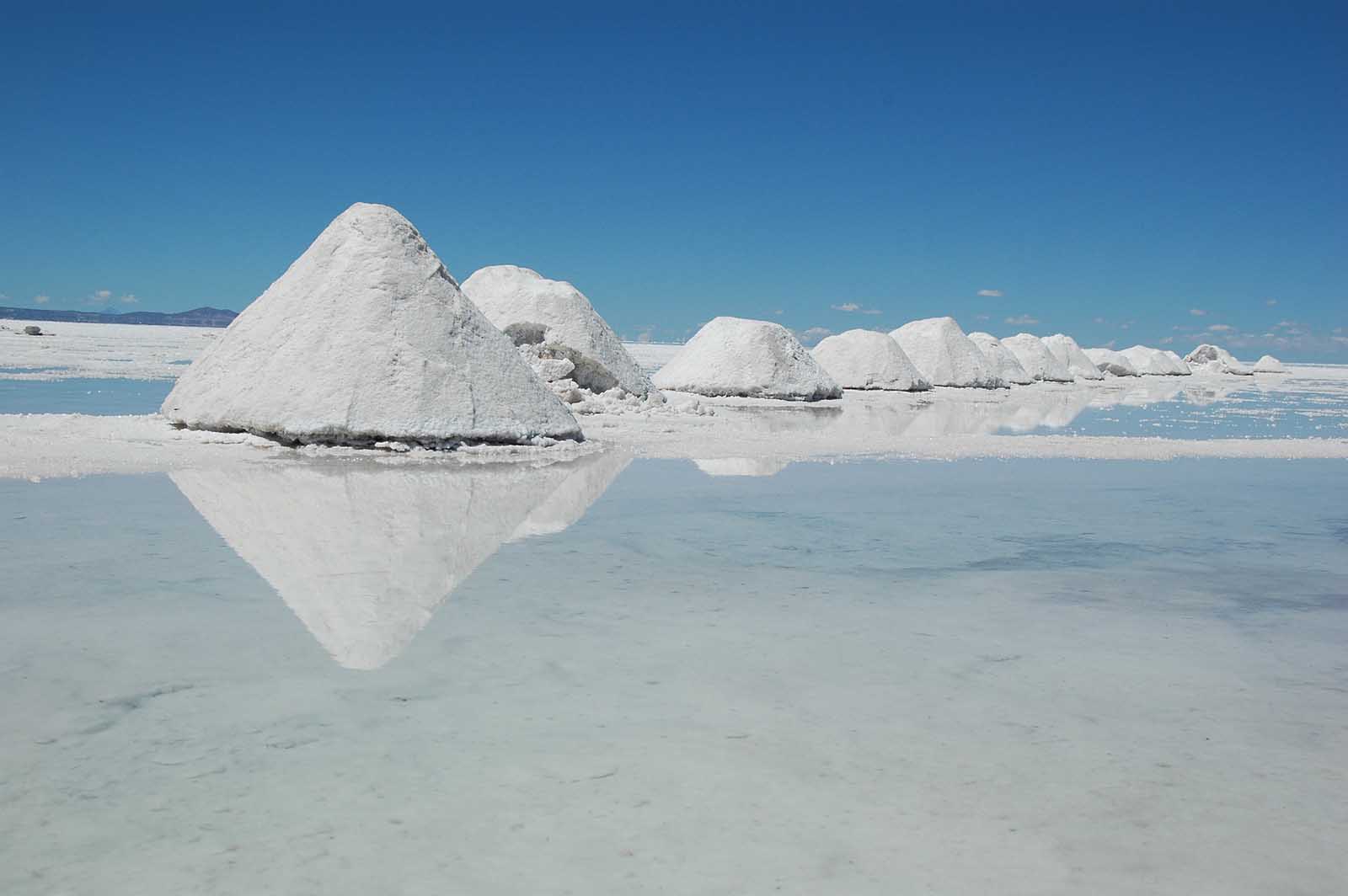
There is no bad time to visit the Bolivia Salt Flats. It really depends on the experience you are looking for.
Rainy season: If you want to see reflections of the salt lake, the rainy season is a good time to visit. The salt flats flood and transform into a massive mirror that reflects the sky and creates an other-worldly experience. During this time of the year there is little to no wind and usually clear skies. Perfect for a photographer. The rainy season in Bolivia is from December to April. Just be aware that during the rainy season a lot of the surrounding attractions are closed.
Dry Season: We visited during the dry season and it was spectacular as well. It is warmer during this time from May to November. Since we visited during the dry season, our SUV produced a giant cloud of dust when we crossed the stunning moon-like landscape of Bolivia’s Andean Plateau making for surreal images.
What you will See on a Bolvian Salt Flats Tour
Isla del pescado.
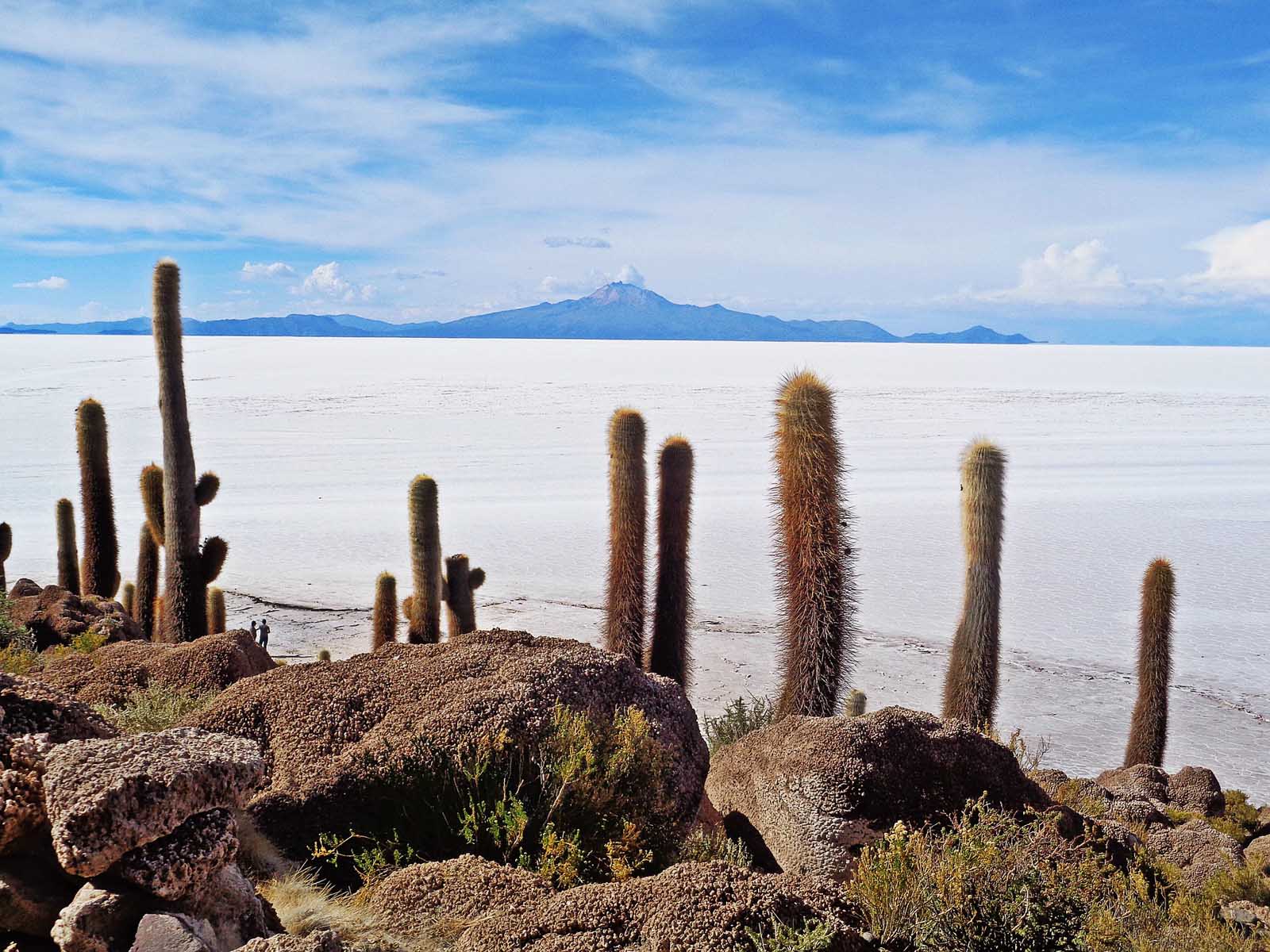
Have you ever seen an island that is NOT surrounded by water? Welcome to Isla del Pescado, the Fish Island! The Salar de Uyuni has a few islands and we enjoyed an awesome view from the top of this one. From up there, we got an impression of the true dimension of the salty landscape.
Steam Locomotives – Train Graveyard
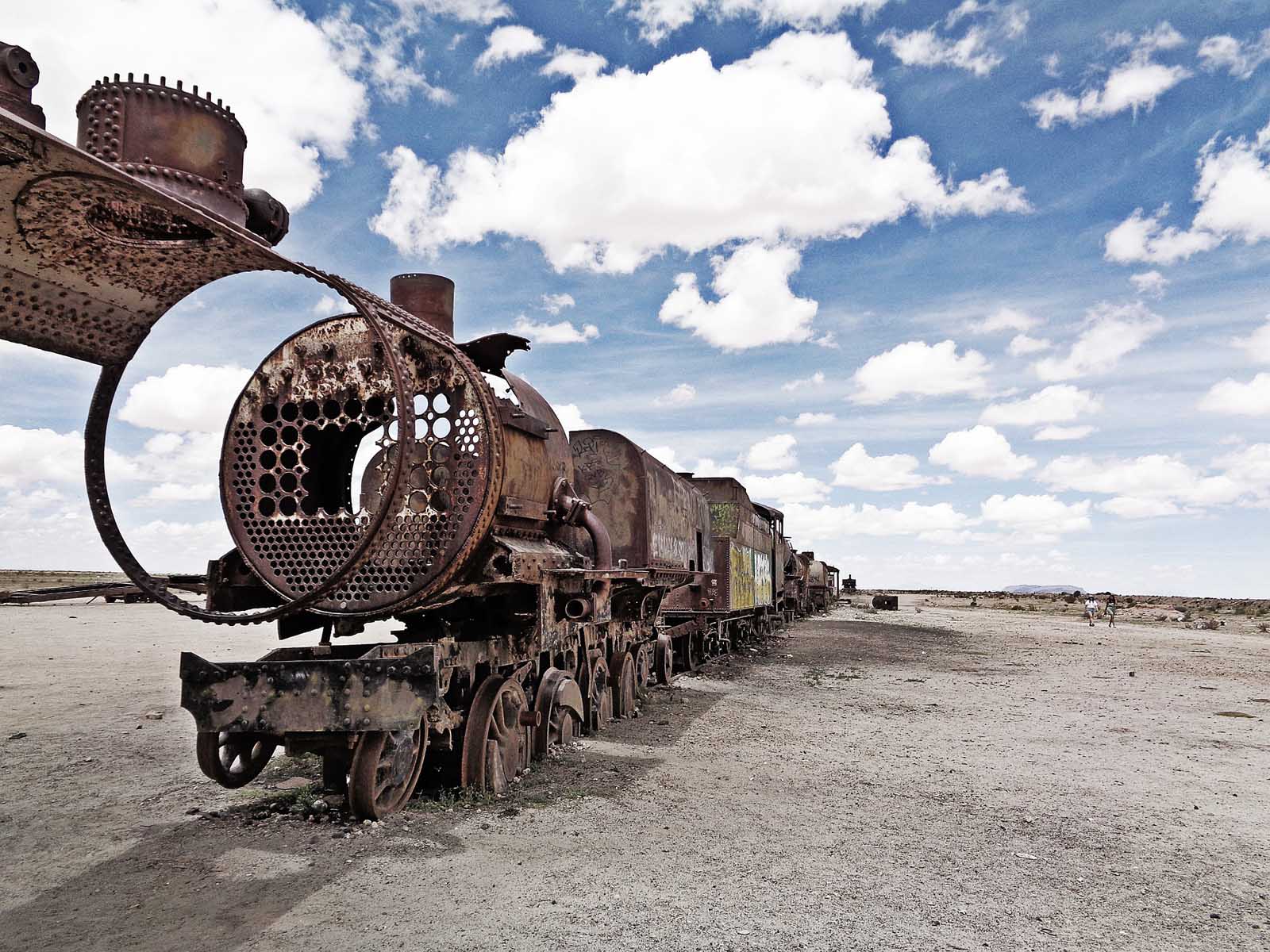
We arrived in Uyuni and jumped out of the SUV and climbed up the giant wrecked old steam locomotives. At that point, we did not know that the adult’s playground was just behind the corner, Uyuni’s train cemetery. The trains are leftover from a time when they carried minerals from the Salar de Uyuni to the Pacific Ocean.
Bolivia’s Andean Plateau
In the Andean Plateau, at an altitude of about 4,000 meters, not only the air is breathtaking. This is what real adventures look like. This is where the SUV feels at home.
The chain of volcanoes and mountains along the horizon gave us the feeling of being far away from any civilization. And for a second we thought we reached the “end of the world”.
The tracks might look like remains from centuries past but they are still in use and connect Bolivia with Chile. The moon-like landscape surrounded us as we drove on the red and brown sand when unexpectedly, behind a hill, a beautiful lagoon appeared.
Lunar Landscape
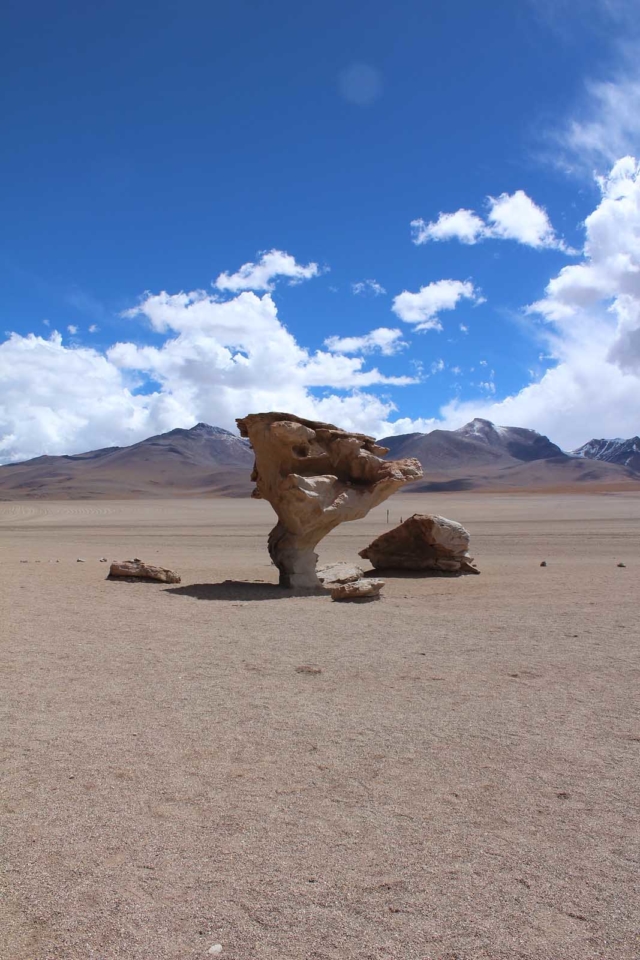
The Andean Plateau and its mysterious rock formations have been formed over millions of years through wind and sand. And sometimes nature is very creative and forms rocks like the Arbol de Piedra, the Stone Tree.
Our guide told us before that we would get to see a lagoon more beautiful than the one we had seen before. But we did not want to believe him as we could not imagine that it would be possible.
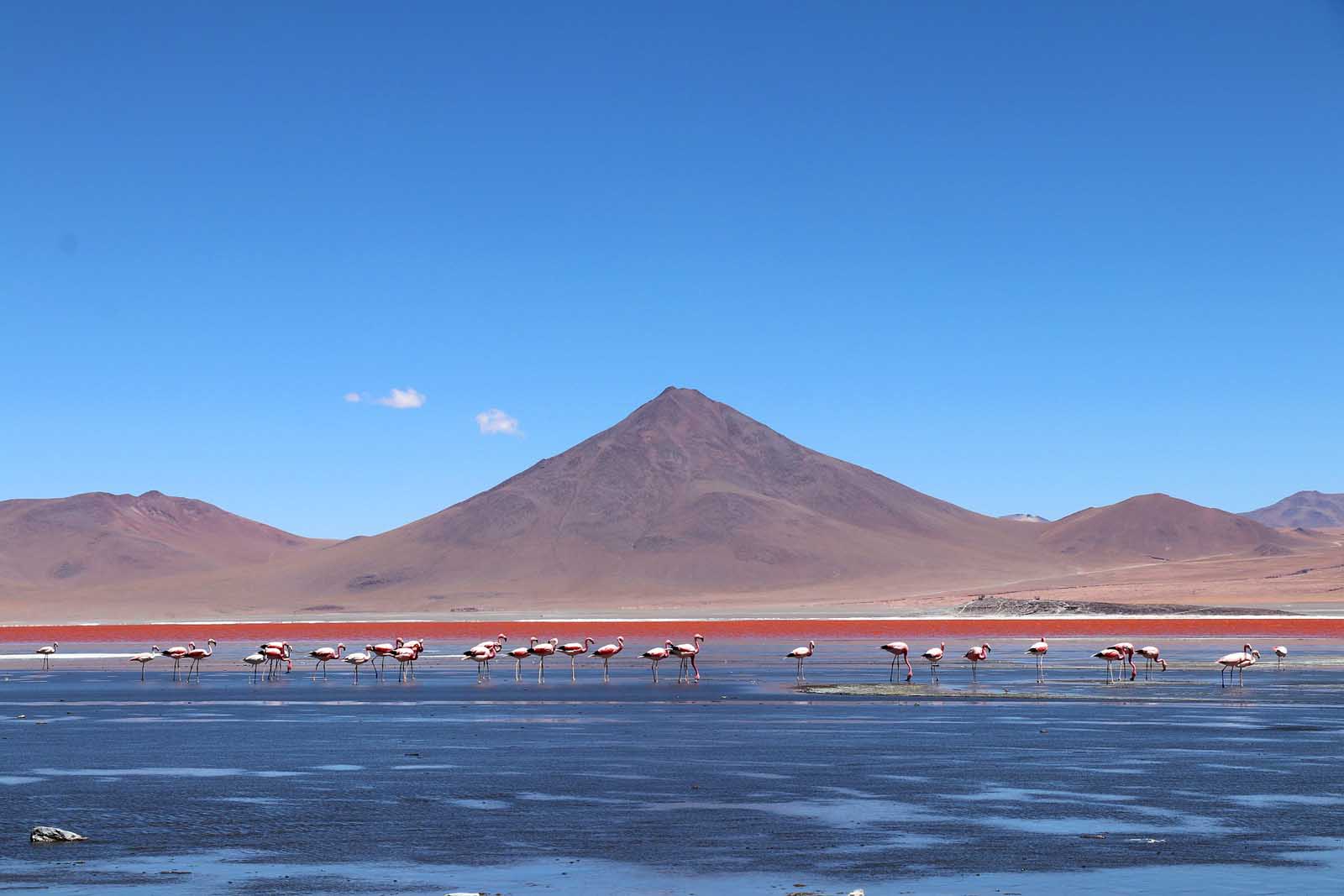
Hundreds, probably thousands of flamingos were wading through the shallow water in search of food. It was such a contradiction to see an oasis of life in the middle of the barren scenery.
Laguna Colorada
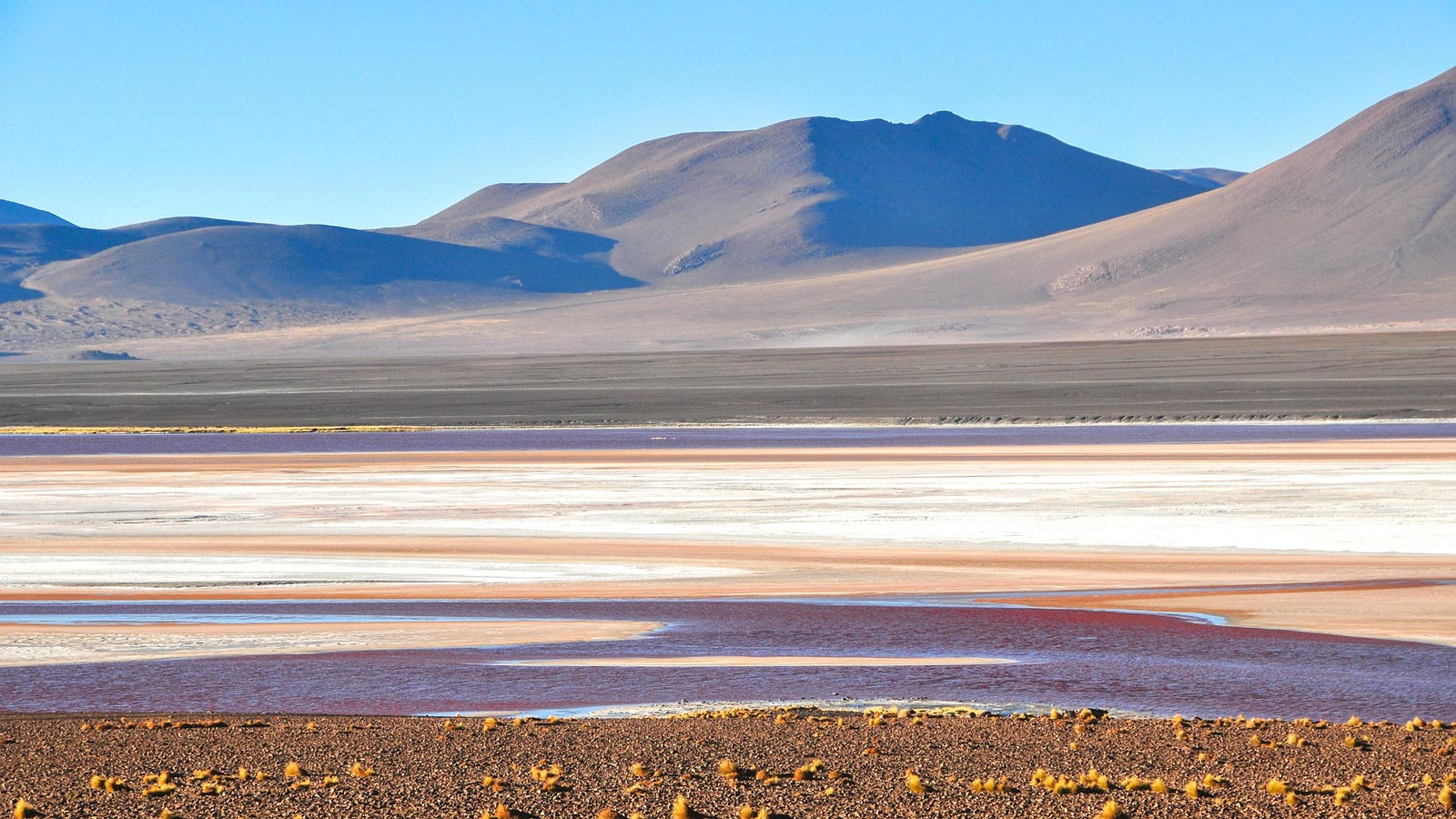
The silence was around us when we approached the Laguna Colorada, the Red Lagoon. Everything around us felt unreal. Do you know how it feels when you see something and cannot believe it is real? It was hard to believe that this lagoon, with its shades of yellow, black, white, red, brown, and the blue sky above it, was not a canvas.
Now and then we saw these little pink spots again, flamingos that enjoyed the delicious alga which makes the water appear red. It was almost sad to see that the last lagoon we visited, the beautiful Green Lagoon with the picturesque volcano in the background was void of flamingos.
As we learned this green type of algae was poisonous. Too bad, the water looked so inviting with those beautiful reflections on the surface.
Sulfur Geysers
Visiting a steaming geyser is a highlight of the Uyuni Salt Flats tour; I was so distracted taking pictures, I almost fell in! It was a very special place our driver took us to watch the sunrise in the early morning.
We were surrounded by geysers and holes in the ground filled with boiling mud. The cold air of the morning intensified the steam and the area looked like a mystic place. After leaving the salt flat we thought it could not get any better. But we were so wrong!
Photos of Salar de Uyuni
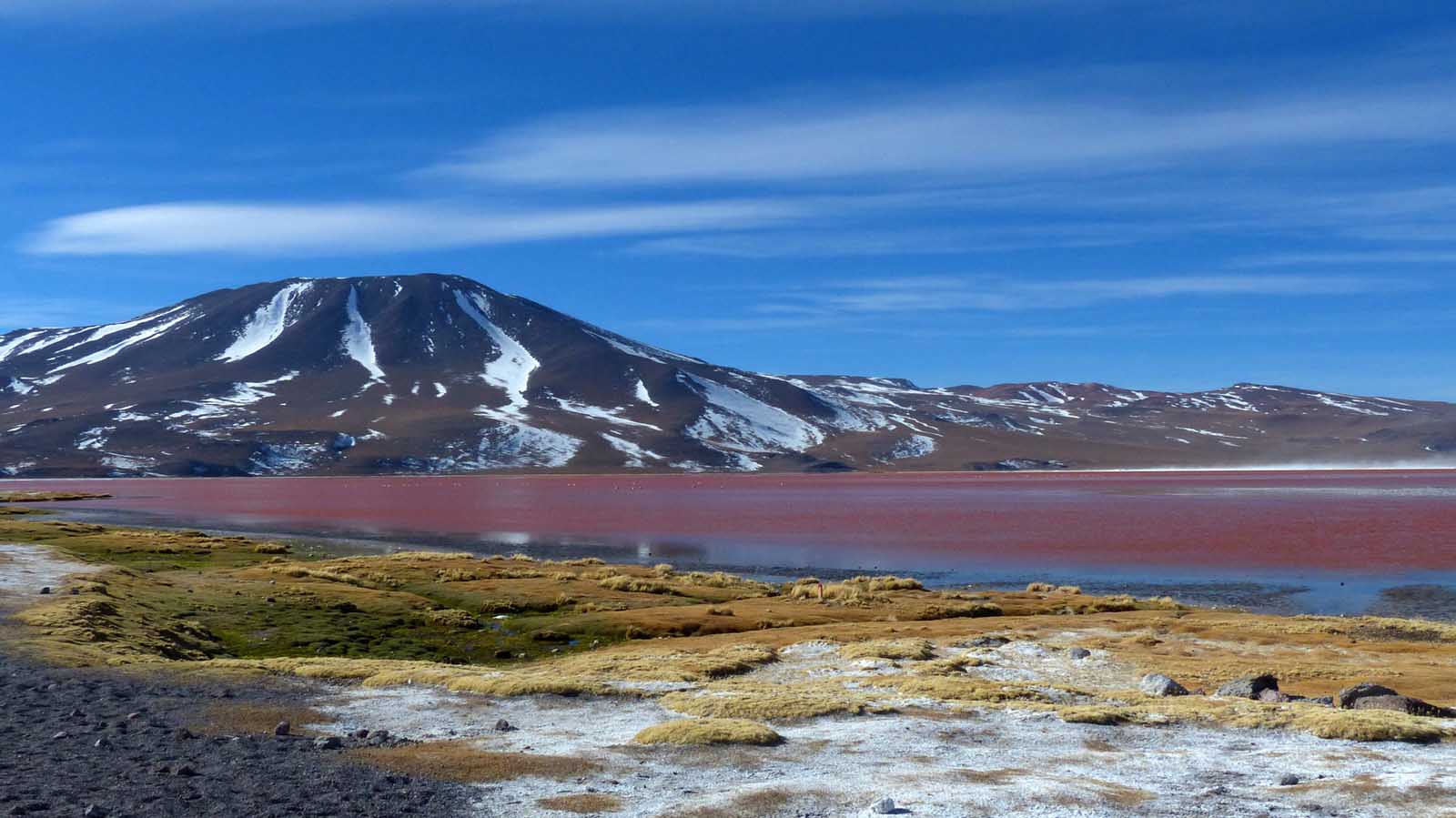
The Uyuni Salt Flats is THE photo spot to play with proportions and perspectives when taking photos. It’s a place where people sit on potato chips cans, toy dinosaurs come to life chasing travelers, and jumping over an SUV is a breeze.
On short photo stops, it can be hard to decide whether to take pictures of the scenery or simply take the scenery in. For those inclined to snap, it’s important to pace your photographic zeal. The landscape is so marvelous, it’s simply impossible to catch it all. In other words, it’s a road trip like no other, and absolutely worth doing.
Common Questions About Doing a Salar de Uyuni Salt Flats Tour
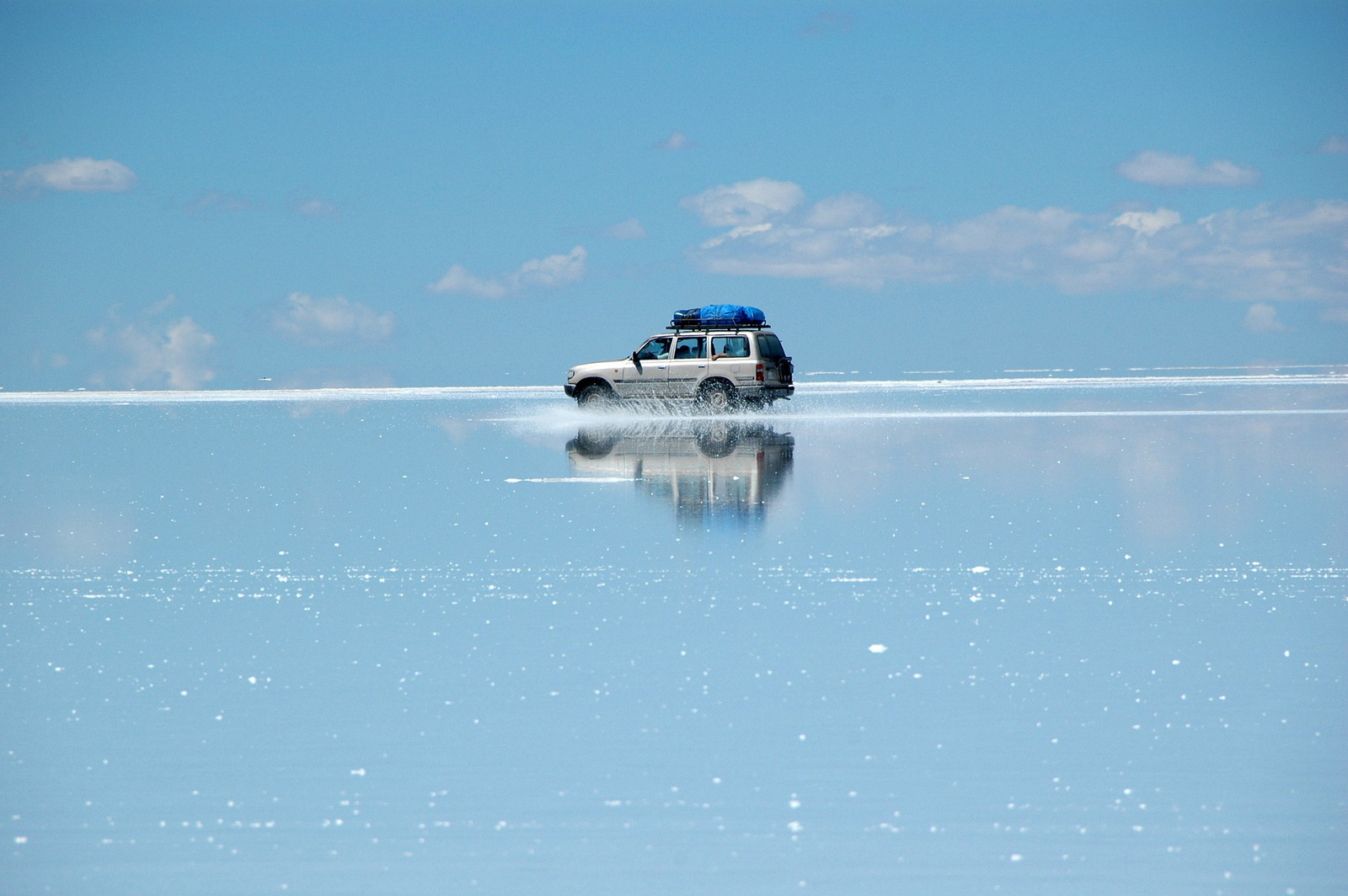
Do you need an English Speaking Guide?
The answer here is it depends. If you speak fairly fluent Spanish then you can definitely forego an English guide. If you do not speak Spanish at all then we recommend paying the extra money (it can be up to 500 Bs per person) and getting an English guide.
We like to understand our guide as they can provide a lot of background information on the area and there is the added advantage that if you pay extra for the English guide you will have only English speaking people in your car. When you are together for 3 or 4 days this was important to us.
That being said, if you want to save some money and you are on a tight budget, the Spanish-speaking guide is fine. You will be able to make out most of what he is saying anyways. It is important to note that if you opt for the English-speaking guide that there is usually one guide for every 2 or 3 cars from that tour company.
What altitude are you at in the Salar de Uyuni?
You are at altitude when you are in Uyuni, Bolivia. The town itself sits at more than 3500m or 12,000 feet and that is just where you start. During the tour, you will reach altitudes of up to 4800m or 15,000 feet at the Laguna Colorada, in the Eduardo Avaroa National Park. So be prepared.
We recommend spending at least one day in Uyuni before your tour to acclimatize to the altitude. Dring plenty of liquids and don’t exert too much effort physically. You will be out of breath a little on the first day but should get used to the lack of oxygen quickly.
Will it get cold?
The short answer is yes. Even though the weather during the day can be pleasant, you have to remember that you are at altitude so the nights can get quite cold. If you are someone who gets cold easily you might want to bring your own sleeping bag or ask to rent one from the tour operator.
Will I have phone or internet during the tour?
The fact is you will be in the middle of nowhere so there will be little to no internet or phone signal during the entire trip. It is a good time to relax and disconnect from the world and enjoy the nature that is all around you. If you are in desperate need of internet or a phone there is a place on the second day that offers paid internet access.
Cash or Credit Card? Which is Best?
Cash is king when you are on your trip to the salt flats in Bolivia. There are some ATMs in Uyuni but we suggest having local currency on hand before you arrive just in case. Make sure that you have local currency as that is required especially if you want to visit the following:
- National Park Entrance Fee: 150 Bs ($22 USD) per person
- Fish Island: 30 Bs ($5 USD)
- Hot Springs: 6 Bs ($1 USD)
What should I pack?
Packing for the salt flats is really dependent on where you are going to finish your tour. If you are carrying on to The Atacama Desert in Chile you will bring your full backpack. We do suggest putting the everyday items in a day pack so they are easily accessible as your pack will be on the top of the 4X4 each day.
If you are starting and ending in Uyuni then it is possible to leave some items in the hotel so you don’t have to bring everything. That being said, the shifts in temperature can be quite drastic so you want o to be prepared. Here is a list of things you should pack for your tour of the Salt Flats in Bolivia:
- Sunscreen with high SPF, sunglasses , hat and lip balm are a must.
- Layers of warm clothes. Temperature fluctates drastically between day and night.
- Hiking boots (Older ones if you are visiting during the wet season)
- Travel towel for the first night shower and the hot springs.
- Gold Bond: To keep yourself fresh.
- Camera and extra batteries fully charged.
- Water bottle and water. Even if it is provided it is good to have extra.
- Cash in local currency.
- Swimsuit if you pan on going in the hot springs.
- Flip flops or running shoes for at the hotel.
How Do you Describe the Salt Flats in Bolivia?
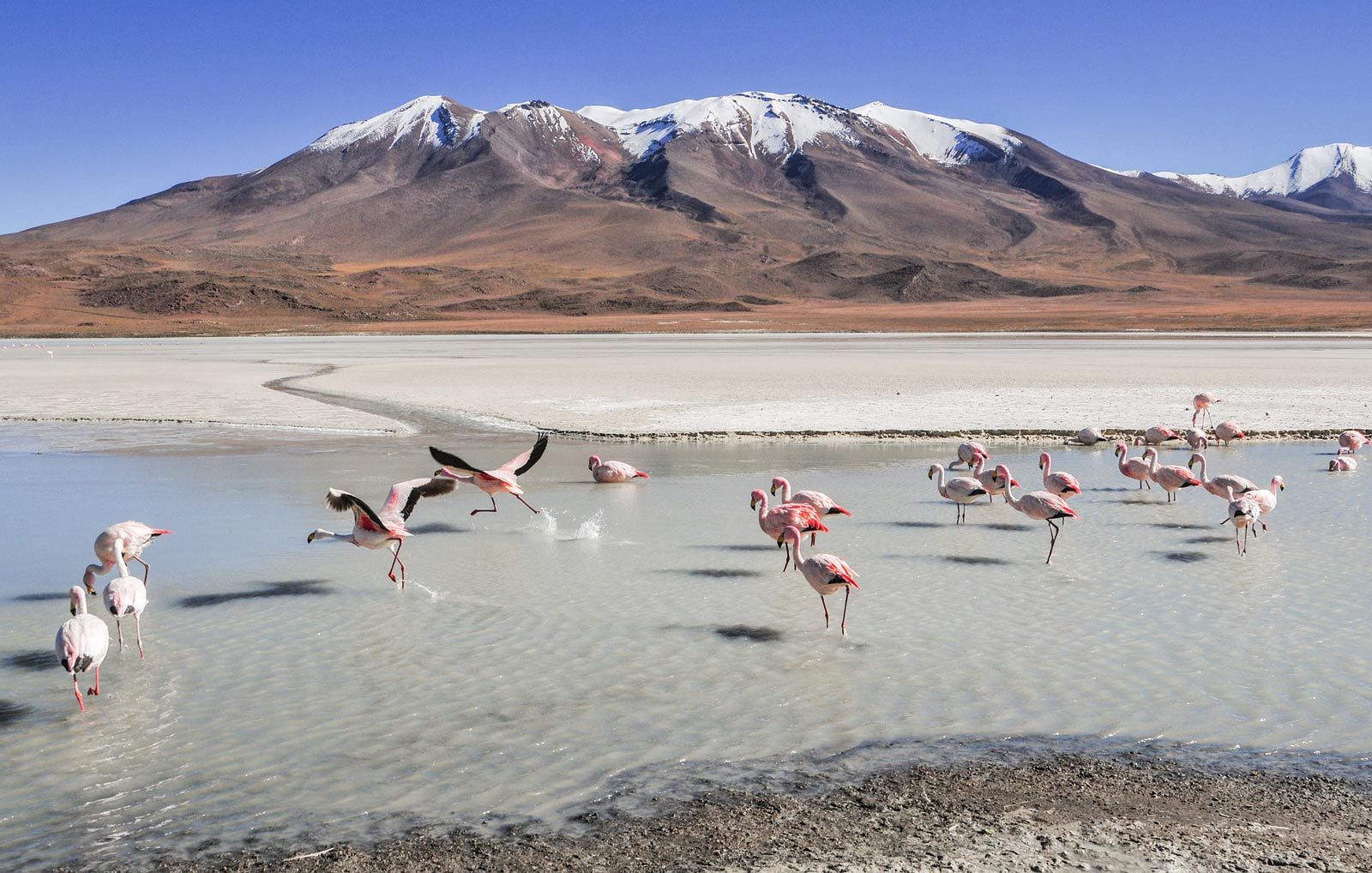
Salty, white, endless… these three words best describe the Salar de Uyuni. The sun burned from the sky and the reflections from the salt were so strong that it was impossible to open the eyes without sunglasses while looking over the massive salt desert. After a while, the awe can be a bit overwhelming. It’s as if nature is trying to beat you into submission with so many amazing things.
Most Salar de Uyuni tours can feel very start and stop, with the driver rendezvousing with other tourist jeeps at designated points for all-too-rapid photo opportunities. It’s a surreal sight, as the southwest roads of Bolivia appear entirely deserted but for the jeeps gathering in small groups to disgorge their tourist cargo.
Final Thoughts
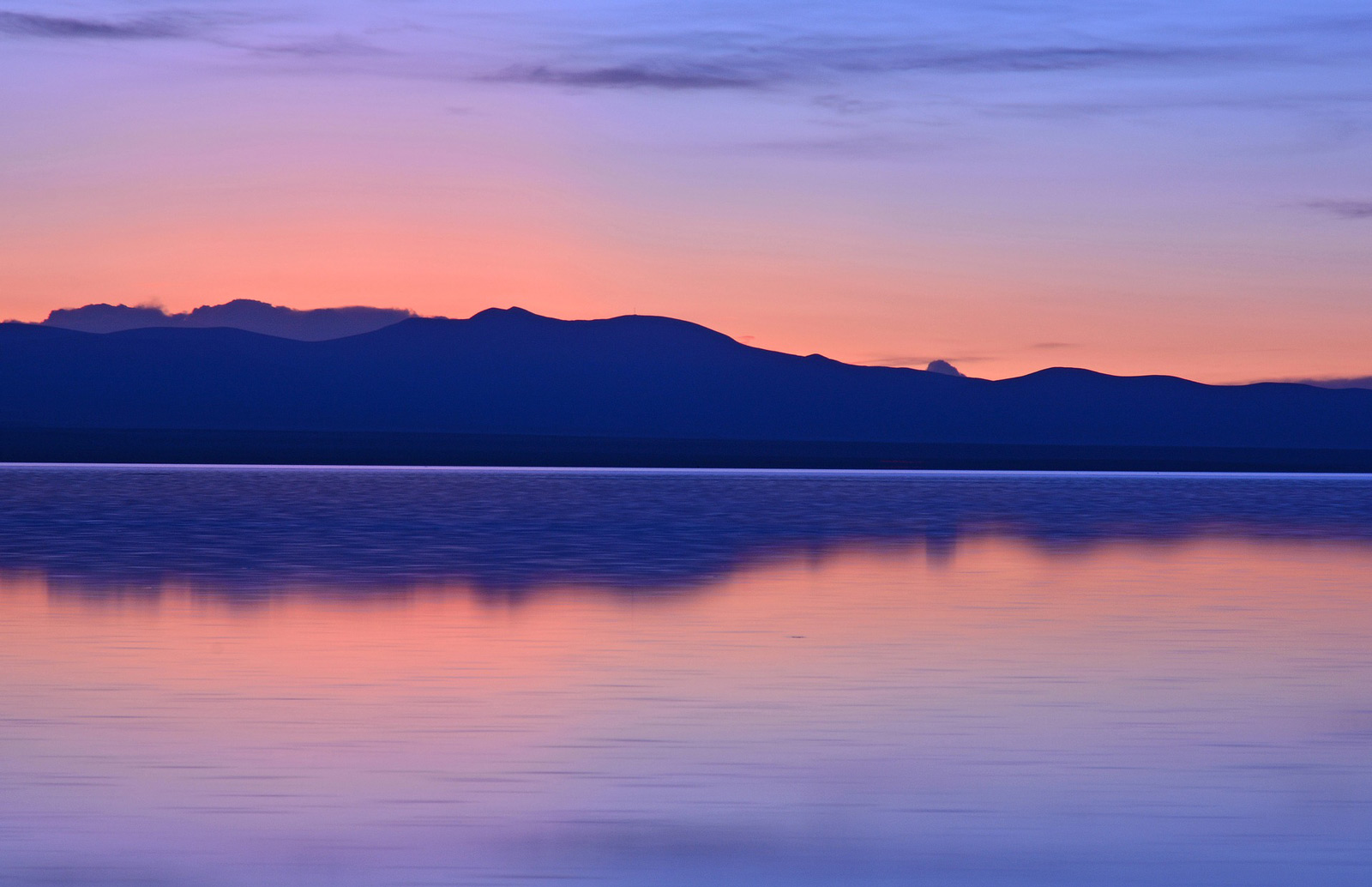
We drove across Bolivia’s scenic southwest corner, a staggeringly beautiful region bursting with mountains, lagoons, and inactive volcanoes. Equipped with many big containers of drinking water and thick sleeping bags our driver put the SUV into first gear and an amazing adventure through barren surroundings began.
It’s an experience that involves gorgeous vistas, extreme cold, and days without showering.
At the end of our 3-day trip, we were exhausted. Exhausted because of all the incredible things we had seen.
It started with an endless white salt flat, continued with moon-like sandy and dry landscapes of volcanoes and mountains, and ended with the most colorful lagoons we had ever seen. Every one of us needed some time to digest the past days.
There are many amazing places on our blue planet but the Salar de Uyuni and everything around it truly belongs to one of its most beautiful places! The Salar de Uyuni remains one of the world’s most fantastic locations–and since it’s in Bolivia, one of the most affordable, too.
Bolivia’s frontier feel means the trip sometimes seems akin to stepping out of the charted territory, onto a succession of different planets.
Sticking Around Bolivia
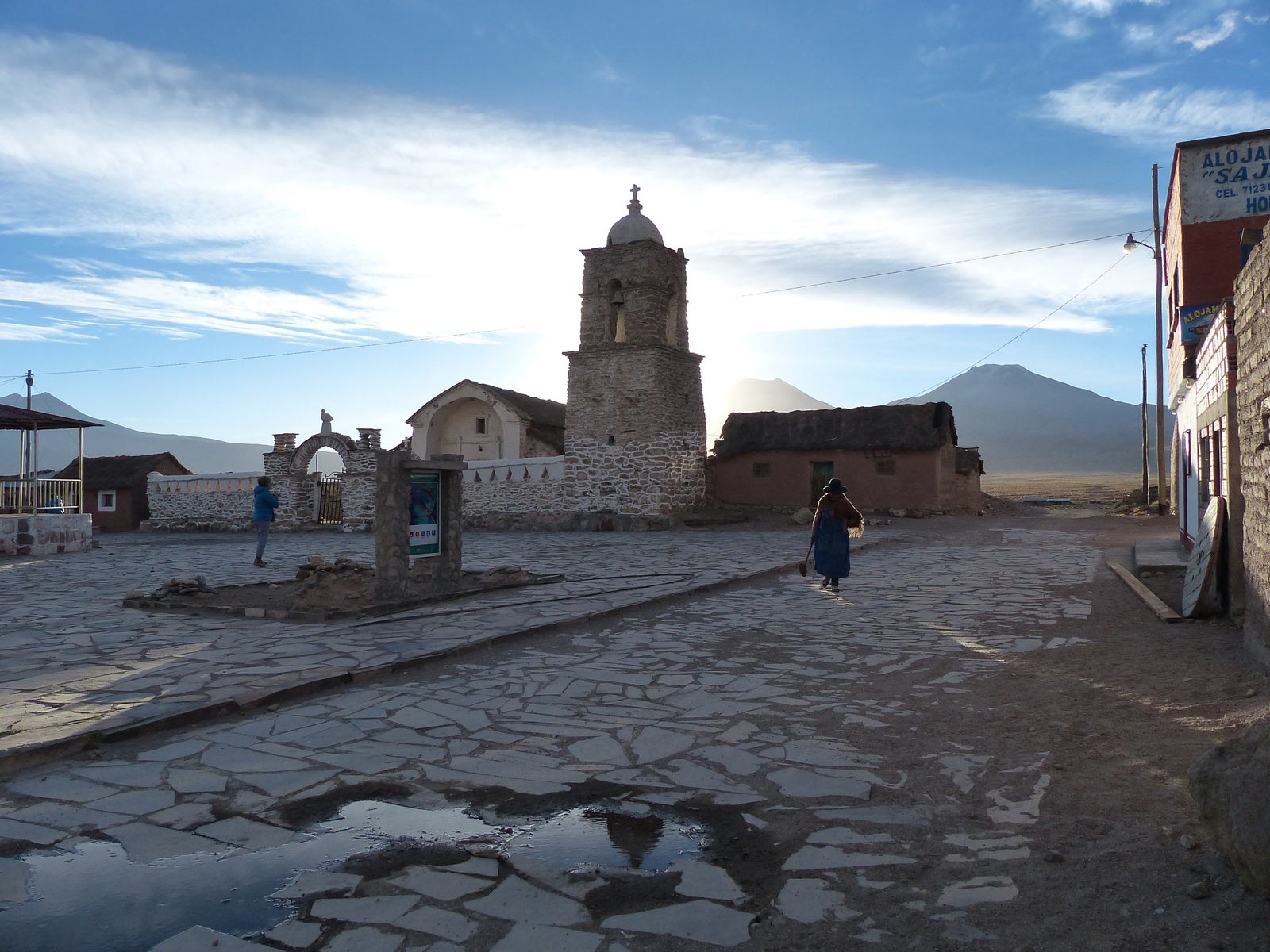
But while the Salar is undoubtedly a highlight, the rough remainder of Bolivia should not be ignored. From the grungy mining city of Potosi to the gothic streets of La Paz to the verdant j ungle reaches of the Amazon, Bolivia is filled with breathtaking and bizarre sights. Once you’ve seen the Salar (or even before), consider sticking around to take a few extra destinations in.
If you’re looking to venture along the edge of the world or race across some of nature’s most striking vistas, there is no better destination. So strap in, buckle up, and don’t forget to bring shades. There’s a white desert waiting, made of salt and blinding sunlight.
Have you been to the Bolivia Salt Flats? What do you think? Is Bolivia’s Andean Plateau one of the most beautiful places in the world?
This article was originally written by Liane and Lars of bobaroundtheworld.com who have since stopped blogging, but we have kept it on ThePlanetD as it is a destination that is worth visiting.
Plan Your Next Trip to south America with These Resources
- All You Need to know about the Top 10 Best Hikes in South America
10 Reasons You Should Travel To Bolivia
- Everything You Need to Know About Visiting the Bolivian Amazon
- 5 Things to do in Bolivia
- Chile Travel Guide
Travel Planning Resources
Looking to book your next trip? Why not use these resources that are tried and tested by yours truly.
Book Your Flights: Start planning your trip by finding the best flight deals on Skyscanner. We have used them for years and have found that they have the best flight deals.
Book your Hotel: Find the best prices on hotels with these two providers. If you are located in Europe use Booking.com and if you are anywhere else use TripAdvisor.
Find Apartment Rentals: You will find the cheapest prices on apartment rentals with VRBO .
Travel Insurance: Don't leave home without it. Here is what we recommend:
- Safety Wing - Occasional Travelers.
- Medjet - Global air medical transport and travel security.
Book Your Activities: Looking for walking tours, skip-the-line tickets, private guides, and more? Then we recommend Get Your Guide.
Need more help planning your trip? Make sure to check out our Resources Page where we highlight all the great companies that we trust when we are traveling.
You May Also Like
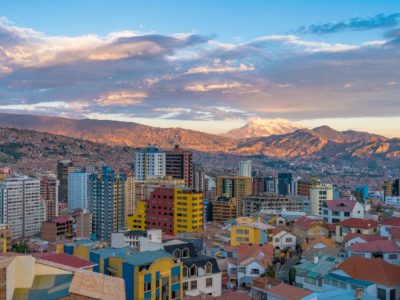
24 Fascinating Facts About Bolivia You Should Know In 2024
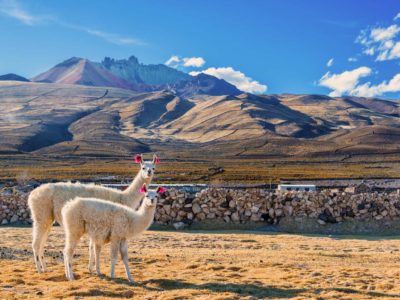
20 Best Things To Do In Bolivia In 2024
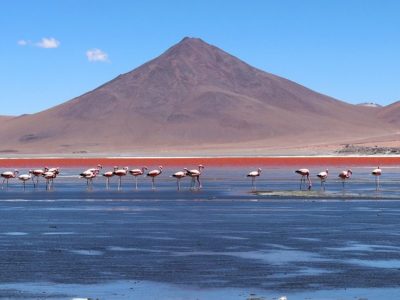
About The Planet D
Dave Bouskill and Debra Corbeil are the owners and founders of The Planet D. After traveling to 115 countries, on all 7 continents over the past 13 years they have become one of the foremost experts in travel. Being recognized as top travel bloggers and influencers by the likes of Forbes Magazine , the Society of American Travel Writers and USA Today has allowed them to become leaders in their field.
Join thousands of others who get our monthly updates!
Leave a comment cancel reply.
Save my name, email, and website in this browser for the next time I comment.
11 thoughts on “Salar de Uyuni – How to Visit The Bolivia Salt Flats”
Chile is a very nice place to visit.
This is relay amazing picture. i am from country of world hugest peak Mt Everest 8848 m and light of Asia. Nepal is on of the best destination for hiking and sightseeing, so traveler get lots of opportunity to take unlimited amazing capture during the adventure and the tour. where the incredible scenery attract to the traveler as well as photographer to explore them on unique feature. which may motive to the traveler.
What a great photo and article, this is really awesome!! thanks for sharing with us and keep posting such a great pics
Me from Everest Country Nepal, As a traveler all pics are so amazing and thanks for sharing such a great pics and articles. We have the big mountains like Everest 8848m. but we don’t have such awesome places.You are a really wonderful photographer.
wow, this are the most beautiful pictures, I rally love it, thanks for sharing
Incredible adventure. Hope that you have enjoyed a lot on this trip.
Appreciate for your great effort to share your travel experience.
Great Adventure. There is a quietness and bareness of these lands that makes you feel like you are at the end of the world. The flamingos in the salt/soda lakes are similar to what we have in Kenya and Tanzania lakes nakuru, bogoria and lake manyara. Awesome.
Wow, what an incredible place! I’ve seen tonnes of photos of the flats but never of the surrounding regions/sites/wonders. Great insight into somewhere I’d absolutely love to visit! Thank you.
Wow, incredible journey. It seems like you have enjoyed your trip. Awesome photographs. Your blog is very informative to all those travelers who pursue adventure. Appreciate it for sharing your travel experience.
Incredible pictures! you shared awesome place to visit and great detail.. Really want to go there, Thank you so much for sharing a nice experiences.. keep posting!
Awesome photos guys. What company did you go with and did you like going with them?

Salar de Uyuni: A Complete Guide to Visiting the Bolivia Salt Flats
Tessellations of crusted white glinting in the sun as far as the eye can see – it’s little wonder that the Salar de Uyuni – or the Bolivia Salt Flats – are one of South America’s bucket list spots. Plan your trip with this complete guide.
Bolivia’s Uyuni salt flats are one of the most photogenic places in the world. With over 10,582 square kilometres (4,086 square miles) of snowy white hexagonal patterns and clear blue skies, it doesn’t get much more gorgeous than this.
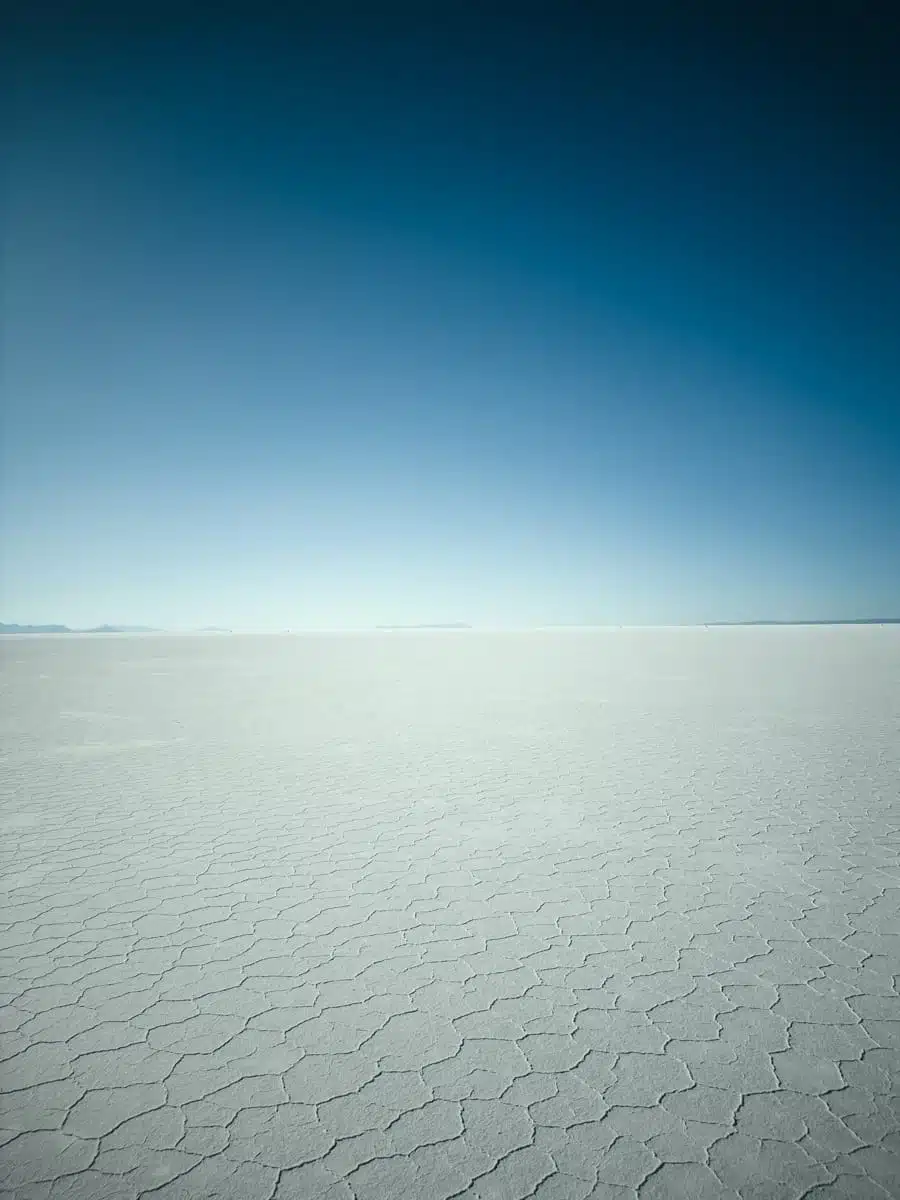
The first time I visited the salt flats in 2009, I had no idea of what to expect. We’d trucked on a four-day trip from Tupiza (there’ll be more details on that later), waking up in what felt like the middle of the night to pile into the 4×4, before stopping in the pitch black.
Within moments, the sun’s first rays shot over the horizon, gradually lighting the landscape in its path – we were in the middle of the salt flats with no one else in sight. Not going to lie, it was straight up one of my favourite travel moments and one I hope you get to experience for yourself.
Of course, in the age of Instagram and TikTok, the chance of you never having seen a picture of the salt flats is relatively slim – but you can still capture that wonder if you plan your trip right – and that’s exactly what this guide is going to help you do.
We’re going to cover why you should visit, what to see where you do, a brief jaunt through the history of this fascinating spot and exactly (and I mean exactly) what you need to know to plan your trip.
Ready to embark on a journey to the largest salt flats anywhere in the world? I thought so.
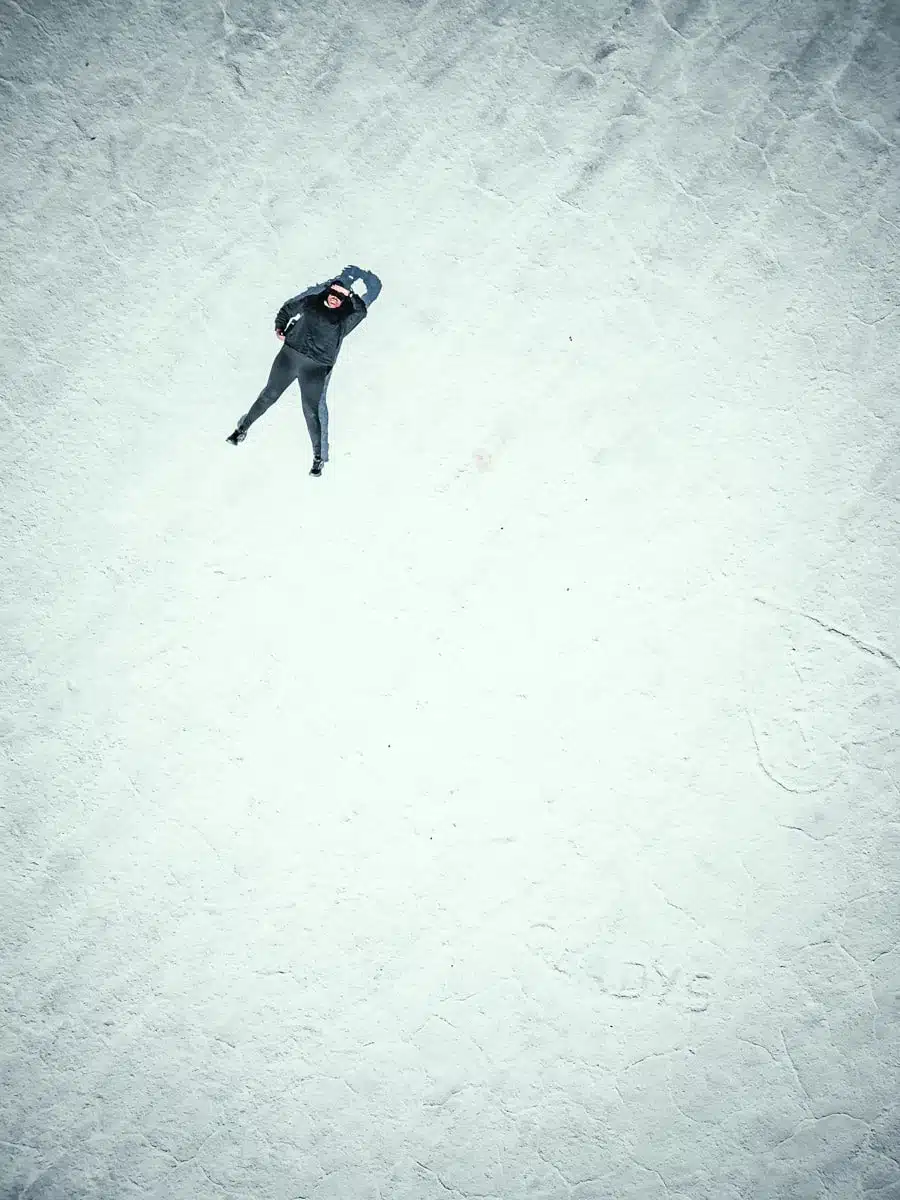
If you’ve ever had even a slight urge to check out the Uyuni salt flats, I urge you to go. There’s no other place in the world where you’ll find this kind of scenery at this magnitude. The crystalline salt flats form perfect patterns that weave their way across endless stretches of the desert landscape. During the rainy season (January to April), the landscape disappears underwater to create the famous Bolivia salt flat mirror effect you may have seen on the ‘Gram. And there’s actually a lot more to see here, including islands of cacti, three species of flamingos, “salt hotels” and abandoned trains you can explore.
If you have a knack for adventure and a passport, visiting Salar de Uyuni should be at the top of your travel list. Here’s a sneak peek at some of the fun!
View this post on Instagram A post shared by The Discoveries Of – Julianna Barnaby (@thediscoveriesof)
Take a Peek on the ‘Gram
Things to do at the salar de uyuni.
Think a trip to the Salar de Uyuni is only about seeing the flats themselves? Think again. There is a lot to see here, whether you choose a guided tour or want to explore the hexagonal patterns across the stark white desert all on your own. Here are a few of the must-see attractions.
Climb to the Top of Fish Island
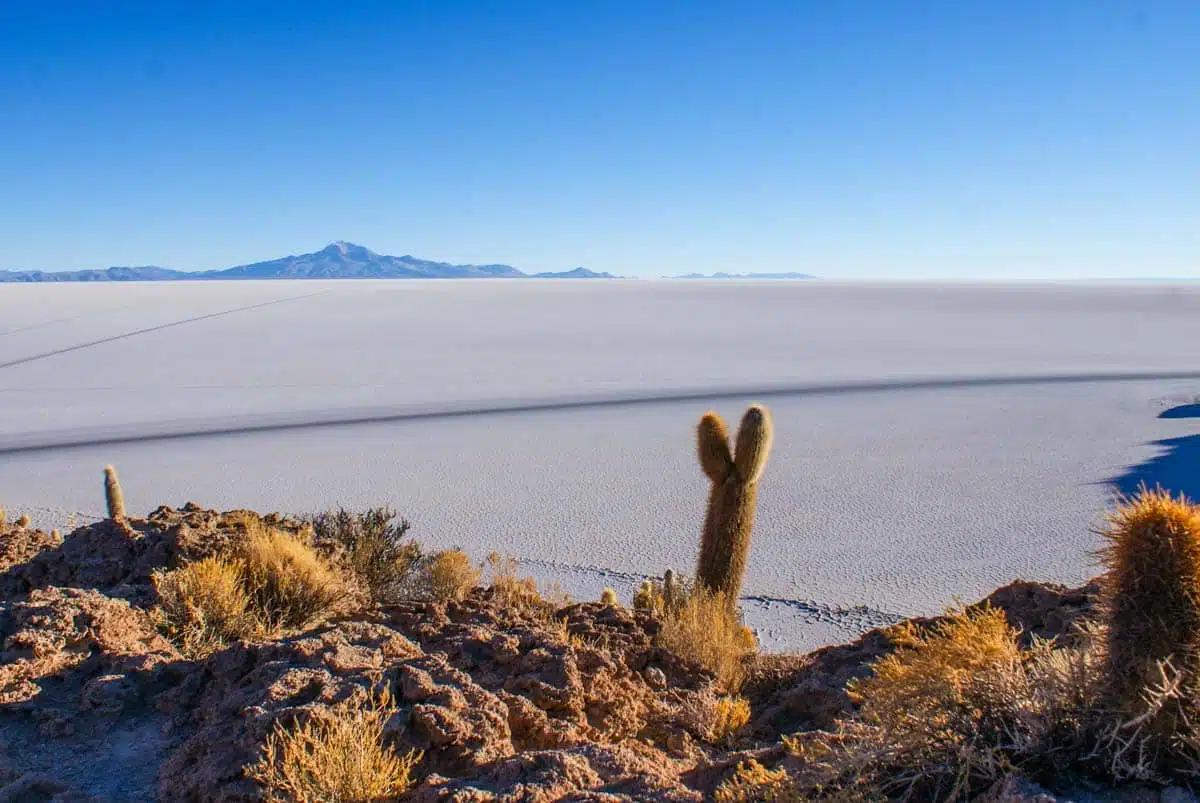
There are lots of cacti-laden islands that pop up in the vast desert landscape of the salt flats. Fish Island is one of my favourites.
You’ll see gigantic cacti (I’m talking 10 metres high), which is really an unexpected botanical wonder compared to the mostly desolate setting.
Stretch your imagination and look closely enough from above, and you might see why the island got its name. Supposedly it looks a lot like a fish (I’m still a bit sceptical, myself).
Nonetheless, it’s a beautiful change of scenery, with the Trichocereus (cereus) cactus and viscacha (a rather adorable rodent) offering a rare brush with nature in the otherwise rather barren plains.
You can also visit Incahuasi island – another cactus-covered island in the middle of the salt flats – do the 15-minute hike to the top for stunning views of the salar .
Play With Perspective and Take Some Weird Photos & Videos
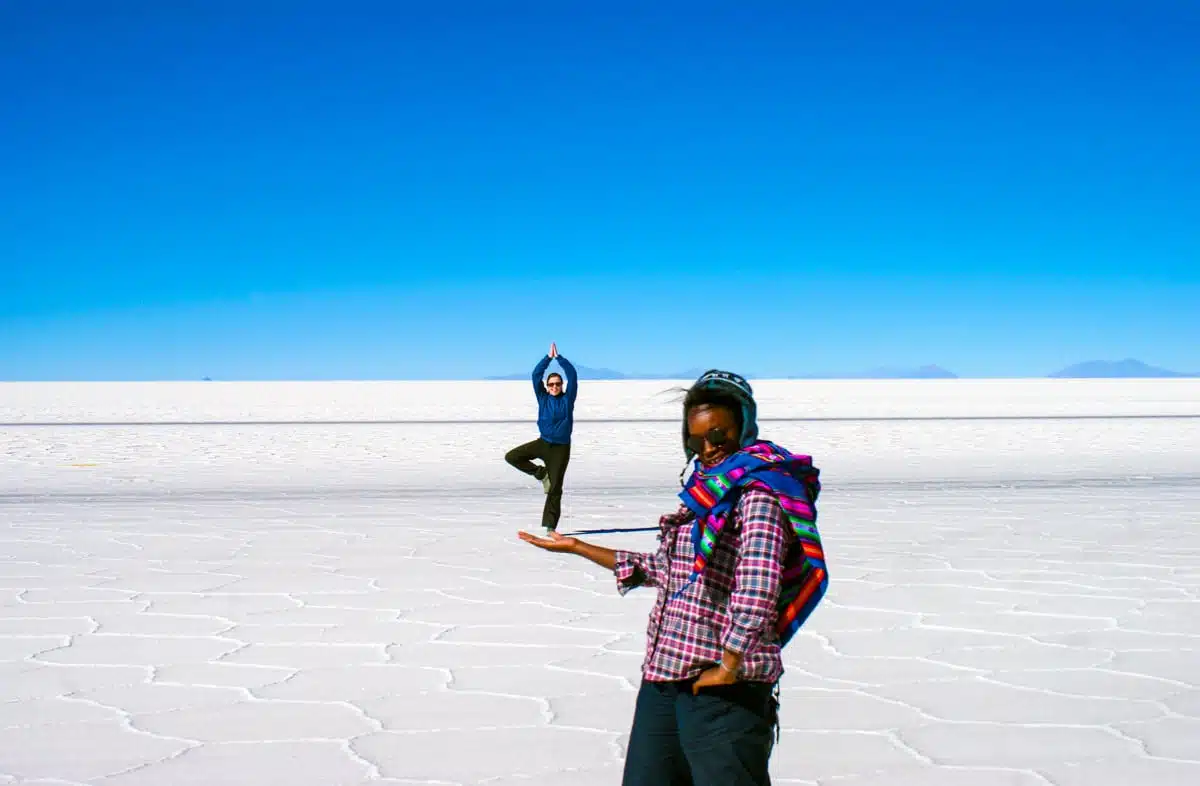
Look, I won’t lie – cheesy as the photos may look, it’s so fun taking pictures that mess around with perspective while you’re on the salt flats! There are very few places where you can find somewhere so large and flat, so it’s the perfect spot to take all manner of weird and wonderful pictures.
Your guide will probably bring some props, but if there’s anything specific you want to do, make sure you bring any necessary props with you.
Visit The Train Cemetery
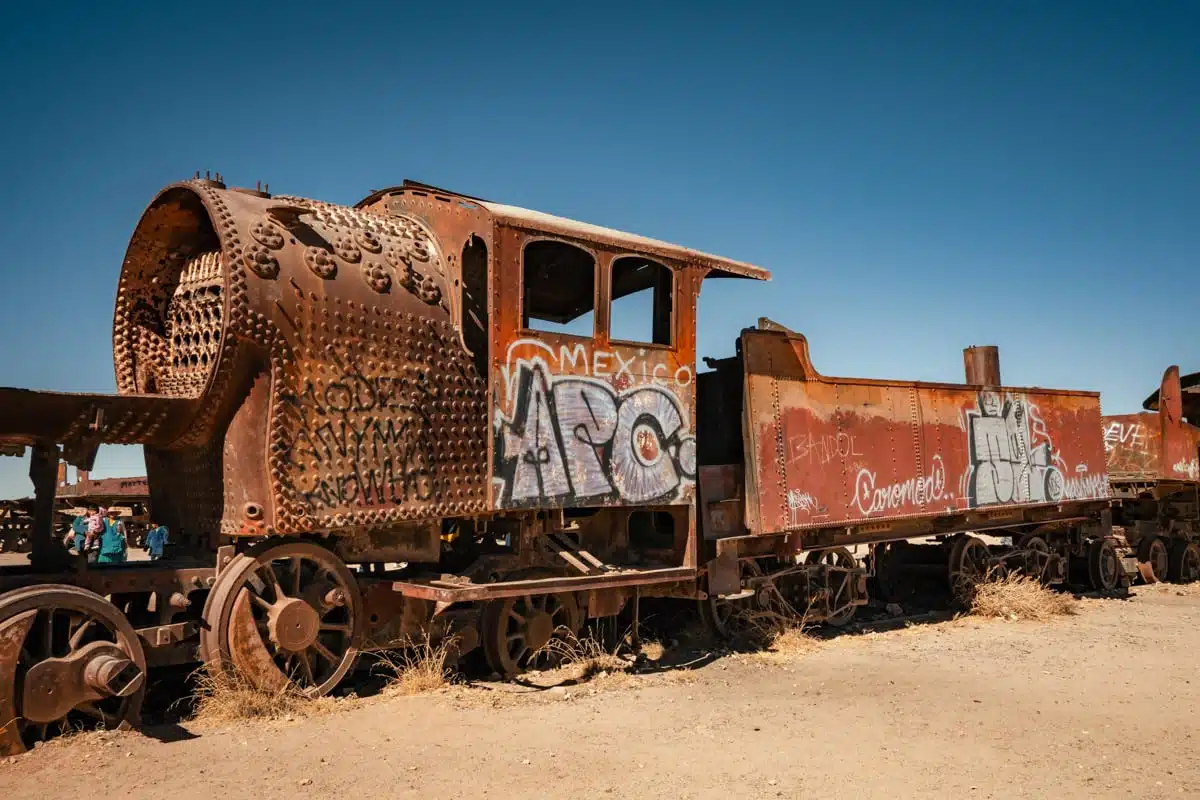
One of the stranger attractions near Salar de Uyuni is the train cemetery just outside of the city of Uyuni.
Say what? Yes, a cemetery of trains. Back in the 19th and 20th centuries, this region was a thriving mining area, and trains from the UK transported minerals from Uyuni to other regions. Flash forward a few decades, and the industry dried up, trains sat out in the Bolivian salt flat desert, and they formed what’s now the Train Cemetery.
It’s a cool place to spend an hour or so with your camera and catch some shots of the abandoned trains and the desert skies.
Check Out the Colourful Flags from the Dakar Rally
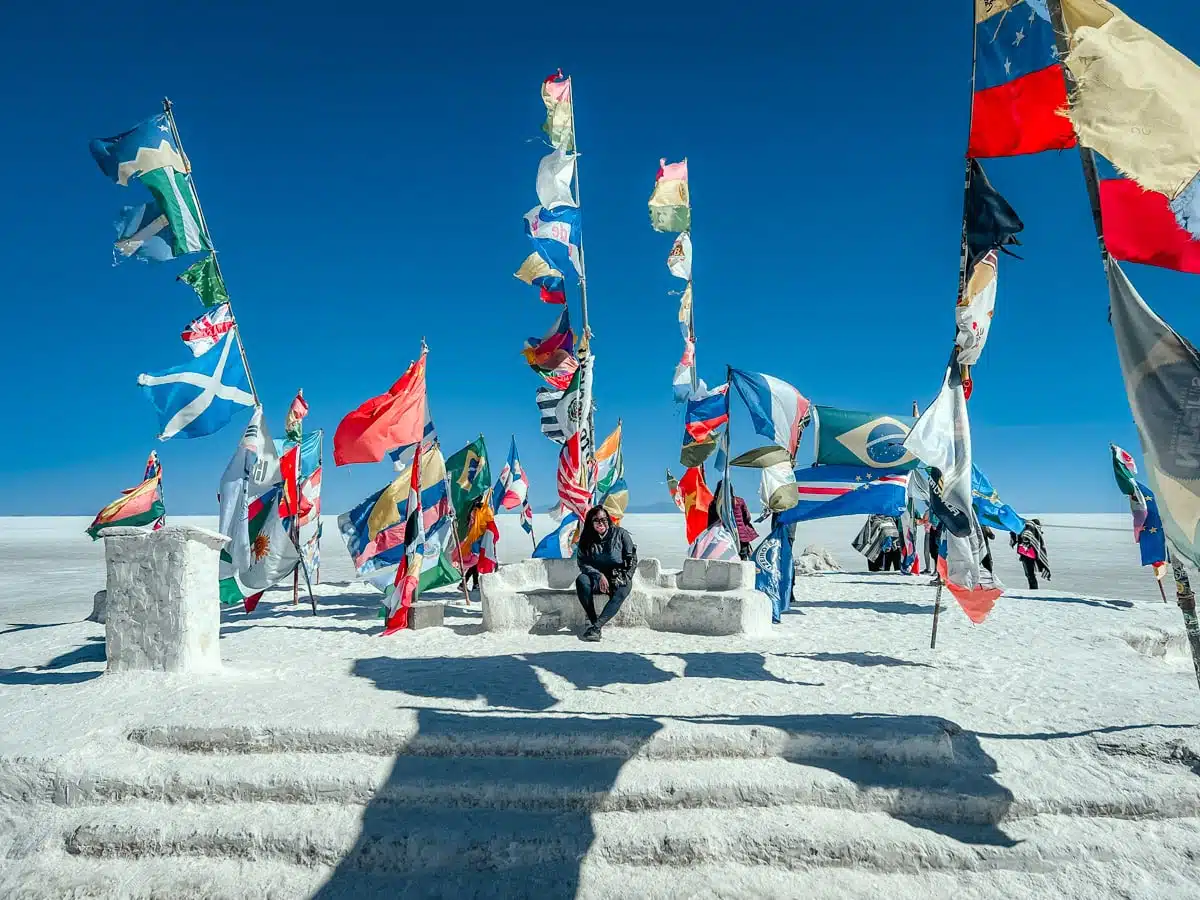
Ever heard of the Dakar Rally? You know, the gruelling race that involves taking your UTV, quad, motorbike, or truck through some of the world’s most inhospitable climates Mad Max style – well, it took place in the Bolivia Salt Flats a few years back.
People participated from all over the world, and you can still see their national flags proudly standing on a salt block against the whitewashed ground and bright blue sky.
It’s worth a stop for some great photos and a glimpse into the international event.
Explore the Old Playa Blanca Salt Hotel
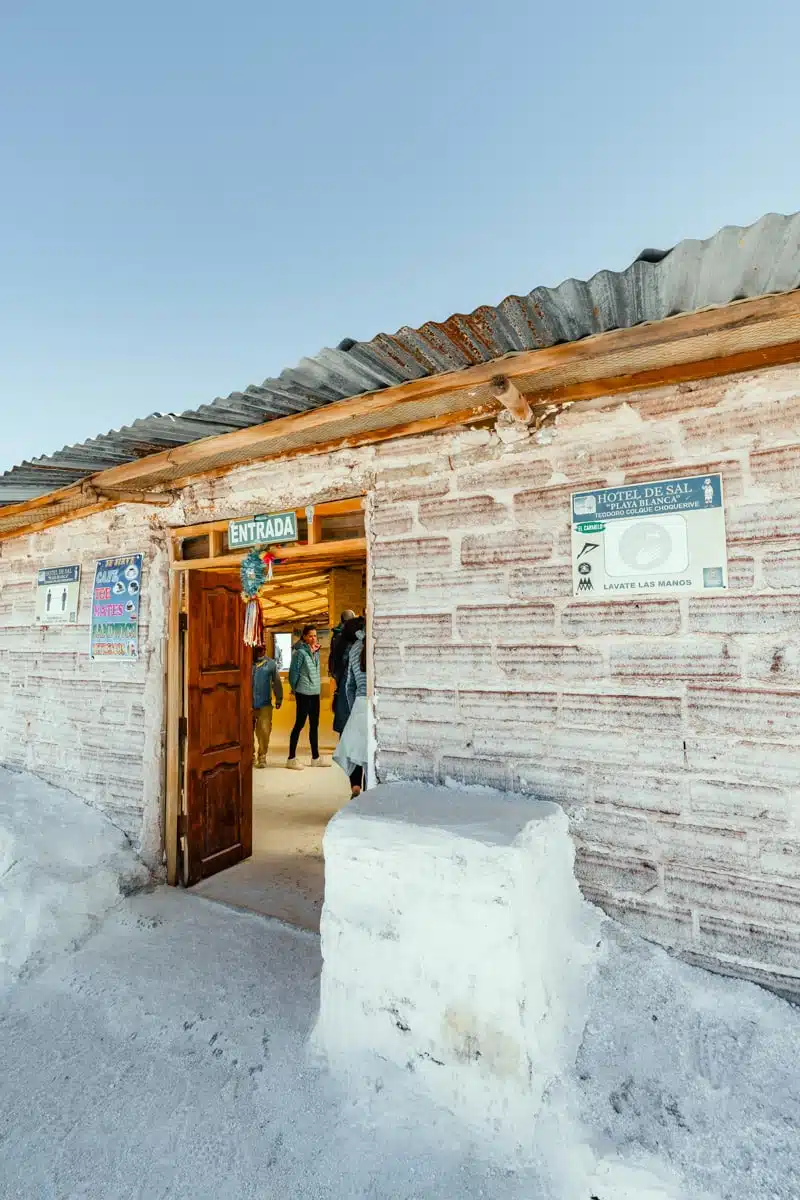
You’ll see a lot of “salt hotels” when you’re exploring Bolivia salt flats luxury hotels. There are quite a few worth visiting, but Playa Blanca stands out because the hotel sitting smack dab in the middle of the flats is no longer operating – meaning it’s a great place to use as a shelter from the sun and see a salt hotel up close too. It’s next to the Dakar Rally flags and has a gift shop and restrooms, making it a nice place to check out when you need a break from the blistering heat in the middle of the day.
Pop into the Salt Museum at Colchani
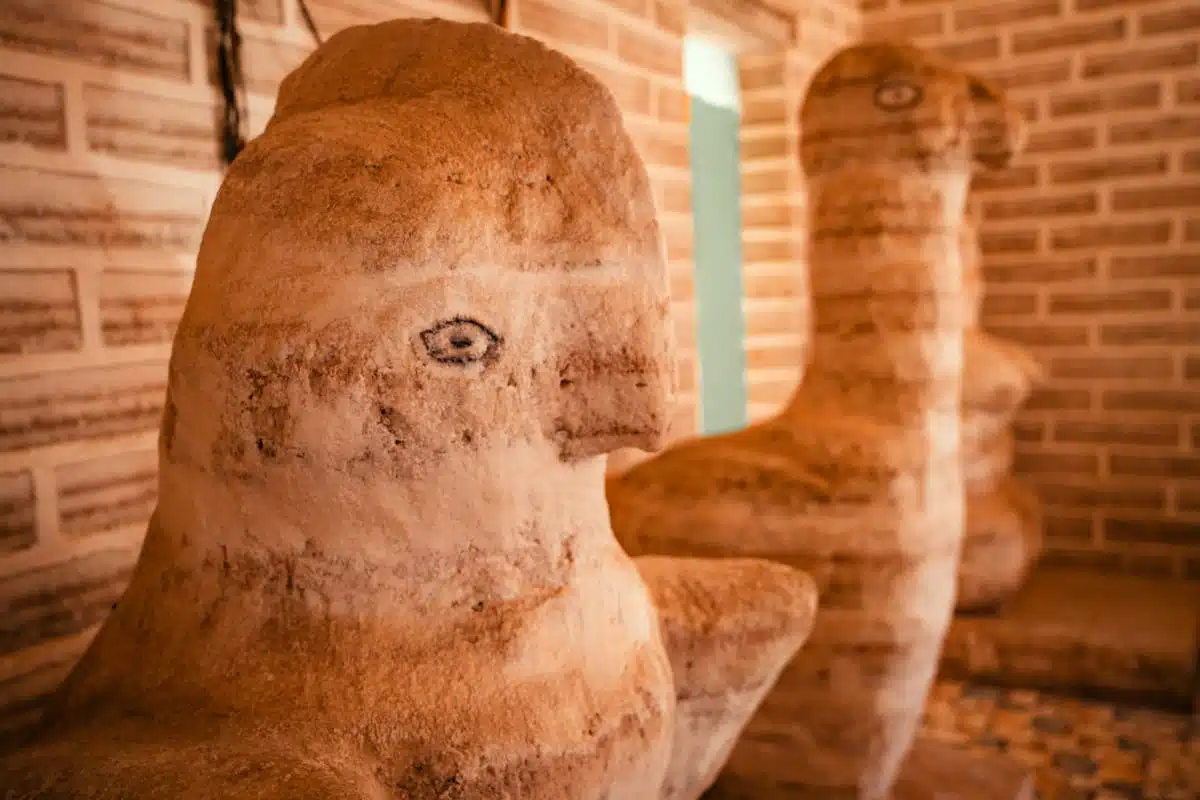
Although the small town of Colchani might not look like it has a lot going on other than its (pretty cool) market, it is worth popping into on your way to or from the flats if you can.
Why? There’s a cool museum where you can learn more about salt processing and mining, and the marketplace actually has some cool handmade souvenirs. The Museo de la Llama y la Sal gives you a chance to see a building and sculptures made from salt, and learn more about how it’s processed by locals.
Continue the Journey to Laguna Colorada
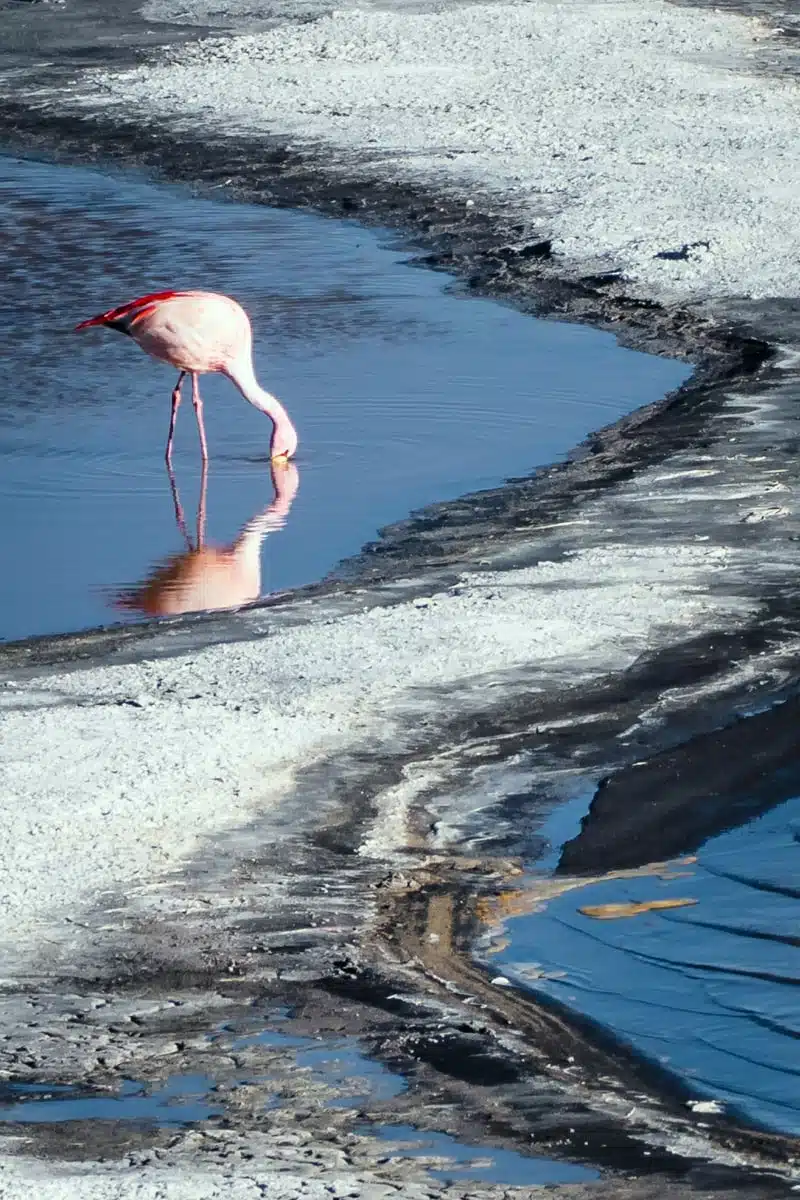
Have you ever seen a blood-red laguna before? Well, you’re about to now. Laguna Colorada, isn’t in Salar de Uyuni, but it’s close enough that you’ll definitely want to add it to your trip.
Why? It’s one of the best places to see flamingos in the region. Go in the summertime, and you’ll see literal thousands of them feasting on algae in the bright red lake in Southern Bolivia.
The lake itself is a photographer’s dream – the contrast of the crimson waters and bright white borax is a spectacle you have to see yourself to believe.
So Now You Know What to See, Here’s a Little More Info About the Salt Flats Too
The formation of the salt flats .
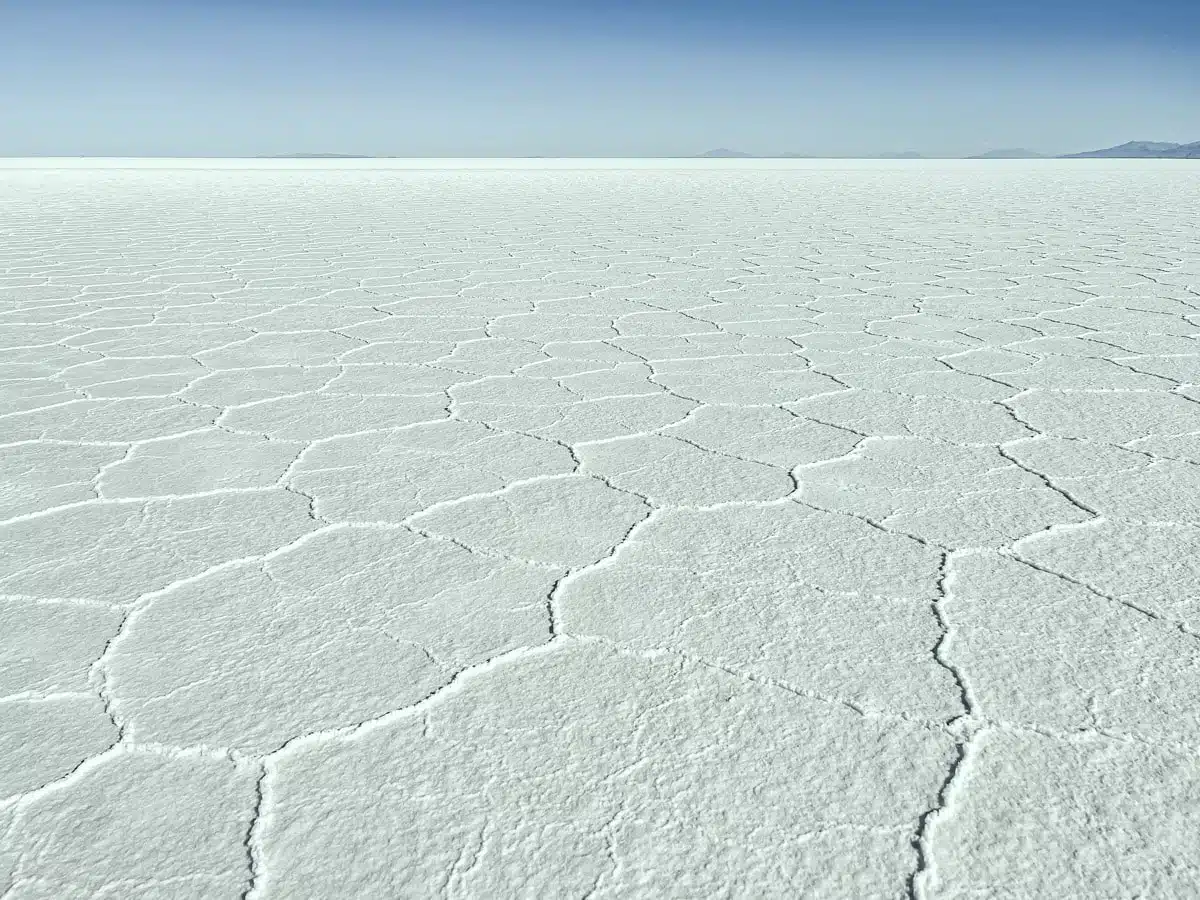
If you’re looking at the Uyuni Salt Flat and think it looks like something from a long lost time – you’re not wrong. The largest salt flat on the planet dates back to prehistoric times – when it was a massive lake.
It turned into a snow-white desert landscape somewhere around 40,000 years ago when Lake Minchin lost its water as shifting tectonic plates changed the landscape forever.
Now, it’s over 10,000 km of desert-like landscape, defined by the 10 billion tons of salt resting on the top layer.
Location
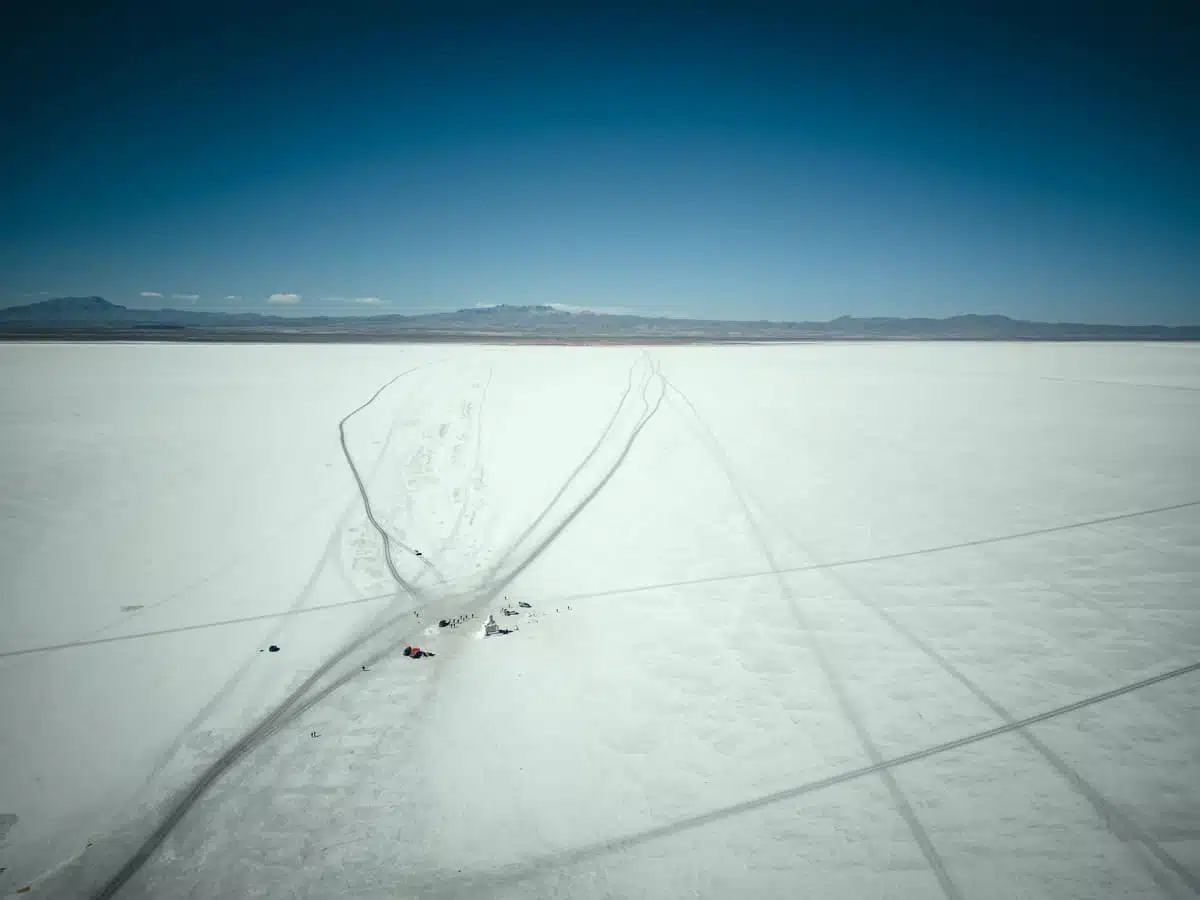
The Uyuni Salt Flats are a lot higher up than you may think. Situated at an elevation of 3,656 metres, the Bolivia Salt Flats are perched high in Southwest Bolivia near to the border with Chile . Uyuni is the nearest big city and is located on the eastern side of the flats. From Uyuni you make your way to the Altiplano, which is a plateau featuring the Sol de Mañana Geysers, several stunning lagoons and the blood-red Laguna Colorada.
It’s a Mining Hotspot
The salt flat in Bolivia is the largest you can find anywhere in the world, so there must be more than meets the eye, right? Well, as I mentioned earlier – the former lake dried up thousands of years ago, leaving this IG-famous landscape that people travel worldwide to see. But not only is it filled with the seemingly endless white salt, but it’s also rich in lithium – and accounts for around 50% of the world’s lithium reserves. Next time you see an EV on the road, it’s a safe bet that the battery is powered by lithium from Salar de Uyuni.
It’s Even Used By NASA
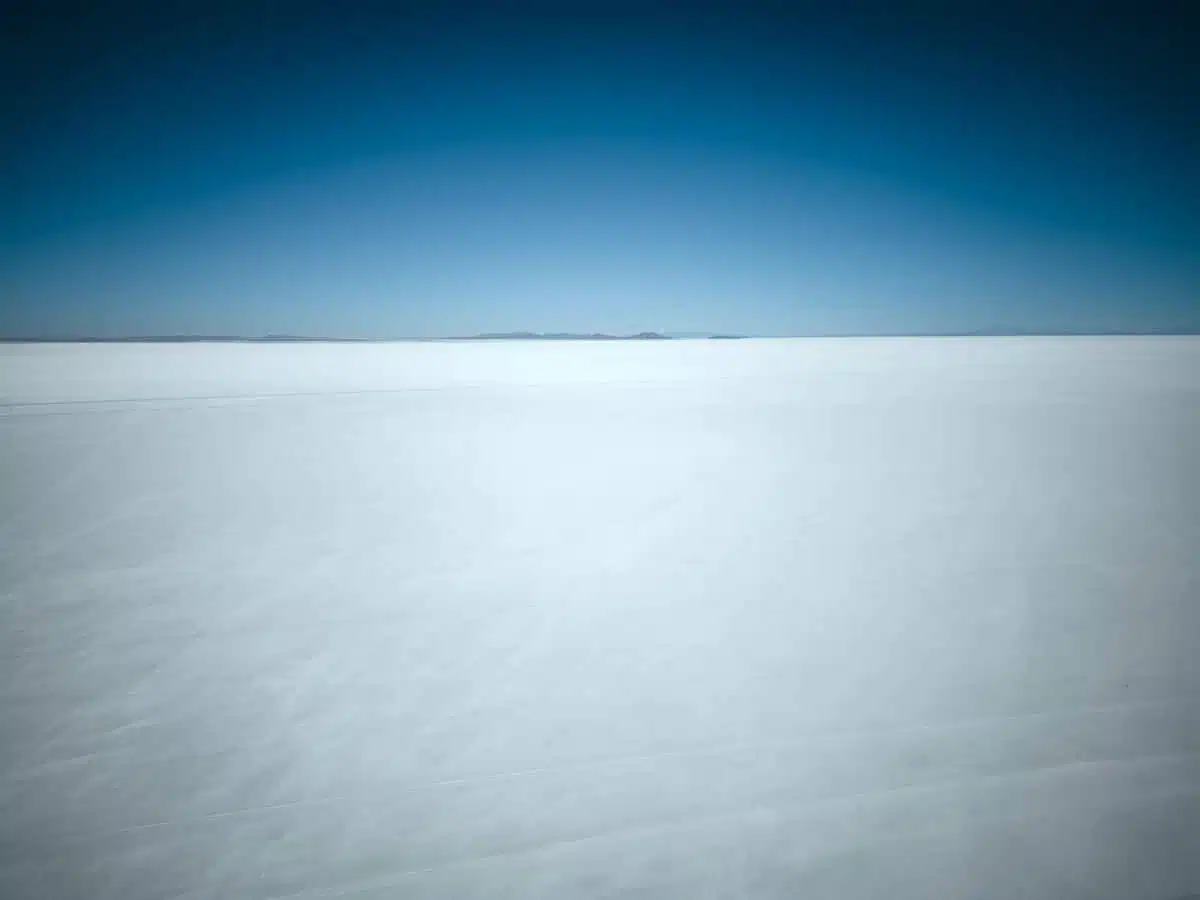
Ok, fun fact. NASA actually uses the salt flats to calibrate satellite orbits due to the large, flat surface area that the Bolivia salt flats lie on. You’ll know why when you see just how long, flat, and consistent the Salar de Uyuni landscape is.
Planning Your Visit to Salar de Uyuni
When to visit.
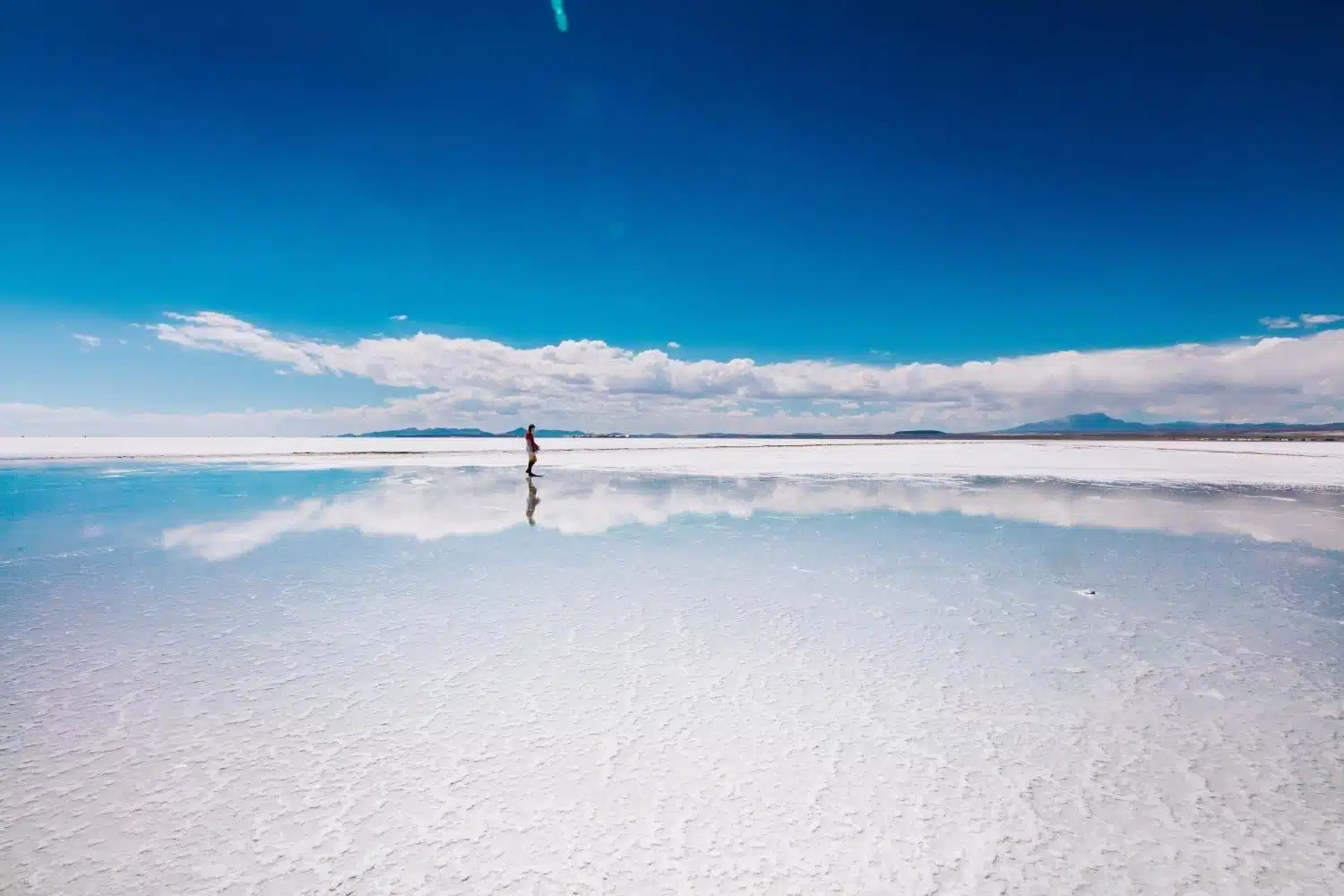
The rainy season lasts from November to February, making summer the best time to get the mirror-effect on the flats.Temperatures are usually relatively mild, often not getting much hotter than 70°F.
Wind and sun are factors much of the year, due to the high elevation and wide open flats.
Weather is much colder in the winter, with temperatures dipping below freezing, so be sure to pack for the weather if you visit from May to September.
The Best Time to Visit the Salt Flats
Seeing the Salar de Uyuni On a Tour
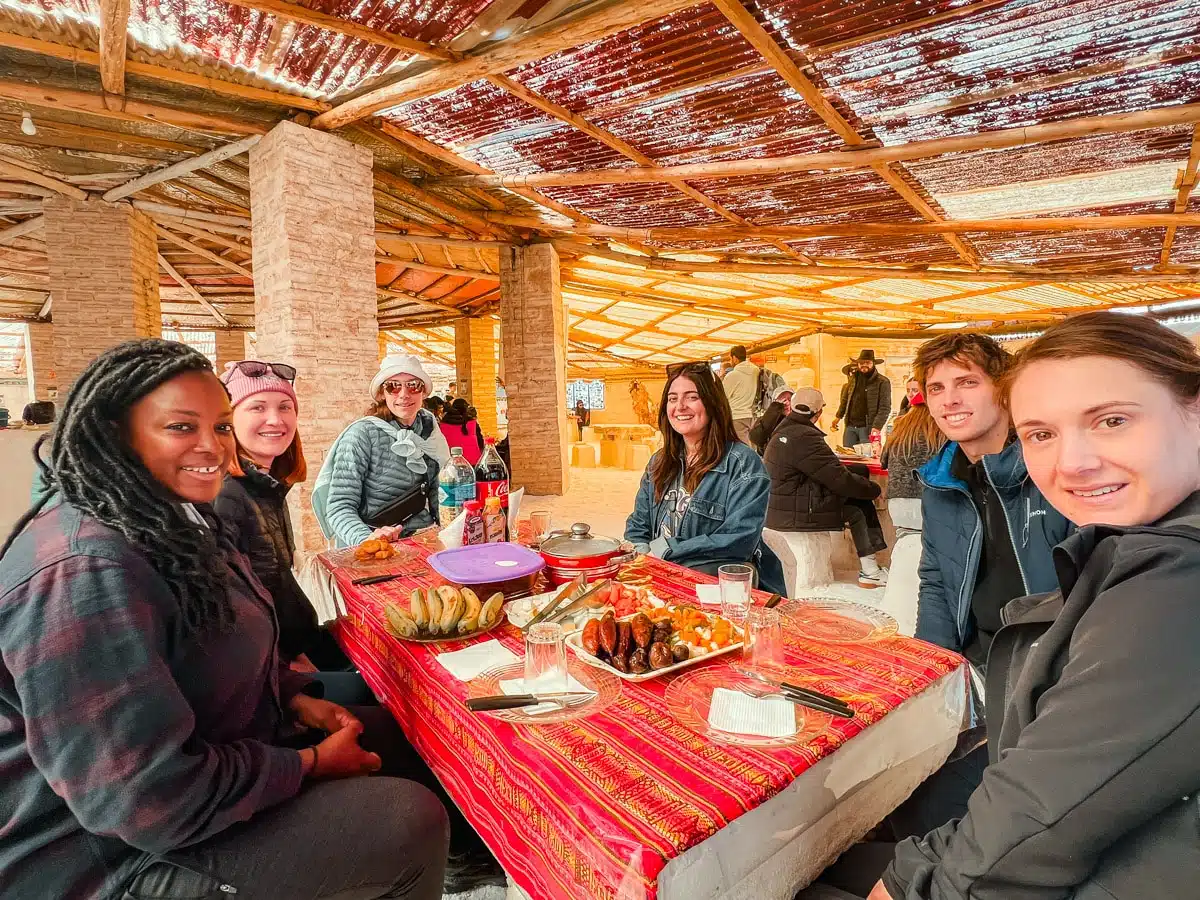
Frankly, taking a Bolivia salt flats tour is the best way to learn more about the destination, especially if you get a local guide.
You’ll need to be patient, as many of the tours aren’t quite as smooth as they should be. I recently took the Cordillera Traveller tour. While my guide was outstanding, the first day was a rough one, with no lunch and an aggressive driver.
Recommended Tours
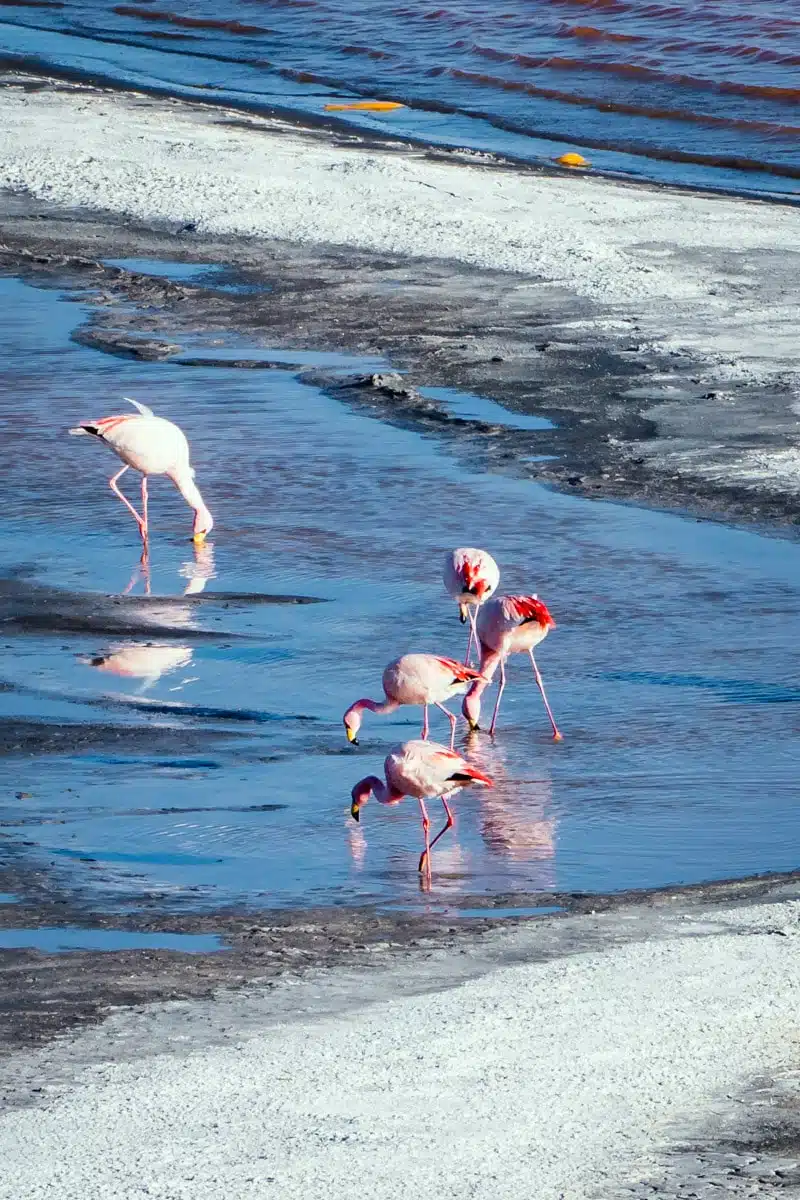
An In-Depth Guide to the Different Bolivia Salt Flats Tours
What Are the Different Tours Available?
Here’s a brief overview of the most common Salar de Uyuni tours available. I’ve gone into more detail about each of them below.
- One-day salt flats tour from Uyuni
- Two-day salt flats tour from Uyuni
- Three-day Bolivian altiplano tours from Uyuni
- Four-day Bolivian altiplano tours from Tupiza (recommended)
- Four-day tours from San Pedro de Atacama
Why Do I Recommend the Tour from Tupiza?
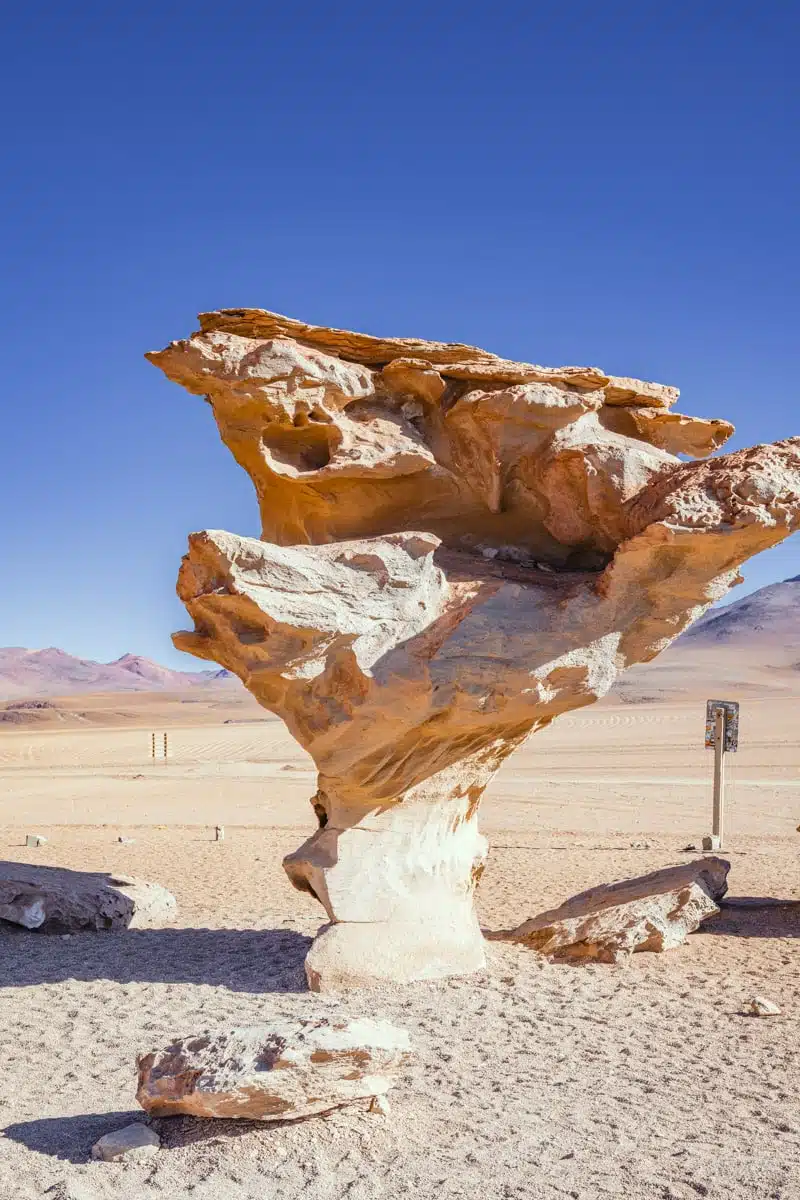
Although arranging a Bolivian salt flats tour is easily done from Uyuni itself, someone had tipped me off that the trip from Tupiza to Uyuni was much better. Why? Mainly because you get to see more of the area’s natural scenery and attractions.
So many people visiting the Bolivian salt flats do the same old tour. The landscapes are incredible enough that you’re pretty much guaranteed to be blown away whichever one you choose. But if there’s an option where you get to see more amazing stuff, quite frankly I don’t know why you wouldn’t choose it.
Sometimes a journey is as much of an experience as the destination and much as you’re in a hurry to see the Salar de Uyuni, it would be a shame to miss the other striking landscapes of the Bolivian altiplano.
Salar de Uyuni from Tupiza Tour Itinerary
Awesome sceneries abound in Bolivia. Perhaps none more so than on this Bolivian altiplano tour from Tupiza to Uyuni salt flats in the country’s wild west.
Here’s my trip report from the Tupiza to Uyuni salt flats tour I took to help you to understand what to expect.
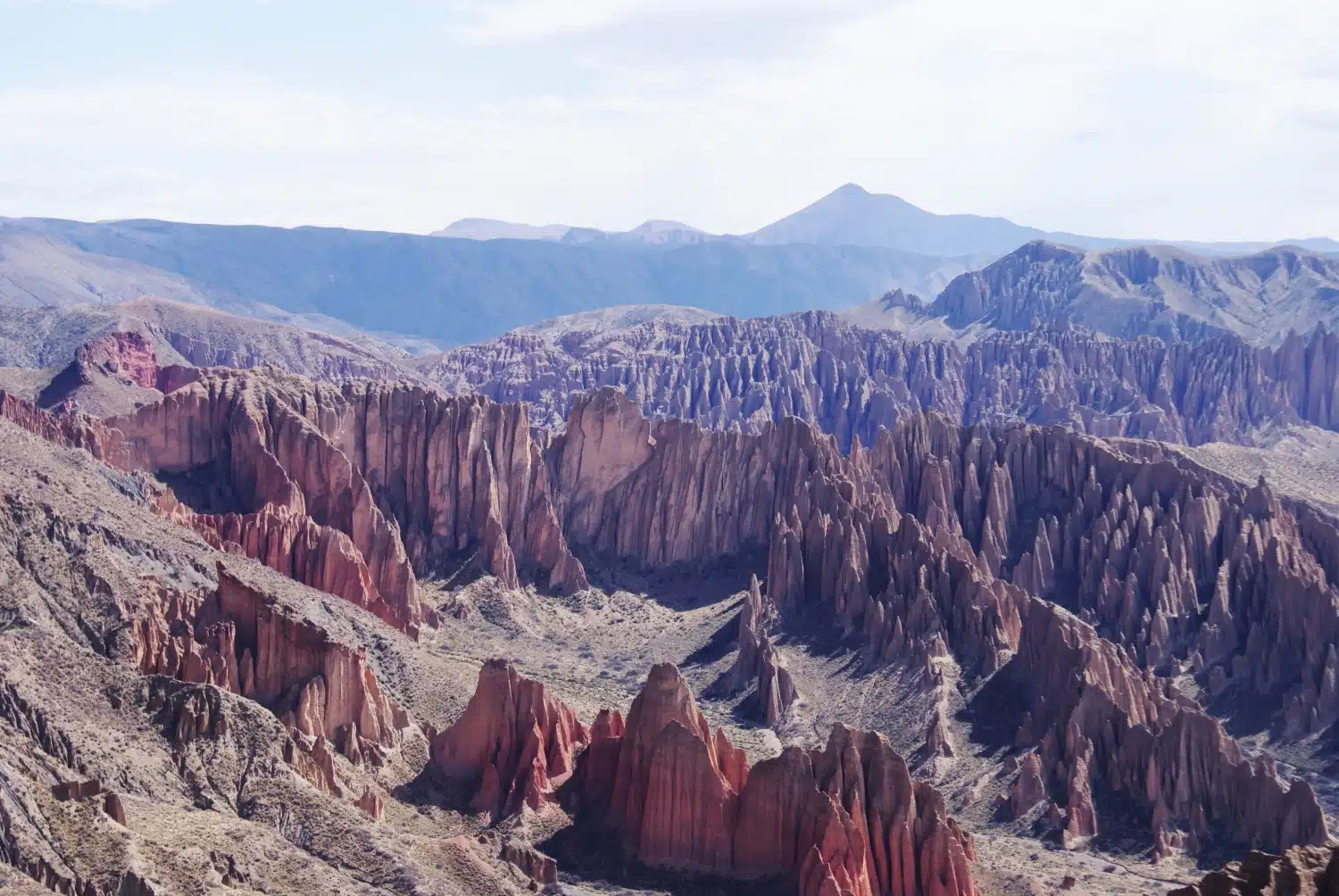
The adventure on our Tupiza to Uyuni tour began as soon as we left the town. Within a few minutes, we were climbing up a steep road with a sheer drop, and a stunning landscape on one side.
The first stop was at a wide gorge dotted with unnatural-looking precipices. Jagged triangular cliffs soared up at awkward angles below. “This is the Quebrada de Palala,” said our driver, Jose.
On the other side of the road lay an equally impressive valley, where the mountains and hills varied in hues from blue to bright orange. “The area is very rich in minerals,” he continued. “Each mineral makes the earth a different colour, which is why you have so many different colours in that valley.”
The rest of the day passed quickly: a maze of impressive landscapes as we gradually gained altitude.
Accommodation that night was basic, as were the nights to come but the meals were hearty and the beds comfortable – the best you’re going to find unless you pay a significant premium.
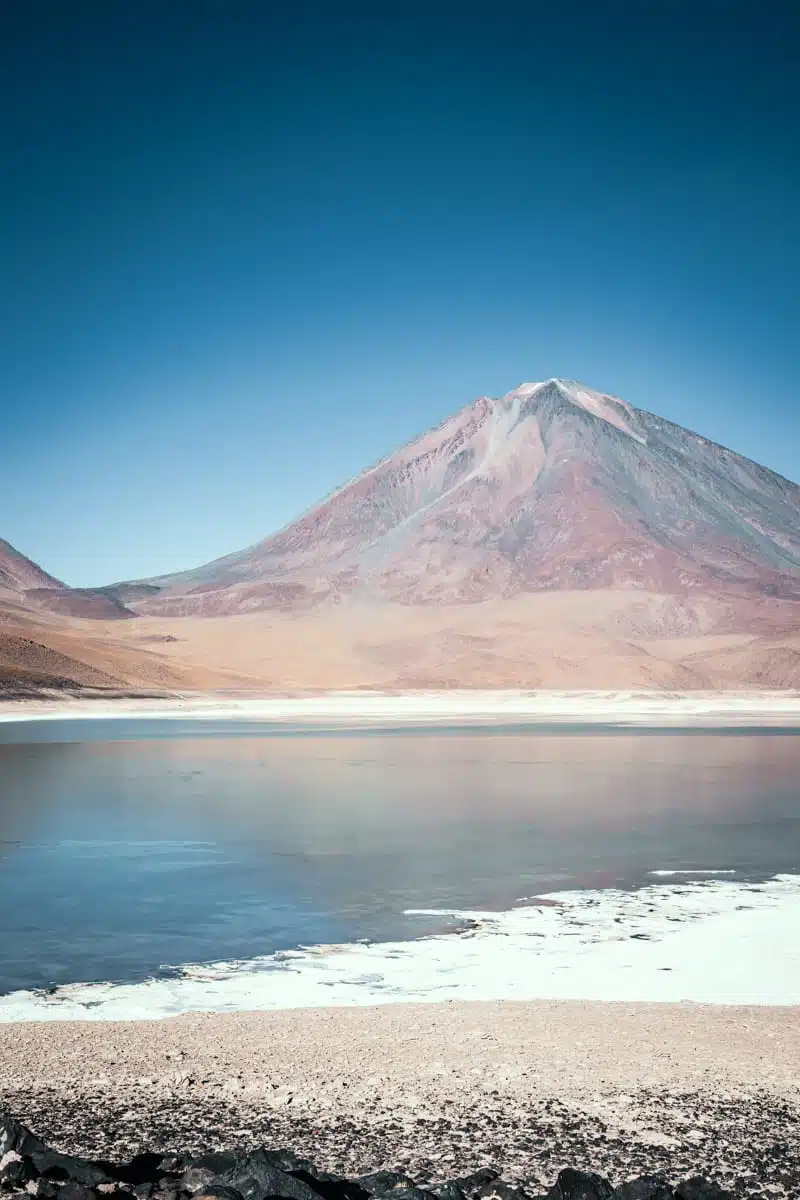
On the second day, we drove to the Laguna Verde , a green lake, and Laguna Blanca, a white lake, both of which were surrounded by a thick crust of salt, just a taste of what we were to see at the Salar de Uyuni on the final day of the Tupiza to Uyuni tour.
Driving along the roads, we saw locals warmly wrapped up in fleeces and clothes made out of precious llama wool.
As the day passed and we reached higher altitudes, the temperature continually dropped.
It wasn’t all about the jumpers, scarves and the elaborately patterned woolly hats favoured by locals and ‘gringos’ alike. We also pulled up at one of the much-welcomed highlights; the natural hot springs. Quickly donning our swimwear, we plunged into the pools and were welcomed by the warm water and a view of the adjoining lake.
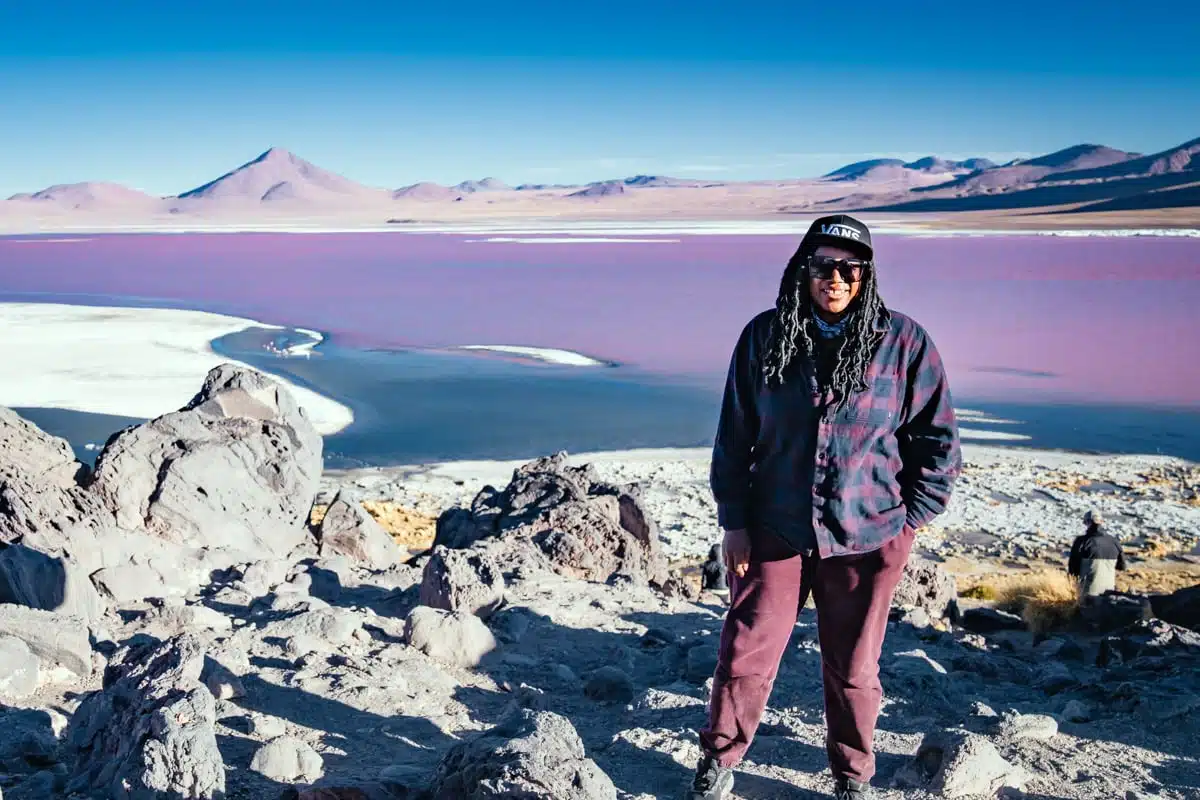
Minerals have played a major part in Bolivia’s history and present, but they are most immediately tangible in the landscapes.
On the third day of our Bolivian salt flats tour, we visited the Laguna Colorada, a lake of a bright red colour; caused by the high concentration of microorganisms in its waters. Dotted by thousands of pink flamingos, the effect is a rare one — the red of the lake and the pink of the birds stretching out for miles.
One of the beauties of the trip from Tupiza to Uyuni is the sheer variety of things to see. Bumping along the rather rough road, we’d turn a corner and be confronted by a desert plain dotted with weird rock formations, including the so-called stone tree, named for its tree-like appearance.
Peeping around another corner revealed a large lake bubbling with grey sulphuric mud springs. Salt plays such an important part in the landscape and could be seen almost everywhere.
We stopped in each place and took time to explore, climbing the rocks and running around to keep warm in the chilly wind.
Stunning Bolivian landscapes that aren’t the Salar de Uyuni
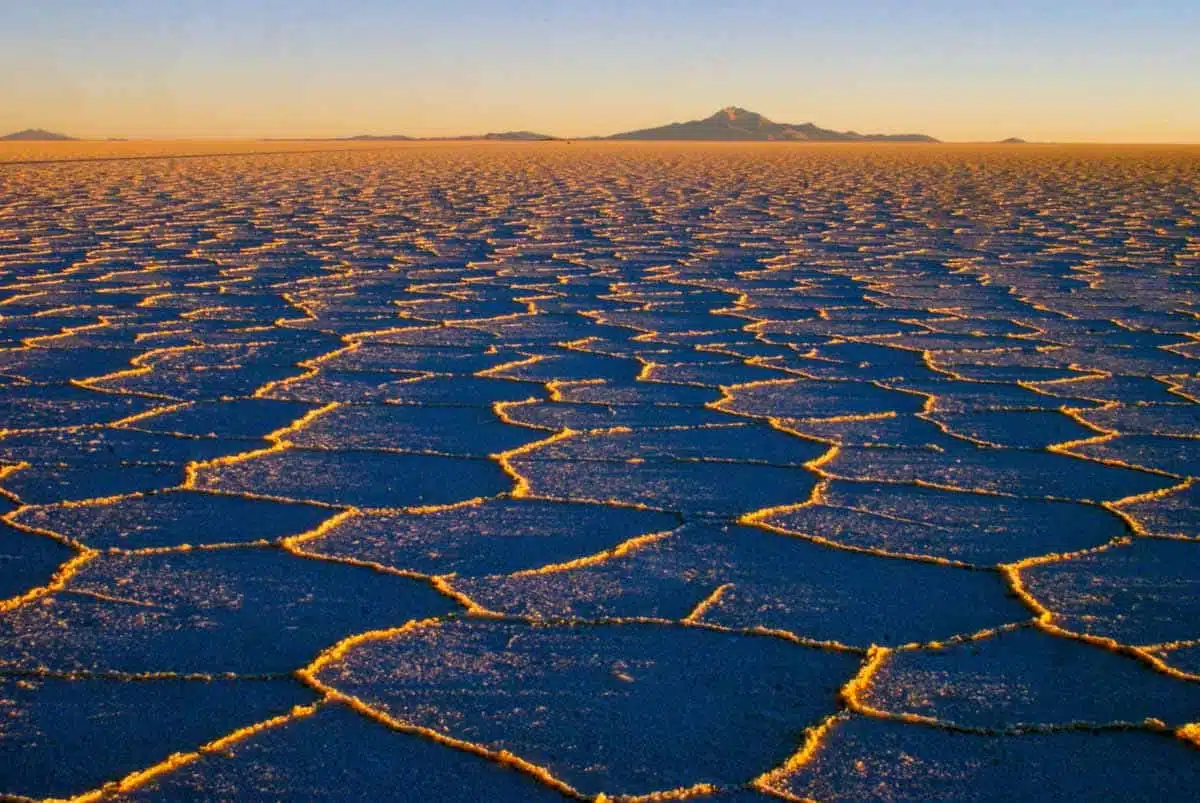
On the final day, there’s no doubt that we all grumbled as our 4am wake-up call sounded.
Piling into the Jeep, we peered anxiously for a glimpse of the Salar de Uyuni — the reason for the whole salt flat tour. As the sun began to rise, we realised that we were already driving along it!
I thought I had seen it all until I gazed out on the never-ending panorama of Uyuni’s salt flats. Miles and miles of thick salt crust crisscrossed with a jagged pattern of intersections. If you looked hard enough, you could see the faint tyre marks of the 4×4 that had brought us out to the middle of the plains.
Over the past four days, I had seen red lakes, green lakes, white lakes, jagged valleys, sulphuric springs, small Andean communities and llamas and alpacas galore. Still, nothing had prepared me for this.
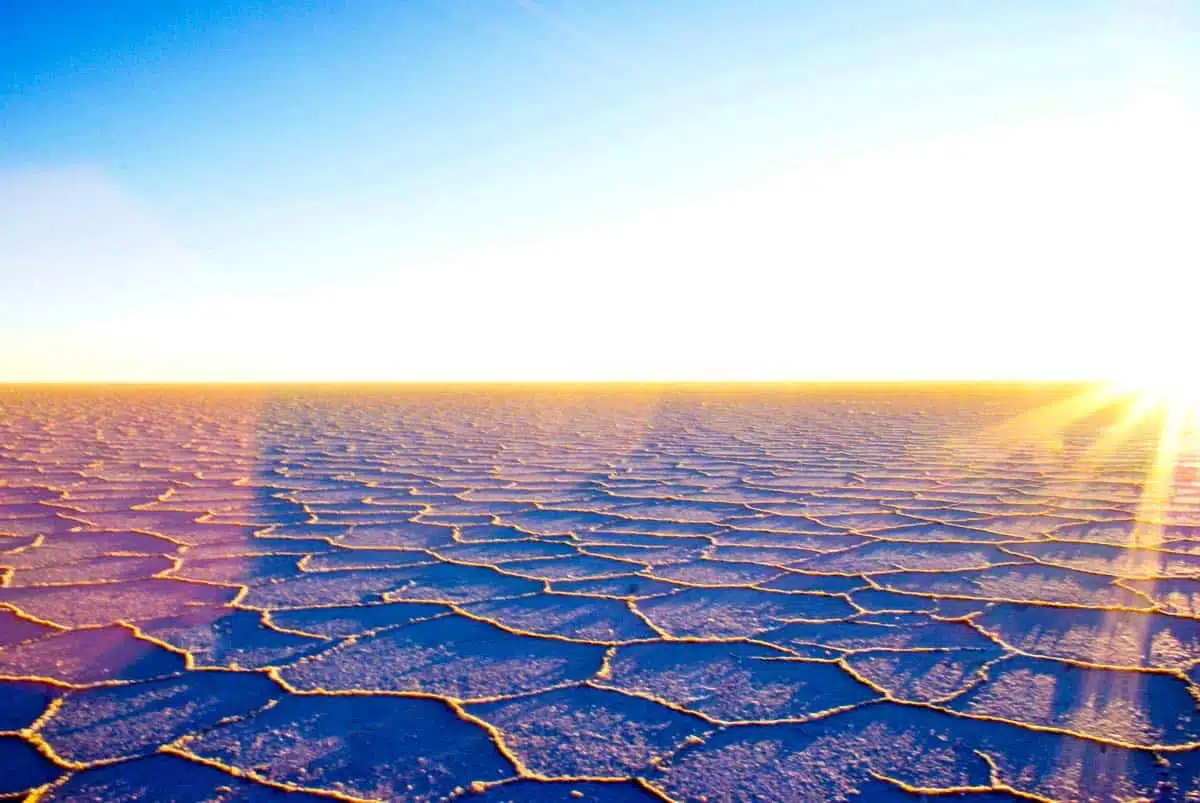
As the sun rose, the intersections between the interconnecting pieces of salt glowed orange. Gradually the light brightened, until our guide, Jose, warned us to put on our sunglasses to avoid snow blindness.
It was the perfect end to a four-day tour that had taken us from Tupiza to our final destination of the Salar de Uyuni.
We’d all faced the gruelling demands of the altitude (at the highest point in the trip, we reached 5,200 metres), along with which came the freezing nights that made you hurry for your sleeping bag as soon as the sun set.
We entertained ourselves for a few hours taking silly pictures and generally celebrating reaching our destination.
Finally, exhausted, we piled into the car and drove to the rather worn town of Uyuni, which was our final destination of the four days — many pictures and unforgettable memories later.
This tour is slightly different but covers the same destinations and includes sunrise on the salt flats
Alternative Tours
One-day tour from uyuni.
These usually start off with a visit to the train cemetery, then spend most of the day on the Salar de Uyuni with a trip to the “Fish Island” in the middle of the salt flats. Returns to Uyuni on the same day.
Book The One-Day Tour

Three-Day Tour From Uyuni
Same first day as the one day tour. These tours head further into the Bolivian Altiplano so you see more on the tour. You visit deserts, the Laguna Colorada, Laguna Verde and Laguna Blanca and the crater of the Sol de Manana volcano.
Book the Three Day Tour
Four-Day Tours from San Pedro de Atacama in Chile
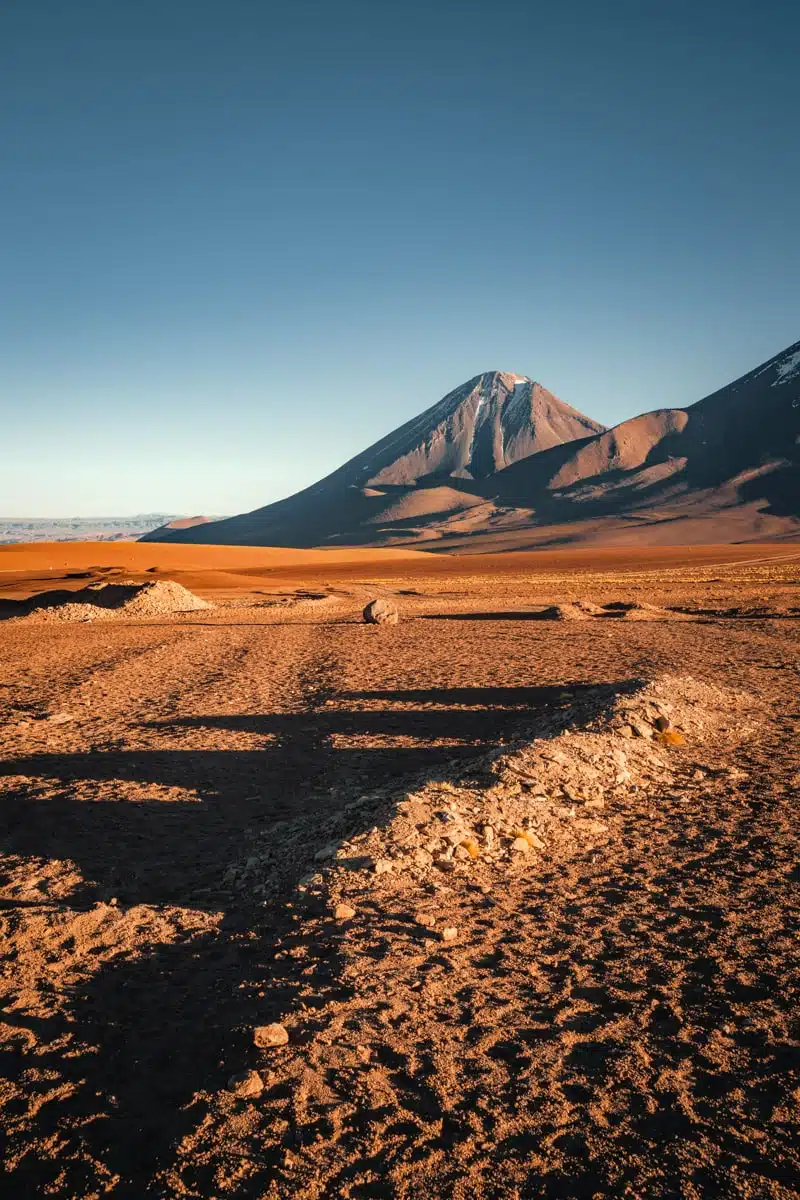
On day one this tour leaves San Pedro de Atacama and visits Licancabur volcano, Laguna Verde and Laguna Colorada plus the Polques hot springs and Sol de Manana. Day two covers a variety of lagoons for some flamingo spotting, cave paintings and a few canyons. The third day heads to the Salar de Uyuni itself and on the final day you return to San Pedro de Atacama.
Book the Four Day Tour from San Pedro
Starting Your Tour
As I explained above, there are three main starting points for trips to the salt flats: Uyuni, Tupiza and San Pedro de Atacama in Chile. Here’s how you get to each one of them.
How to Get to Uyuni
From La Paz you can get an overnight bus to Uyuni. It gets a bad rep but I did it in the other direction (from Uyuni to La Paz) and it wasn’t a big deal. The bus station in La Paz is a bit rough, just watch your bags as pickpockets are pretty rife.
The trip from La Paz to Uyuni takes about 7.5 hours. If you choose to take a bus, it will cost you about £16 to £23.50 ($20 to $30) each way.
By Train
You can take a train from Oruro to Uyuni. Oruro is about 3.5 hours by car from La Paz, so you’ll need to arrange transportation there first. The bus ride is relatively inexpensive, at around £4 ($5). From Oruro, the train ride takes around 7 hours, but it’s a beautiful ride and costs around 8 £ ($10).
Alternatively you can fly direct from La Paz to Uyuni. Getting from La Paz to Uyuni by plane takes around 1 hour and is typically around £157 ($200).
How to Get to Tupiza
Now, I’m not going to lie. Getting to Tupiza is a little more difficult than going direct to Uyuni, and generally involves an uncomfortable bus journey from one of the major cities.
The bus I took seemingly sought out potholes to bump over just for the sh*ts and thrills but it got me there and I came out in one piece so no stress. Just a bruised ass. Totally worth it though.
Fly to the Bolivian capital, La Paz, and catch a bus to Oruro and then a train to Tupiza.
Alternatively, fly to Salta in Argentina (via Buenos Aires), get a bus to the Bolivian Border at La Quiaca/ Villazon (six hours) and then catch a bus to Tupiza (three hours).
How to Get to San Pedro de Atacama
If you are getting to San Pedro de Atacama from Santiago , Chile’s capital, you are best flying to Calama airport and then either booking a transfer or catching a bus to San Pedro de Atacama.
How to Choose Your Tour Company?
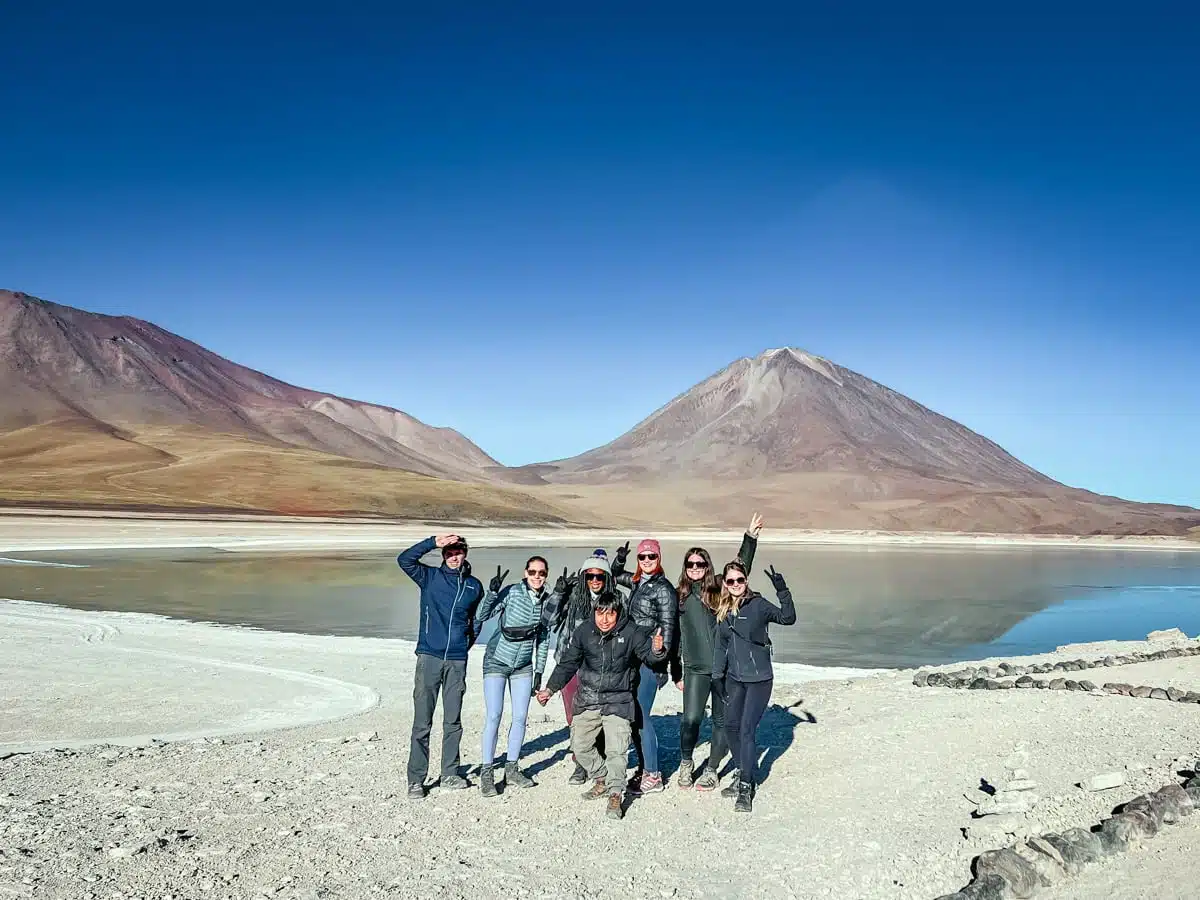
There are a lot of tour operators offering very similar tours to the Bolivia salt flats so it can be difficult to choose between them. Although it is tempting to go for the cheapest tour, it’s a decision that can come to bite you in the ass.
Spending the extra $ can make the difference between doing the tour in a vehicle that breaks down all the time with a guide who doesn’t speak your language and spending nights in super-basic accommodation and… not having to suffer any of those things. I exaggerate not.
As a guideline, you should find out:
- Does the driver speak your language? Many drivers do speak English but some don’t – make sure you check ahead.
- Will they pick you up from your accommodation?
- How many people are there per vehicle?
- How new are the vehicles?
- Where does the tour start and end?
- What food and drink is covered?
- Does the tour include entrance to the national park? Heads up: the answer to this is usually no.
Where to Stay for Salar de Uyuni
Hotel de sal luna salada (luxury).
Want to spend the night in a Bolivia salt flats hotel? Hotel de Sal Luna Salada is about as cool as it gets – as the hotel walls feature salt blocks from the nearby flats.
Located in Colchani in the heart of the salt flats, you can choose twin or full-size beds in this well-designed accommodation with views of the mountains and flats.
Enjoy local Andean cuisine at breakfast, fun activities in the game room, and a gorgeous viewing deck with fire pits for chilly evenings.
Check Rates and Availability
Casa del Sal (Mid-Range)
Another of the famous salt hotels in Uyuni, Casa del Sal , offers affordable rooms that feature brick-walled interiors with nature-themed decorations and exposed beams on the ceilings.
Rooms are plenty spacious and available at good rates, making it a good choice if you’re visiting on a budget.
Check Rates and Availability
What to Pack for Salar de Uyuni
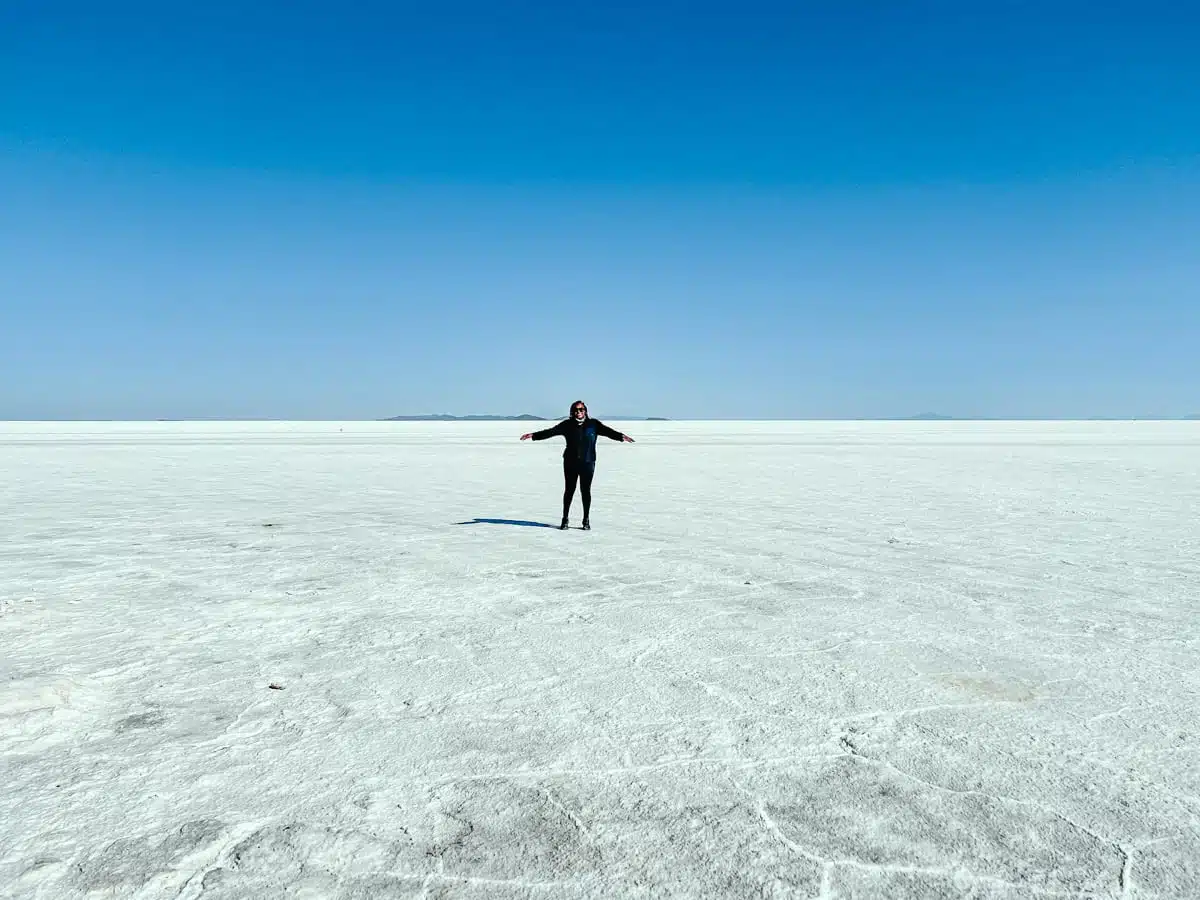
So, the altiplano is that difficult combination of having super-strong sun and very cold temperatures at night. Wrap up warm and wear layers you can easily remove as the temperature is incredibly changeable.
I suggest a thermal base layer top and bottom, a mid layer, a jumper and a softshell to help keep you snug against the wind.
Some things you’ll definitely want to pack include:
- Base Layer Top
- Base Layer Bottom
- Brushed Fleece Shirt
- Warm Bottoms
- Fleece Half-Zip
- Outer Shell
- Waterproof jacket (if you’re visiting in the rainy season)
- Water bottle
- Hiking trainers / Hiking Boots
- Sunscreen
- Scarf / Buff
- Woolly socks
- Quick dry towel
Read More Bolivia Travel Guides
- 10 Days in Bolivia, The Perfect itinerary
- The Best Bolivia Salt Flats Tours
- 18 Amazing Places to Visit in Bolivia
- Surreal Bolivian Landscapes that you Need to See to Believe
- When’s the Best Time to Visit the Bolivian Salt Flats?
Love This? Save and Share on Pinterest!
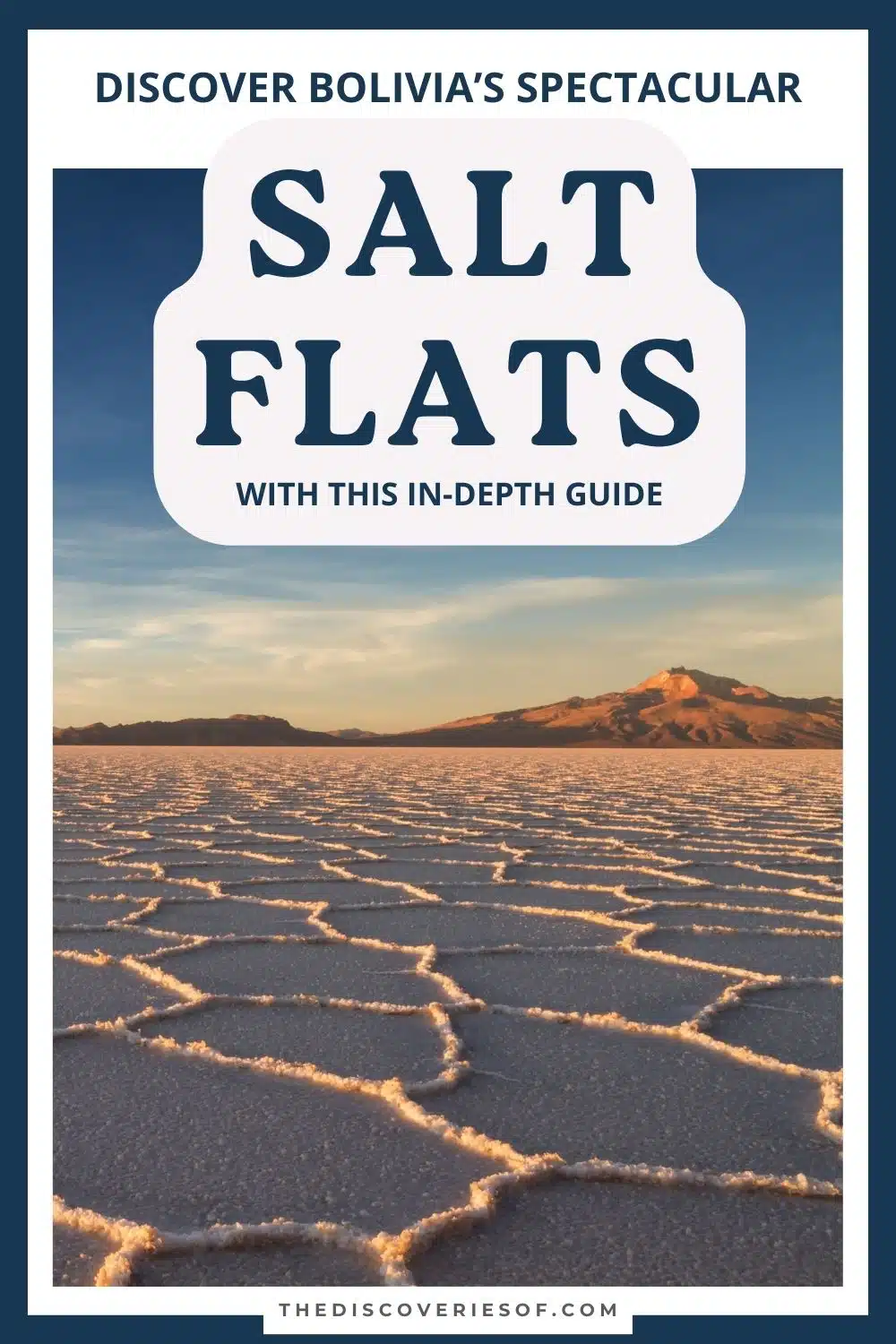
I’m Julianna Barnaby - a professional travel writer and geek extraordinaire. I started The Discoveries Of to help you to discover the best of new destinations from around the world.
Discovering new places is a thrill - whether it’s close to home, a new country or continent, I write to help you explore more and explore differently.
Related Posts
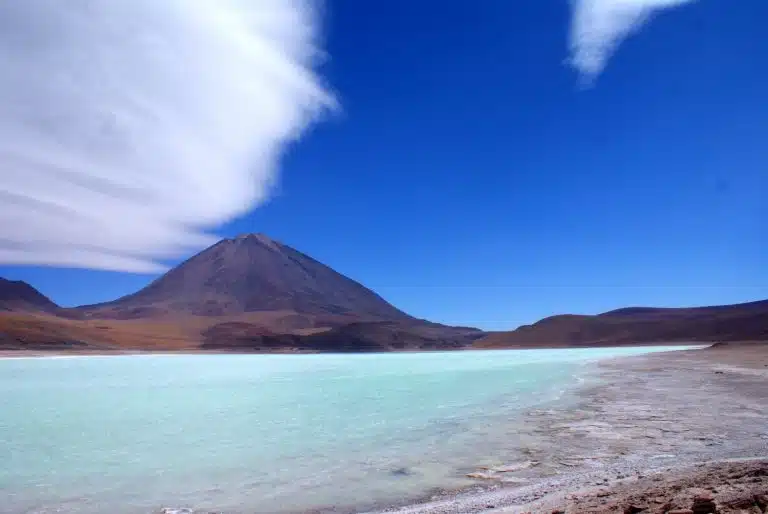
Bolivia’s Landscapes: Surreal Spots You Need to Visit
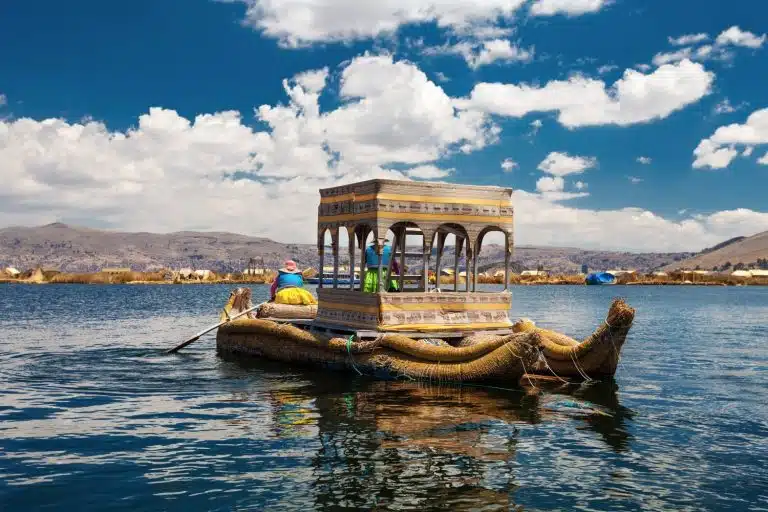
18 Amazing Places to Visit in Bolivia
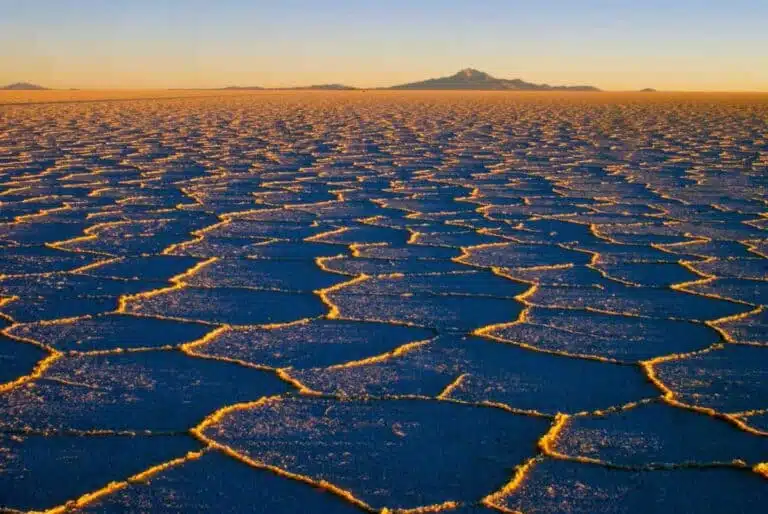
When’s The Best Time to Visit The Bolivia Salt Flats?
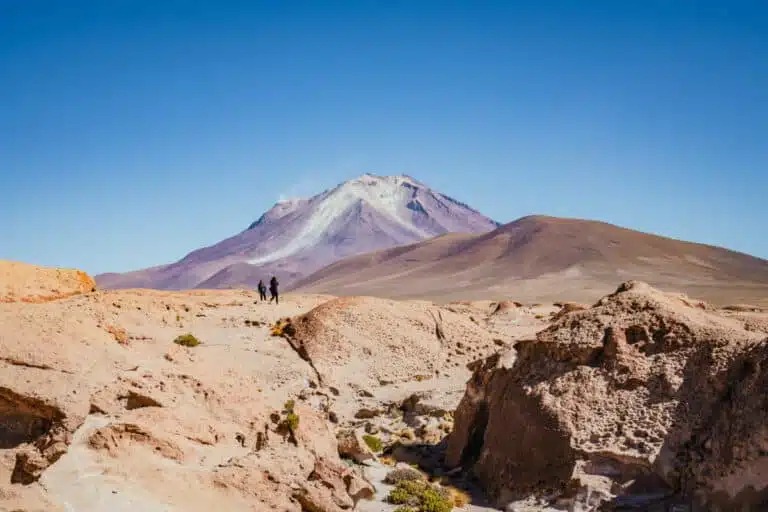
10 Days in Bolivia: The Perfect Bolivia Itinerary
Leave a reply cancel reply.
Your email address will not be published. Required fields are marked *

Follow me on Instagram for travel inspiration, tips, and guides.

Bolivia Salt Flats: The Ultimate Guide To Salar De Uyuni
One of my favorite trips I’ve ever taken was to the Salar de Uyuni, better known as the Bolivian Salt Flats . Located in southwestern Bolivia in the middle of the high plains, this natural wonder ( the largest salt flats in the world! ) is easily a bucket list destination for anyone who has ever seen a picture.
In this ultimate guide to Salar de Uyuni travel and the Uyuni Salt Flats, we’re covering everything you’ll need to know to plan for an incredible and unforgettable trip to this inspiring destination.
Don’t miss our recommendations for when to see the Salar de Uyuni reflection, known as the “World’s Largest Mirror” on the Bolivia Salt Flats.
Keep reading for everything you’ll need to know for your trip, including a complete guide to Uyuni town, including Salar de Uyuni hotels – like the famous Salt Hotel you can’t miss! – tour recommendations, and much more.
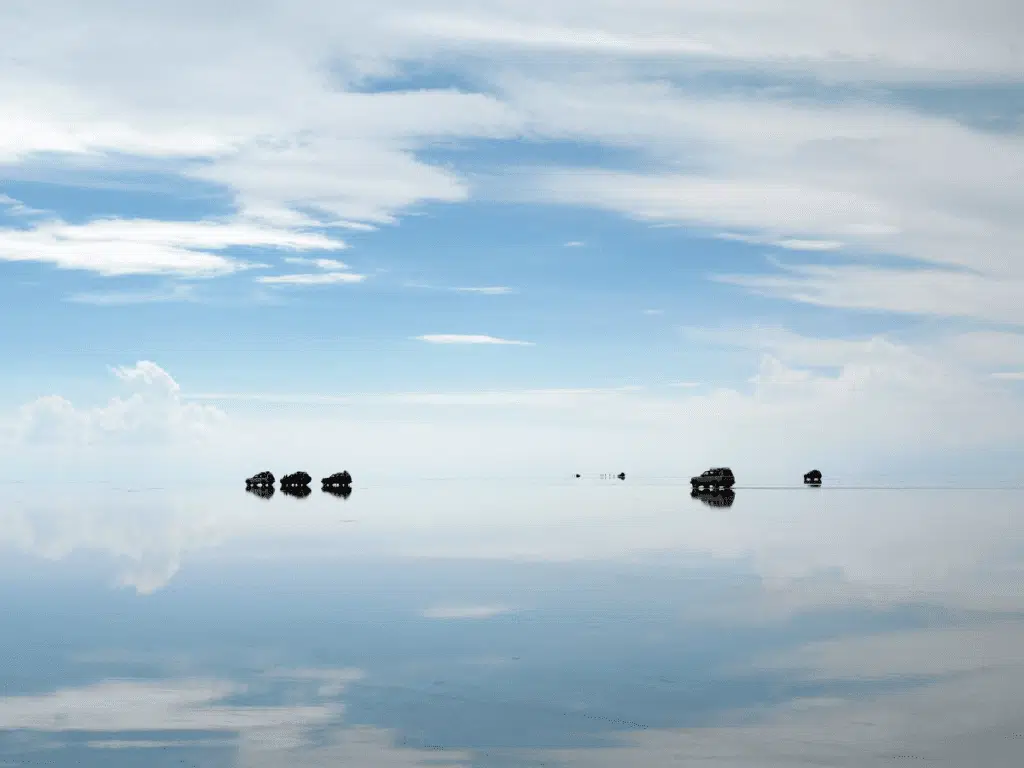
This post contains affiliate links that may reward me monetarily or otherwise when you use them to make qualifying purchases – at no cost to you. As an Amazon Associate, I earn from qualifying purchases. For more information, please read our disclosure policy .
Bolivian Salt Flats
Easily one of the most recognizable parts of Bolivia and one of the most unique and extreme landscapes on Earth, the Bolivian Salt Flats are well known for their beauty and mystery.
The Bolivian Salt Flats are the largest salt flats in the world and stretch on for miles and miles in every direction for nearly 4,050 square miles (nearly 10,500 square kilometers) .
These salt flats were created when an ancient salt lake dried up tens of thousands of years ago, leaving the salt behind . In some areas of the salt flats, the salt layer is several meters deep!
While there is SO MUCH to see in Bolivia ( it’s one of my favorite off-the-beaten-path travel destinations and one of the best countries in South America to visit ) the Uyuni Salt Flats is Bolivia’s number one destination for travelers.
There is so much to see and do here, even more than just visiting the Salt Flats themselves.
Most visitors spend a few days here exploring the Bolivia Salt Flats and the incredible surrounding countryside with a Jeep 4X4 tour – jump ahead to read more about our top Salar de Uyuni tour recommendations.
Find the Best Salar de Uyuni Tours
Check out our Ultimate Guide to Bolivia Salt Flats Tours for more information and recommendations for the best Salar de Uyuni tours.
In the drier months, you’ll see dry white salt crystals as far as the eye can see, but in the wetter months of the rainy season, waters pools on top of the salt flats .
Because the water doesn’t have anywhere to go, it will sit nearly perfectly still, creating a mirror effect with the sky above that looks like something out of a sci-fi movie .
No, truly, out of a sci-fi movie! There is a Salar de Uyuni Star Wars appearance in a Star Wars movie that was filmed here – jump ahead to read more about Star Wars on the Bolivia Salt Flats and other Salar de Uyuni facts.
Salar de Uyuni Reflection
The Bolivia Salt Flats are probably best known for their incredible reflective properties during the wet season. I’m sure you’ve seen the pictures – photos that look like the sky is perfectly mirrored on the ground, with a barely discernable horizon in the distance .
While a visit to the Salar de Uyuni is incredible at any time of the visit, visiting during the rainy season and seeing the Salar de Uyuni reflection, called the World’s Largest Mirror, is truly unforgettable.
When water pools on top of the Salt Flats after rain, it doesn’t easily have a way of escaping, meaning that it will sit quite still over the salt flats for a long time.
Looking at the ground from above, you’ll easily be able to see through the water to the salt below , but when looking toward the horizon, you’ll see this fantastic reflection.
When photographing the Uyuni Salt Flats reflection, shoot toward the horizon for the best effect . Shooting towards the sun and creating silhouettes of people in the morning and afternoon also do a great job of creating a nearly flawless reflection shot.
Best Hotels & Hostels in Uyuni
- Hotel Nido del Flamenco ($ – $$)
- Casa de Sal Salt Hotel ($$)
- Hotel Palacio de Sal ($$ – $$$)
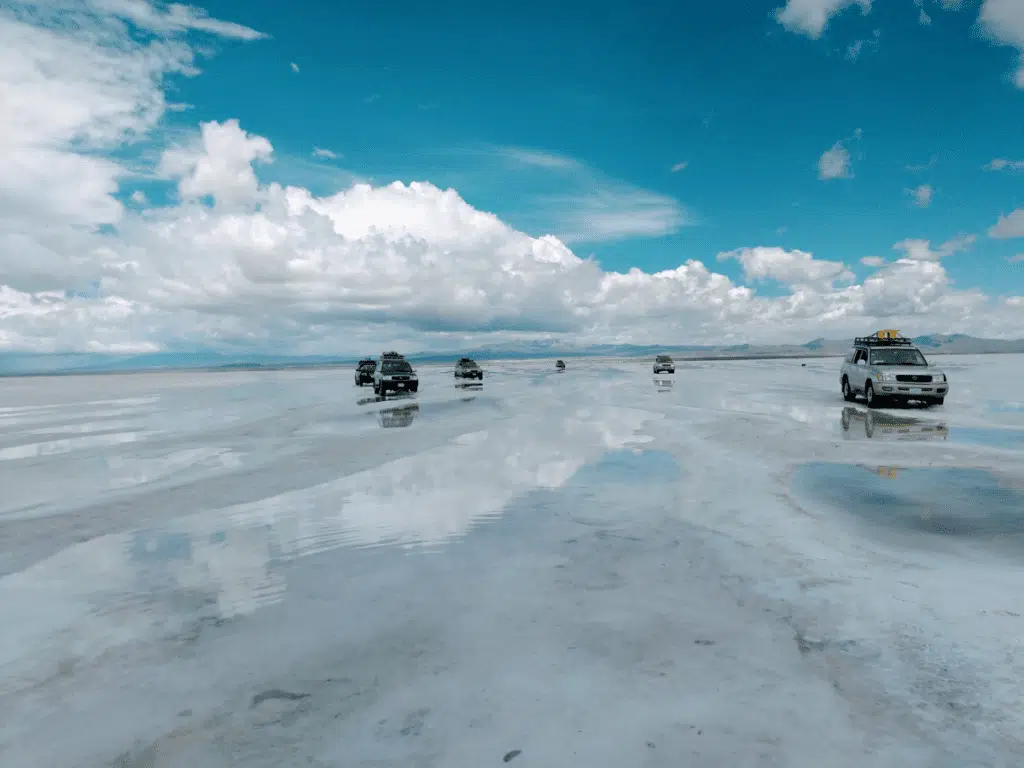
Remember, there are likely going to be areas of the Salt Flats that are more flooded than others during the rainy season, and your guide may have to travel a few kilometers to find a spot that can best show off the Salar de Uyuni reflection .
Because the reflection is dependent on the last rain, it’s never a guarantee to see it!
However, if you visit during the rainy season (December through April – with the best chance to see the reflection in January or February!) you’ll most likely see this effect on the Bolivia Salt Flats!
World’s Largest Mirror
The reflection of the sky at Salar de Uyuni during the rainy season is commonly referred to as the “World’s Largest Mirror” for the way it perfectly mirrors the sky.
The World’s Largest Mirror Salar de Uyuni reflection is actually so large during the rainy season that it can be seen from space! This is one of my favorite Salar de Uyuni facts!
Make sure when visiting that you have a chance to take tons of photos showing off the reflection – tour guides will know the best spots to take you on the Salt Flats for the best photography! Many tour participants also share that tour guides are generally helpful in directing how to take photos to maximize the effect – my guide was super helpful for photo ideas as well!
Salar de Uyuni Facts
Salar de uyuni appeared in star wars.
Salar de Uyuni appeared as a filming location in Star Wars: The Last Jedi, released in 2017. In this Star Wars franchise movie, Salar de Uyuni served as the backdrop for the planet Crait – with its flat, stark, white landscapes it makes a perfect backdrop for an alien planet!
Salar de Uyuni is the Flattest Place on Earth
The Bolivian Salt Flats at Uyuni is the flattest place on earth! The Bolivian Salt Flats are known for being extremely flat – one of the flattest places on earth.
There is almost no change in elevation when moving across them, due to the way they were created, with receding saltwater.
This extreme flatness combined with few points of reference – all you’ll see will be salt and sky at the horizon – leads to crazy optical illusions.
One fun part of any Bolivia Salt Flats tour is taking “fotos locos” as the local guides call them – “crazy photos” that demonstrate this insane loss of depth perspective. Guides will often bring things out on the salt flats to take these pictures with, or you can bring your own along with you or find some in town.
What to Pack for Salar de Uyuni
Check out our Ultimate Salar de Uyuni Packing List for our tried and tested packing list. Don’t repeat our mistakes on your Laguna Colorada and Salar de Uyuni adventure!
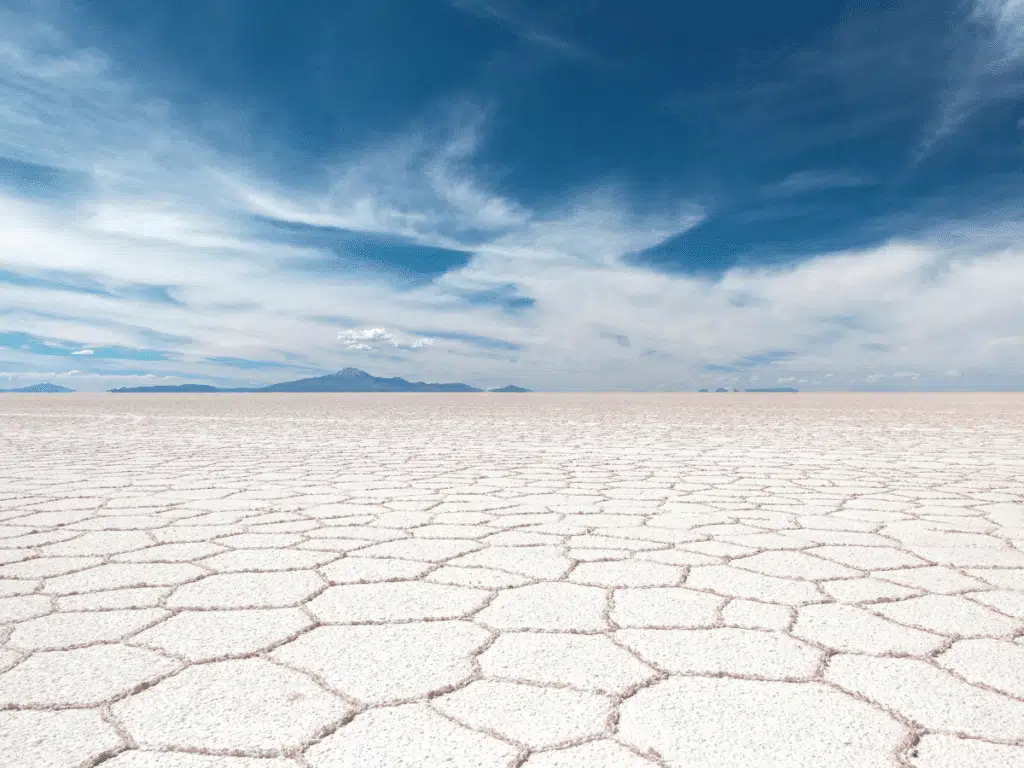
Salar de Uyuni’s Hotels are Famous
Salar de Uyuni is famous for the salt hotel – these are hotels built entirely out of blocks of salt carved from the Bolivian salt flats.
There are hotels at all price points in Uyuni and the surrounding communities built entirely from giant blocks of salt . Make sure to stay in one while you’re visiting – it is a once-in-a-lifetime experience, and definitely the best option for where to stay in Uyuni.
Uyuni has plenty of salt hotel options at all price points- check out these for an unforgettable stay:
- Hotel Casa de Sal – $$
- Hotel Sal Andina – $$
Often the Salar de Uyuni Jeep 4×4 tours will include a night in a salt hotel , but you’ll want to make sure to contact your tour company to verify this, as you don’t want to miss this unique accommodation experience!
What About the Uyuni Salt Flats Is So Special?
Salar de Uyuni, Bolivia is home to one of the world’s largest lithium deposits, found beneath the thick layer of salt. In a world increasingly reliant on lithium batteries and the countless other ways lithium powers us, Salar de Uyuni represents one of the world’s richest sources of this resource.
Geologists aren’t sure about the true size of the lithium deposits under the Salar de Uyuni, but this is thought to be one of the largest concentrated areas of lithium on Earth. Not much has yet been extracted, but Bolivia could become one of the world’s major lithium producers in the coming years.
Salar de Uyuni Map
I created this Salar de Uyuni map to help you get your bearings about what to see and where to visit when planning a Salar de Uyuni trip. While the Salt Flats are certainly the star of the show, there is so much more to see here!
Click and zoom on the Salar de Uyuni map to see the location of destinations mentioned throughout this article, as well as places you can’t miss when visiting the Bolivian Salt Flats and the surrounding region.
Salar de Uyuni Altitude
Salar de Uyuni is located in Bolivia’s altiplano, or, “high plains” region, and is located in some of the highest parts of the Andes mountains . Here you’ll definitely feel the altitude as soon as you arrive! The Salar de Uyuni altitude is often the highest that most visitors have ever experienced.
Keep reading to come prepared and knowledgeable about what to do to avoid the effects of altitude (drink water and coca tea… and more!) .
Uyuni Altitude
The town of Uyuni is located at an astonishing 12,139 feet (3,700 meters) above sea level , meaning that any visit here will likely be one of the highest altitudes that most visitors ever experience.
Within and around Uyuni there is not much change in elevation. The Salt Flats themselves are known for being extremely flat – one of the flattest places on earth – altitude doesn’t vary much.
However, if you’re headed out on one of the popular Jeep 4X4 tours of the Salt Flats and of the surrounding region, you will experience altitudes that are both slightly higher or lower than the altitude of Uyuni.
For example, the altitude at Laguna Colorada is much higher than the altitude at Salar de Uyuni , located at about 14,100 feet (4,300 meters) above sea level. This will be around one of the higher locations you’ll likely visit on a tour!
Read More for Bolivia Travel
- Ultimate Salar de Uyuni Packing List
- Visiting Laguna Colorada, Bolivia: A Complete Guide
- La Paz, Bolivia: Ultimate Traveler’s Guide
- Best South American Countries to Visit (On a Budget)
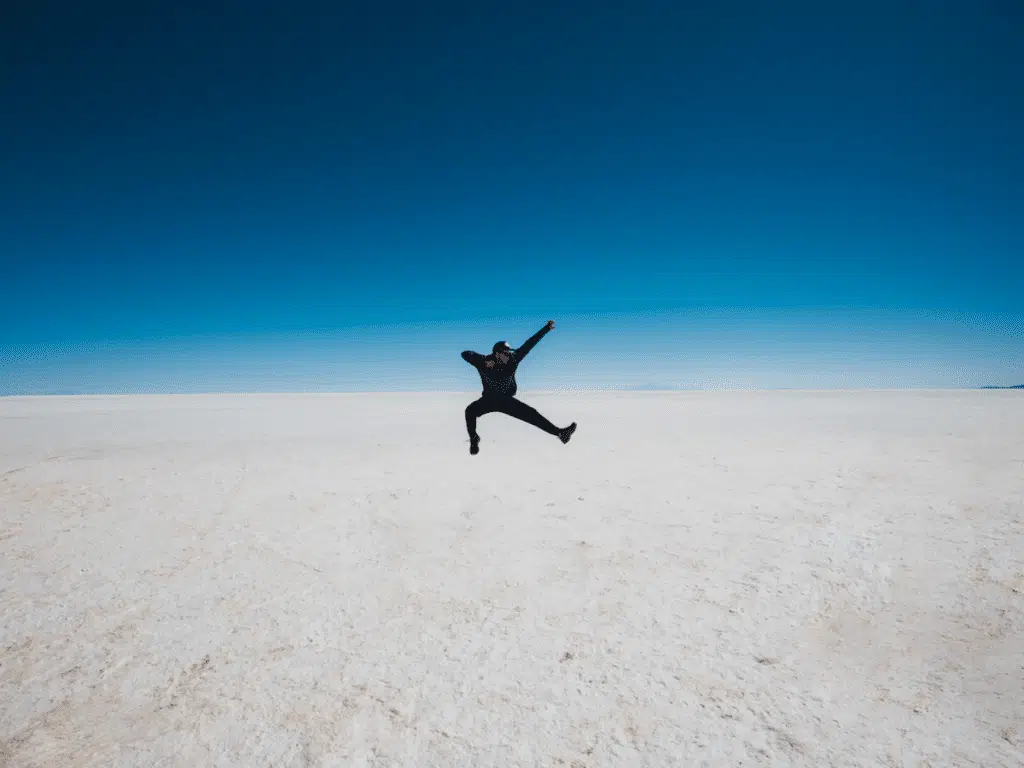
Salar de Uyuni Altitude Sickness
Given its extremely high altitude, be prepared to feel some effects of the altitude when you arrive in Uyuni – though you likely won’t notice much difference if you’ve already visited La Paz . Come prepared for the altitude by knowing to expect these symptoms:
- Lightheadedness
- Greater exertion required when walking or exercising
- Shortness of breath
Thankfully most travelers will only feel mild symptoms, and drinking plenty of water and getting extra rest should do the trick.
Plus, as most travelers to Uyuni come from La Paz to the Salt Flats, most don’t feel the change in altitude – the Salar de Uyuni is only about 200 feet (60 meters) higher in altitude than La Paz, so there isn’t much change.
Coca Tea in Bolivia
One local remedy to help ease altitude sickness is drinking tea made from coca leaves – you’ll find coca leaves and coca leaf tea everywhere in the mountainous regions of Bolivia and Peru.
I found drinking coca tea to be extremely beneficial for easing the symptoms of altitude sickness and energizing even when only experiencing minor symptoms.
Coca is notorious for being the plant used for the production of cocaine, but coca leaves have been used for centuries by locals to help ease the effects of altitude sickness and other ailments.
It is usually enjoyed by making tea directly from the leaves or sucking on the leaves. Don’t worry, it won’t unintentionally make you high!
You can get tea from coca leaves at plenty of cafes, in tea bags from supermarkets or corner stores, or buy the leaves directly from markets – don’t worry, you won’t have any trouble finding it in Uyuni or throughout Bolivia.
Salar de Uyuni Best Time to Go
Picking when to visit Salar de Uyuni, Bolivia is one of the most important decisions you’ll make about your trip! The experience you have here will be entirely different depending on the time of year of your trip.
Because the Salt Flats are only flooded during the rainy season, you’ll only have a few months out of the year where you’ll be able to see the reflection that Salar de Uyuni is known for.
However, no matter what time of year you visit, it is worth a trip – the landscape here is just that beautiful!
December – April
These months mark the wet season at the Uyuni Salt Flats . While you’ll also have cooler temperatures and a higher likelihood of cloudy skies, you’re most likely to see the reflection on the salt flats.
Generally, January or February are the months that are the rainiest and most likely to produce the reflection over the largest area of the Salt Flats . In March and April, you’ll start getting better rates from tour operators.
May – November
These months are mostly dry, and you likely will not see the reflection on the Salt Flats if you visit at this time. However, you’ll also enjoy blue skies, warmer weather, and smaller crowds in May, October, and November. You’ll also get some better rates for Salar de Uyuni tours.
Regardless of when you visit, even in the warmer and drier season, remember that you’ll still be at high altitudes, and it will be cold at night ! Come prepared with jackets, sweaters, and even a hat and gloves (you’ll need them at night) no matter when you plan to visit.
How to Get to Uyuni
Most visitors to Uyuni travel via La Paz, the capital of Bolivia and the nearest large city. The most cost-effective way to travel from La Paz to Uyuni is via overnight bus, lasting about 10-11 hours. Buses depart frequently from the Terminal de Buses – Lapaz bus terminal in central La Paz.
There are several bus companies that make the journey to the Uyuni Salt Flats, including Trans Titicaca, Cruz del Norte, and Panasur, but most prefer to take the Todo Turismo bus.
While all these bus companies have lie-flat seats for around $20-30 are and quite comfortable, the Todo Turismo is slightly nicer, provides dinner (and wine!), and is just a few dollars more .
Make sure to book ahead (tickets do sell out frequently on peak days!) . You’ll want to get your ticket at least one day in advance, or online. You can book tickets online with a pickup from your hotel for just a few dollars more at this link: La Paz – Uyuni Overnight Bus Tickets .
However, there are plenty of ways to access Uyuni – particularly by bus – that avoid passing through La Paz. You’ll find frequent buses to Uyuni from nearby towns like Tupiza in southern Bolivia and San Pedro de Atacama (or Calama) in northern Chile .
Consider taking a bus through these cities if you’re traveling through Argentina or Chile, respectively.
Or, why not start a Salar de Uyuni tour that ends in Uyuni? Check out these options for more details:
- San Pedro de Atacama to Uyuni Salar de Uyuni Tour
- Tupiza to Uyuni Salar de Uyuni Tour
Other large Bolivian cities with direct buses to Uyuni include Potosí and Sucre, which are relatively quick journeys . Longer direct routes from cities like Cochabamba are painfully long.
Uyuni Airport
Unless you’re traveling on a strict budget, I’d recommend checking out the flights into the Uyuni Airport – they generally are not too expensive and will save you an overnight bus ride.
The Joya Andina Uyuni Airport is small but modern and receives frequent flights from La Paz, Sucre, and Santa Cruz, Bolivia . Located close to everything in this small town, it costs less than $5 to get to and from the airport .
Check out our Ultimate Guide to Bolivia Salt Flats Tours for even more information and recommendations for the best Salar de Uyuni tours.
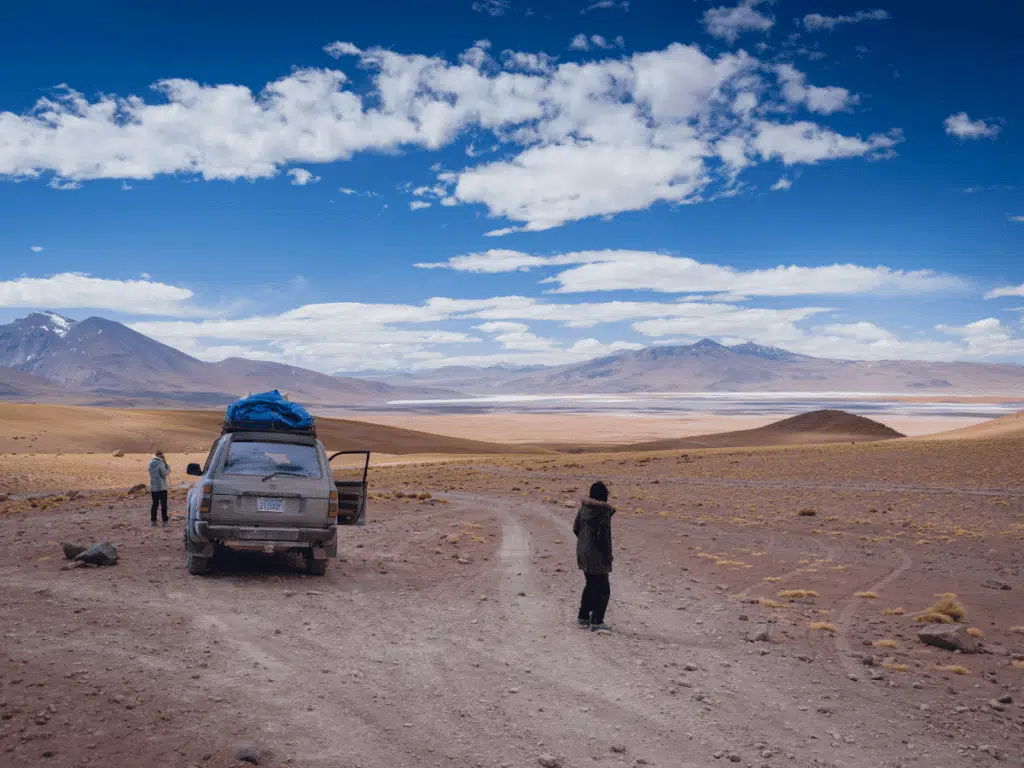
Salar de Uyuni Tours
The Salt Flats at Salar de Uyuni cover huge distances and are nearly empty, so they can’t really be visited on your own . Almost all visitors to the area book either a day trip around the Salt Flats or a multi-day tour of the entire region.
While full-day tours of the Salt Flats will give you an incredible experience visiting this unique destination, I recommend trying to make room in your itinerary for a multi-day tour.
Most multi-day Salar de Uyuni tours are three days and two nights, and are the perfect length of time to enjoy the entire area. These tours always include a full day at the Salt Flats and extra time to enjoy here .
Best Salar de Uyuni Tours:
- Full-Day Tour: Salar de Uyuni
- Two-Day Tour: Salar de Uyuni and Tunupa Volcano
- Three-Day Small Group Tour: Salar de Uyuni and the Lagunas Route
Multi-day tours are all-inclusive and will take you around the entire region, visiting destinations like the incredible Laguna Colorada , bubbling hot springs, deserts, volcanoes, and much more. This region has so much to offer, and you won’t regret taking the time to experience it.
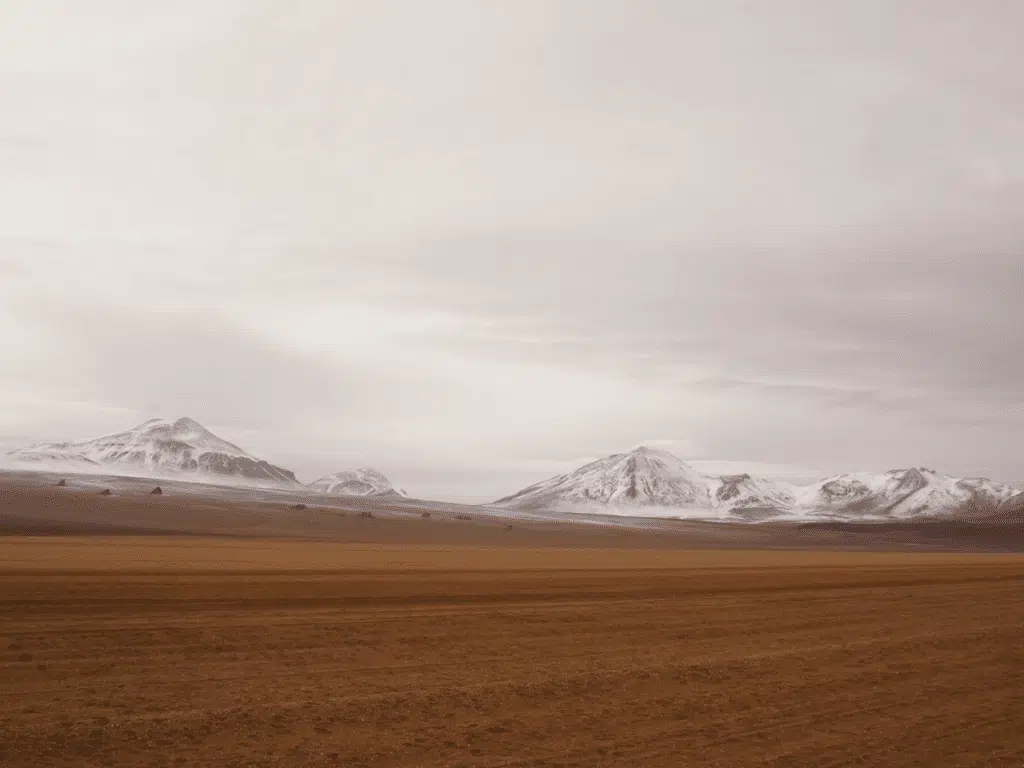
While most multi-day tours depart from Uyuni town, you can also find tours from San Pedro de Atacama, Chile, directly from La Paz, or Tupiza in southern Bolivia near the Argentina border.
- San Pedro de Atacama: Salar de Uyuni Salt Flats Tour from San Pedro
- La Paz: Salar de Uyuni Salt Flats Tour from La Paz
- Tupiza: Salar de Uyuni Salt Flats Tour from Tupiza
The small town of Uyuni on the edge of the Salt Flats isn’t much of a site to see itself – it really exists to support visitors and the infrastructure they need to visit the Salt Flats. It isn’t the most charming, but it has more than enough to support visitors.
Here you’ll find plenty of accommodation options, tour companies, restaurants , and everything else you could need as a traveler passing through.
Top Uyuni Tips
Looking for a complete guide to the ins and outs of Salar de Uyuni tours and recommendations for the best tour companies? Check out our Ultimate Guide to Bolivia Salt Flats Tours .
Where to Stay in Uyuni
There are plenty of accommodation options in Uyuni, and in recent years the options have really expanded to better accommodate travelers at all price points.
Of course, one of the major draws here are the unique salt hotels that you’ll find around the city . Created entirely out of blocks of salt carved from the Salt Flats (even bed frames and other furniture it all salt!), these hotels are definitely worth at least a one-night stay for the experience – add this to your ultimate “what to do in Uyuni” list!
Make sure to check out these options if you’re interested in staying the night in one of these unique accommodations!
- Hotel Palacio de Sal – $$ – $$$
If you’re planning to stay a night in Uyuni town before embarking on a multi-day tour of the Salar de Uyuni and the surrounding region, it’s worth checking ahead with your tour company to see if a night in a salt hotel is a part of your tour – many tours include this fun experience.
If so, you could consider normal accommodation while in Uyuni.
Look into these options if you’re looking for Salar de Uyuni hotels other than a salt hotel:
- Piedra Blanca Hostel – $ (the best hostel option in town!)
- Hotel Boutique Atipax – $ (super affordable but stylish and comfortable!)
- Hotel Jardines de Uyuni – $$
What to Do in Uyuni
There isn’t much to do in Uyuni besides visiting the Salt Flats – but there are some sites you won’t want to miss!
The town largely exists to provide the infrastructure to support visitors to the Salt Flats, so most of what you’ll find here centers around Salt Flat tours.
Depending on the tour you select of the Salt Flats, many of the highlights in Uyuni and around the town are included in the tour. However, make sure to visit these unmissable destinations .
Uyuni Train Cemetery
Just outside of Uyuni, there is an abandoned train depot , destined decades ago to make Uyuni a mining and transportation hub. When those plans failed, a train cemetery was left behind, now its own attraction.
This eerie yet beautiful site has hundreds of rusted-out old trains, relatively close to town. Set against the desert landscape here, they are fascinating to explore and photograph!
You can book a short private tour of the Train Cemetary for under $15 if it won’t be included on your longer Salt Flats tour to make sure that you don’t miss out on visiting.
Or, consider combining a visit to the Train Cemetary and a sunset and stargazing excursion on the Salt Flats , another must in Uyuni!
Bolivian Salt Flats At Night
One of the most incredible things to do in Salar de Uyuni, Bolivia is taking a tour of the salt flats at night! These nighttime starlight tours are often separate from a standard Salt Flats tour, so you’ll have to book them separately , but they are so worth it!
The guide will take you outside of the town to the best areas for stargazing, and you’ll be shocked at all you can see. Imagine seeing the reflection of thousands of stars on the mirror of the Salt Flats at once!
Plus, a lot of these nighttime stargazing tours include breakfast and sunrise over the Salt Flats , another unmissable moment at this wonder of the world.

Isla Incahuasi
You can not miss this “island” within the Salt Flats ! This is a must-visit destination in Uyuni, so make sure you plan to visit before traveling onward.
Isla Incahuasi “island” is home to centuries-old cacti that can tower as high as 35 feet (10 meters) high! Here you’ll learn more about how Salar de Uyuni was once an ancient, salty lake – you’ll see leftover corals and fossils of what was once a volcanic island.
Plus, Isla Incahuasi is one of the few places you’ll be able to see the Salt Flats from above – and one of the most beautiful places to photograph the Salt Flats. This is a totally unique perspective of this incredible site you can’t miss.
While relatively close to Uyuni, you’ll need to travel by Jeep 4X4 across the Salt Flats to get to Isla Incahuasi , so book a short but comprehensive visit here – South America Exploor has inexpensive day trips out to the “island”!
- La Paz Witches Market: Best Markets in Latin America

Carley Rojas Avila
Carley Rojas Avila is a bilingual New York-based travel writer, editor, content marketer, and the founder of the digital travel publications Explorers Away and Home to Havana. Carley is an expert on all things Latin America, the Caribbean, and Cuba, having lived and worked in four different countries in the region. Her writing has appeared on the Associated Press wires and in Travel + Leisure, Yahoo, MSN, Euronews, The Weather Channel, and more. When she's not writing about her travels, find her front row at a Bad Bunny concert, befriending street cats, and taste-testing every pizza in Havana.

How to Visit the Salar de Uyuni Salt Flats in Bolivia
L ong before knowing exactly what it is, pictures of Bolivia's heavenly salt flats suck a gasp right out of anyone. The largest salt flats on earth, the Salar de Uyuni spans over 10.5 kilometres (4,000+miles). In the wet season, a layer of rainwater creates a mirror-like surface as smooth as glass. In the dry season, its geometric salt patterns imprint the earth, seemingly stretching beyond the horizon. Put simply, this place looks like a whole other planet.
Without a doubt, visiting the Salar de Uyuni is truly a once in a lifetime travel experience (or in my case, twice ). In fact, I place Bolivia's salt flats in my top five travel experiences ever – and that's after 5+ years of globetrotting. Having visited the Salar de Uyuni in both the rainy and the dry season, I'm going to tell you exactly how to see this majestic place. Here's how to visit Bolivia's salt flats!
- 1 Salar de Uyuni: The essentials
- 2 Getting There
- 3 Where to Stay
- 4 How to visit the Salar de Uyuni
- 5 The Thrifty Gist
Salar de Uyuni: The essentials
The Salar de Uyuni is located in Bolivia's Altiplano. Despite being remotely located, visiting the salt flats is feasible thanks to the abundance of tours that operate here. Visits can be done as a day trip or a multi-day tour, with lengthier tours venturing further into the remote landscapes up to the Chilean border. You can browse tours along with reviews on GetYourGuide , all of which offer free cancellation.
Know before you go
Like much of Bolivia, the salt flats are highly elevated, positioned at 12,000 feet (3,660 meters) above sea level. Altitude sickness is not uncommon for travellers. Give yourself a few days to acclimatize , stay well hydrated, and follow the locals suggestion and drink coca tea.
While daytime temperatures can be warm and sunny, the nights here are cold, sometimes reaching sub-zero temps. Bring layers and prepare for chilly nights. For daytime, pack sunscreen and sunglasses for the intense brightness of the flats. Be sure to charge up your camera – you'll find yourself constantly wanting to snap pictures of this incredible place.
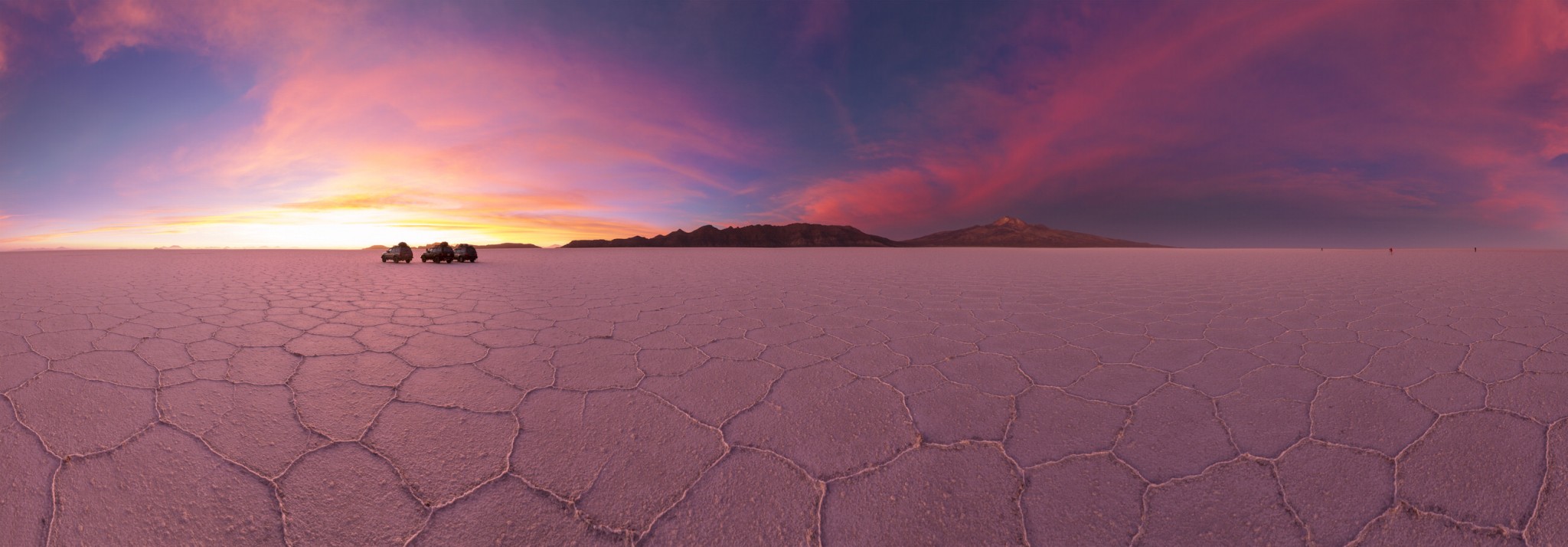
Getting There
Bolivia is a landlocked nation with La Paz being its third largest city. If arriving in Bolivia via another country, you will most likely fly into La Paz first. Uyuni however, is the closest city to the Salar de Uyuni , and is the starting point for most journeys to the salt flats. You can reach Uyuni by plane, train, or bus. You can also begin your salt flats tour directly from La Paz, Tupiza, or Sucre (more on these tour options later).
Bus tickets can be booked online or bought in person in your respective starting city. In general, most major cities in Bolivia offer bus routes to Uyuni, though they are not always direct. You can book online at Tickets Bolivia for some of the most popular routes.
Ticket pricing varies on the distance travelled and bus type/class. Some buses include toilets, heating, snacks, fully-reclining seats (“full cama”), or half-reclining seats (“semi cama”). Buses without toilets do make pitstops. Bus companies have varying reputations, with some notoriously worse than others. It is worth paying for a better bus line that has good reviews from travellers (check TripAdvisor forums and reviews).
How to get to Uyuni from La Paz
From La Paz you can reach Uyuni by flight, train, or bus . The train option involves a bus to Oruro, then a transfer to a train. Information on scheduling and how to obtain tickets is provided below.
If you want to start a tour directly from La Paz to the Uyuni salt flats, you can browse tours with reviews and book online with immediate confirmation on Viator and GetYourGuide . Otherwise, you'll want to take a bus, train or flight to Uyuni first and depart on your tour from there.
Flight scheduling & prices
There are daily local flights from La Paz to Uyuni. I've done both the flight and the bus option from La Paz to reach Uyuni. Flying is more comfortable and quicker, though bussing is cheaper.
Airline Amazonas and Boliviano de Aviacion are the main airlines that fly between La Paz and Uyuni. Airline Amazonas operates flights daily from La Paz to Uyuni departing at 7:15AM (arriving 8:00AM) and 7:30PM (arriving 8:15PM). Prices start around $115+ USD . Boliviano de Aviacion operates flights daily from La Paz to Uyuni departing at 8:05AM (arrive 9:05AM) and 7:10PM (arrive 8:10PM). Prices start around $170+ USD .
Pricing fluctuates greatly by supply and demand. It's generally recommended to book in advance to secure a good price, as this route is fairly limited.
When booking, give yourself wiggle room between your tour start time and your flight . If possible, fly into Uyuni the night before to be safe, or take an early morning flight. Flight delays and cancellations are not uncommon.
To book the cheapest flight price, we recommend selecting “Whole Month” in Skyscanner to visualize the cheapest dates to fly. Be sure to also check our flight hacks here and our guide to South American budget airlines and flight passes .
Bus tickets
To buy a bus ticket, book online or visit the bus station in La Paz on Uruguay Avenue. Both daytime and overnight buses depart from La Paz to Uyuni, which are ~10.5 hours (we did the overnight bus on our first trip). It is a typical South American bus experience in that it's a bit cramped and long, but not unbearable, and eliminates accommodation costs for one night.
Buses operate daily from La Paz to Uyuni, except during holidays or transit strikes (more on that below). Day time trips depart at 8:30AM and arrive in Uyuni at 9:20PM. Overnight buses generally depart around 8 or 9:00PM and arrive in Uyuni between 6-7:30AM the next day. Some routes are direct while others make transfers in Oruro or Potosi. Prices range from $14-$36 USD . All tourists must also pay a terminal tax (30 US cents) inside the bus terminal.
A note on buses: transit strikes and holidays (such as Christmas, Easter, and Carnaval) can result in bus station closures. Plan accordingly and when in doubt, ask hotel staff if there are anticipated strikes or holidays.
How to get to Uyuni from Oruro
Oruro has daily buses and trains to Uyuni, both of which can be booked online . The train is 7 hours long and departs on Sundays and Wednesdays only. Buses depart daily and involve a transfer via La Paz or Potosi.
How to get to Uyuni from Sucre
From Sucre you can take a bus to Uyuni ( $11 USD, 8-9 hours, book online ) and begin your tour in Uyuni. Alternatively, you can book a one day trip to the salt flats , which returns back to Sucre ( $150 USD ).
How to get to Uyuni from Tupiza
If departing your salt flats tour from Tupiza, you can get there from La Paz or other major cities, though not directly. From La Paz, for instance, you must take a bus to Sucre or Oruro first, then bus or train onwards to Tupiza.
Buses from La Paz run daily to Oruro ( $3.65 USD , ~4 hours, book online ) and Sucre ( $26 USD , 12 hours direct, book online ). You must then transfer onwards from either of these cities to Tupiza. Most of these routes run daily. Tours starting in Tupiza can be booked online .
Where to Stay
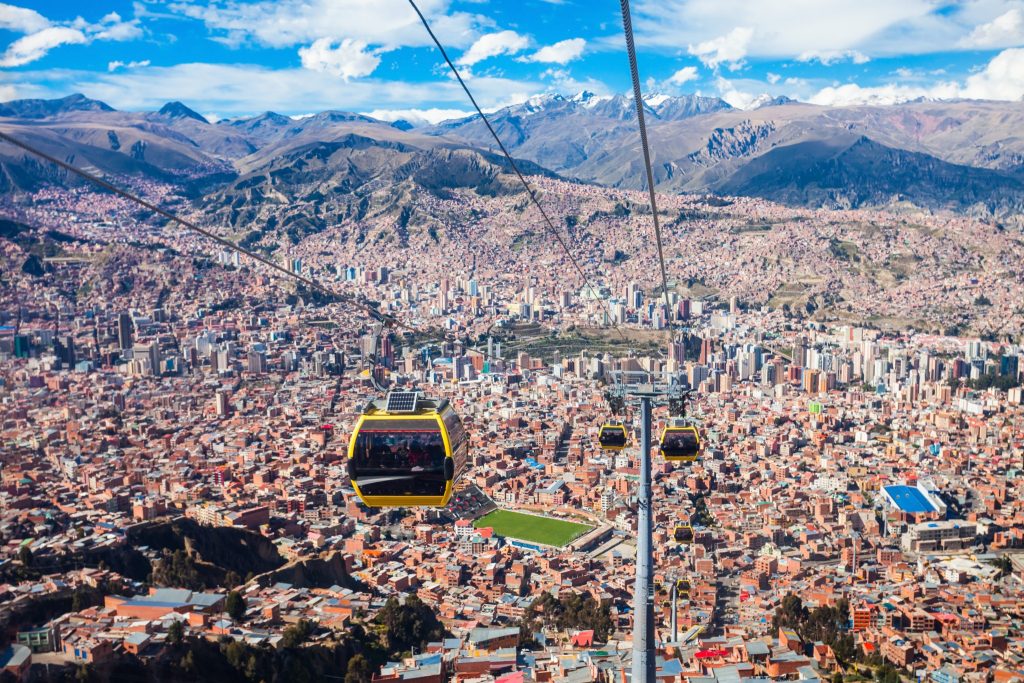
La Paz is a stimulating city that is cradled by snow-capped mountains. It is packed with vibrant markets, colourful colonial buildings, and plenty of activities. A visit here should include the city cable car , the colourful Valle de la Luna , the cholitas wrestling show (bizarre and truly unique!), and the world's most dangerous bike tour if you're feeling daring.
Due to Bolivia being the poorest nation in South America, your dollar will go quite far here. A private hotel room will set you back ~$23+ USD/night , while hostel dorms start at as little as $8+ USD per night . Some neighbourhoods in La Paz are noticeably safer than others. Check hotel reviews for visitor input on a hotel's location and neighbourhood vibes.
Sol Andino Hostal
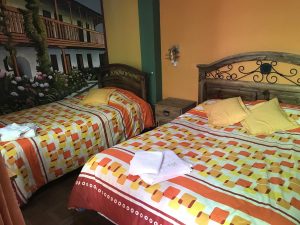
On my last visit to La Paz, I stayed at Sol Andino Hostal in the city. For $41 USD/night, my friend and I had a private room with an ensuite bathroom (you can get cheaper but we chose to treat ourselves to decent digs). Sol Andino is clean, includes a decent breakfast, is centrally located, and has helpful staff. The front desk is open 24-hours, so if you need to leave for an early flight for Uyuni (as we did), this is ideal for getting help ordering a taxi (which should be phoned, not flagged down in the street).
Location : Aroma #6 zona Rosario, Downtown La Paz, 9999 Price : $36+ USD per night ( compare prices across booking sites )
Residencial Latino
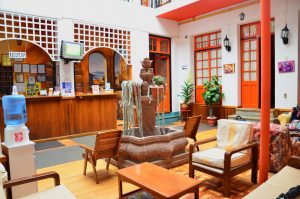
We stayed at the Residencial Latino on our first visit to La Paz. It has a bright courtyard, simple breakfast (included), helpful desk staff, and is also a good location for exploring the city. This is a cheaper downtown option that still has all the basics plus useful desk staff.
Location : Calle Junin n. 857, 9999 La Paz, Bolivia Price : Prices start at $17 USD/night (single room with shared bathroom), up to $58 USD/night for a triple room with an ensuite. ( compare prices across booking sites )
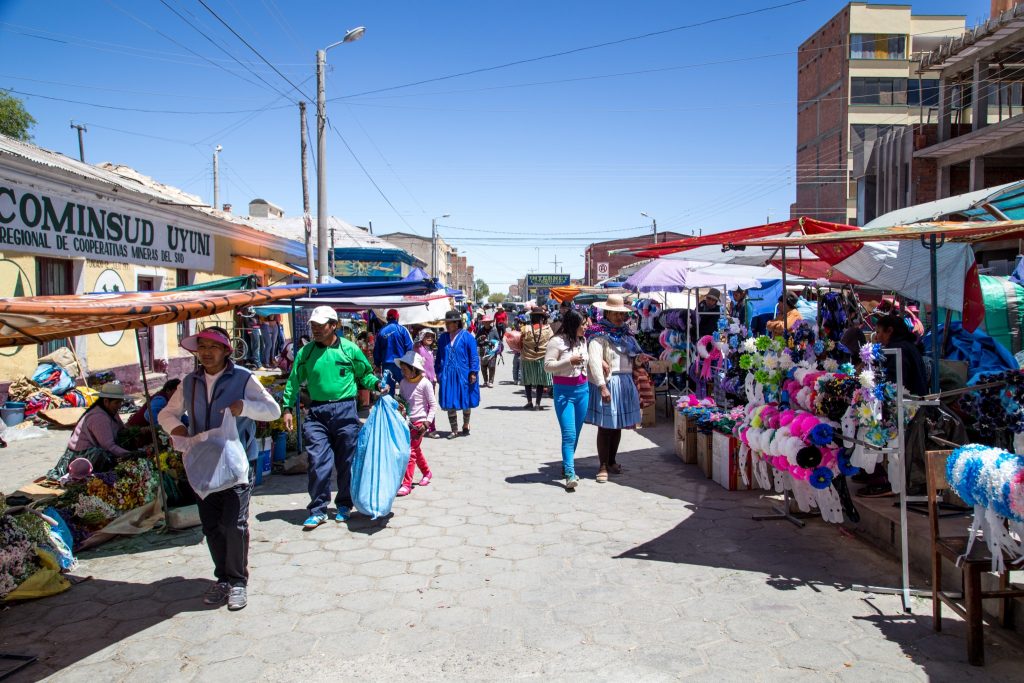
Uyuni is a small city located in the southwest of Bolivia. It's the closest starting point for a trip to the Salar de Uyuni . There are a few attractions including a street market, a small archeologic museum, and the nearby train cemetery. To avoid rushing on arrival, it's not a bad idea to spend a day or two in Uyuni before taking off for your tour if departing from here.
Hostal Castillo de Liliana
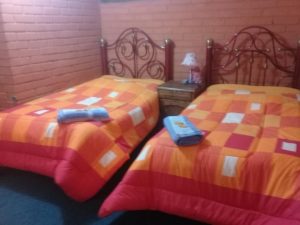
We stayed overnight at the Hostal Castillo de Liliana on our first visit to the salt flats (the second time we booked a flight from La Paz and departed on the same day). This hostel is simple, clean, cheap, and has a hearty breakfast. Uyuni is a small town, so most accommodations are “central”, including Liliana. It is possible to stay in fancier digs, including one of the nearby salt hotels , but for us this was a perfect budget option. If your wallet can't afford the overnight stay at a salt hotel, you can at least have dinner there .
Location : Av Colon entre Bolivar y Avaroa No 148, Uyuni, Bolivia Price : $18+ USD/night for a single room with a private bathroom
Oruro, Sucre, and Tupiza
We haven't personally departed to Uyuni from these cities, so we don't have firsthand recommendations for hotels and hostels here. That said, if you search on HotelsCombined , you will see a huge number of accommodation options across all major booking sites, so you can easily see the best prices and reviews all from one website.
Okay, now that you've got the basics, here's the rest of the steps you need to know on how to plan a trip to Bolivia's Salar de Uyuni!
How to visit the Salar de Uyuni
1. choose the best time to go to the salar de uyuni.
Before booking a tour, you need to decide which time of year you want to visit. What is considered the best time to visit the Salar de Uyuni really depends on what you want to see , as each season offers different visuals. One thing's for certain – the scenery here is breathtaking all year round .
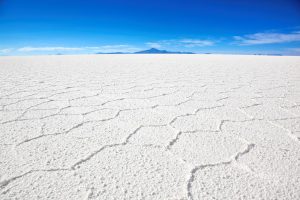
Dry Season (May to October)
- Salt flats have dry, geometric shapes spanning for miles
- Shorter but sunnier days and generally better road conditions
- Access to Cactus Island (Isla Incahuasi) or Fish Island (Isla del Pescado) is possible. These are two small, hilly islands with tall cacti and rock formations
- Daytime temperatures range from 15 to 27°C (60 – 80ºF)
- Colder nights expected, especially in June and July with temps as low as 0° to – 15° C (32° – 5° F)
- Generally less humid and more pleasant temps in the lowlands
- In August and September, farmers burn-off to clear overgrown forests which can produce a thick smoke in the area
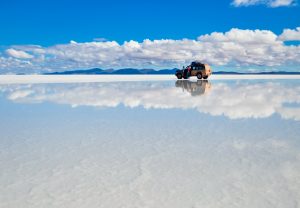
Rainy Season (November to March)
- A few centimetres to several inches of rain creates an incredibly perfect mirror-like surface stretching into the horizon
- Daytime temps range from 15 to 27°C (60 – 80ºF), with cooler temps at night. The east is warm and humid, the west is dryer, and the south is milder
- Access to Cactus Island ( Isla Incahuasi) and Fish Island (Isla del Pescado) is not possible due to water levels
- Days are cloudier and roads are muddier
- Countryside is greener and full of native plants and flowers
- Certain times of the rainy season generally get less tourists
2. Pick a tour duration
Salt flats tours are run as a one day or multi-day visits. Single day trips typically visit the salt flats, salt hotel, and train cemetery. Multi-day tours include this, plus travel further through Bolivia's landscapes, including highlights like Laguna Colorada and the Salvador Dali Desert.
Multi-day tours are highly recommended, as the landscapes and wildlife in this region are outstanding . Desert dunes, apple-red and neon turquoise lakes, wild flamingoes, volcanoes, hot springs, and adorable llamas are just some of what's to be seen. In my opinion, if you're already in this corner of the world, you'd be remiss not to see more of Bolivia's astounding scenery.
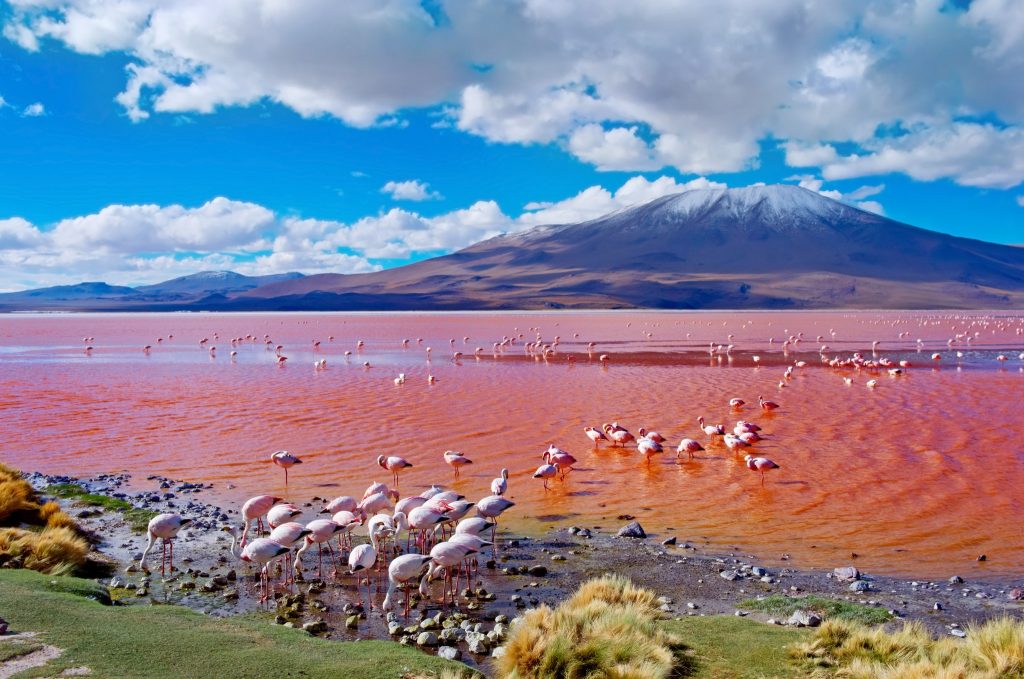
Both day and multi-day tours to the salt flats are round-trip from their departure point. However, most of the multi-day tours that end near the Chilean border allow passengers to connect onwards to San Pedro de Atacama, Chile by bus. I've done this on both my visits, and it's a great way to reduce transport costs between countries (plus Atacama is definitely worth visiting). If you wish to transfer onwards to Chile, be sure to arrange this with the tour company beforehand.
3. Choose a tour departure point & budget
Most tours operate directly out of Uyuni , though tours can be arranged from La Paz , Sucre , and Tupiza . Uyuni is the cheapest departure point for visiting the salt flats, with day tours being the least expensive option.
Tour prices vary based on tour group size, duration, company reputation, vehicle quality, and accommodation standards. While larger tour groups are cheaper, one disadvantage is that you must always wait for all of your group's vehicles. This can cause significant delays if a car in your group breaks down. Accommodation also greatly affects tour cost, with pricing varying based on whether you choose basic (dormitory style hostels), mid-range (heated private room hotels), or high-end digs (such as the salt hotels).
Tours from Uyuni
Uyuni has the most variety of tours, including one day, three day, and four day trips. Day tours are abundant, including sunrise tours with breakfast, stargazing tours (highly recommended in the wet season as the star reflect on the ground water), sunset tours with wine, bike tours, and more. Day tours start from $75 USD, multi-day tours start from $149 USD.
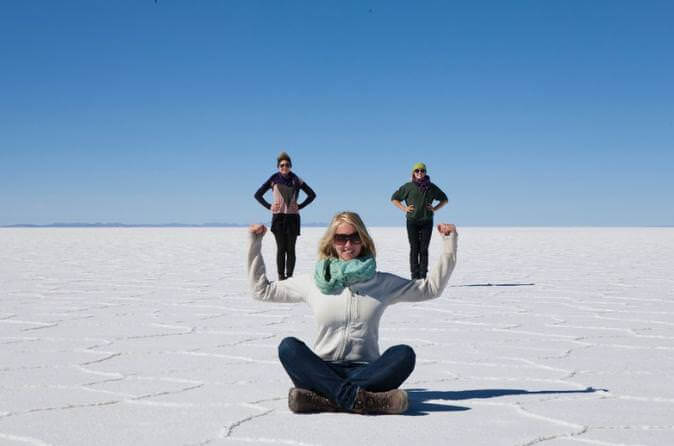
Uyuni Salt Flats Full Day Tour ($109 USD)
This tour is operated by Red Planet Expeditions. We used this company for our tour and highly recommend them!
The main difference between these 3-day tours is the accommodation. The first 2 tours are in basic hostels with dormitory style sleeping, while the last tour gives you private rooms in heated hotels.
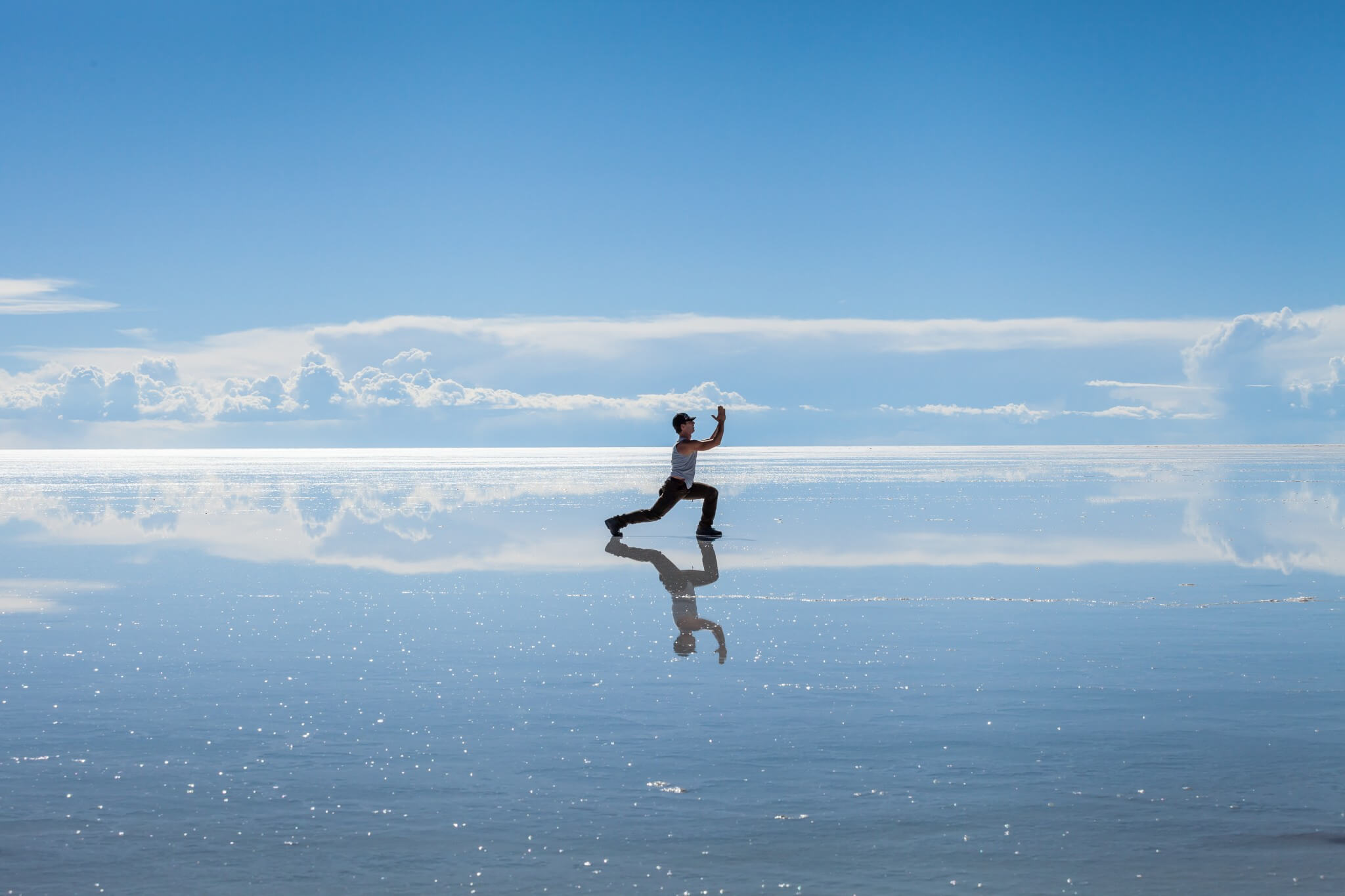
3-Day Salar de Uyuni ($149 USD)
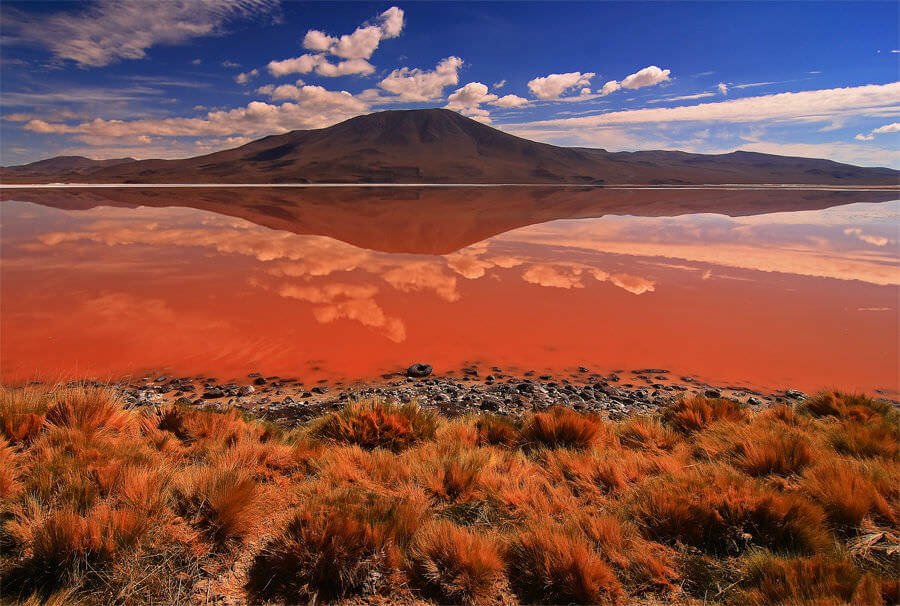
3-Day Salt Flats and Colored Lagoons Tour from Uyuni ($270 USD)
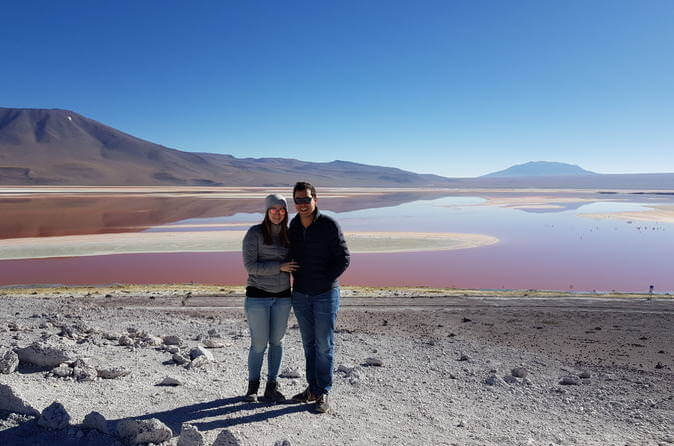
3-Day Salar de Uyuni and Laguna de Colores from Uyuni ($999 USD)
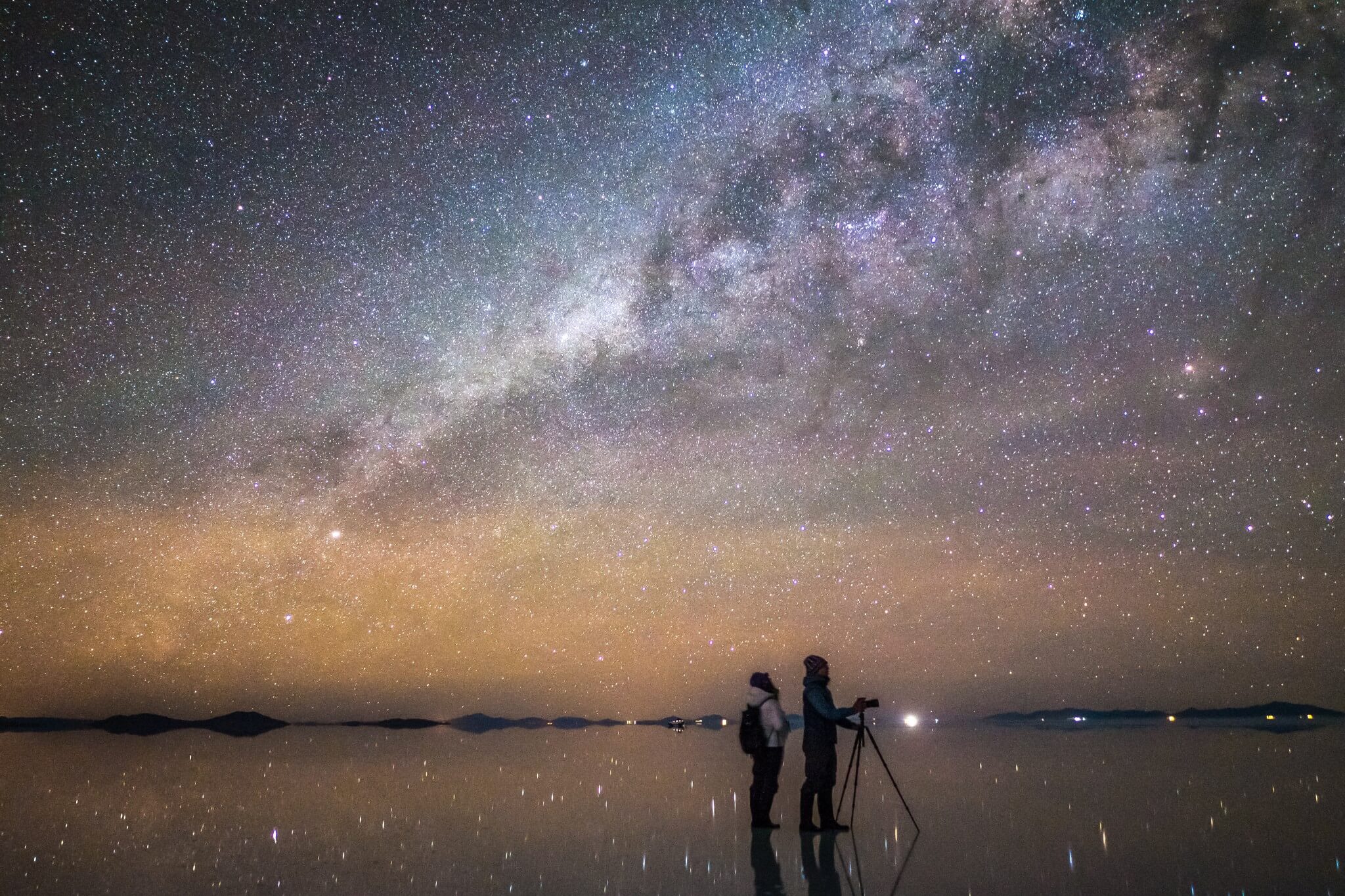
Tours from La Paz
Day tours can be done from La Paz with flights or buses included (starting at $200 USD). Two day tours with flights start at $. Both of these options are quite packed and pricey. Tours from La Paz tend to include a visit to the salt flats, salt hotel, and train cemetery.
One Day (Bus or Flight)
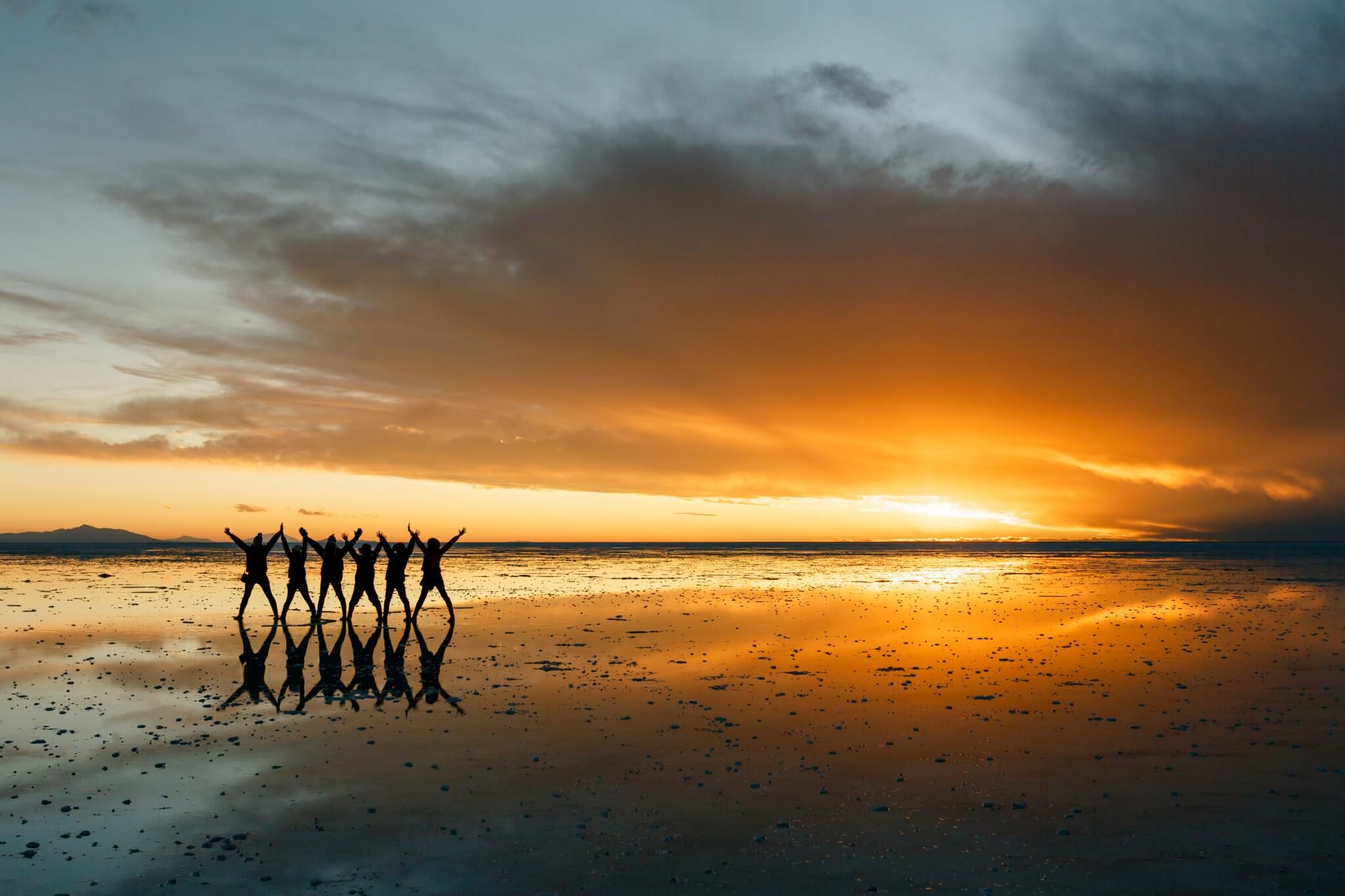
- Visit to Uyuni Salt Flats from La Paz Bolivia by Bus ($200 USD)
- Private Day Trip from La Paz to Uyuni Salt Flats ($699 USD)
- Uyuni Salt Flats Luxury Tour from La Paz ($799 USD)
- Uyuni Salt Flats Day Trip by Air from La Paz ($891 USD)
Two Day (Flight)
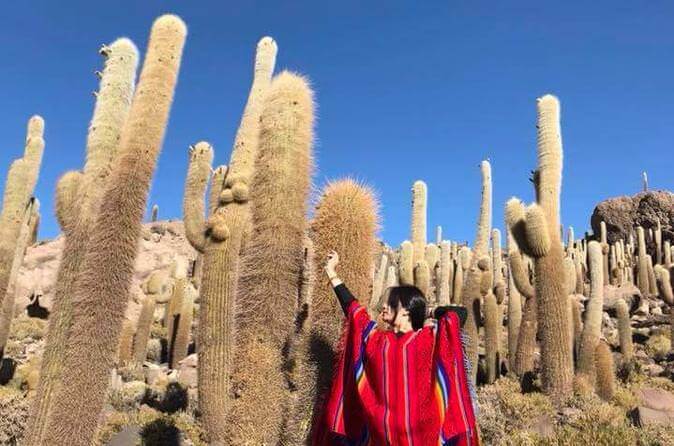
2-Day Uyuni Salt Flat with Overnight in Hotel VIP Including Flight from La Paz ($890 USD)
Three day (flight).
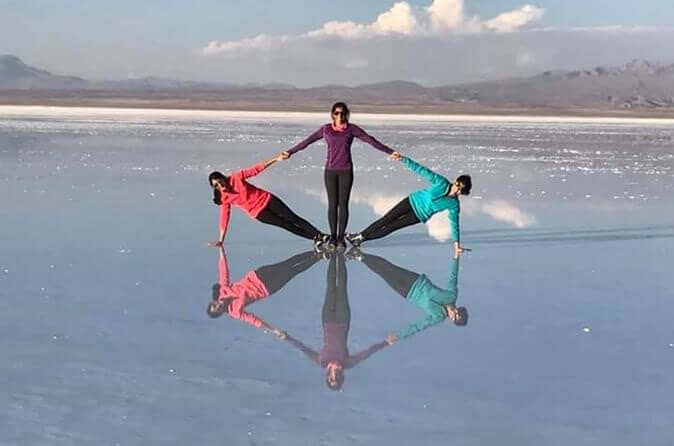
Luxury Uyuni Salt Flats 3D 2N Tour From La Paz by Flight ($1200 USD)
Four day (bus): la paz > uyuni > atacama.
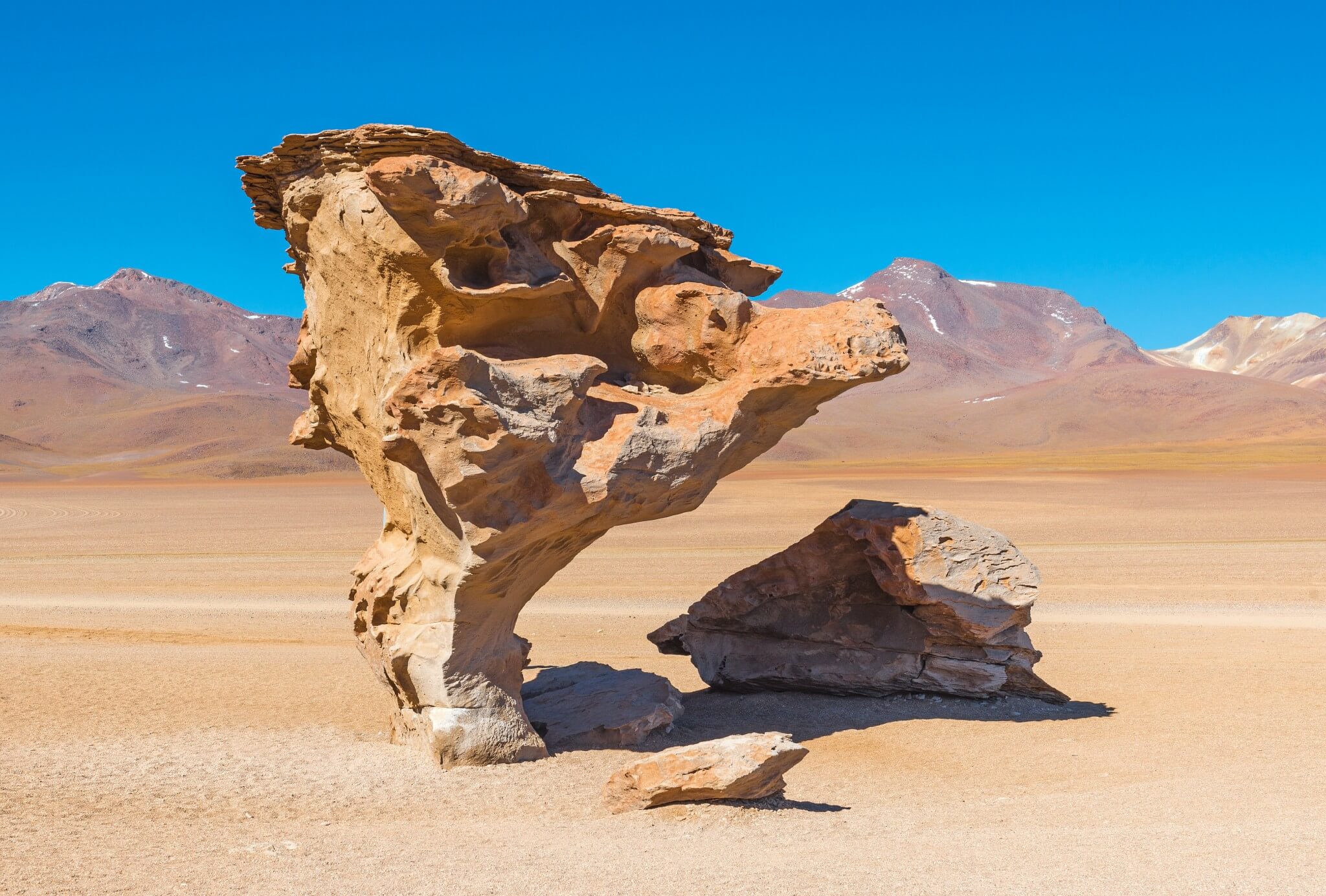
4 Day Uyuni Salt Flats from La Paz to Atacama in Chile ($438 USD)
If travelling through South America, this is a great way to get a tour, accommodation, and transportation all in one package. The Atacama Desert in Chile is well worth a visit, and is a good departure point for heading further south in Chile towards Santiago.
Five Day (Bus)
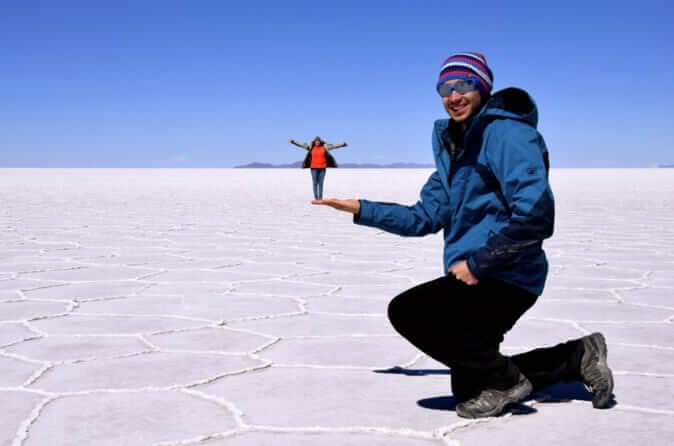
5 Day Uyuni Salt Flats and Desert Adventure from La Paz ($497 USD)
Tours from sucre.
A less common approach is to visit the salt flats from Sucre as a round-trip. Disclaimer: this is a packed trip. It involves an overnight bus from Sucre to Uyuni and visit the salt flats, salt hotel, and train cemetery the following day. At the end of the day tour you then take another overnight bus returning back to Sucre the next morning.
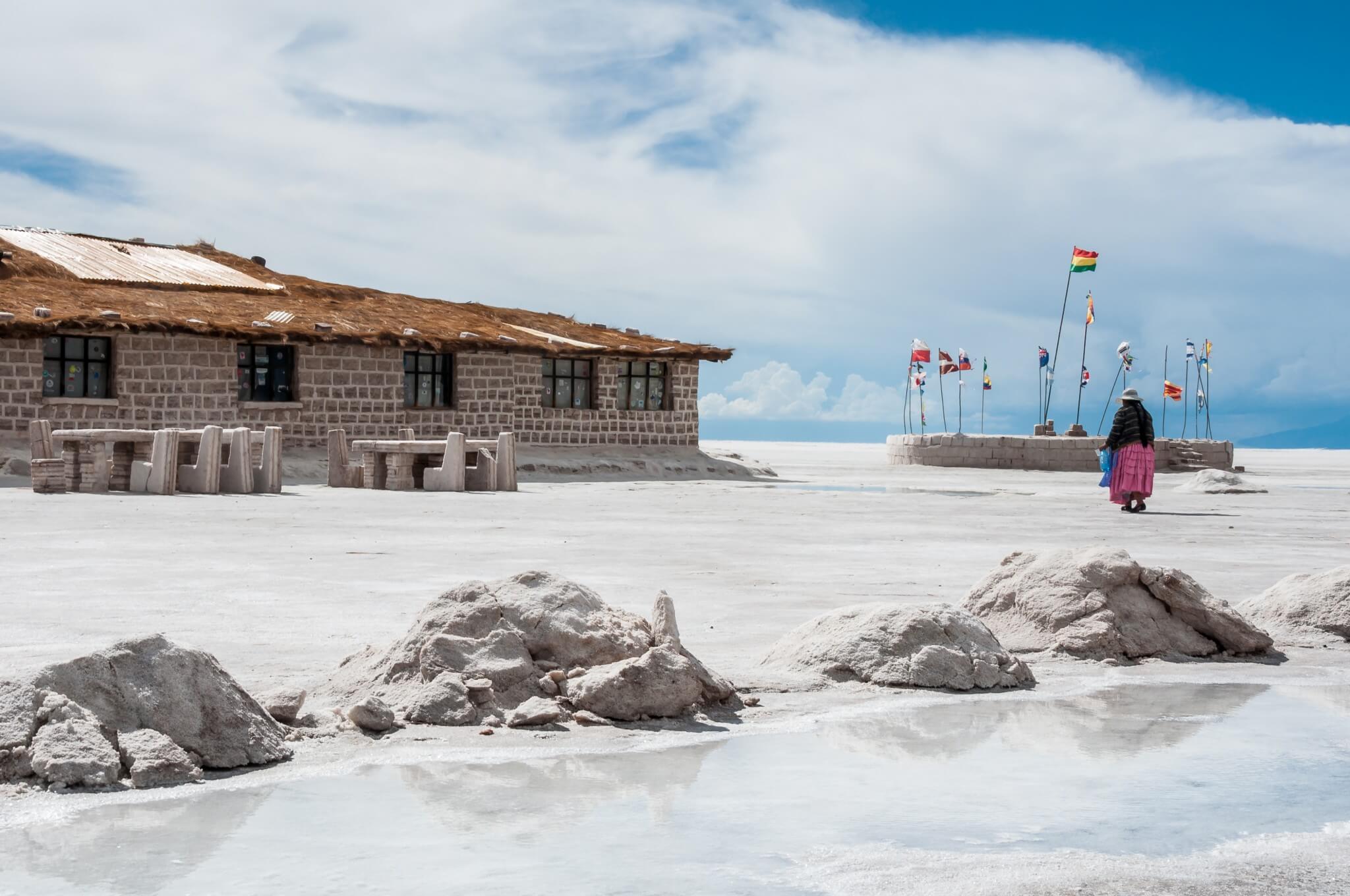
Visit to Uyuni Salt Flats from Sucre by Bus ($150 USD)
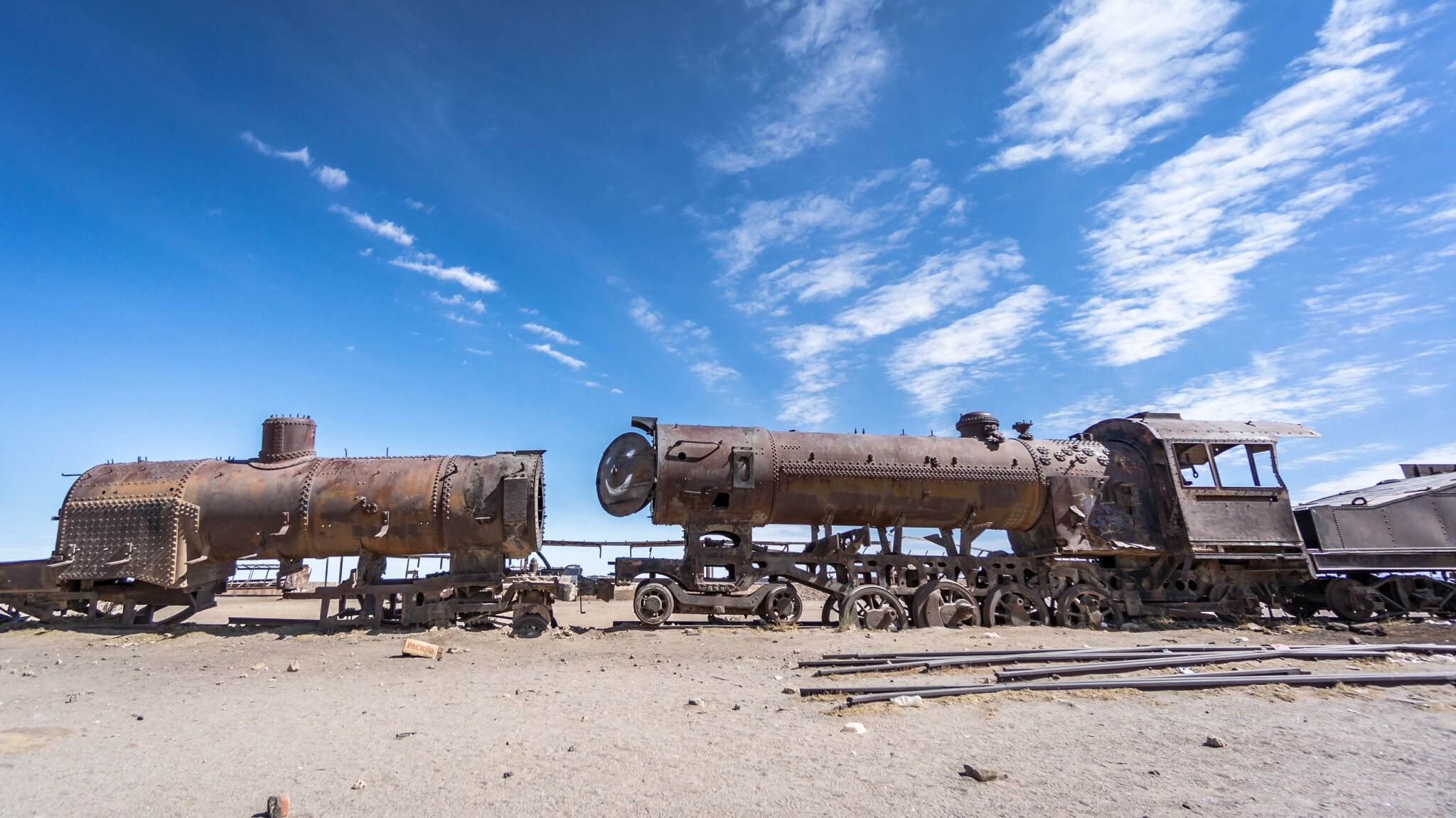
Full-Day Tour from Sucre to Potosi and Uyuni ($227 USD)
Tours from tupiza.
Visiting the Salar de Uyuni on a tour from Tupiza is the most off-the-beaten track approach. Far less tourists pass through Tupiza, and the actual tour route is different since it starts from the south. There are four-day tours here that pass through the typical highlights of the multi-day tours from Uyuni, only in the reverse order.
3. Choose a reputable tour company
Not all tour companies here are created equal. Some run substandard trips, with poor accommodation and vehicles that are prone to breakdowns. It's wise to book with companies that have recent positive traveller reviews. If booking with Viator or GetYourGuide , there are reviews of each tour available. Otherwise, TripAdvisor is a great hub for this, as are its discussion forums.
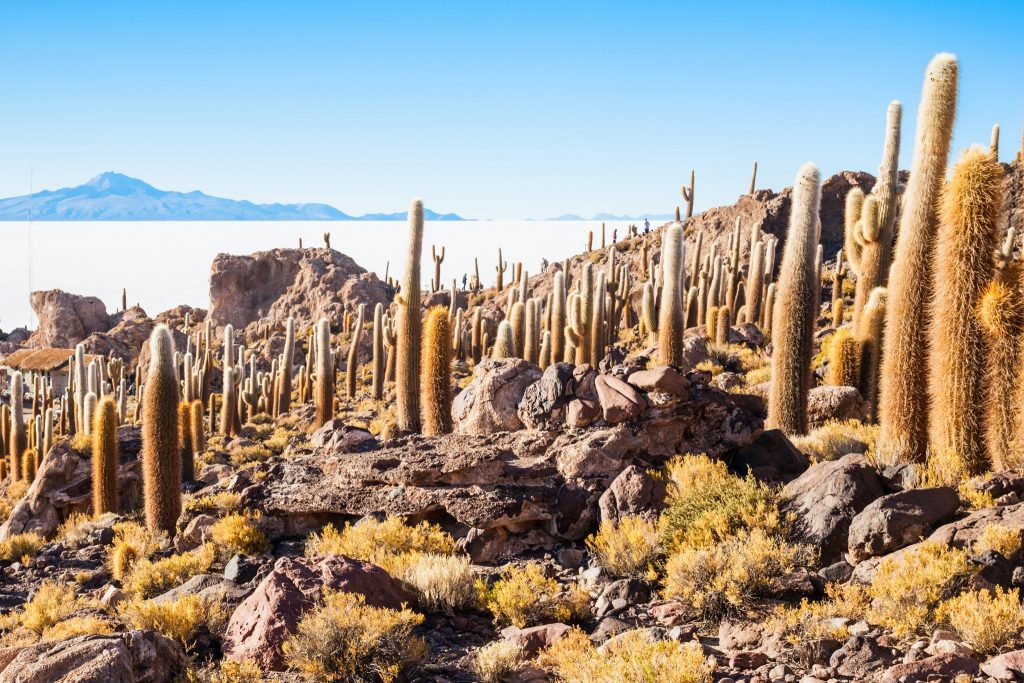
Isla del Pescado (Fish Island)
4. Know what's included in your tour
Day tours generally visit the same sites – the salt flats, salt hotel, and the train cemetery. That being said, there are variations, so be sure to understand what's included. This cannot be stressed enough for multi-day tours, where accommodation, food standards, and tour highlights vary hugely from one package to the next. Traveller reviews (e.g. TripAdvisor ) are good for this, plus clarifying with the company itself.
An important note on language – some tours provide Spanish speaking guides only . Verify whether you will be provided with an English-speaking guide, and whether it's one guide per group or per vehicle (and if this matters to you). Personally, I've been on tours with one main guide and two vehicles. The guide took turns riding in our vehicles and I didn't mind.
Food & drink
Check beforehand which meals are included in your trip. Alcohol and snacks are typically not included in tours, so be sure to pack some as you'll generally be unable to buy these along the way. If you have dietary restrictions or allergies, sort this before your tour.
Accommodation
Know what to expect for your accommodation by asking in advance. Cheaper tours typically provide more basic accommodation. If you want more luxurious digs, such a staying in the salt hotels (pictured below), this will cost more. Ask before booking.
Tour highlights
Each tour covers different scenic highlights, though many are generally included in every trip. For instance, most multi-day tours include a visit to Cactus Island in dry season, as well as Laguna Colorada, Tunupa Volcano, Laguna Verde, and the Colchini salt processing mine. If there are specific highlights you want to see, such as the Coquesa mummy caves, check whether that's covered in your package before reserving.

5. Book your tour
Tours can be booked online or in person in your respective departure city. While it can be cheaper to book in person, if there's a particular company and dates you're after, it's safer to book ahead to avoid disappointment. The more reputable companies book out in high season.
6. Pack appropriately
There are a few must-pack items for any visit to the Salar de Uyuni. Generally, tour companies will tell you what to bring, but we've included packing lists for the respective tour types below.
You may wish to research photo ideas beforehand, and decide on any props you may wish to bring. The ever-stretching flats provide creative opportunities for photos, and it's not a bad idea to do some Googling for inspiration.
- Layers of clothing
- Any props you may wish to use for photos
Multi-Day trip
- Everything needed for day trip plus …..
- LOTS more layers for nighttime (e.g. light gloves, leg warmers, warm hat, scarf)
- Alcohol if you wish to drink (you will not be able to buy on the way)
- Snacks (limited to no opportunities to buy along the way)
- Bathing suit & towel (likely visit to hot springs)
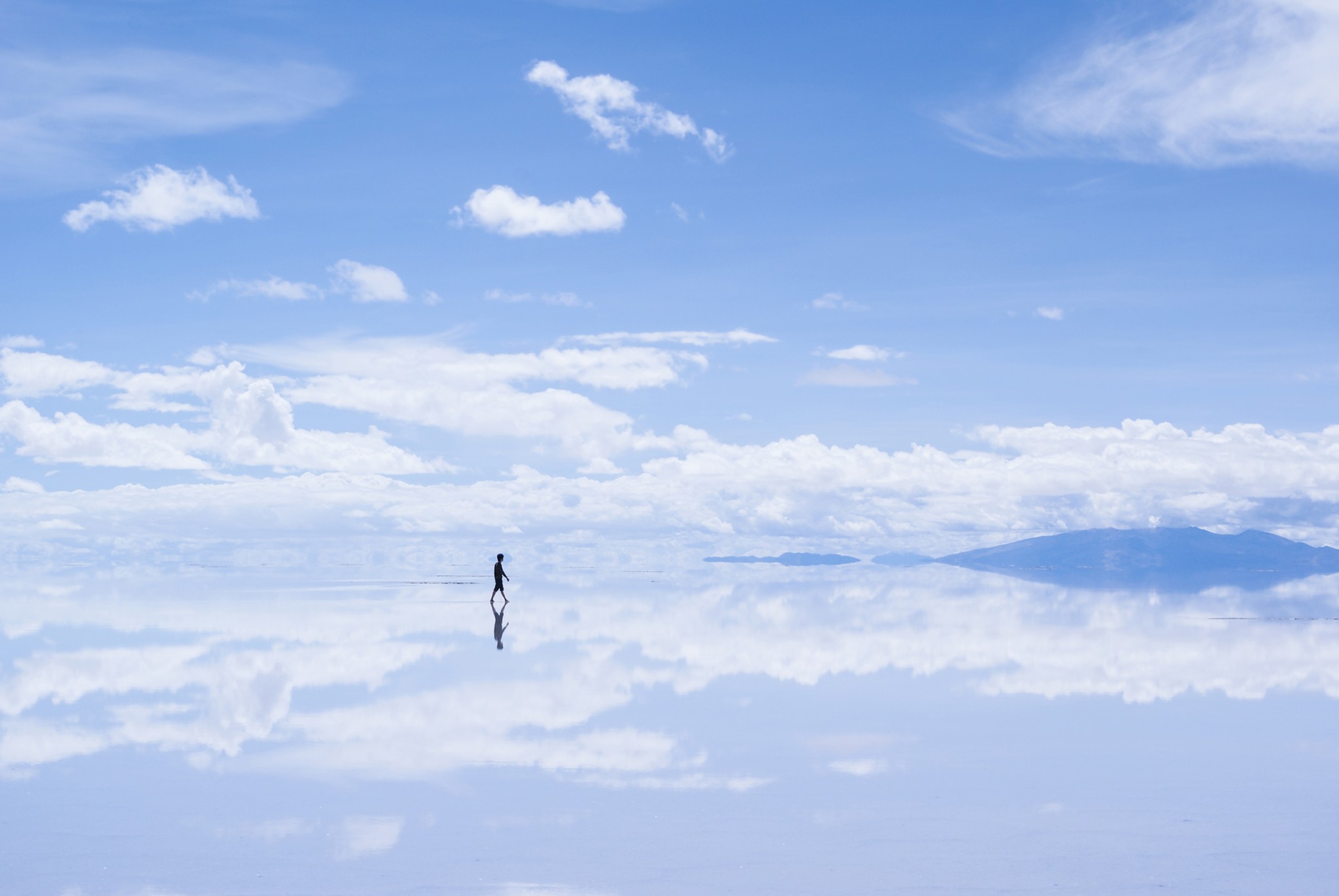
It's hard, if not impossible , to be disappointed by a trip to the Salar de Uyuni. Its otherworldly landscapes, altiplano wildlife, and remoteness are unique and astounding. If your bucket list has room for updating, I'd strongly recommend adding the salt flats!
The Thrifty Gist
- The Salar de Uyuni can be visited as one day or multi-day trip from Uyuni, La Paz, Tupiza, or Sucre
- Day tours are cheapest, but only include a visit to the salt flats themselves and not the rest of Bolivia's remote landscapes
- Most multi-day tours allow passengers to be dropped off at the Chilean border, saving transport costs and allowing travellers to continue onto the Atacama Desert
- Review what is included in your tour package, including meals, accommodation type, group size, and tour highlights to avoid disappointment3

Adventures in a Surreal Land
From $6,795
Call 1-800-368-2794 or contact us for any questions
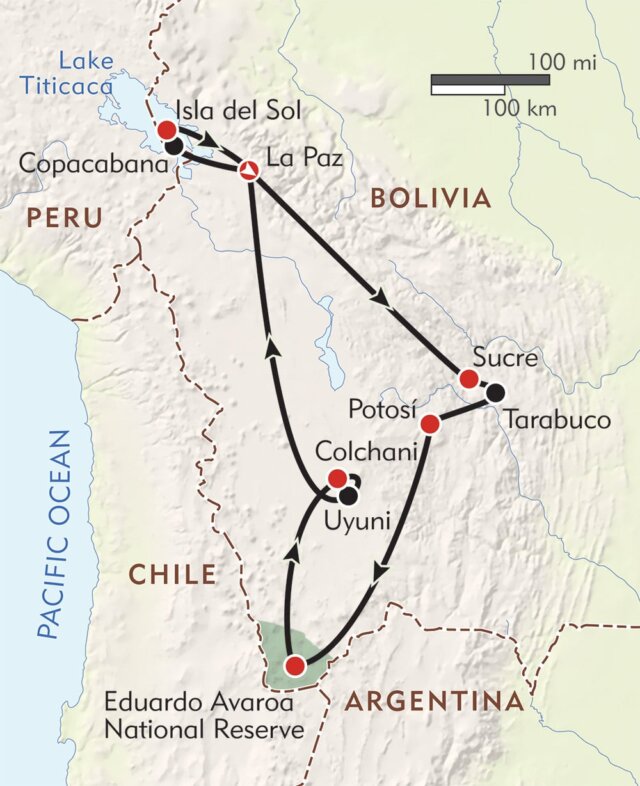
Arrive: La Paz, Bolivia
Depart: La Paz, Bolivia
- Discover the treasures of Tiwanaku, a pre-Inca masterpiece and World Heritage Site
- Hike to Inca temples on the mystical Isla del Sol in sacred Lake Titicaca
- Explore the dreamscapes of the Salar de Uyuni, overnight in a “salt” hotel
- Meet the artisan-weavers of Tarabuco, enjoy lunch on a family farm near Sucre

Dates & Pricing
Pricing below is per person and based on double occupancy. The earlier you book, the more choice you’ll have. WT also has the most generous cancellation and transfer policies in the industry, we make it easy if you change your mind. Have a small group of your own? Take over an existing date or choose your own. You’ll have your own private guide–and the adventure–all to yourselves!
Payment & Cancel Schedule
At time of reservation: $600 90 days prior to departure: Balance
Cancellation & Transfer Schedule
Up to 91 days prior to departure: No Charge! 61-90 days prior to departure: 25% of trip cost 46-60 days prior to departure: 50% of trip cost 45 days or less: 100% of trip cost
- Expert leadership of a Wilderness Travel Trip Leader and local guides
- Accommodations in hotels and lodges
- All meals included except 1 lunch and 2 dinners as indicated in Detailed Itinerary
- A glass of wine or beer with dinner
- All ground transportation and baggage handling from meeting until departure
- All activities as indicated in Detailed Itinerary
- Internal flights (La Paz/Uyuni and Sucre/La Paz)
Not Included
- Travel to and from the arrival and departure location as indicated in Detailed Itinerary
- Additional hotel nights outside the trip's scheduled dates
- Optional gratuities to Trip Leaders or staff
- Optional travel insurance
- Other expenses of a personal nature (some alcoholic beverages, laundry, etc.)
Accommodations
Scroll through our signature accommodations for this trip below. Although it is highly unlikely, we may make substitutions when necessary.
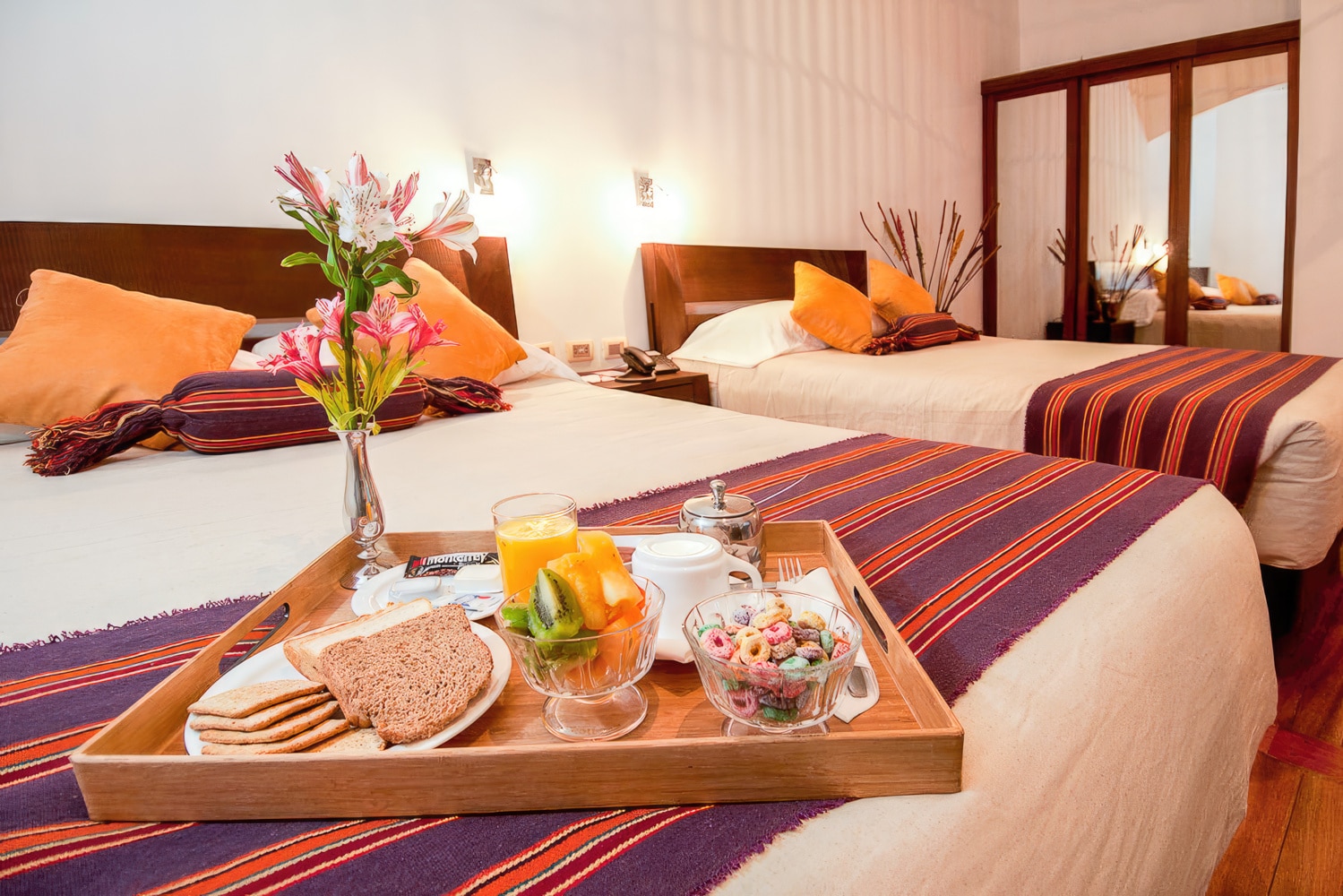
La Casona Hotel Boutique
La Paz, Bolivia
Days 1-2 (2 nights)
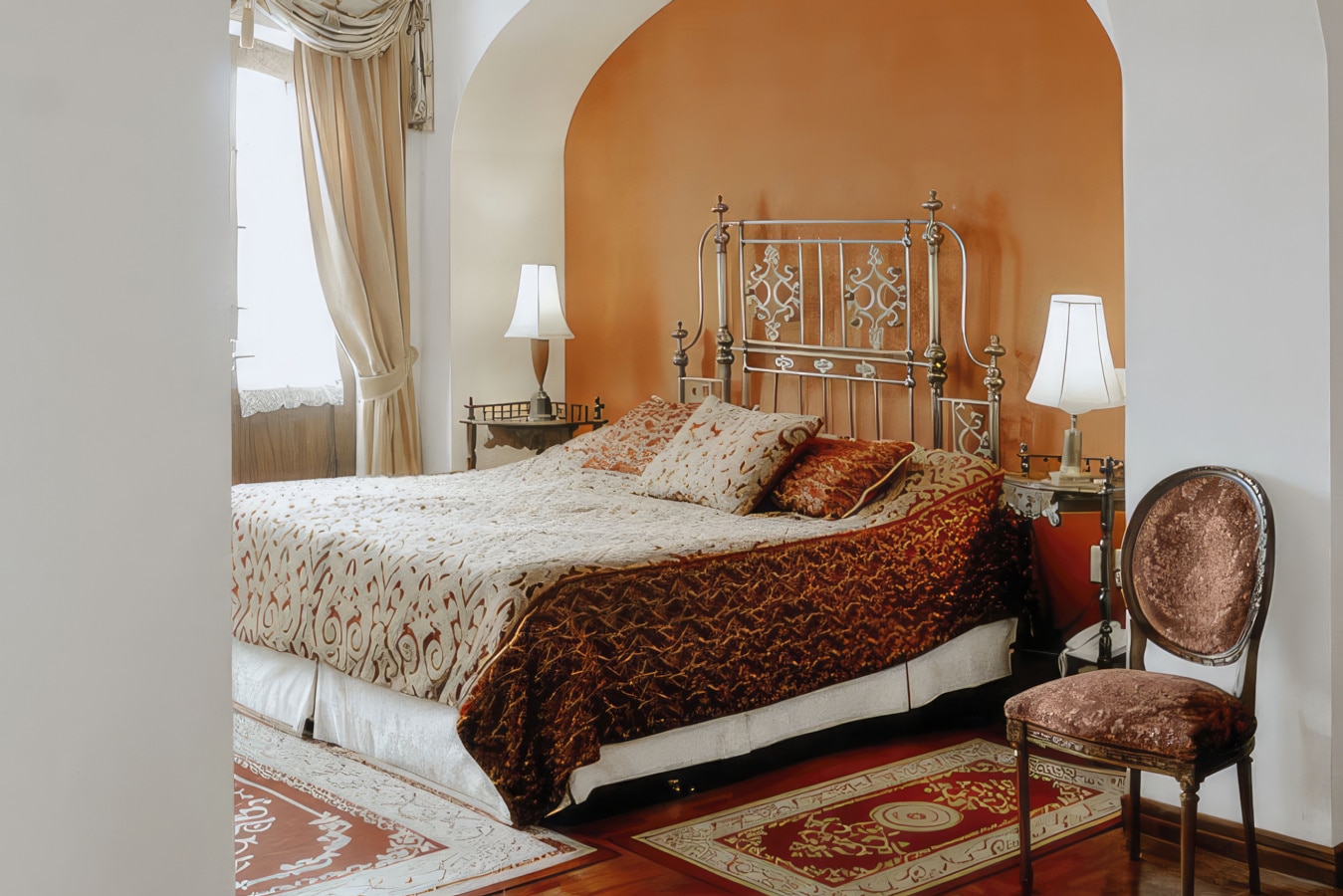
Hotel Parador Santa Maria La Real
Sucre, Bolivia
Days 3-4 (2 nights)
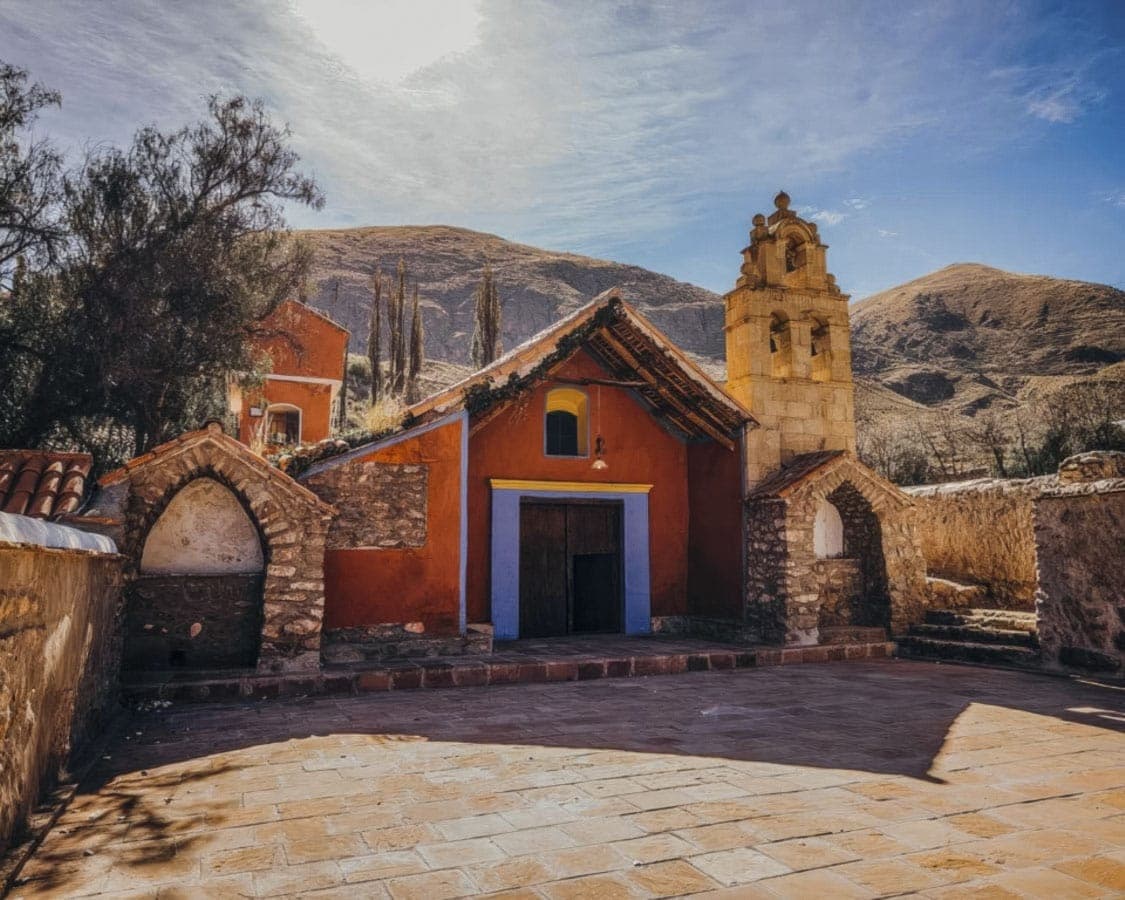
Hotel Museo Cayara
Potosi, Bolivia
Days 5-6 (2 nights)
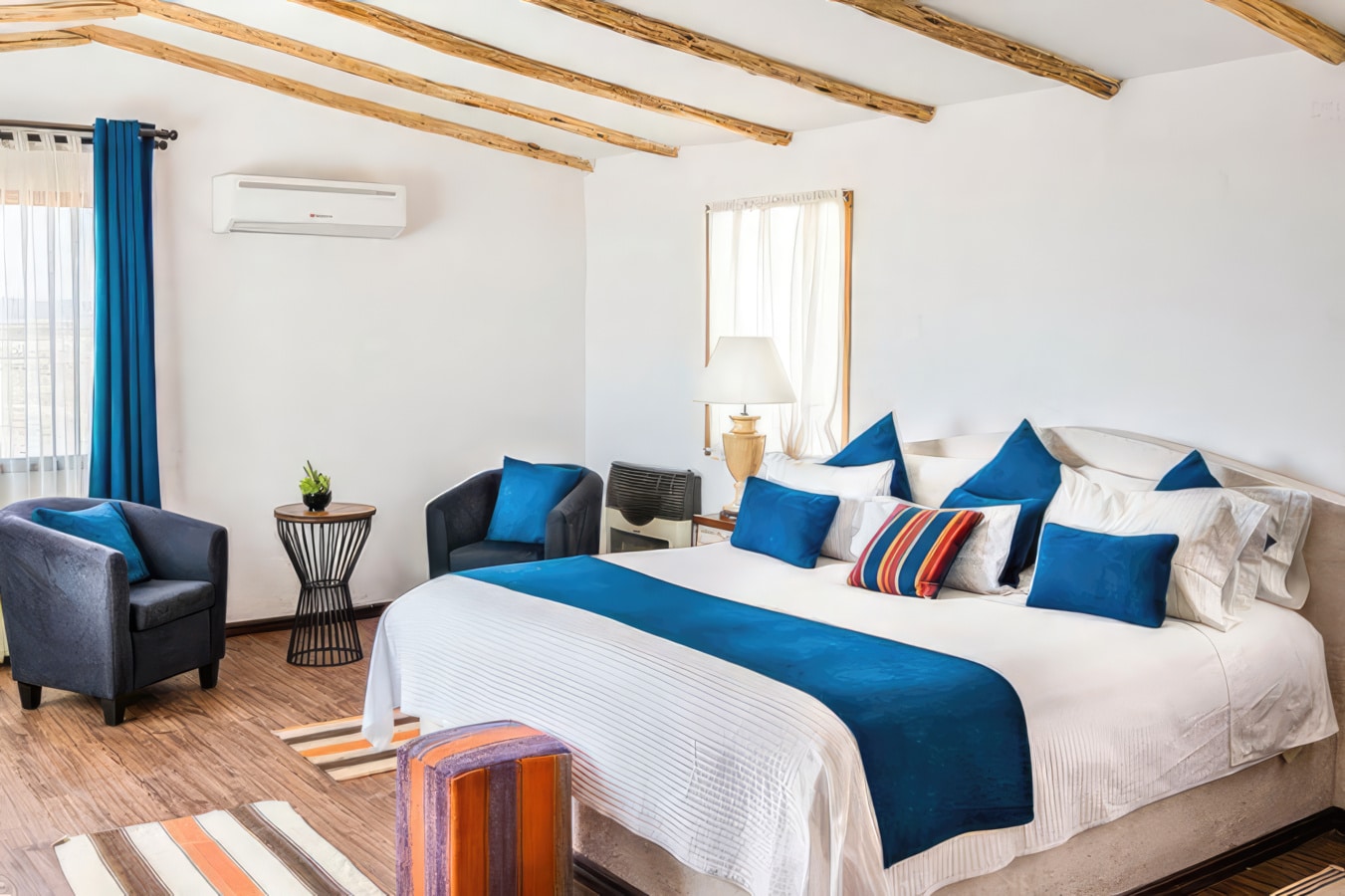
Hotel de Sal Luna Salada
Uyuni, Bolivia
Days 7-8 (2 nights)
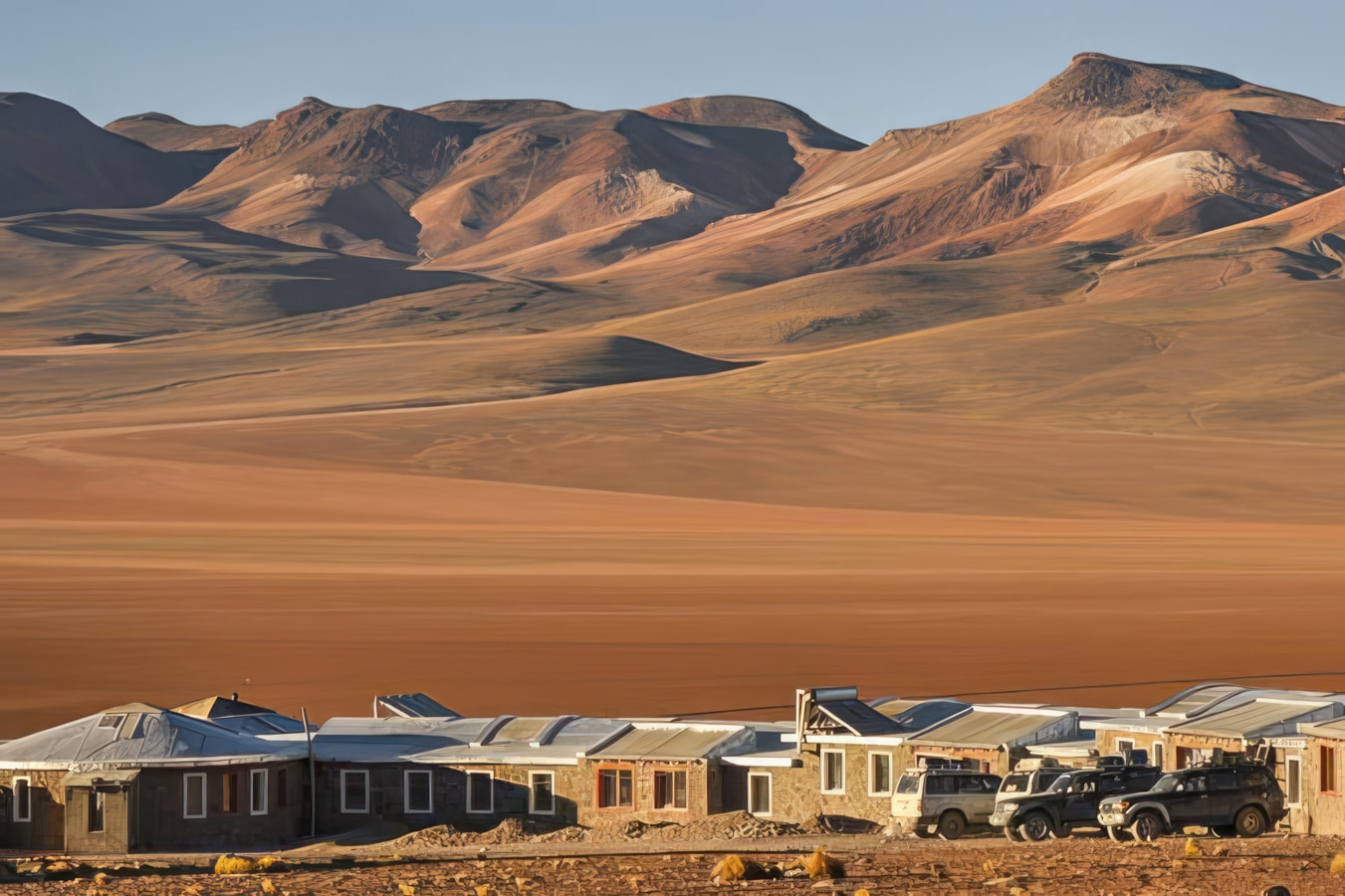
Hotel Tayka del Desierto
Calama, Bolivia
Day 9 (1 night)
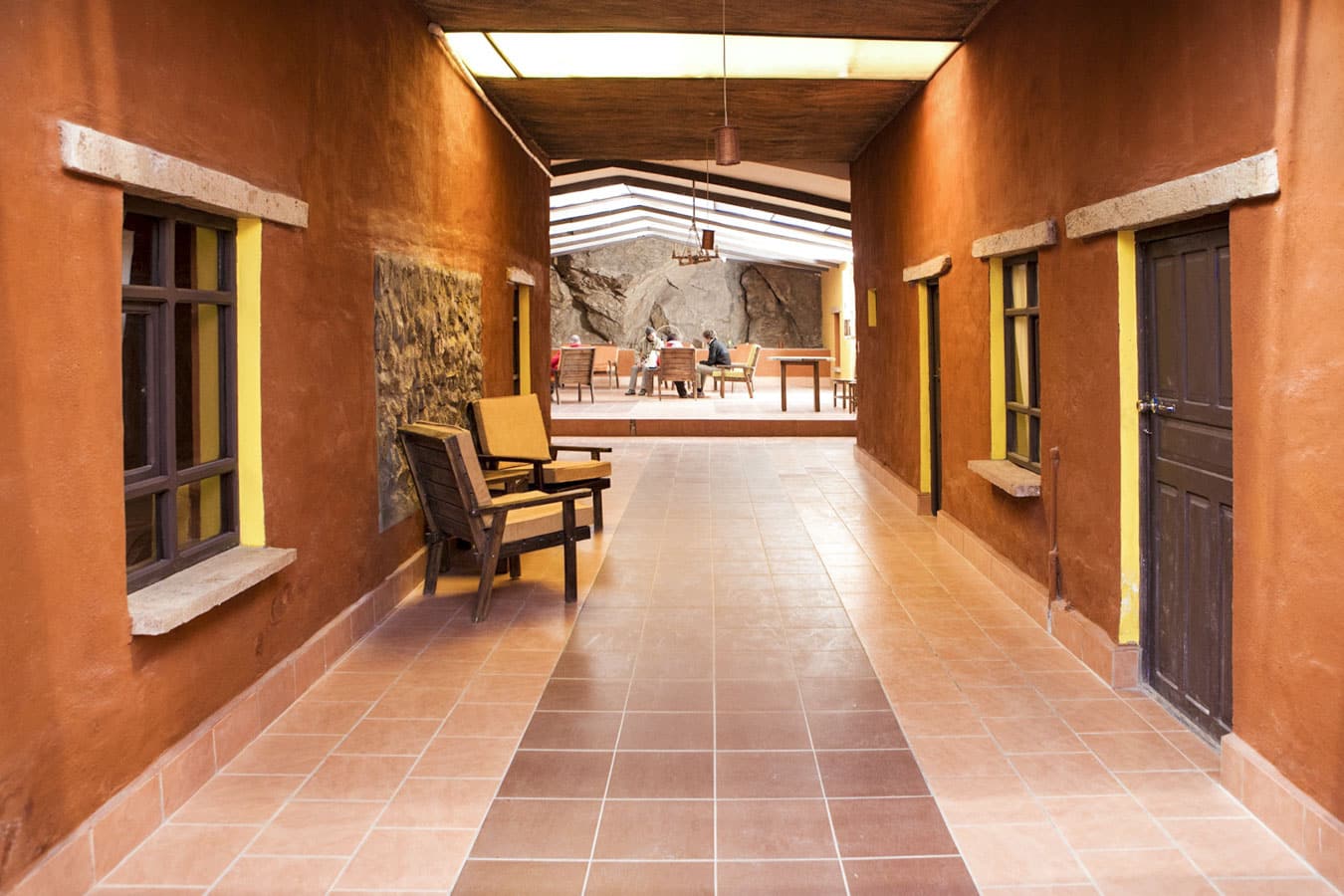
Hotel Jardines de Mallku Cueva
Villa Mar, Bolivia
Day 10 (1 night)
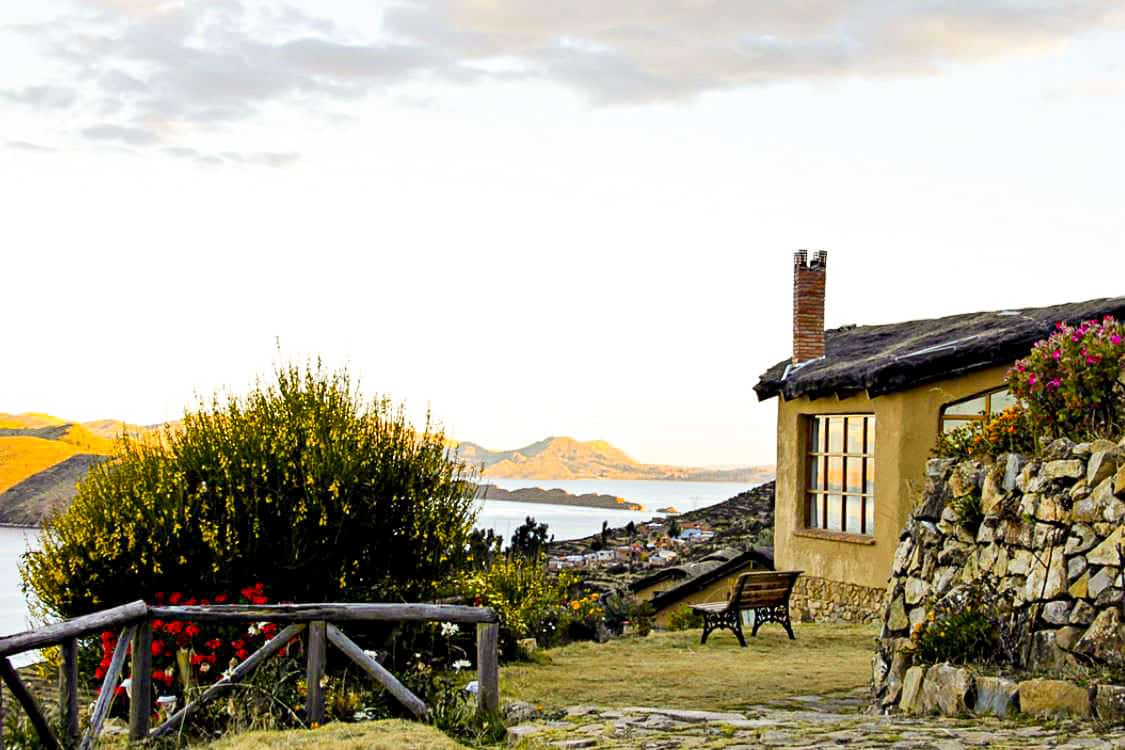
Ecolodge La Estancia
Isla del Sol, Bolivia
Days 11-12 (2 nights)
Day 13 (1 night)
Trip Leaders
Wilderness Travel Trip Leaders have a passion and a joy for creating an unforgettable journey. We are extremely proud of them and the incredible travel experiences they make possible. For more information, including client comments about them and which specific trips they will be leading, please click on their profiles below.
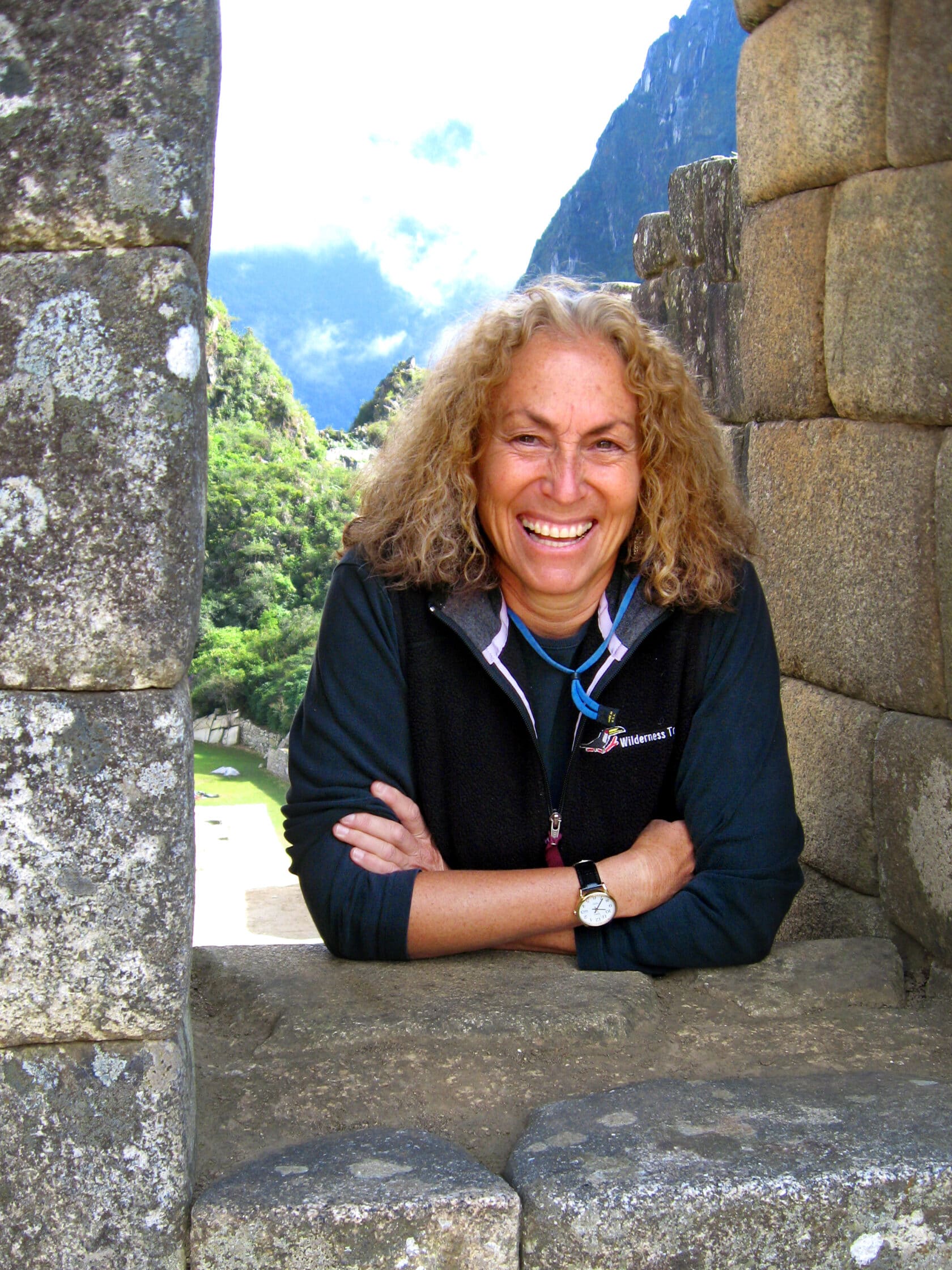
Andrea Heckman
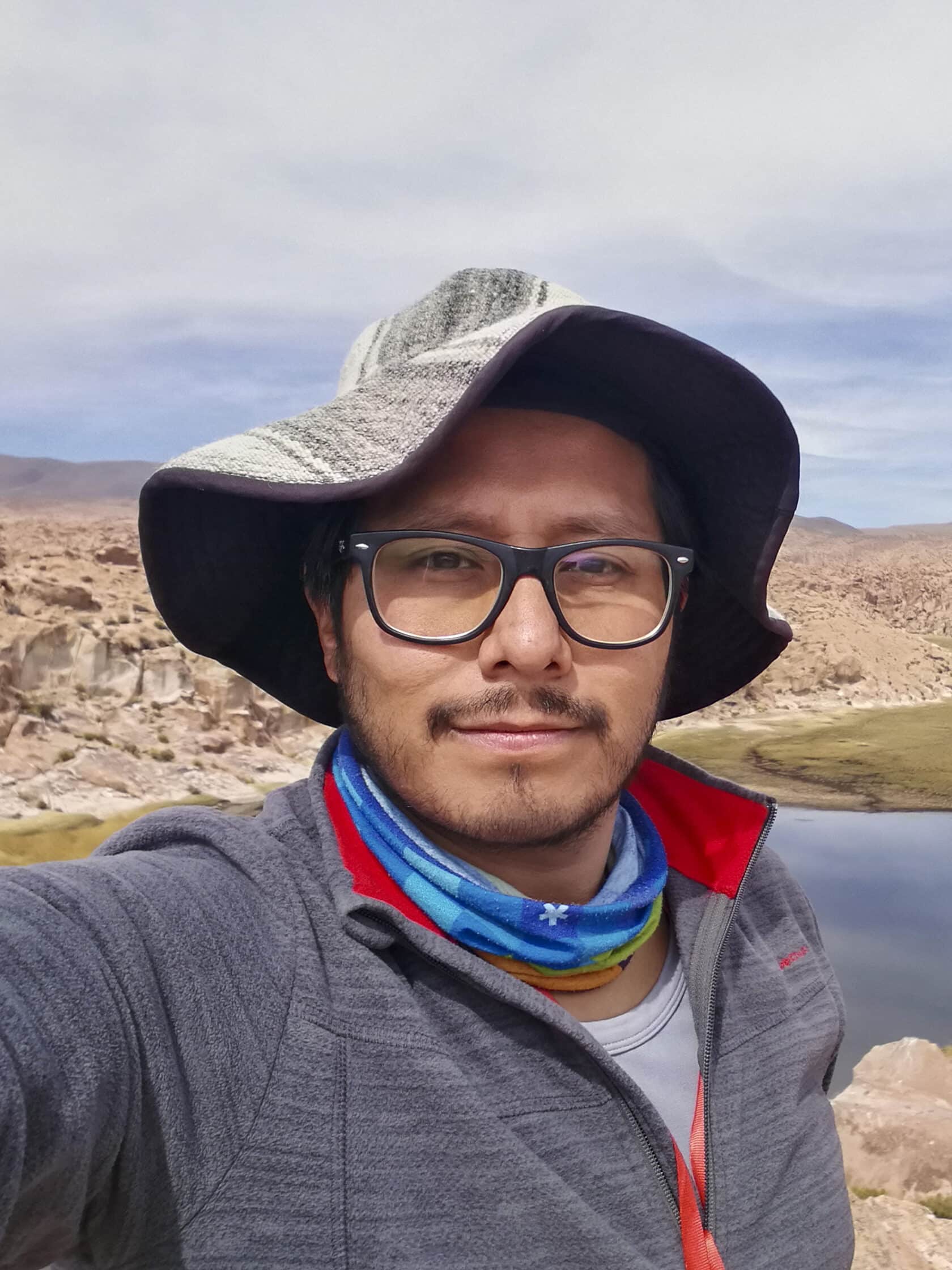
Daniel Viveros
What the Trip is Like
This trip is rated Level 3, Moderate, according to our trip grading system. It features sightseeing with day walks and some long drives, and we enjoy hotel and lodge accommodations throughout the trip. Day 11 is a particularly long day of travel as we fly from the Salar to Uyuni to La Paz, drive to Copacabana on Lake Titicaca, and ferry out to Isla del Sol in Lake Titicaca.
Most of the trip takes place at considerable altitudes, ranging from 12,000-13,315 feet in La Paz to 13,315 feet at Potosi and 12,000 feet in the Salar de Uyuni. Even just a walk up a flight of steps can make you feel a bit breathless. Appropriate time for rest and acclimatization is included in the itinerary, but for your own enjoyment of the trip, we recommend you make a special effort to be in good physical condition. A brisk 30- to 45-minute walk every other day over moderately steep terrain can do wonders for your conditioning. Also be sure to drink plenty of water when you're at altitude, even if you don't feel thirsty.
Client Testimonials
"An absolutely perfect itinerary to see the Bolivian Altiplano."
"This was probably the best-planned and well thought out trip that I have taken with Wilderness travel. Absolutely beyond my expectations."
Versailles, KY
"This trip was a truly wonderful experience! I learned so much and gained a much better understanding of this little-known country—its geography and culture and people. I love the fact that the trip itinerary covered so much of Bolivia's geography—north to south and cities as well as countryside and wild areas."
Truckee, CA
"An extraordinary trip! We learned so much about the Tiwanaku civilization, the Inca pilgrimage, colonial times, the salt flats, and more modern Bolivia. And, it is an endlessly fascinating place."
"I loved the trip! It was by far my favorite of all of the Wilderness Travel trips I've taken. The topography of Bolivia is beyond comprehension. The lodging was terrific, food was wonderful, and great local guides!"
Highlands, NJ
"This was an outstanding adventure. I learned so much about Bolivia —its people, history, current events, cities, towns, and fabulous copuntryside."
Baltimore, MD
"A wonderful diverse cultural experience."
San Carlos, CA
"Fantastic trip not just for the landscapes, scenery, and wildlife, but as a way to learn so much about the history, culture, and practices of Bolivians. I thought the trip was perfectly organized to give us the most information about the country and to see as much as possible in the Andean region and Lake Titicaca. I would not change a thing about the organization of the trip. Every day was wonderful."
Culver City, CA
"Words are still failing to capture the awe I experienced on this trip. While Bolivia has vast and diverse regions not touched on by this trip, the design covers Bolivian history, anthropology, ethnography, culture, and huge geographic range. This trip's arc was extraordinary, including the days from Sucre to Potosi. Extending the trip beyond that to explore Bolivia's southwestern regions of salt, sand, and dirt always surrounded by peaks, with all the spectacular natural scenes, was amazing. And closing the trip by going to the other northwestern corner and spending two days on Lake Titicaca was magnificent, for content and range of experience."
Washington, DC
"We loved Bolivia and and by the end of this trip felt enriched by all we saw and experienced. Little things, like eating the breakfast soup the miners ate, gave us a real feeling for the life of the average Boliviano."
Paulette N.
Fort Collins, CO
Other Trips You Might Like

Small Group Adventure
- Argentina: Hikes and Estancias of Patagonia
From $9,295

Private Journey
Ecuador Private Journey
From $5,695

Guatemala Private Journey
From $3,495
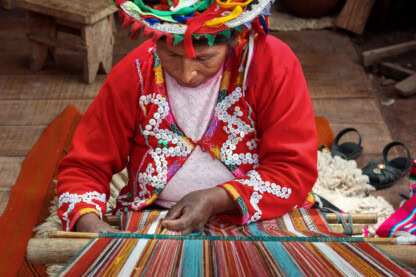
Treasures of the Sacred Valley and Machu Picchu
From $6,995
Book your trip today
Our Area Specialists know every detail about our tours. They will be happy to answer any questions and help you choose the journey that’s right for you. Contact us to learn more or book your trip today!
Submit the form below to download itinerary
Trip Download Itin
Trip Levels
With more than 200 different adventures to choose from, we want to help you find the trip that’s right for you. Our Trip Level system ranks each trip in two ways: a number rating from 1 to 6 according to the activity, and general travel rigors. 1 is the easiest and 6+ the most difficult—see descriptions below for explanations of each number. A plus (+) sign means the trip is a bit more strenuous than other trips of that level. The detailed explanation of each trip—below the bar with the number rating—is perhaps more important, specifying activities, altitudes, hiking, and travel conditions. The Detailed Itinerary, available by download or mail, gives further information. Our Area Managers can also answer questions and guide you to the trip that best suits your interests.
Level 1 – Easiest
Non-camping journeys, optional walks, little elevation gain or loss.
- Royal Rajasthan and Villages of India
- Small ship cruises
Level 2 – Easy to Moderate
Hotel nights and/or safari-style camping, hikes of two to four hours on some days. Other physical activities are sometimes included, such as optional sea kayaking.
- Our African safaris
- Costa Rica Wildlife
Level 3 – Moderate
Half- to full-day hikes (3-6 hours) over rolling countryside on most days, occasional steep trails. Many of our hotel-based walking tours are in this category, as are our snorkeling adventures.
- Tuscany & the Cinque Terre
- Palau Snorkeling & Sea Kayaking
- Some trips with minimal hiking but rugged travel conditions or long drives, such as Tribal Ghana, Togo & Benin, are Trip Level 3.
Level 4 – Moderate to Strenuous
Full-day hikes (4-6 hours), mountainous terrain, significant elevation gains and losses (hiking up or down as much as 3,000 feet) on many days. Altitudes no greater than about 10,000 feet.
- Ultimate Patagonia
- Hiking the Spanish Pyrenees
Level 5 – Strenuous
Full-day hikes (4-8 hours), mountainous, steep terrain (hiking up or down as much as 3,500 feet) on many days. Trips with hiking at average altitudes of 10,000 to 12,000 feet are in this category.
- Inca Trail to Machu Picchu
- Everest Lodge to Lodge
Level 6 – Very Strenuous
Full-day hikes (5-8 hours), mountainous, steep terrain (hiking up or down as much as 3,500 feet) on many days. Most hikes take place at altitudes above 10,000 feet, with some days ascending as high as 18,000 feet.
- Everest Base Camp
- Climb Kilimanjaro!
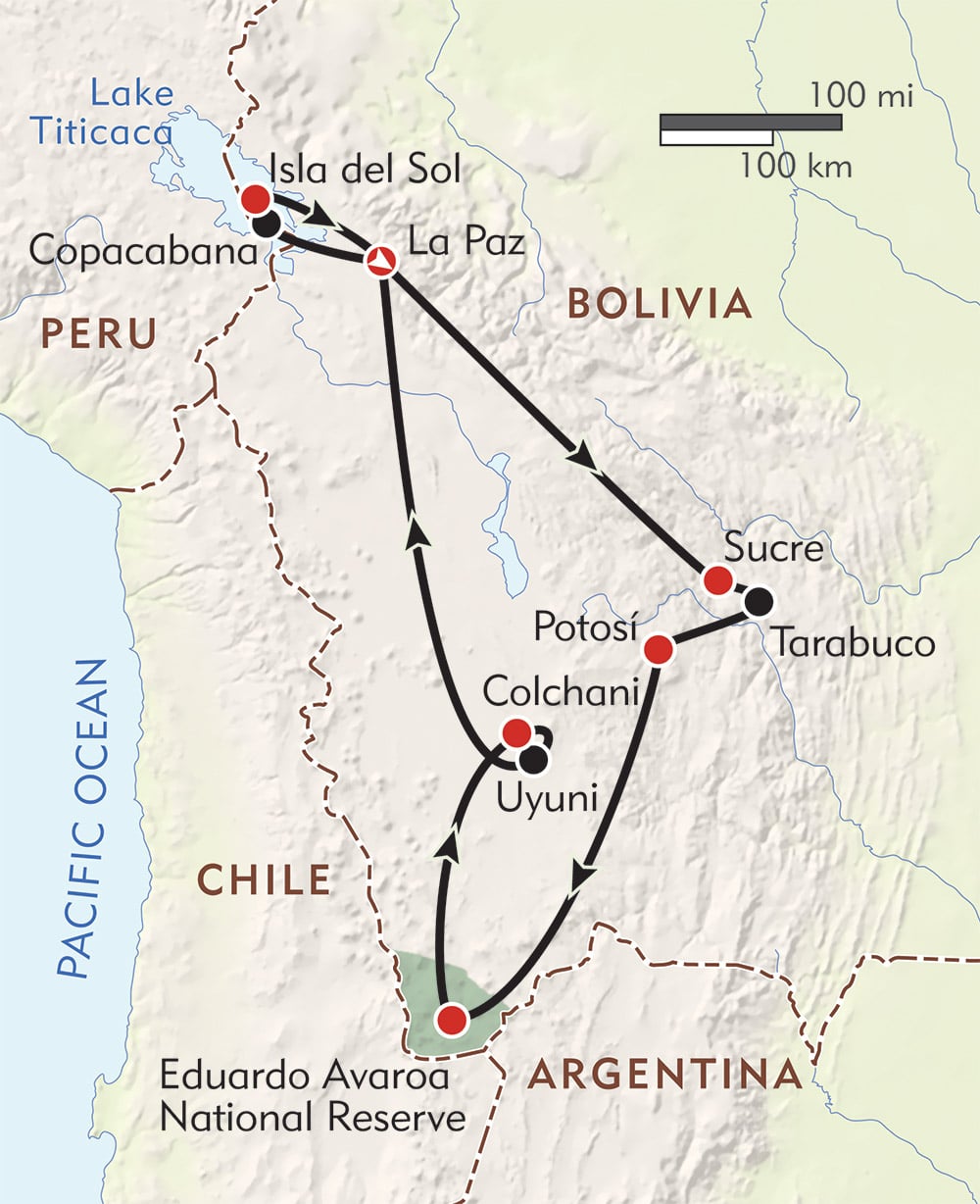

Hemos recibido tu solicitud correctamente.
Recibirás un mail con el resumen de tus reservas.
¿No lo encuentras? Déjanos tu correo electrónico y te enviamos un resumen de tus reservas.
Excursión de 2 días a La Paz y el Salar de Uyuni
- Cancelación gratuita hasta 24 horas antes
- Recogida en el hotel
- X (Twitter)
Uníos a este fascinante viaje de 2 días desde Puno hasta el Salar de Uyuni , uno de los enclaves naturales más sobrecogedores de Bolivia . ¡No os lo perdáis!
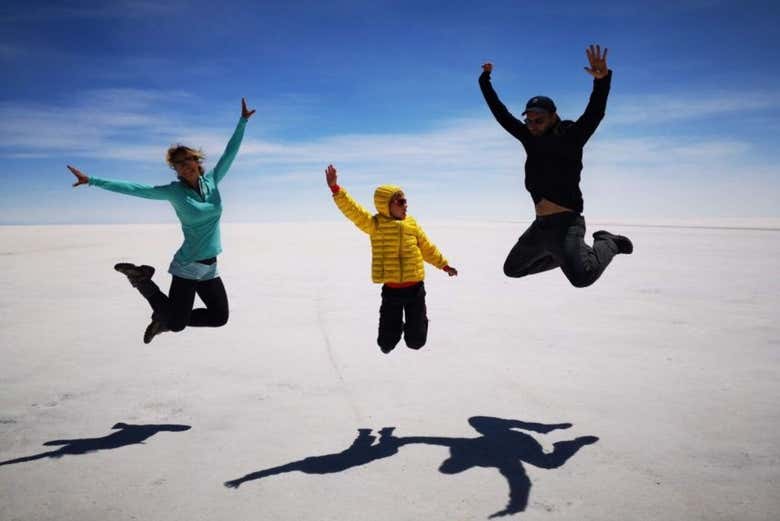
Día 1: Puno – La Paz – Uyuni
A la hora indicada pasaremos a recogeros por vuestro hotel de Puno para ir a la terminal de autobuses y tomar un bus turístico hacia La Paz. El trayecto durará unas 8 horas. Al llegar a La Paz , tendréis la tarde libre para pasear por la ciudad y El Alto , descubriendo así la rica cultura local de la capital de Bolivia y sus grandes atractivos.
Por la noche, tomaremos un bus cama con asientos que se reclinan hasta 160 grados. Llegaremos a Uyuni después de unas 10 horas de viaje.
Día 2: Salar de Uyuni
Al llegar a Uyuni por la mañana, iremos a una cafetería donde podréis desayunar y utilizar los servicios y duchas . Si lo preferís, os podemos recomendar un lugar para hospedaros hasta el inicio del tour.
Tras unas horas para descansar, comenzaremos nuestra visita de una hora y media por el Cementerio de Trenes . Luego, iremos a la comunidad de Colchani para adentrarnos en el Salar de Uyuni . En el camino, entraremos a algunos talleres artesanales y a un rústico microprocesador de sal de mesa .
Nuestro recorrido continuará en los Ojos del Salar y en el Hotel de Sal de Playa Blanca , que actualmente funciona como museo. Después, visitaremos la Isla Incahuasi , famosa por sus cactus gigantes.
Después de un espectacular atardecer sobre el Salar de Uyuni , estaremos de regreso en Uyuni. Podemos dejaros en la estación de buses o en el punto del pueblo que prefiráis después de una jornada de 9 horas.
Este tour incluye la recogida en el centro de Puno . En caso de que vuestro alojamiento se encuentre más alejado, debéis acudir por vuestra cuenta a la terminal terrestre de Puno .
Tened en cuenta que el primer día debéis estar en la terminal de Puno a las 6:40 horas . Para el último día, os recomendamos alojaros en el poblado de Uyuni o reservar un autobús que salga después de las 20:00 horas .
La actividad se realiza con un chófer que habla español, aunque en ocasiones podría hacerse de forma bilingüe.
Recogida en el hotel de Cusco.
Transporte en autobús nocturno de Puno a La Paz.
Transporte en autobús nocturno de La Paz a Uyuni.
Chófer de habla española.
Paseo en 4x4 por el Salar de Uyuni.
Almuerzo en el Salar de Uyuni.
No incluido
Comida y bebidas (salvo el almuerzo en Uyuni).
Entrada a la Isla Incahuasi: 30 bs (4,30 US$ ) por persona.
Cuándo reservar
Puedes reservar hasta 24 horas antes si quedan plazas. Reserva ya y asegura tu plaza.
Tipo de bono
Electrónico. Llévalo en tu móvil.
Sostenibilidad
Todos los servicios cumplen nuestro Código de Sostenibilidad .
Nuestros proveedores se comprometen a:
- Proporcionar una experiencia segura y satisfactoria.
- Reducir, reutilizar, reciclar.
- Implementar tecnologías respetuosas con el medioambiente.
- Respetar la calidad de empleo.
- Apoyar al desarrollo de las comunidades locales.
- Respetar la autenticidad cultural.
- Conservar el patrimonio cultural y medioambiental.
- Velar por el bienestar animal.
- Actuar de manera íntegra.
- Promover prácticas sostenibles entre los clientes y colaboradores.
Esta actividad, en concreto aporta de la siguiente manera:
- No requiere imprimir documentación.
South America Exploor Ver más
Razón social: South America Exploor E.I.R.L
No permitidas.
Preguntas frecuentes
P - ¿Por qué realizar esta actividad con Civitatis?
R - En Civitatis ofrecemos la mejor calidad y precio garantizados, haz click aquí si quieres saber cómo seleccionamos nuestras actividades .
P - ¿Cómo hacer la reserva?
R - Para reservar la Excursión de 2 días a La Paz y el Salar de Uyuni, elige la fecha deseada y completa el formulario. La confirmación es inmediata.
P - ¿Se necesita un número mínimo de participantes?
R - Esta actividad necesita un mínimo de 2 participantes. En caso de no alcanzar ese número, os contactaremos para ofreceros diferentes alternativas.
Si tienes otras dudas, contacta con nosotros.
Cancelación gratuita
También te puede interesar.
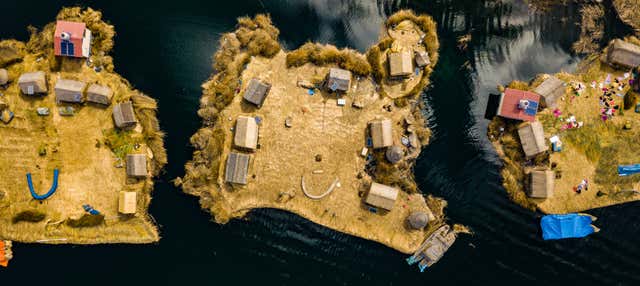
Excursión a las islas de los Uros y Taquile
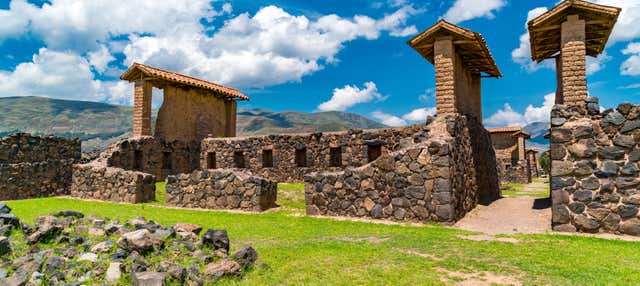
Ruta del Sol desde Puno hasta Cusco
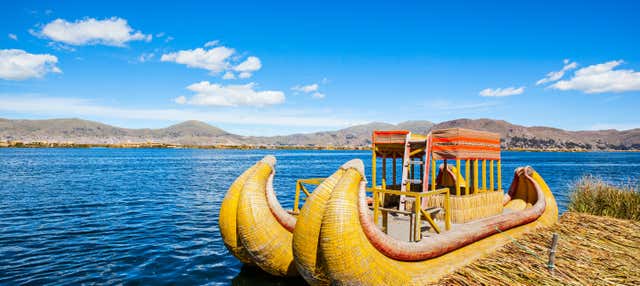
Excursión a las islas de los Uros + Trekking por Taquile
Inicia sesión para añadir actividades a tus favoritos y acceder desde cualquier dispositivo
Este sitio está protegido por reCAPTCHA y se aplican la política de privacidad y los términos de servicio de Google.
Información básica de protección de datos
Responsable del tratamiento: CIVITATIS TOURS, S.L. (CIVITATIS). Finalidad: Prestación de los servicios solicitados; Remisión de comunicaciones comerciales sobre los productos y servicios de CIVITATIS, para lo que se podrán elaborar perfiles comerciales de nuestros clientes; Remisión de encuestas con el objeto de valorar los servicios ofrecidos y su grado de satisfacción, así como la publicación de las opiniones sobre el servicio recibido; Cumplimiento de las obligaciones de índole contable, legal, fiscal y administrativa; Publicación de las imágenes de los clientes y Tratamiento de datos para fines estadísticos. Derechos: Tiene derecho a acceder, rectificar y suprimir los datos, a la limitación de su tratamiento, a oponerse al mismo y a su portabilidad. Información Adicional: Puede consultar la información adicional sobre Protección de Datos en las Condiciones Generales de Contratación .
Inicia sesión para valorar las opiniones de otros viajeros
- Tripadvisor
- See ALL TOURS Here
- Tours By Place
- Salar de Uyuni
- Lake Titicaca
- Cochabamba and Santa Cruz
- Amazon Basin
- Tours By Type
- Bolivia Wide
- Most Popular
- Overland Expeditions
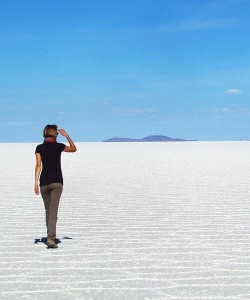
- Recommended:
- San Pedro de Atacama
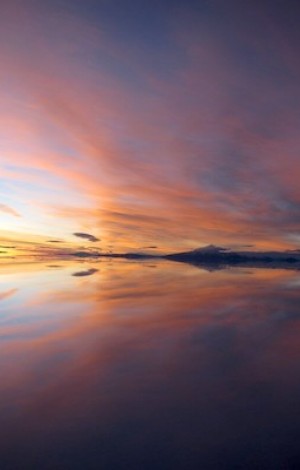
- See All Trips New

- Sajama National Park
- Custom Tours
SALAR DE UYUNI VIA SAJAMA – 3 DAYS TOUR FROM LA PAZ
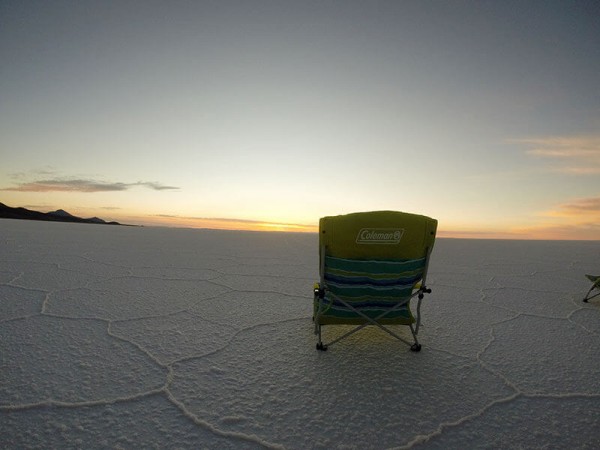
From the bustling city of La Paz to the desolate and awe-inspiring Salar de Uyuni high in the Andes, no need to make the long way to the town of Uyuni to enjoy the wonders of the Bolivian highlands. This alternative 3-day Salar de Uyuni tour starting in La Paz provides everything the classic 3-day tour does (namely lagoons, deserts, mountains, geysers, hot springs, Andean wildlife and not only one, but two pristine salt flats with no crowds) without the need of taking a bus/plane/train to Uyuni nor making the long drive to the remote southwest.

ITINERARY DRY SEASON (MID APRIL TO DECEMBER)
Sajama national park.
Instead of having to make the long (often overnight) way to the town of Uyuni, our adventure starts right in the city of La Paz (Bolivia’s administrative capital and starting point for most trips in the country). Upon an early morning meeting, we make our way out into the vast countryside driving along a modern highway en route to Sajama National Park .
Sajama National Park is named after Bolivia’s highest peak Mt. Sajama (6.542m) and is one of the country’s best kept secrets. Lying along the border with Chile, this protected area boasts spectacular snowcapped mountains, striking desolate deserts, high Andean lagoons, traditional villages, pristine rivers, natural hot springs, boiling volcanic geysers, vast wetlands, unique flora, native fauna (alpaca, llama, vicuña, Andean ostrich, viscacha, flamingo and other species of birds) and friendly, welcoming people.
Our morning drive from La Paz to Sajama National Park is not without interesting stops at natural places such as deserts, wetlands teeming with wildlife, rivers and cultural sites such as ancient tombs and quaint, colonial churches. A full afternoon is spent contemplating the striking landscapes, walking among boiling geysers, taking small hikes in the mountains and bathing in the natural hot springs with stunning views of Bolivia’s highest peak.
We sleep either in the community-run and ecotourism venture of Tomarapi or in more basic accommodation in the village of Sajama . Regardless of your place of choice, we enjoy a well-deserved rest in one of Bolivia’s most isolated and off the beaten track regions.
ACCOMMODATION BASIC: Basic lodge. Shared bathroom IMPORTANT: Please click/tap here for details and pictures STANDARD: Simple lodge with private room/bathroom IMPORTANT: Please click/tap here for details and pictures PLUS: Tomarapi Ecolodge with private room/bathroom IMPORTANT: Please click/tap here for details and pictures
MEALS LUNCH, DINNER
SAJAMA TO UYUNI: DESERTS, LAGOONS, COIPASA SALT FLATS AND ARCHAEOLOGICAL SITES
The second day of our expedition brings us south into the remote and rural highlands. Get off the beaten path by visiting secluded lagoons filled with pink, Andean flamingo as well as colorful and remote archaeological sites. View traditional villages and thousands of cute alpacas, llamas, vicuñas (wild) among green pastures and barren deserts. Enjoy a scenic lunch in prime nature and continue your drive south bound for Salar de Uyuni for a stunning sunset not before having Salar de Coipasa (second largest only to Salar de Uyuni) for ourselves – 3.000 square kilometers of pure salt – in the afternoon. We also get to visit an ancient burial site where we embrace the remains of past cultures as part of a moderate hike to break the long drive of the day.
* Today is a long day's drive. You will climb aboard our vehicle at around 6 am and arrive at your accommodation around 6 pm. We do provide several opportunities for breaks and short walks during the day (you don't spend the whole time in the vehicle) but do expect long hours of driving. If you would like to do the exact same program but with plenty more time and hiking opportunities, take our Salar de Uyuni from La Paz 4-Day Trip.
ACCOMMODATION BASIC: Simple lodge with shared bathroom. Hot, shared shower. IMPORTANT: Please click/tap here for details and pictures STANDARD: Simple salt lodge with private room/bathroom and hot shower. IMPORTANT: Please click/tap here for details and pictures PLUS: Salt Hotel TAYKA DE SAL or TAMBO COQUESA in the order of availability.
MEALS BREAKFAST, LUNCH, DINNER
UYUNI SALT FLATS FULL DAY
Today sees us enjoying the trip’s grand finale with an early sunrise drive into the mesmerizing Uyuni Salt Flats . Few places in the planet can offer such a surreal start of the day that you will never forget. After sunrise, return to our accommodation for a warm breakfast and get prepared to spend a full day exploring the world’s largest salt flats. Today’s activities include hiking in Isla Incahuasi (giant cacti island), taking our time for fun, deep-perspective photographs, enjoying lunch in the middle of the salt flats, learning about salt mining, visiting the former salt hotel “Playa Blanca” by the international flag stand and more surprises in store for you with the added advantage of almost no crowds since we will be doing the trip in a different direction from most people.
End this trip of a lifetime upon arrival in the town of Uyuni from where you can take an overnight bus or quick flight back to La Paz or arrange further travel to Potosi/Sucre.
ACCOMMODATION NONE
MEALS BREAKFAST, LUNCH
ITINERARY RAINY SEASON (JANUARY TO MID APRIL)
Sajama to uyuni.
The second day of our expedition brings us south en route to Salar de Uyuni. Most of the day will be spent traveling by vehicle from Sajama to Uyuni with several stops at natural geological formations such as the “stone valley”, small lagoons and scenic viewpoints along the highway (during the rainy season, the usual route taken in the dry season is inaccessible, including Salar de Coipasa). Although it is a long day covering a long distance, the journey will have several stops before reaching the town of Colchani (Plus package) or Uyuni (Basic and Standard) for a well-deserved rest after a long day of travel.
ACCOMMODATION BASIC: BASIC HOSTEL IN THE TOWN OF UYUNI WITH PRIVATE ROOM BUT SHARED BATHROOM. HOT SHOWER AVAILABLE STANDARD: HOTEL IN THE TOWN OF UYUNI WITH PRIVATE ROOM , BATHROOM AND HOT SHOWER AVAILABLE PLUS: HOTEL PALACIO DE SAL, LUNA SALADA OR CRISTAL SAMAÑA (PREFERRED ORDER. BASED ON AVAILABILITY) IMPORTANT: Please click/tap here for details and pictures
After a good night’s rest in your hotel, take your time for breakfast and a short stroll around the town of Uyuni (Basic & Standard) or venture into the salt flats if you stayed in the town of Colchani (Plus).
We will pick you up in the morning to visit the nearby train cemetery (Basic & Standard) or visit this place later in the day (Plus).
Next, drive to the village of Colchani where you will have the opportunity to walk through its colorful market and learn about salt mining in one of the rustic processing plants in the village.
Time to enter the salt flats as far as it is be possible. Typically, during the months of February to March, we are limited to the edge of the salt flats by the high level of water. However, this is enough to enjoy the “mirror” effect reflecting the sky (if the conditions are right). If possible, especially during the months of January and April, we may be able to visit Playa Blanca museum, where the Dakar monument and multinational flag stand are located.
End this experience of a lifetime upon arrival in the town of Uyuni from where you can take an overnight bus or quick flight back to La Paz or arrange further travel to Potosi/Sucre around 6 PM.
IS THIS TRIP FOR ME?
- Ideal if you would like to be picked up in your La Paz hotel or airport
- This trip covers the region between La Paz and Uyuni but not further south
- Sajama National Park is not as visited as other parts of Bolivia. If you want to avoid the crowds, this is the perfect place
- The road from Sajama to Uyuni has remote natural lagoons with flamingos but these are not the famous red or green lagoons
- Accommodation is overall basic. You should be ready to do without modern comforts regardless of the package you choose
- Not an ideal trip if you wish to continue to/start from San Pedro de Atacama. See our Classic 3 Day Tour instead
PLEASE NOTE THAT PARK AND OTHER SITES' ADMISSION FEES - IF APPLICABLE - ARE NOT INCLUDED IN THE PRICE (READ BELOW)
WHY TAKE THIS TRIP WITH US?
- This trip has a perfect safety record with no accidents or serious incidents ever recorded
- Our drivers and guides are trained to put safety as priority
- No surcharges or hidden fees during the tour (see exclusions)
- We are a local company with more than 8 years’ experience running this type of trips in Bolivia and Peru
- This trip should not be considered a replacement for the classic 3-day Uyuni Salt Flats & Southwest (namely Eduardo Avaroa Reserve) tour but rather a good alternative since all the natural features seen on the classic trip can also be seen on this one, but are located in entirely different places and are not the same ones
- This trip is ideal if you plan to return to La Paz or travel further to Potosi/Sucre after the tour
- This trip is not ideal for you if you plan to transfer to San Pedro de Atacama, Chile. While it is still possible to do so from Uyuni town, it is advisable that you take our classic 3-day tour or our 5-day La Paz to Uyuni tour .
- You must be ready for a long drive on the second day although plenty of stops are made
- Our prices already include a bilingual English-speaking guide. However, you may choose to travel without one (Spanish-speaking driver and printed informational booklet) if you wish to save
- Our different packages vary considerably in terms of accommodation quality. Note that our Plus package includes the best available hotels in the region(s) but must not be considered luxury, 4/5 star hotels
IMPORTANT INFORMATION TO CONSIDER
- The itinerary may suffer changes without previous notice due to factors outside our direct control such as weather and road conditions. If we are forced to alter the itinerary in any way, it will be based on good judgment and necessary modifications for your own safety and comfort and you will be promptly notified. We never alter or skip attractions in the itinerary without explaining the reasoning behind any possible change and providing adequate proof that such change may be necessary. Therefore, you should not take the above itinerary as “set in stone” and we will not he held liable for any loss or damage that you may feel arising from such changes made for your benefit.
- The Salt Flats region is a remote area that lacks the usual comforts of the modern world. You should not expect high standards of accommodation, hot water is available most of the time (according to respective package) and electricity is available for a few hours or more where possible.
- Food is handled hygienically and it is our priority and job that you are satisfied with the limited resources available in this region. Vegetarians are welcome, but should not expect special menus as we do what we can to serve appropriate portions of vegetables and fruit in the vegetarian menu.
- During the rainy season (December to March/April) some parts of the salt flats may be inaccessible such as Incahuasi Island and time on the actual salt flats is limited. Most of the regular itinerary is followed as normal.
The following are dates in which other people have shown interest in forming a group for this tour. Use the ENQUIRY tab to request a new date or join one of the dates below to form a group and obtain the respective price. The number of interested persons is shown for your reference and you will be updated via email if other people are interested in the same date. If your party consist of four persons, we suggest booking a tour outright to confirm departure.
WHAT'S INCLUDED
- Well-maintained 4WD Nissan Patrol or Toyota Land Cruiser touring vehicle
- Professional driver (our drivers are highly trained and have as a minimum 5 years experience on these roads with some having more than 30 years)
- English - Spanish speaking guide (unless no guide is requested)
- 2 breakfasts, 3 lunches, 2 dinners
- All accommodation as per your chosen package (Basic, Standard, Plus)
- Bottled water for meals
WHAT'S NOT INCLUDED
- National park and other admission fees: 270 Bolivianos/40 USD
- Alcoholic and non-alcoholic beverages/soft drinks
- Optional tips/gratuities
- Personal purchases and anything not mentioned under What’s included

- Ask a Question
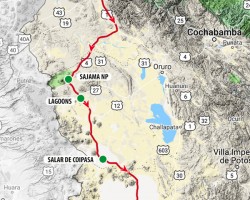
- Related Tours
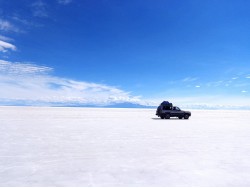
Write a review
Related articles.

- We suggest you also
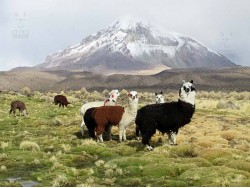

COMMENTS
3/4 Day Tour. The most popular and recommended way to discover Salar de Uyuni is by taking a 3 or 4 day tour in a 4×4 jeep. Three day tours depart from either Uyuni or San Pedro de Atacama and finish in Uyuni. The three day tour starting in San Pedro de Atacama and ending in Uyuni is ideal for those looking to continue traveling north after ...
Uyuni Bolivia. A small town located just on the edge of the salt flats, all visitors to the Salt Flats will make their way through Uyuni, either as the starting or ending point of Salar de Uyuni tours. While there isn't much to this town, it offers a range of hotel and hostel options, restaurants, and of course, tour companies for trips to the salt flats and beyond.
The Uyuni salt flats tour is a safe and comfortable 3 day tour to the Salar de Uyuni and lagoons in Bolivia. We use the best hotels in the area (Tayka hotels or similar category salt hotels such as Luna Salada hotel or Palacio de Sal hotel) and very comfortable private transport.The cars we use are fully equipped Toyota Land Cruisers, Nissan Patrols or Lexus with first aid kit and an oxygen ...
In Bolivia's Altiplano, Salar de Uyuni—a 4,086-square-mile (10,582-square-kilometer) stretch of land encrusted with thick etchings of salt—is the world's largest salt flat. Salar de Uyuni is famed for its massive scale and mirror effect during the wet season, a feature that has led it to be named a natural wonder of the world.
Since Uyuni is so close to the salt flats, tourists can easily book day trips. Flights from La Paz to Uyuni can be booked through Amaszonas and BoA (one hour, about $130 round-trip). Overnight ...
Full Day Tour of the Salt Flats, start and finish in Uyuni on same day. A one-day tour of Salar de Uyuni in 4×4 jeeps are common and the shortest tours possible. The one day tour is also the cheapest way to visit the Salt Flats. Tours start in Uyuni around 10am (allowing you to have breakfast after your overnight bus from La Paz to Uyuni) and ...
With over 33 years of experience, they provide private and shared tours, comfortable salt hotels, astronomical tours, and paragliding flights in the Salar de Uyuni. Their expert guide drivers and astrophotographers ensure safety, with no accidents reported since their establishment. All 4x4 vehicles are GPS-tracked to adhere to speed limits.
Salar de Uyuni, often referred to as the world's largest salt flat, is situated in the southwestern region of Bolivia, nestled high in the Andes at an elevation of approximately 3,656 meters (or around 11,995 feet) above sea level. Specifically, it can be found within the Daniel Campos Province in the Potosí Department.
Introducing Banjo Tours' complete one-day Salar de Uyuni expedition. This full-day adventure covers all of the Bolivian Salt Flats' most iconic sights. Go hiking on Incahuasi Island and marvel at the mind-bending salt flats from the top, visit the Train Graveyard, find your country's flag at the former Salt Hotel, enjoy lunch in surreal ...
Typical Day 1 of Bolivian Salt Flat Tours. The Uyuni salt flats! Train cemetery - Most tours start with a visit to a graveyard for abandoned trains just outside Uyuni town. Colchani - A small town on the edge of the salt flats. Some tours stop here to see a salt processing plant (my opinion = #meh).
Join us in Uyuni, Bolivia in order to admire the sweeping views of the world's largest salt flats: Salar de Uyuni (Uyuni Salt Flats) and explore the dramatic southwest full of striking landscapes of snow-caped volcanoes, colored lagoons, barren deserts and native wildlife. Along the way, explore Incahuasi Island with its giant cacti, Red Lagoon with its thousands of pink flamingos and the ...
Salar de Uyuni. Bolivia, South America. An evocative and eerie sight, the world's largest salt flat measures 4674 sq mi (12,106 sq km) and sits at 11,984ft (3653m). When the surface is dry, the salar is a pure white expanse of the greatest nothing imaginable - just blue sky, white ground and you.
The Salar de Uyuni is a 10,582 square kilometer expanse of cracked white salt, left behind when an ancient salt lake named Coipasa dried up thousands of years ago. Located in the Bolivian Altiplano, it is the world's largest salt flat and is located at a high altitude of 3,656 meters (10,000 feet) above sea level.
This four-day trip to Bolivia's outdoor paradise features ample time exploring Salar de Uyuni and makes the most of your visit by getting to more places than the usual 3-day tour with plenty of opportunities for hiking, photography, stargazing and more. Not enough? Two days exploring the remote sout
2 day tour Uyuni salt flats. The beautiful Uyuni salt flats (or Salar de Uyuni) is with its 10.582 square km (4.085 square miles) the world's largest salt flat. It is located in the Department of Potosi in southwest Bolivia, near the crest of the Andes, at 3.650 meters above sea level. Some 40.000 years ago, the area was part of Lake Minchin ...
Bolivia's Uyuni salt flats are one of the most photogenic places in the world. With over 10,582 square kilometres (4,086 square miles) of snowy white hexagonal patterns and clear blue skies, it doesn't get much more gorgeous than this. The first time I visited the salt flats in 2009, I had no idea of what to expect.
In case you want to see Salar de Uyuni quickly and at its best, there is a possibility to join a sunrise or sunset tour and get back to Uyuni in a couple of hours. The standard three-day tour price ranges between Bs 850 - Bs 1350 in Uyuni, but if you will book your tour online, expect to pay twice as much.
While full-day tours of the Salt Flats will give you an incredible experience visiting this unique destination, I recommend trying to make room in your itinerary for a multi-day tour. Most multi-day Salar de Uyuni tours are three days and two nights, and are the perfect length of time to enjoy the entire area.
The largest salt flats on earth, the Salar de Uyuni spans over 10.5 kilometres (4,000+miles). In the wet season, a layer of rainwater creates a mirror-like surface as smooth as glass. In the dry season, its geometric salt patterns imprint the earth, seemingly stretching beyond the horizon. Put simply, this place looks like a whole other planet.
Options for Salar de Uyuni Tours. A 3 day tour of the Uyuni salt flats is the most popular way to explore the biggest salt flats in the world. A journey across the Uyuni Salt desert is an amazing way to cross from Bolivia to Chile. Most tours leave from the town Uyuni, a small isolated tourist town located in Potosi, Bolivia, this is how we did it.
SALAR DE UYUNI - 2 DAY TOUR (SALT FLATS ONLY) On this two-day expedition of Uyuni Salt Flats, visit the well-known attractions of the Salar as well as the northern rim including Thunupa Volcano and other lesser-known sites across the plains (dry season, May to Nov). Alternatively, enjoy two relaxing and surreal days of slow driving across the ...
Overview. The mesmerizing landscapes of the Salar de Uyuni, vast Lake Titicaca, the red-roofed colonial towns of Sucre and Potosí, the bowler-hatted Aymara in the markets of La Paz—Bolivia is a world of surprise and delight. In this land of high altitudes and fascinating indigenous cultures, we spend nights on serene Isla del Sol in the ...
Itinerario Día 1: Puno - La Paz - Uyuni. A la hora indicada pasaremos a recogeros por vuestro hotel de Puno para ir a la terminal de autobuses y tomar un bus turístico hacia La Paz. El trayecto durará unas 8 horas. Al llegar a La Paz, tendréis la tarde libre para pasear por la ciudad y El Alto, descubriendo así la rica cultura local de la capital de Bolivia y sus grandes atractivos.
From the bustling city of La Paz to the desolate and awe-inspiring Salar de Uyuni high in the Andes, no need to make the long way to the town of Uyuni to enjoy the wonders of the Bolivian highlands. This alternative 3-day Salar de Uyuni tour starting in La Paz provides everything the classic 3-day tour does (namely lagoons, deserts, mountains ...